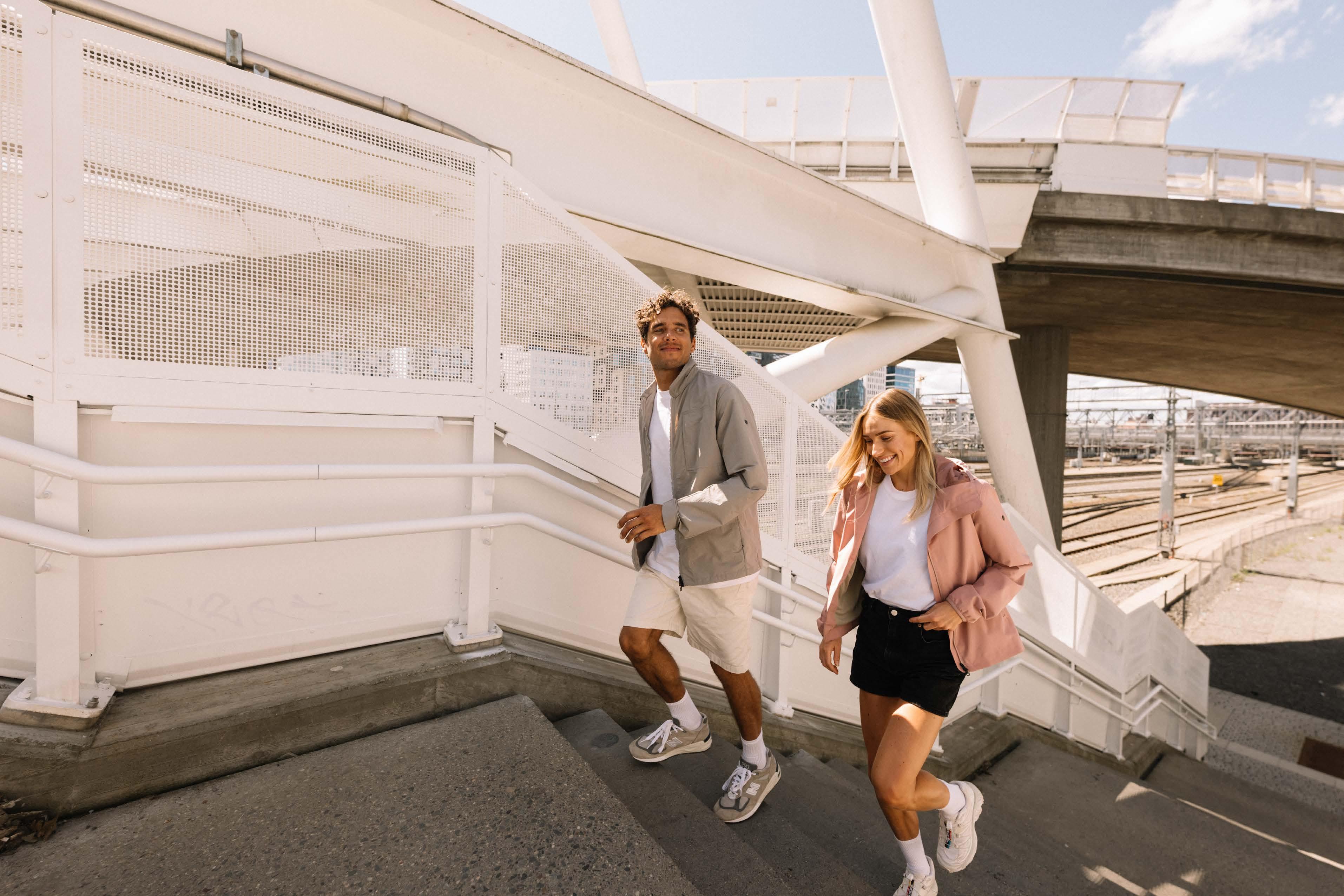






alberto-pants.com


PANTS WE LOVE SINCE 1922
ABOUT US








alberto-pants.com


PANTS WE LOVE SINCE 1922
ABOUT US
Welcome to These Lines. Buzzword, aspiration, target state – relevance is one of the most frequently quoted terms in our industry. But the more we talk about it, the more urgent the real question becomes: What does it mean to be truly relevant today – and what will it take to remain relevant tomorrow?
This question is not only being asked by retailers and the industry, but also by trade fairs, as my colleague Janaina Engelmann-Brothánek highlights in her lead article, by agencies, showrooms – and by us as a magazine. There is no collective answer, as the many conversations that shaped the creation of this issue show. Today, relevance is no longer universal, it is increasingly personal. Just like fashion. In the womenswear chapter, Nicoletta Schaper analyzes this development with a clear conclusion: Substance over Status. Fashion with substance is in demand – what is relevant is decided by the women who wear it. In menswear, on the other hand, it’s all about attitude – in conversation with Marco Falcioni, Creative Director Boss, and French chef Mathis Molinié: From Archetype to Attitude. An attitude that is tangible, credible and therefore relevant. As usual, my colleague, editor-in-chief and publisher Stephan Huber also takes a stand – not only in his Editor’s Letter, but also in two zeitgeist essays.
On the cover: Daniela Soto-Innes. In New York, she became the youngest “World’s Best Female Chef” and then decided to follow her intuition – back to Mexico. An unusual choice for a fashion magazine? And all the more reason for us to be proud of it. After all, the question of relevance no longer only concerns our industry – which makes interdisciplinary exchange all the more valuable. Daniela’s last sentence in our longview stays with us: “I’m not trying to be the best restaurant in the world. I’m trying to be Rubra. That’s enough for me.” Perhaps this is precisely the way to redefine relevance: not to become louder, but clearer. Not bigger, but more precise.
In this sense, I also consider it our task for style in progress to work out our own DNA even more clearly – and to focus entirely on our essence. You will see concrete steps towards this on the following 336 pages: with conversations full of depth, interdisciplinary perspectives and one certainty: The future is wide open.
Lisa Hollogschwandtner and the style in progress team
Publisher, Editorial Office, Advertising Department and Owner style in progress
B2B Media GmbH
Postal address
Postfach 0031, 5027 Salzburg Austria
Company address
Bachwinkl 2, 5081 Anif/Salzburg Austria
info@style-in-progress.com www.style-in-progress.com @styleinprogress.magazine www.linkedin.com/company/style-in-progress
Management Stephan Huber
Editors-in-Chief
Stephan Huber

stephan@style-in-progress.com
Lisa Hollogschwandtner lisa@style-in-progress.com
Art Direction, Design, Production Elisabeth Prock-Huber elisabeth@style-in-progress.com
Managing Editor
Johannes Seymann
Editorial Staff
Janaina Engelmann-Brothánek
Isabel Faiss
Ida Hanak
Claudia Jordan
Martina Müllner
Kay Alexander Plonka
Nicoletta Schaper
Malene Wagner
Dörte Welti
Veronika Zangl
English Translation
Georgmaria Prock
Manfred Thurner
Editor
Georgmaria Prock
Image Editing
Johannes Hemetsberger
Illustrations
Alexander Wells
Printing
Sandler Gesellschaft m.b.H. & Co. KG, 3671 Marbach, Austria
Printing Coordinator
Manfred Reitenbach
Advertising Director
Stephan Huber stephan@style-in-progress.com
Accounting
Verena Wigoutschnig verena@style-in-progress.com
Digital Edition www.style-in-progress.com/en/epaper/
THE FUTURE IS WIDE OPEN!
Next Issue #98 9 January 2026

006 EDITORIAL Relevance Rewritten
006 ABOUT US
016 CORE
092 CORE AGENCIES
242 EDITOR’S PICKS Brands to Keep an Eye On

A BRAND CALLED YOU!
Emotion, relevance, essence: An interview with Head Chef Daniela Soto-Innes
An essay by Stephan Huber
148 Hospitality at Its Finest 086 THE MUSE AND THE MACHINE
THREADS OF NEW IDENTITY
Where conventions collapse, it creates space for a future we shape ourselves.


Marco Lanowy, Alberto: “Fashion Is Allowed to Be Disruptive!”
Authenticity Is Key at Fattore K House
Merz b. Schwanen:
“Style Does Not Entail Imitation”
“The Modern Man No Longer Relies on a Prefabricated Template,” Katharina and Gregor Grüner know.
Style Groups Outrank Target Groups at Dressler
Jan Mangold, Windsor: “It Takes Attitude!”
Tobias Schellenberger, Rossi: “Genderless Is Reality”
Silent Luxury at Hiltl
New Branding at CG – Club of Gents
Coolness with Depth at Homecore
EDITOR’S PICKS: Must-See Menswear

136 Everyone Wants to Get Into Fashion, but Fashion Wants to Get into Food
138 Xinge: From Mood to Menu
140 Aquarium: Dive Into the Now
142 Editor’s Picks: Fashion Has Gone Foodie!

Marco Falcioni, Creative Director Hugo Boss, and Mathis Molinié, Head Chef at Restaurant Philippe, discuss modern masculinity.

Womenswear has a new currency.
196 What We Have Woven Together
Giada Forte, founder of Forte Forte, and Laurence Antiglio, owner of Vestibule, enjoying a heart-to-heart


226 The Trust You Wear
Janine Knizia and Chloé de Ruffray explain how Clear Beauty and the longevity mentality are reshaping our values.
Logos, labels, luxury? Things of the past!
210 Luxury as It Was Always Meant to Be – Aeron of Budapest
214 Siyu: “Relevance Equals Freedom!”
215 Knit-ted: Modern Living
216 Sassenbach & Cozy van Dorle: “Women Know What They Want”
217 Marina Chareton, Hartford: “The Demand for Quiet, Genuine Quality Is Rising.”
217 Kennel & Schmenger: “We Create Shoes for Genuine Personalities”
218 Melagence Founder Mela Bauer on Individual Luxury and a New Sense of Seriousness
220 Katharina Hovmann: Sophisticated Simplicity
221 Edelle: Quiet Luxury – Made in Europe
222 Oflab: “We Hit a Nerve”


223 15 Years of Penn & Ink N.Y.
223 Luisa Cerano: In the Spirit of Art
224 EDITOR’S PICKS
What’s new, Womenswear?

204 Ella Soccorsi, Arket “Creativity Never Happens in Isolation”
234 Astorflex: Values, Roots, Passion
236 Mason Garments: Honest Artisanship
238 Goldgarn: “This Anniversary Needs a Statement”
239 Alohas: On-Demand Goes Retail
240 GDM Sr: “We Base Our Thinking on the Material”
248 Avant Toi: Dialogue of Eras
249 Minimalist Design, Maximum Performance at Save The Duck
250 Yippie Hippie: Summer Vibes
251 Pride To Be: Always



The louder the outside, the greater the longing for inner silence.

Choosing to Matter: Relevance is not a fixed quantity; it is a process.
254 COMMERCIAL GARDEN OF EDEN The Wellness Era for Specialist Retailers
266
Retail-Specialist Marco Burkhardtsmayer: “It’s About Holding Meaning”
268 Loïc Brunschwig, Bongénie: “Relevance Is the Driving Force Behind All Decision-Making”


What trade fairs can be –and must be – today.
301 What Renders Trade Fairs Relevant? Answers from the retail sector.
304 Brand Invasion or Co-Creation? Benedetta Lenzi, Director of IED Florence and curator, on the Design Week phenomenon.
306 The Union: A Trade Fair That Never Wanted to Be One
307 Arnd Hinrich Kappe, CEO ILM Offenbach: “We Are the World’s Marketplace”
308 Design Meets Fashion, Textile Creates Space: Marie Aigner X Cambio
309 Praterinsel by Petra Esparza McAlpine: “There Is Room for Everyone”
310 Marco Weichert, General Manager Performance Days, is convinced: “Relevance Arises From Attitude”
312 Texpertise: Knowledge as Key
312 Munich Fabric Start: One-Stop Solution With Scope for Niches
313 Salt: Leveraging Synergies
314 Sorbet Island: “Trade Fairs Are Our Natural Habitat”

Tokyo does not simply follow trends, but absorbs, distills, and reinvents. A portrait of nine local heroes.
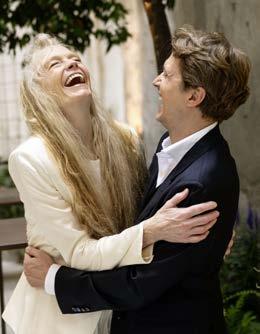

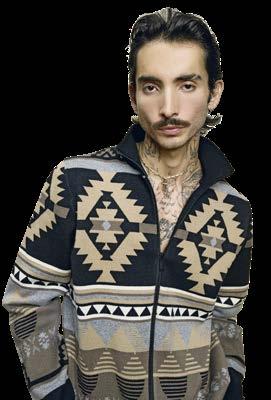
316 Change for Their Tomorrow
Suzy Amis Cameron and Matteo Ward about a radical new approach to sustainability.
315 Ucon Acrobatics: “The Future Is Circular. Period.”
320 Ecoalf: The Sea and The Soil
Tendencies & forecasts for upcoming seasons
Everything Is Nothing Without Freedom

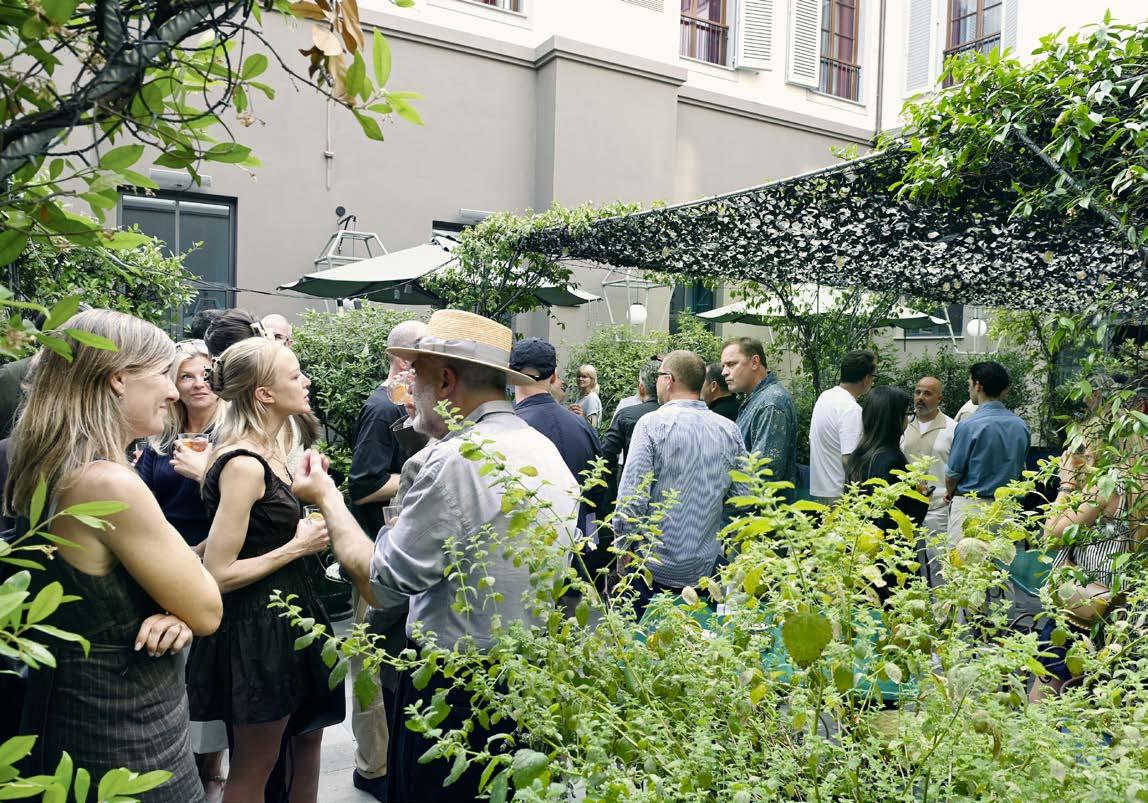
It has become a tradition: the industry get-together on the eve of the official start of Pitti at the 25Hours Hotel in Florence, our Pre-Pitti Cocktail. An evening that is far more than just a social kick-off for us - it stands for exchange, for connection, for community. For open discussions, for a reunion among colleagues and friends. And it is a statement: how important it is to consciously create space for depth, especially in the fast-paced trade fair era, full of tight schedules, appointments, and impulses. It is moments like these that give rise to thoughts that really help us move forward. Thank you for sharing this moment with us, thank you for the exchange, thank you for your time. If it didn’t work out this time, we’d love to see you in January. We look forward to it!








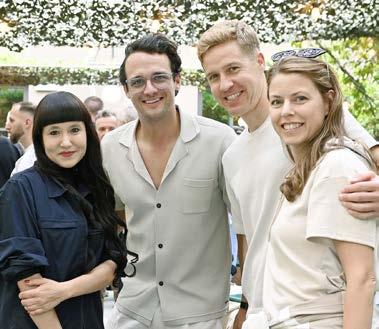



Liv Bergen ignites a spark in many women. How?
Sybille Mezger, founder of Liv Bergen: We always hear that Liv Bergen is different. Perhaps that’s the secret. We are cool, urban, casual yet feminine and every style has a special highlight. We also attach great importance to made in Europe, high-quality fabrics and special details. I think these aspects make the difference. The customer doesn’t have that yet, that’s what she wants! What highlights are you starting the season with?
In addition to our core pieces in expressive colors, there are crochet pieces from Italy, colorful denims in summery lightness – a great match for our T-shirts and oversized sweatshirts! Special attention is paid to the finishing for super soft haptics and fluorescent prints. My conclusion: Liv Bergen remains true to itself and yet continues to develop. For a season full of style, energy and joie de vivre. www.livbergen.de

With its spring/summer 2026 collection, Blauer is redefining its urban outdoor style – for everyone who moves between the city and nature.
Four lines set the tone: Department brings utility elements – for women in warm earth tones, for men with maritime accents. Urban Police references the brand’s heritage translated into modern streetwear.
Essential is uncomplicated and versatile, with smart layering and contemporary lightness. Garment tells a story of artisanship: Piece-dyed in natural materials such as linen and cotton.
The collection is complemented by strong leather statements – from biker to shiny and suede leather with a striking used finish.
Parajumpers is launching its 40th collection in spring/summer 2026. It sums up the essence of the brand: Functional aesthetics for a life between city and nature, between everyday life and new beginnings.
Two stylistic polarities structure the collection: Outdoor – characterized by functionality and robustness. Urban – a smart expression of the pace of modern city life.
In womenswear, these two worlds merge into contemporary silhouettes. The looks remain minimalist and are characterized by technical sophistication and durable materials.
The collection is complemented by a sportswear segment in menswear that subtly quotes work wear references.

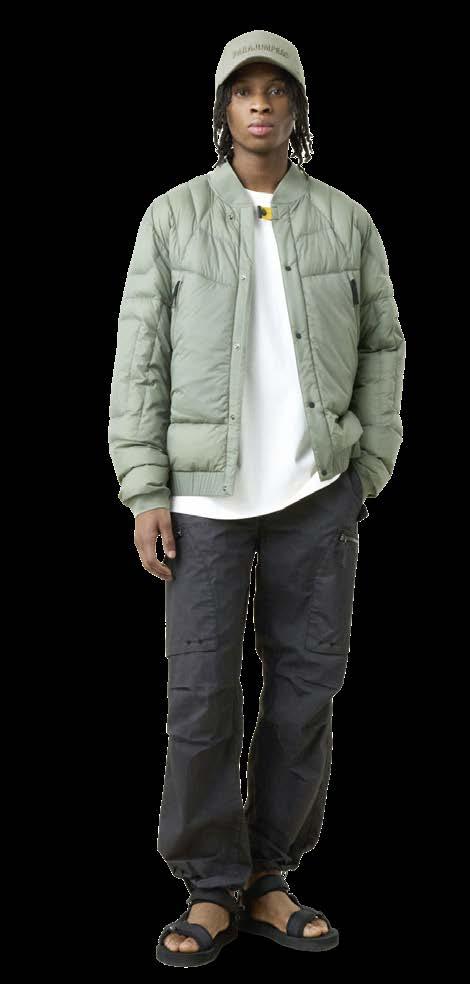
Layering remains.
Trans-seasonal pieces –made for every season.
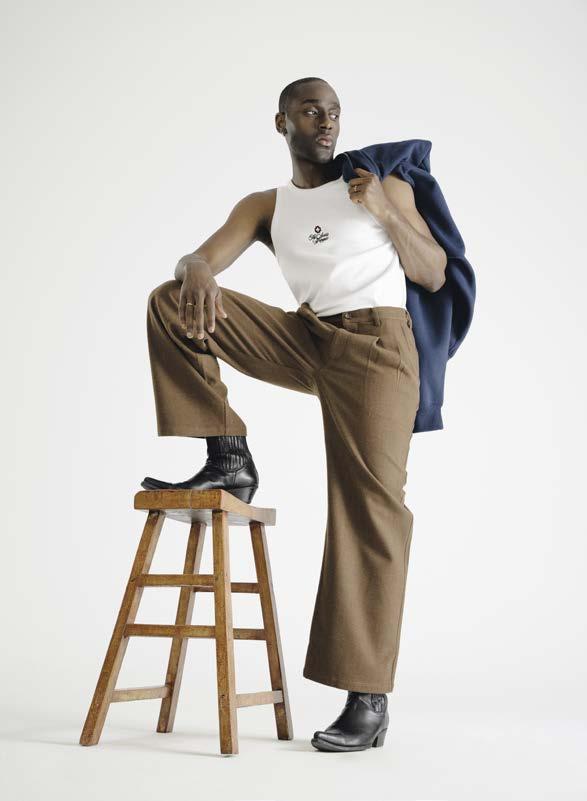

Swiss menswear specialist Strellson is consistently pursuing its strategy of tapping into new target groups. A capsule with Berlin streetwear label Prohibited will follow this year. “The collaboration gives us access to a younger, urban target group. Both brands benefit: we gain reach among the young scene, while Prohibited can expand its product expertise. For us, this is another important building block in the repositioning and transformation of the brand,” says Marino Edelmann, Managing Director of Strellson. The limited collection includes jackets, shirts, knitwear, hoodies and accessories.

Carl Gross scores points with dressed-up sportiness and its first own shoe line.
Michael Berngruber, Division Head Carl Gross, is leading the menswear specialist into a sporty direction with the spring/summer 2026 collection, which impresses with a modern look on the body. The Black Line interprets suits in Italian-style dress shirt fabrics in a fresh way, while the Main Line rethinks the Traveller range. The connection between modernity and tradition also reflects the stylistic journey to Marrakech in the color worlds, which range from terracotta tones to blue via neutrals and create an atmosphere that is characterized by cosmopolitanism and visual diversity. www.carlgross.de





New to the Antones team: Alexandra von Arnim will continue to grow Moismont in Austria.
Some brands grow quietly – with purpose, precision, and soul. Moismont, founded in 2012 in the heart of Normandy, is one of them. Rooted in French heritage and brought to life through Indian artisanship, the label has built a distinctive identity.
In recent seasons, Moismont has expanded its ready-to-wear line, staying true to the subtlety and soul that define its accessories. Loose silhouettes, poetic colorways, natural fabrics, refined stitching – all shaped by that unmistakable French sense of ease.
Moismont’s authenticity resonates far beyond France – especially in the D-A-CH region, where the brand has steadily grown under the direction of Sarah Freise, founder of Antones Agency. “Independent retailers don’t just look for products – they look for personality, values, something unique,” says Sarah. “Moismont brings all of that.”
Speaking of personality: to further strengthen growth, Sarah has brought Alexandra von Arnim, a well-connected expert, onto the team. Alexandra has helped shape the profile of Reyer Looks over many years. Most recently, she was head of women’s buying at Stereo MUC in Munich. She will now contribute to the sustainable success of Moismont.


With the move to Rheinterrasse, Igedo Exhibitions is launching its new Twodays format: the first edition will take place from July 19 to 21, followed by the second event from August 23 to 25. In each case with an extended showroom concept, which enables a longer presence at the second location: KAP.One on Karl-Arnold-Platz, for exhibitors from the premium segment in direct proximity to the showroom. “Both locations are well-booked,” says Ulrike Kähler, Managing Director. “We are responding to the industry’s desire for shorter distances and flexible running times.” A shuttle service connects both locations and other showroom addresses in the city. www.igedo.com


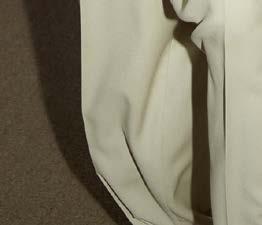


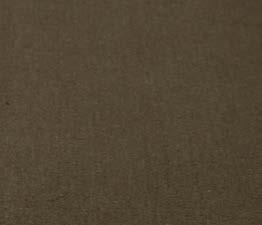


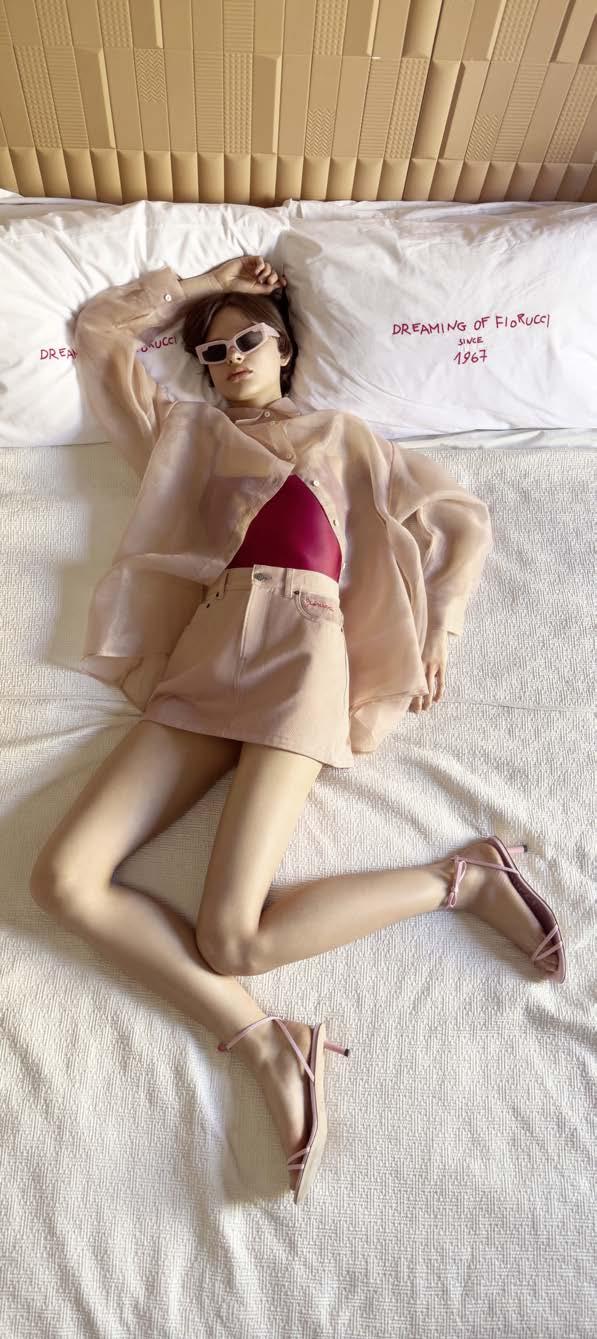
The comeback of the year? Might be, but Alessandro Pisani is not here to ride a nostalgic wave. With a résumé that includes leadership roles at Diesel and a deep understanding of brand culture, he’s rebuilding Fiorucci into a contemporary brand with cultural bite. Backed by entrepreneur and philanthropist Dona Bertarelli, Pisani is taking a strategic and content-driven approach to revive the iconic Italian label. His mission? To reconnect Fiorucci with a new generation – not through blind replication, but with purpose, playfulness, and the right partners.
Alessandro, what made you take on the challenge of relaunching Fiorucci?
Alessandro Pisani, CEO Fiorucci: It’s a brand with soul. For many, it’s memory and emotion – a place, a vibe, a cultural phenomenon. But relaunching such a brand today means more than just reusing icons. It’s about making it relevant again.
What was your starting point?
We went deep into the DNA of the brand. With the help of Publicis, we built a brand book that defines Fiorucci’s values for today – not as a museum piece, but as a vehicle for cultural storytelling. We started with a fashion show at Triennale Milano, in dialogue with modern art and young creatives.
Is retail part of the plan?
Yes, but selectively. Instead of rushing into stores, we’re building cultural relevance first. Our space in Milan’s Chinatown, called Circolo UltraFiorucci, is both showroom and cultural venue. It hosts exhibitions, connects with the community, and sets the tone for what Fiorucci can be once more.
What kind of retail partners are you looking for in markets like Germany and Austria?
Those who share our vision. Retailers that curate a mix of strong brands – think Acne, Jacquemus, Nanushka – and are open to storytelling. We’re looking for partners who can activate the brand beyond the rack. Fiorucci needs a stage, not just a hanger.
Are you aiming for seasonal collections or a drop model?
Both. We respect wholesale cycles, but we also activate when a new story is ready. Sometimes a product needs a narrative, sometimes the story inspires the product. What are your plans for Germany and Austria?
We teamed up with Timothy Hoferer from Modeist, we strongly believe that it takes time to set the right steps. For sure we want to be in the relevant retail in those countries, but we need to find the partners to tell a new chapter of Fiorucci with.

Alessandro Pisani had different leadership roles in the global fashion business before he took the chance to revamp the iconic Fiorucci brand like a well-funded start-up.
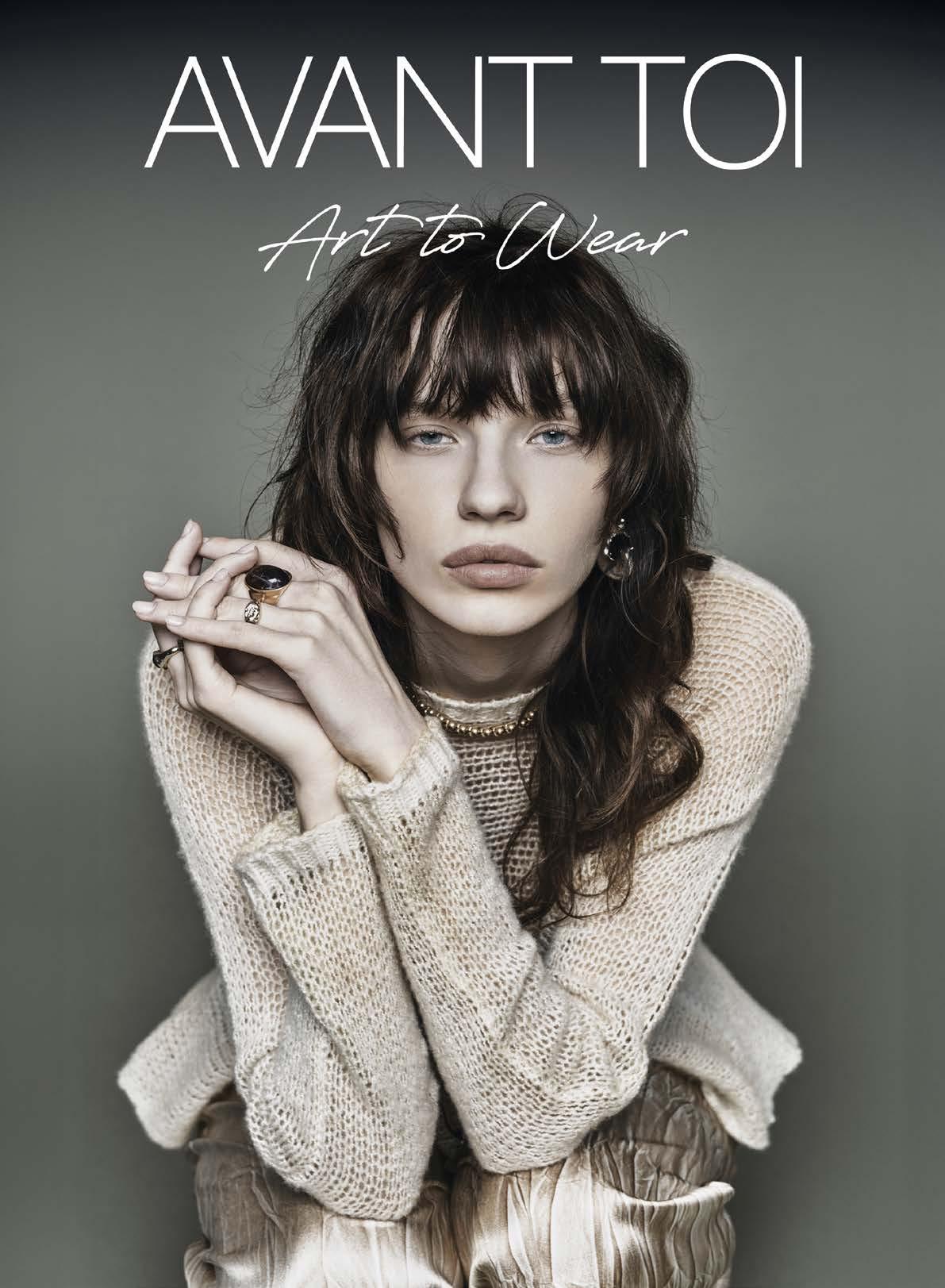

New York fashion house Rag & Bone returned to Pitti for spring/ summer 2025. The stand, complete with a café, reflected the charm of a New York coffee shop. Under the title “Voices of a Silent Generation”, designer Robert Geller combines British prep style, post-war workwear and Americana with technical sophistication for the current collection. The focus is on denim highlights such as Infuse, with deep, saturated colors, Airflex, Rag & Bones’ lightest and most breathable performance denim, and Miramar, bestselling archival prints on ultra-soft technical knits. The collection combines modern workwear silhouettes, leather jackets, chinos, tailoring and lightweight knitwear. @ragandbone
With the spring/summer 2026 collection, Colors of California tells the story of modern everyday life –versatile, fast, unfiltered. Under the motto Selective Identity, styles are created that combine comfort and coolness. For all those who have big plans and yet want to remain fully themselves. The focus is on sneakers with flexible soles, handcrafted grosgrain details and materials such as leather, textile, or colorful embroidery. There are also ballet sneakers – a hybrid of feminine ballerinas and sporty silhouettes that effortlessly combine streetwear and quiet luxury. The collection is an invitation to shape your day at your own pace – with styles that go along, think along and walk along. colorsofcalifornia.it, @colorsofcalifornia
Everyone wants ballet sneakers, not just dancers.
Function paired with sophistication: The new collection from Rag & Bone.


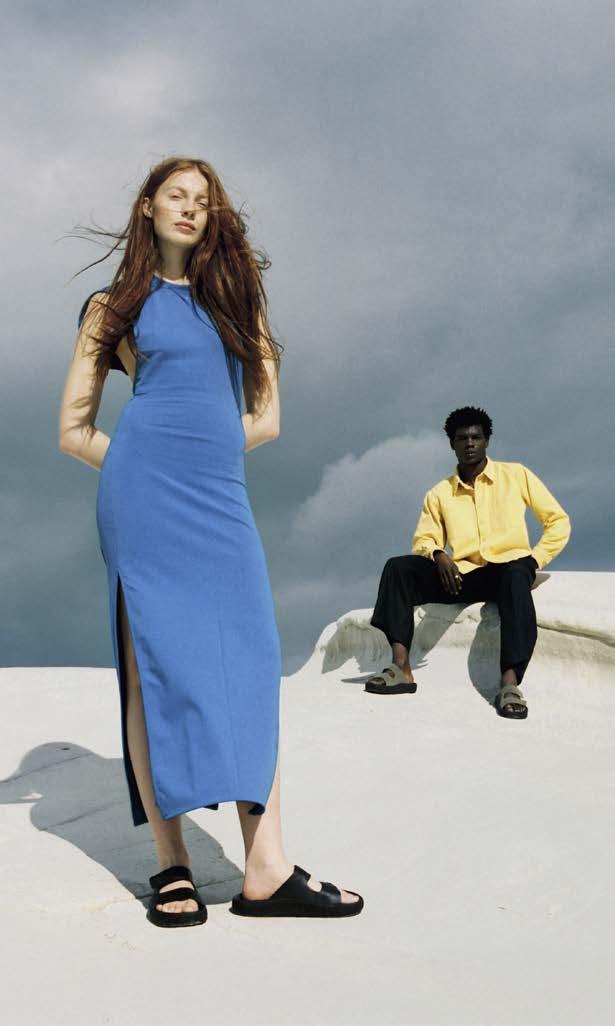
Since its founding in 2005, the French sneaker brand has been producing in Brazil, with a strong focus on social and environmental justice. Now Veja is presenting its first sandal with a rubber sole at a retail price of 120 Euros. The straps are made from Organic Traced Leather and can be individually adjusted thanks to two Velcro fasteners. Further models are in the works www.veja-store.com

Out Of offers Acuity, a pair of sports sunglasses with integrated prescription lenses. Thanks to two optical lenses precisely milled from a single shield lens, they combine lightness with an exceptionally wide field of vision and offer the possibility of correcting a wide range of visual impairments. The company has been B Corp certified since 2024. @outofoptics
Blundstone x Comme des Garçons
Originally developed as a clog for chefs and dishwashers, the Blundstone model caught the attention of Junya Watanabe, creative director of Comme des Garçons Homme. He fell in love with the simplicity of this shoe and sought to collaborate. Now the model is available in a limited edition, featuring a unique white and blue striped footbed. @blundstone


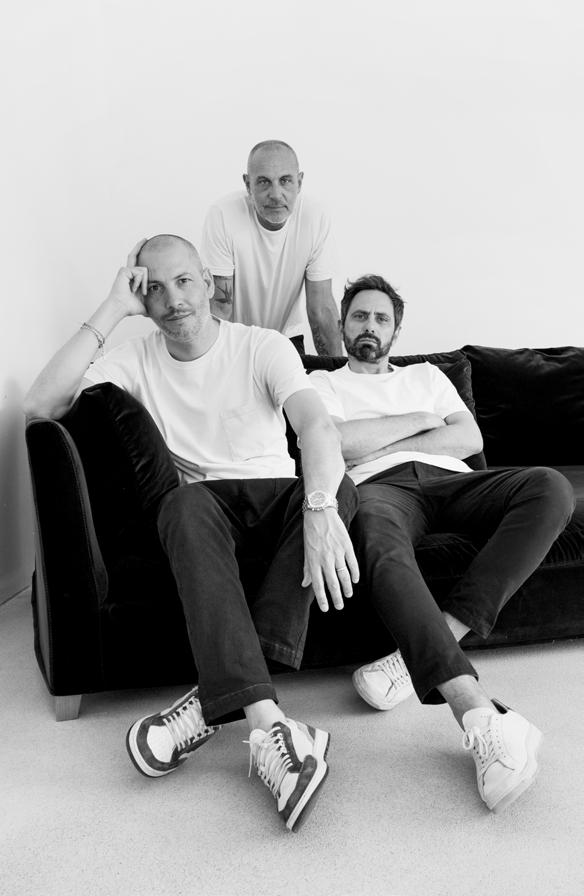

A simple logo, minimal design, but maximum recognition value: D.A.T.E. celebrates 20 years of sneaker design. We invited co-founder Tommaso Santoni to talk to us.
Tommaso, 20 years of D.A.T.E.! Does it feel like two decades?
Tommaso Santoni, Founder and CEO D.A.T.E.: To be honest, no. It feels like yesterday. And yet so much has happened. I don’t just see our shoes, but also all the conversations and decisions that have led us to this point.
How did it all start?
We were four friends with different jobs, but one idea: sneakers that we wanted to wear ourselves. There was nothing that matched our style. So we made the first 700 pairs we ordered ourselves – in Damiano’s father’s garage workshop.
What was your guiding principle right from the start?
Design, quality, identity. No trends, but longevity. Made in Tuscany 2.0: High-quality materials and artisanship from our homeland, reinterpreted.
How are things going today?
150,000 pairs a year, a turnover of around 20 million Euros. Growth has never been an end in itself, we are all about attitude. Branding is central: a D.A.T.E. shoe should be recognizable – even without a logo. That’s why we are in top stores such as Breuninger, KaDeWe, Bongenie, The Corner Berlin and Braun in Hamburg – and with over 20 pop-ups per season, we also have a strong presence in Japan.
What is your recipe for success in a crowded market?
We don’t want to be fashionable, we want to be relevant. With clarity, consistency, and passion. D.A.T.E. should convey a feeling, not just sell a shoe. That’s why we deliberately keep design, development, and marketing in-house.
How do you look to the future?
With the same passion as on the first day. We recently started working with Komet und Helden, because the market needs real partnerships. In the D-A-CH region, we don’t just want to sell, we want to grow sustainably – with people who understand our philosophy. We are also planning new flagships outside Italy. One thing is clear: no matter what happens, we will remain true to ourselves: Quality, authenticity, and style.

For spring/summer 2026, Colmar presents two lines that interpret change in their own unique way. The Change Over collection is all about conscious change. Technical outerwear remains at the heart of the collection, from ultra-light down jackets to hybrids made from stretch and natural materials. A new feature is the consistent expansion of the total look, which combines functionality with fashionable clarity. Four themes structure the season: Metropolitan Shelter, Escape from the Ordinary, Pantelleria, and Revolution. Colmar Sport responds directly to climatic challenges, which become design elements: With breathable fabrics, UV protection, and technical cuts.




For spring/summer 2026, Mou is staying true to its brand essence while at the same time consistently thinking ahead: precision artisanship, high-quality natural materials and casual shapes meet new volumes, textured surfaces, and subtle statements. Suede leather in soft tones, coarse crochet stitches, metal rivets and braided details give the models a raw, organic aesthetic with recognition value. Lightweight EVA soles and padded insoles ensure maximum comfort without compromising the look. Whether as a raised clog, slide with wide buckles or open sandal with fringes and a striking logo: the new silhouettes work effortlessly between city, beach, and spontaneous excursions. Mou stays true to itself – and goes one step further in the direction of urban lightness. www.mou-online.com

“P448 creates forward-looking trainers inspired by artists, athletes, musicians and changemakers,” says the brand. “We innovate at the intersection of culture, self-expression and sustainability, always looking for the unexpected. With Butterfly Mark certification, we are leading the way in environmental, social and governance issues, focusing on progress rather than perfection, and continuous improvement. We use recycled, regenerative, and bio-based materials, while our reputation for extreme comfort combined with an affordable luxury price point really sets us apart. This season, our best-selling iconic styles – John, Monza, Jack, Thea and Vert – showcase our meticulous artisanship. From the materials to the hand-stitched soles, our skillful artisans ensure that each sneaker combines form and function. P448 delivers innovative, Italian-made sneakers for those who live boldly and fearlessly.” www.p448.com
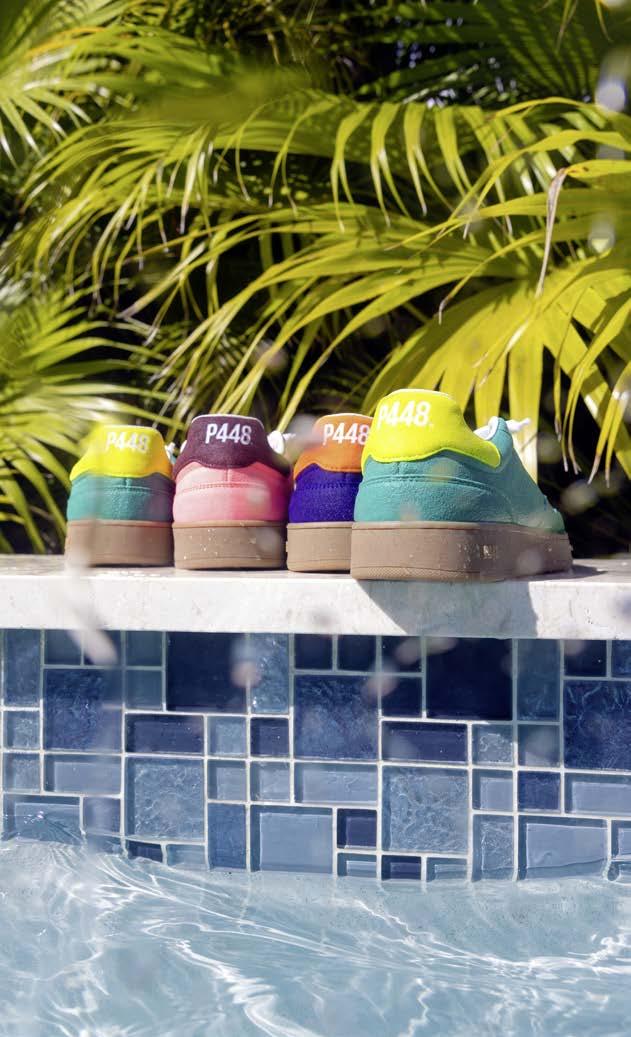


Sculptures made of biomaterial are intended to encourage us to reflect on our role as creators, custodians, and collectors.
Marcin Rusak
Warsaw-based artist Marcin Rusak works at the interface of art, design, and research. He explores themes such as transience, nature, and beauty. His works are created from innovative materials and combine aesthetics with critical thinking. With the installation Ghost Orchid, which he showed in the former Pasino greenhouses as part of Milan Design Week, Rusak questions the limits of creative control and the value of transience. The biodegradable sculptures challenge us to rethink the life cycle of objects.
(See photo installation page 293). www.marcinrusak.com

campaign agencies showrooms IF A PAIR OF TROUSERS NOT ONLY EXPRESSES YOUR CHARACTER, BUT STRENGTHENS IT – THEN YOU‘RE WEARING raffaello rossi.


“Isn’t it incredible that a product, a shoe, is 100 years old – and more relevant than ever?” says Marco Tamponi, Global Brand Director of Superga on the 100th anniversary of the 2750 model. The technology that started it all is vulcanization. This involves hardening rubber with sulphur at high temperatures - a process that makes the shoes particularly flexible and durable and which every single pair of Superga shoes still undergoes today. This technology, as well as the provocative campaigns of the 1980s and 1990s (“Hate it. Or love it.”), make it clear that Superga has never conformed, but has always had its finger on the pulse of the times. Today, the 2750 is a style classic, with a special comeback to mark its anniversary: the “1925 Made in Italy” model is back – a tribute to the original. Handmade in Italy, inspired by its origins and limited to exactly 1,000 numbered pairs. superga.com, @superga_official
Duno
“Redefining the True Value of Products”
How does an outerwear brand remain relevant in 2025?
Chris Wang, CEO of Duno: Through uncompromising quality and a wellthought-out price-performance ratio. The current circumstances challenge us to redefine the true value of our products. A brand must remain true to its identity, but also be flexible and forward-looking, and adapt its communication in particular. What does relevance mean to you?
For us, relevance means striking a chord with new generations – in our products and our tone. We can’t cling to the past. It’s about being credible today, speaking the language of the times and not losing our DNA in the process. Where is Duno headed?
Quality remains our core promise. We are focusing on new markets, particularly South Korea. We are also looking at new technologies and social trends. Our lifestyle will change fundamentally over the next five to ten years, and we want to be ready.
d-duno.it/it, @duno_official
The “1925 Made in Italy” special edition: A faithful recreation of the first 2750.



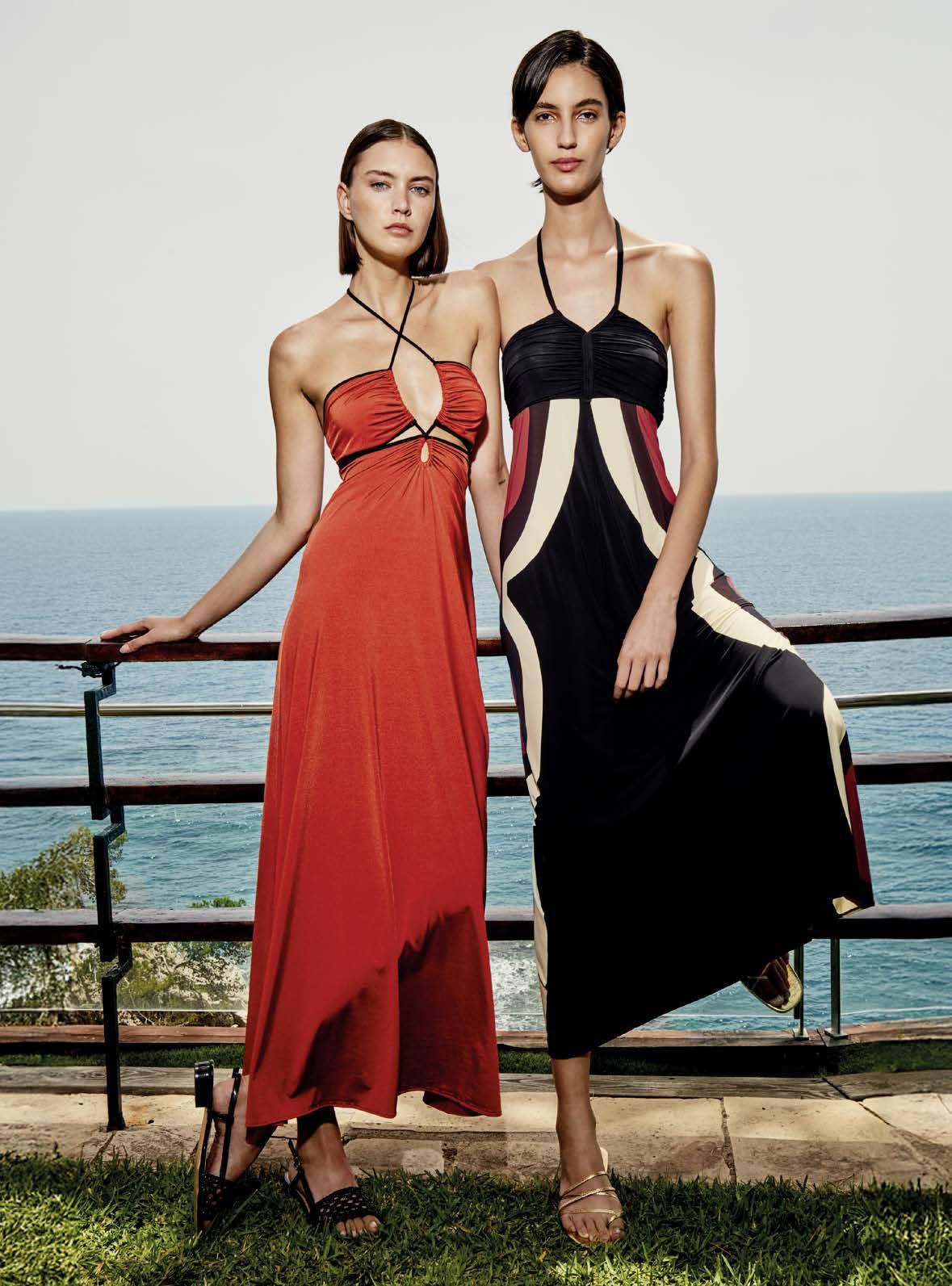

The brand from Moergestel in the Netherlands is gearing its sales strategy more towards the international market and is now a regular exhibitor at Micam. “We will continue to be present at the relevant order dates in Germany, even if these now only have regional appeal,” says Commercial Director Pepijn van Bommel. The international market is becoming the fifth pillar of sales alongside retail, wholesale, e-commerce, and dropshipping. The collection combines timeless basics with progressive silhouettes, innovative materials, and sole units – for example, for retro runners, derbies, and maritime loafers. Italian leather, exclusive prints, and color accents characterize the brand’s style. www.florisvanbommel.com

and sophistication:

Keeling’s results are impressive: 250 PoS will be added worldwide for the new season and global growth is 180% compared to 2024. In addition to Italy and the D-A-CH region, the main markets are France, Spain, Portugal, Benelux, Greece, Canada, the USA, South Korea and China. In Germany and Austria, the brand is represented by Hinterhofagentur from Munich. A strong boost on the Swiss market came from the fashion agency François Büche. The women’s collection is brand new. Here, too, the focus is on the patented piece dyeing process. In addition to carry-over bestsellers, new seasonal color nuances have been added. @keeling.io



Weekend Offender is launching new cuts, fabrics and colors for spring/summer 2026. It also sees the return of the soccer jersey, which is rooted in Terrace culture and has been given a contemporary makeover. Outerwear focuses on wide, casual silhouettes. Graphic T-shirts continue to be shaped by visual influences of British subcultures such as soccer, music and cult films. What’s different this season is the sharper execution: more sophisticated compositions and a more refined approach to design that doesn’t lose its raw energy. www.weekendoffender.com

Balance between attitude and authenticity: Weekend Offender.

For the upcoming spring/summer 2026 season, Italian label Bob is offering a special capsule within the collection: selected classic pieces from recent years are completely reinterpreted through degradé dyeing and partially hand-painted looks. Each piece is unique in itself. Bob’s origins as a brand go back many years, with hand-painted polo shirts. To this day, the team is committed to fashion and artistic creativity. In Germany and Austria, Bob is represented by the Munich-based Hinterhofagentur. @bobcompanytheoriginal
Bob is bringing back T-shirts with color gradients from the archives as unique pieces.

White Tee
Always in demand: the perfect white T-shirt, like from My White Tee. “The best qualities with a soft feel, a neat look with loving details are characteristic,” says founder Frank Meyer, who has his products manufactured in small workshops in Portugal. The 27-piece collection is available at retail prices ranging from 39 to 79 Euros. mywhitetee.official


Collection N_01
Delicate and Confident
For spring/summer 2026, Daniele Fiesoli is designing a quiet celebration of female self-determination. Lingerie-inspired panties, bustiers, and bodysuits take center stage. Transparent fabrics, flowing silhouettes, and neutral tones create an image of lightness and clarity. Layering becomes an expression of identity. A focus on the essentials: beauty with attitude. danielefiesoli.com
The vegan brand founded by Daniela Brunner has been recognized with the PETA Vegan Award Fashion as the Best Vegan Luxury Brand. Net proceeds go to projects run by PETA and Animal Equality. The collection combines romantic designs with modern aesthetics and features Plauen lace, recycled polyester, Ecovero viscose, and organic cotton. Everything is handmade in Germany.
@giuliaandromeo
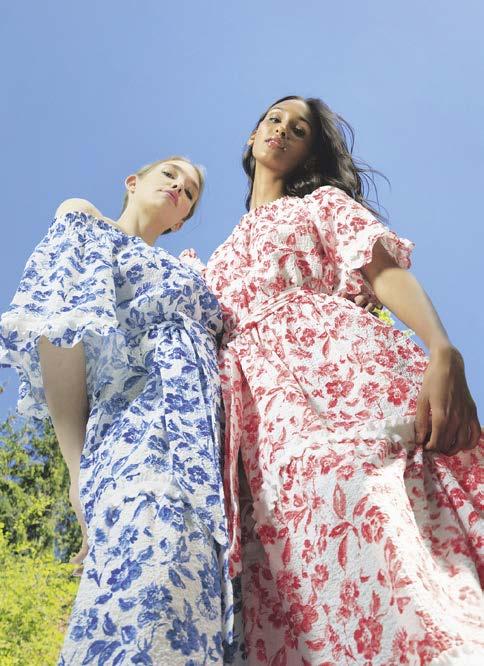
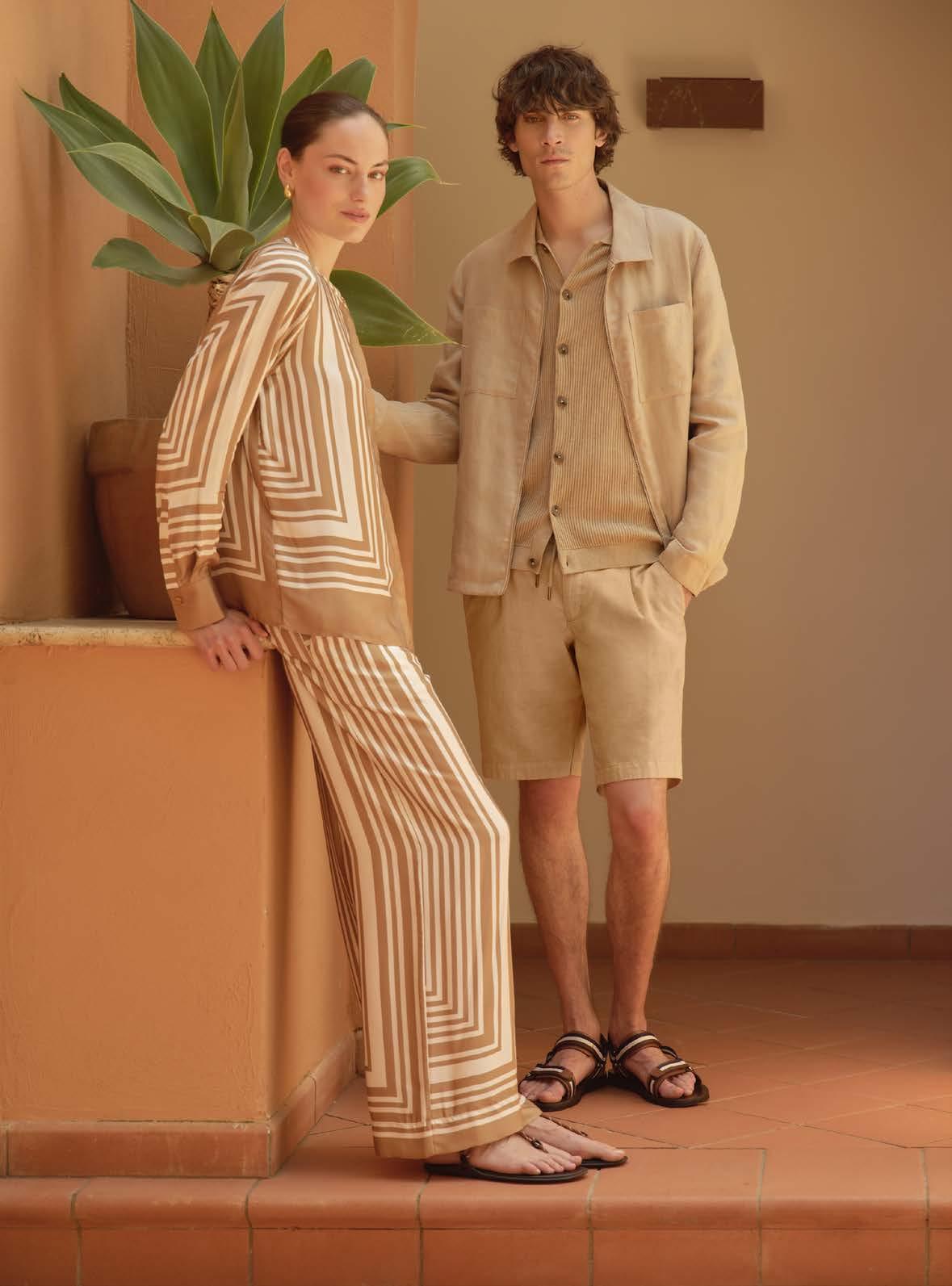

Leonie, Deblon Sports is already very successful in the Netherlands. Last season you launched in the D-A-CH market. How did that go?
Leonie Timmerman, founder of Deblon Sports: Fantastic! Our agency Prins-Juric acquired 110 new customers. The close cooperation was crucial to establish ourselves in German-speaking countries.
Why has the collection been so well received?
Shaping, super-comfortable leggings are at the heart of the collection. Thanks to our all-day concept, women can wear them around the clock: perfectly combined with our popular Stevie Jacket, the Carice Cape or our beautiful Knitted Boyfriend Cardigan. Comfortable, feminine, elegant. That’s why we are increasingly perceived as a fashionable brand.
What are you currently offering in terms of fashion?
Animal prints, cozy sweatshirts, feminine jersey tops, stylish windbreakers and signature accessories. Plus a quickly available NOS collection. Our premium quality is also impressive. Our leggings retain their shape and color – the Deblon magic remains. www.deblonsports.com


Nine to 9
With the spring/summer 2026 collection, Nine to 9 focuses on consistent reduction: 50 styles, seven colors, all plain. The core collection from Modeist interprets minimalism with flowing blouses, new pant shapes and clean dresses. The quality of the technical jersey turns end customers into loyal buyers, and production in Portugal is also an important argument. The label expands beyond the D-A-CH region for the first time. New agencies in France, as well as the Middle East and North Africa, are strengthening its presence there. Distribution will take place in February 2026. www.modeist.com

Uncomplicated, fresh, with a positive energy: the name of this new collection is also the message – for fashionable, casual lightness. The focus is on innovative knitwear, with pullovers and polo shirts and intarsia that convey an optimistic message with hearts and future statements. The fabrics are high-quality, such as a soft cashmere-wool blend, while the silhouettes vary between slightly oversized and feminine fits. Jersey essentials go well with the college look, for T-shirts and polo shirts. Lettering and appliqués with positive messages continue to dominate. Round-neck sweatshirts, hoodies and shorts complete the collection, with retail prices ranging from 150 to 300 Euros. Agentur Unifa is responsible for distribution in German-speaking countries. www.bloom-fashion.com




What speaks for Bloom? The knitting expertise, translated into preppy sixties styles with a Mediterranean jet-set flair. Luxurious cashmere-silk filament qualities in powdery to bold pastel colors, plain or as a striped design in a sporty tennis look. Lightweight fine knits made from a wool-cashmere-linen mix, as well as ultra-fine merino. Bold colors: cotton-nylon in a crochet look. A highlight: Mink Wash Cashmere, a twelve-hour washed knit that does not pill, as a short or long sleeve, wrap cardigan or striped jumper. The fits range from feminine figure-hugging to casually oversized. Dresses with floral prints, polo shirts, shorts and silky lace tops complete the collection. www.bloom-fashion.com















Andrew Livingston founded Knickerbocker in New York in 2013 as a manufacturing company on the border between Brooklyn and Queens. The philosophy is based on a deep appreciation for people and processes, which the brand has maintained even as it has expanded. Today, produc tion takes place in Portugal, where the warehouse for Europe is also located. Pants cost between 200 and 260 Euros, jackets between 300 and 500 Euros. The collection comprises around 40 pieces. Dirk Thomas and Felix Engelmann from Haptiques organize distribution for Europe. Customers include 14oz in Berlin, Dee Cee Style in Zurich, and Son of a Stag in London. www.knickerbocker.nyc
Knickerbocker is characterized by its American style with elements from art, music, and sports.
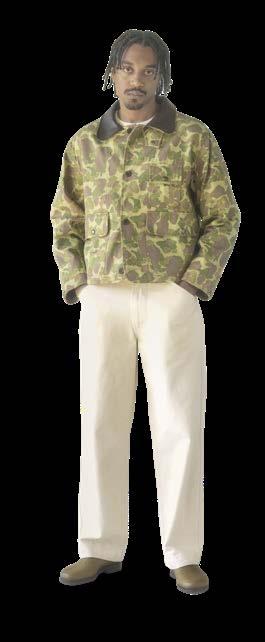

PSD relies on reach through professional athletes and influencers.



The US label PSD was recently able to win NHL star Mitch Marner from the USA as a testimonial. In Europe, the brand is relying on British rapper Central Cee, among others. In German-speaking countries, skateboard pro, model and actress Yasmine Stetter is a prominent brand ambassador. Numerous athletes from the world of sports are wearing PSD’s eye-catching printed underwear. The most important retail partners in the D-A-CH region include Zalando, About You, Blue Tomato and the DEF store. Distribution is handled by Chusaja, with showrooms in Munich and Zurich. www.psd.com











More service: the specialist for shirts, blouses, and dresses now offers a year-round NOS program with triple calculation. “There is a growing demand for the ability to replenish goods during the season,” says owner Heiko Storz. “That’s why we are significantly expanding our fall/winter range, with all essentials receiving a refresh.” New highlight: “A double mercerized interlock fabric; incredibly beautiful and high-quality, but at a reasonable price,” says Storz. Shirts and blouses cost 99.95 Euros retail price, with additional shirt styles available for 49.95 Euros retail price. Fil Noir Uomo features V-neck and crew neck styles, while Fil Noir Donna offers more feminine styles, with an A-line and V-neck. “We are also strongly associated with linen, and we are capitalizing on this strength with many different styles. For example, we have five styles for men in 23 colors and twelve for women, including dresses, in a total of 21 colors.” www.fil-noir.com


What is your response to the changes in menswear— keyword: Hybrid looks?
Joseph Payr, Managing Director, Steinbock: Breaking away from rigid clothing patterns has always been a central theme at Steinbock. Processing methods for jackets are being revamped and the use of plaque is being reduced to a minimum. Outer fabrics are mostly elastic or made of jersey. This results in softer shapes, greater comfort, and a more casual look. Hybrid also means expanding the range of applications and meeting new work-life balance requirements. What lessons have been learned one year after Maximilian’s launch?
Maximilian has made it perfectly into its preschool age. Customers confirm that Maximilian is filling the expected market niche perfectly. We are now building on the bestselling items and expanding the range in the direction of fashion to meet customers where the mainstream ends. This means that we are becoming bolder and creating challenging designs across the entire collection. www.maximilian-fashion.com

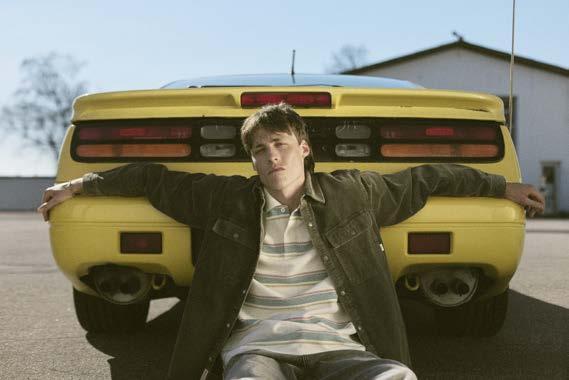
In 1995, friends Christian Katballe and Palle Bruun Rasmussen founded the label in Aarhus, Denmark, based on a simple idea: to create casual streetfashion that they themselves wanted to wear. “We never intended to conquer the world with another fashion brand. We made clothes that we believed in,” says Palle Bruun Rasmussen, adding: “Revolution has always been rooted in the things that move us: sports, art, graphic design, and architecture.” Alex Braunschmidt from Street Files in Switzerland, the Label-Agent agency in Germany, and Chris Dörr in southern Germany and Austria are responsible for distribution. revolution.eu
“We Want to Show Who We Really Are”
At an event at Abseits in Stuttgart, you customized sneakers and hand-painted a shop window. Are events like these the best way to reach customers?
Dong Seon Lee, Creative Director ID Eight: Yes, because they give us the chance to show who we really are. Personalizing sneakers live, transforming a shop window into a work of art, telling our story – all of this creates a much deeper connection than a social media post.
The sneaker market is highly competitive. How important is the community?
Absolutely crucial! Today, people aren’t just looking for a product, they’re looking for a language that makes them feel like they’re part of something and a place where they can find themselves. It also gives them something tangible: People are more inclined to make sustainable decisions when they feel like they’re part of a collective effort.
Your product is vegan, fairly produced, and sustainable. Is that a deciding factor in the purchase or just an add-on?
Most people want to know how we produce our products and where the materials come from. We want to make our sustainability visible, so we use environmentally friendly packaging and offer the option of returning sneakers at the end of their
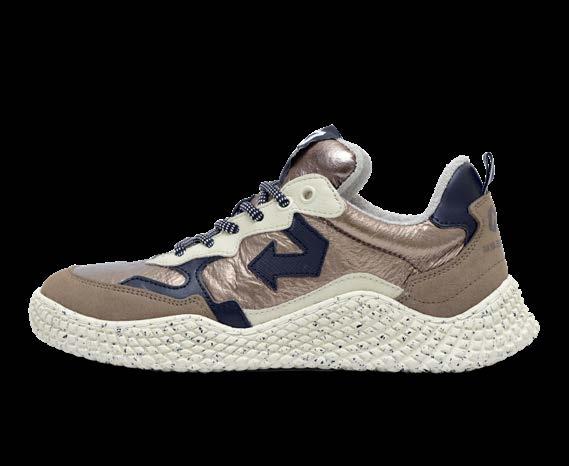





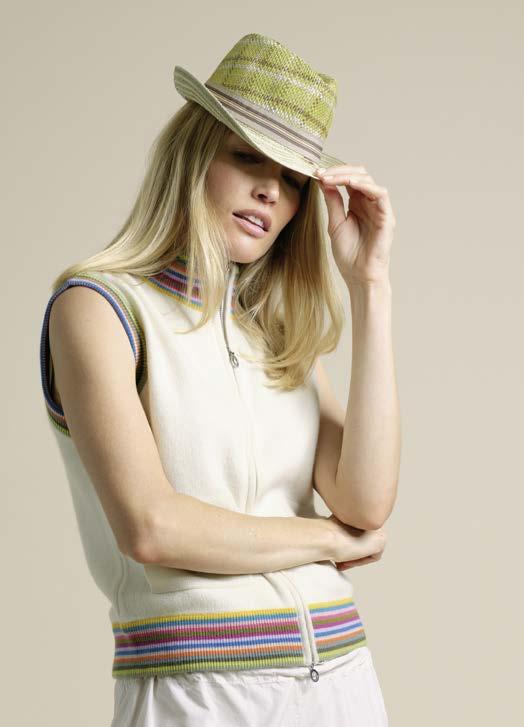


Simone, what makes your product relevant?
Simone Goschler, owner of The Holy Goat: Today’s products need to impress across the board. They must evoke emotions, match personal lifestyles, and be manufactured fairly. Fairness at every stage of the manufacturing process is, to us, a matter of course.
Fashion is now only justifiable at a fair price. Do you agree?
Not entirely. Some customers buy a beautiful product because it appeals to them on an emotional level and makes them feel good about themselves. In such cases, the price is secondary.
Yet price sensitivity is also an issue in the luxury segment. For comparable basics, yes. The situation is different for unusual products that stand out due to their unique finish and artisanship. Their higher price is perceived as justified.
Is luxury in its old form obsolete?
Brand fetishists obviously still exist. Yet an increasing number of women are interested in origin, artisanship, details. To them, this luxury is a statement that accentuates their individuality.
How functional should a cashmere collection be?
Absolutely versatile! Our pieces work just as well on the beach as in a restaurant; they are great eye-catchers, of high quality, and comfortable. That is why our customers are often asked about them. Naturally, that flatters us!
How does fashion boost self-confidence?
Everything we consciously surround ourselves with boosts our self-confidence. However, the wearer’s desire for beauty and aesthetics extends beyond the wardrobe – it only begins there. We all wish to present ourselves in the best light. www.theholygoat.com
Pierre
Cardin
“Business as Usual” Is Not Enough
What are menswear customers looking for today?
Volker Wunderlich, Head of Pierre Cardin International Markets: They are loyal and affine to the brand. They pay attention to fit and quality, but look for innovations in terms of fabrics and colors. The total
look remains fragmented, styles are mixed, and the formal sector is losing ground. Men want to be well-dressed, but not necessarily in a classic sense.
How do established brands need to reinvent themselves?
It is essential to implement these wishes and requirements, not do “business as usual”. Playing with materials, colors and properties will show who will be the winners in the future. www.pierre-cardin.de



Sturlini Firenze
In addition to the spring/summer 2026 collection, Sturlini Firenze is also presenting a special sneaker project: a denim-dyed sneaker with a white rubber sole, made from Pioneer Denim using cotton from small African farmers – sustainable, resource-saving, socially engaged. Part of the

For spring/summer 2026, the men’s suit is being reimagined: Suitable is a capsule collection that combines elegance with urban casualness. Elegant satin details and a subtle rock-inspired twist give the line its distinctive look, marking an important step in the relaunch of the label. It aims to recapture its home market and set new trends internationally. danielealessandrini.com
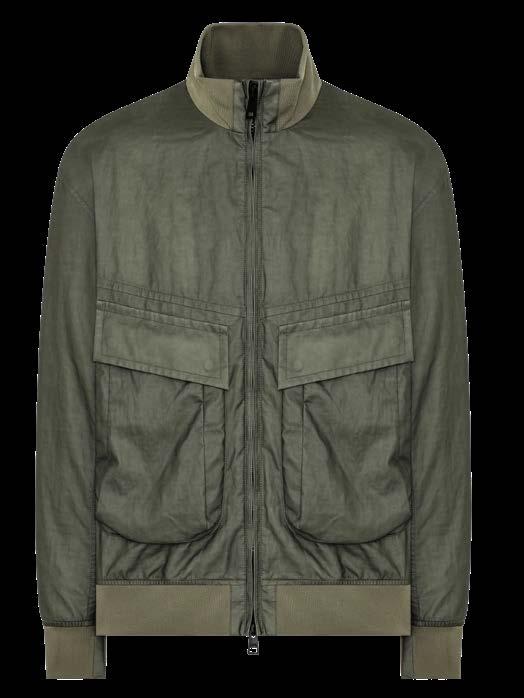
For Spring/Summer 2026, Duno combines classic men’s fashion with innovative materials and functionality. There are two lines: Timeless reinterprets outerwear with technical fabrics and smart details. Contemporary Vibration focuses on volume, rubberized linen, and bright colors. The looks: ready for every move between city and nature. Duno keeps moving – with style and substance. d-duno.it

DETAILS:

In 2025, Oeko-Tex Made In Green will celebrate its tenth anniversary. Why is the label more important than ever?
Alfred Beerli, CEO of Oeko-Tex: Made in Green is a key tool for companies to implement their sustainability strategy. As an all-in-one solution, it stands for tested product safety, more sustainable processes, and more socially equitable working conditions in global supply chains. In 2024 alone, the label had a positive impact on around one million textile workers. The increasing demand also confirms this: In the last fiscal year, the number of labels issued grew by 52 percent.
How exactly does the label reflect sustainability?
Every stage of production can be traced via a QR code on the label. This transparency creates trust and protects against greenwashing. In 2024, over 300,000 labels were scanned. This makes Made in Green a credible guide for companies and consumers who value transparency, safety, and genuine sustainability. What is the vision for the future?
We will establish Made in Green as the international standard for sustainable textile and leather products. Our focus is on integrating new technologies to improve traceability and transparency, and on expanding the criteria to meet increasing environmental and social standards. Our goal? To offer both companies and consumers a reliable tool for sustainable purchasing decisions. www.oeko-tex.com
Emotion! Anyone who stopped by 40Weft at Pitti Uomo was able to clearly see the ambition of the 40Weft team to appeal to all the senses with their booth, and their fashion.
“We want to create a wow collection!”
This clear objective is based on solid foundations. The Italian pants specialist relies on in-house production, in-depth expertise, and flexible processes. The preliminary stage is crucial for achiev ing the perfect result. “We invest a lot of time in researching materials to ensure that quality and price are in the right balance.” Long-standing partners in the supply chain ensure a reliable product, as does the com pany’s own production facility, where there is plenty of scope for tinkering and experimentation, both in terms of fit and treatments, to ensure that the look and feel of the garments evoke emotion. This is also achieved by the 16 colors the pants are available in, as well as the com plementary Fantasies collection, featuring checks, prints, and special materials.
“Our treatments give each piece an individual touch, which is what sets 40Weft apart.”
Characteristic features include technical, ultra-lightweight fabrics with stretch and a soft feel in relaxed fits for chinos, cargo pants, and jogging pants. Shorts and Bermuda shorts are among the bestsellers, especially in the home market of Italy, where 40Weft has 600 points of sale. Every collection features the almost iconic field jacket, which has been reissued with minor changes for 30 years. The Italian brand is currently focusing on further expanding its German-speaking market. www.40Weft.com






Mey has achieved and even exceeded one of its key sustainability targets: a significant reduction in CO2 emissions. The goal of reducing emissions at the sites in Germany, Portugal, and Hungary by 15% by 2025 compared to the base year 2019 was already exceeded in 2023, with a 35% reduction. The installation of photovoltaic systems, the switch to electric vehicles and the systematic reduction of internal emissions made a significant contribution to this. This result not only demonstrates the effectiveness of the sustainability strategy, but also the company’s ongoing contribution to global climate protection. www.mey.com
Circolo 1901
What does it mean for Circolo 1901 to remain relevant these days?
Gennaro Dargenio, CEO Circolo 1901: Above all, for us it means clarity and consistency. Relevance comes from focusing on your strengths, remaining authentic and constantly evolving. It’s also about being dependable for our customers – in terms of quality, reliability and presence.
Where is relevance more important: In the product, in communication or in your values?
For us, it’s a mixture of everything. It all starts with the product: unique, unconventional and with a high level of expertise. Our internal communication builds on this, conveying a strong, authentic message. Our values remain constant: authenticity, quality, clarity and simplicity – it’s often the simple things that are the most sustainable. What advice would you give to young brands that want to become relevant?
Stay true to your strengths, build on them and live by clear values. Surround yourself with people who share these values. This is how real relevance is created – through the most honest version of yourself.
circolo_1901.it, @circolo_1901




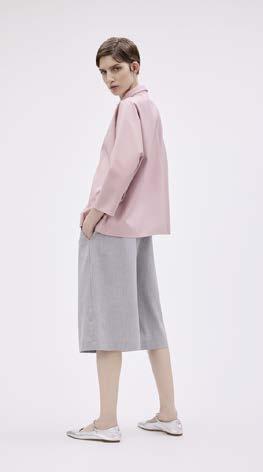







As the most comprehensive fair for the global textile industry, both for sourcing and information exchange, located in the heart of the world’s largest market and production hub, Intertextile Shanghai Apparel Fabrics exhibits across 7 halls on over 190.000 sqm and has 3100 exhibitors from 25 countries. Wilmet Shea, General Manager of Messe Frankfurt (HK) Ltd., welcomes nearly 95,000 visitors each season to give them a prospect into the future of the industry.
Sustainability is a central pillar of your strategy, with a balance between ecological and economic interests, social responsibility, and diversity. After the spring debut of Econogy Hub, what can visitors expect for the next edition of Intertextile in September?
Wilmet Shea, General Manager of Messe Frankfurt (HK) Ltd.: For 11 years, our All About Sustainability zone gave a platform to eco-focused textile suppliers and service providers. Econogy is its evolution, incorporating elements such as the Hub, Talks, Finder and Tours. The exhibition and seminar model works incredibly well, and visitors this autumn can expect more of the same, though optimistically on an even bigger scale with more new innovations and topics.
What are the most important challenges in sourcing regarding sustainability and digital transformation for the mid- and long-term?
The first is transparency and traceability. Buyers and their suppliers need to increasingly adopt digital solutions to track textiles from their source, to comply with developing regulations and effectively communicate sustainable credentials to consumers. Longer-term, being able to source circular textiles, at scale, is probably the biggest challenge to overcome.
Intertextile has showcased the full spectrum of the supply chain for 30 years. What does it take to attract exhibitors and buyers time and time again?
Intertextile started with 123 exhibitors in 1995, and it now attracts some 7,000 exhibitors and 190,000 visitors yearly. Fairgoers can always expect an extensive, world-class business platform, and we ensure the show moves with the times by strategically expanding when viable opportunities emerge – with Econogy Hub and the Digital Solutions Zone two recent examples. www.intertextileapparel.com

REVIVING +657,000 M2 OF LAND WITH OUR SS26 REGENERATIVE COTTON COLLECTION
Shoe brand Merrell has founded a hiking club to give women a stronger voice in the outdoor world, and to make hiking more accessible. Inspired by the GorpCore trend, which brings functional clothing to the city as streetwear, Merrell wants to immerse beginners in particular in the world of hiking with curated urban hike events featuring long walks in nature under the motto “Hiking is everywhere.” The events will take place not only in Hyde Park, on the banks of the Seine, and in Berlin’s Tiergarten, but also in Hanover’s Eilenriede Park, one of the largest urban forests in Europe. www.merrell.com


This has a lot of potential: Two Flowers, a line from Fil Noir, with high-quality shirts at commercial retail prices between 49 and 69 Euros and a calculation of 3.0. “Retailers are very open to new collections like this,” says founder Heiko Storz. “Our extensive expertise, high-quality tailoring and a sophisticated style with subtle details that appeals to a broad target group speak in our favor. That’s why we are almost unrivaled in this segment with Two Flowers.” T-shirts, polo shirts and sweatshirts are now being added. “It’s going to be a well-rounded thing,” says Storz happily. “You’ll be hearing a lot more about Two Flowers.” www.two-flowers.com

Juicy Couture
For the new spring/summer collection, brand ambassador Cindy Kimberly takes her fans on a journey to paradise. While the color palette is inspired by the rich warmth of sun-kissed beaches, excitingly bold evening looks make you want to explore tropical nightlife with a drink in your hand. Brand new: a high-quality stretch jersey fabric that is lightweight and highly elastic, making figure-hugging silhouettes even more comfortable to wear. Delicate hibiscus flowers made of sparkling rhinestones adorn the iconic velour looks, ensuring an effortless transition from day to night. The signature pieces of the Black Label line come in fresh mélange shades and give the super-soft velours collection a modern update. Particularly eye-catching: Logo details and accents with elegant caviar beading give the classic low-rise tracksuit a contemporary finish. www.juicycouture.co.uk
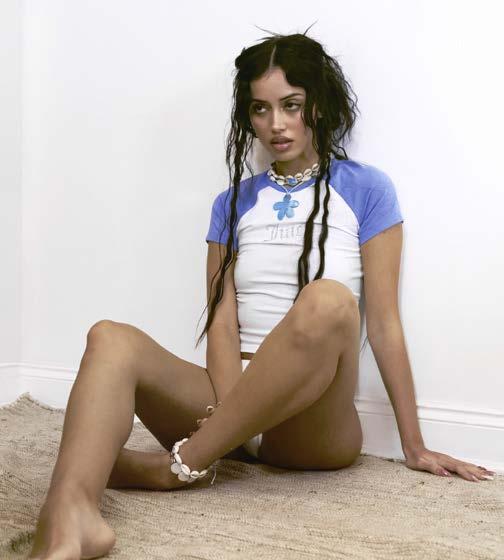

Pop-up spaces at Kastner & Öhler mark the rollout of Edblad in the German-speaking market.
For the spring/summer 2026 season, Sebago is presenting a collection that is deeply rooted in their American heritage, but with a clear view towards the future. The brand from BasicNet shows once again that it is no longer just about shoes. It is consistently expanding the total look and offers four theme worlds: Preppy Style, Dock, Summer Look and Outdoor Living. These reflect different facets of the American lifestyle – sometimes sporty and elegant, sometimes functional and maritime, sometimes casual and carefree or outdoor-inspired. Available via Komet und Helden. sebago.com

Eva Boding positions her jewelry label Edblad as affordable luxury.
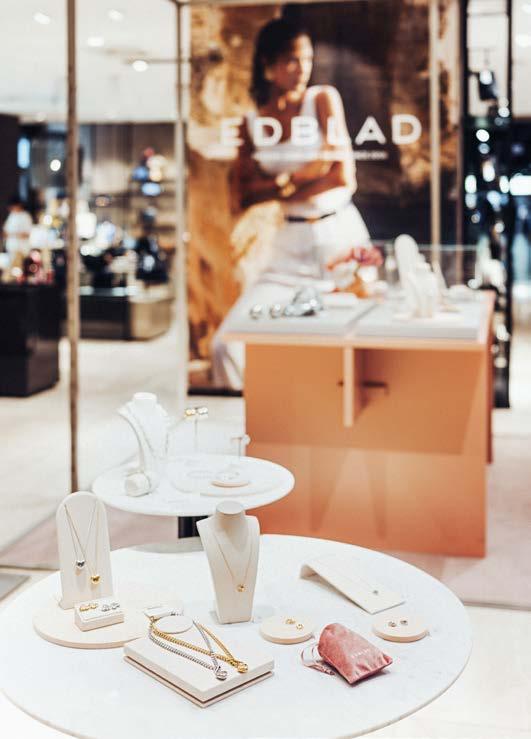
Edblad
Eva, you see Edblad as a digital and an analog brand. What does that mean?

Eva Boding, CEO Edblad: The jewelry market is evolving rapidly, and to be a relevant brand today, you have to interact with potential customers in both worlds. We want to invite people to enjoy shopping, and touch their emotions with entertaining events and collaborations, such as our pop-ups with Kastner & Öhler, with whom we are launching our rollout in the German-speaking market. This is an important step for us! Our goal is to work closely with fashion and jewelry stores to ensure a successful partnership. We are also investing more heavily in marketing to increase desirability. We already know from other successful markets that this combination works well for us.
What new additions are there to the collection?
Personally, I love our new statement bracelet, which combines design, quality, and function in one beautiful product. The Tidal bracelet is comfortable to wear, can be styled in many different ways, and is very durable.
At the same time, we are responding to the floral trend among our younger customers with the Jasmine collection – currently a bestseller! This is a good example of how Edblad adapts trends while remaining true to its core values: high product quality at affordable prices. Brand new is our design collaboration with fashion icon Fredrik Robertsson. It’s an outstanding signal of innovation and creativity, like a vitamin shot for our brand! www.edblad.com




The carved wooden figures are on display at the Stetson stores in London and Berlin.

To celebrate the 160th anniversary, German sculptor Johannes Hepp has created seven sculptures ranging from a cowboy with his faithful Western hat to an adventurer with a straw hat, a sporty golfer with a classic cap, and a stylish jazz musician with a fedora. “Under each hat is a small figure who, in terms of style, could also wear it. The size of the hat makes it almost a home, or at least a shelter for the figures,” says Hepp. “I always see my Stetson hats as a kind of roof. They definitely offer me protection.” www.stetson.eu
Inspired by fickle summers, each piece is designed to meet the demands of city life, business trips or outdoor excursions in changing weather: a collection based on movement, comfort, and adaptability. New seasonal colors include ocean blue, light green, pink, khaki, and neutral white. The fabrics have been given a higher stretch content and are even lighter and more breathable. For the first time, there are also two stretch shorts models and a new hybrid concept for women for seamless activity transitions. www.scandinavianedition. com
The Refined Function design philosophy speaks a clear language: Simple, elegant, and practical.


At Ayasse, top quality also applies to production: The entire supply chain is subject to the standards of the Leather Working Group.


For spring/summer 2026, Montecore is presenting a modern men’s collection that combines functionality and aesthetics. True to the Beyond Time philosophy, the focus is on durable, timeless styles. Reduced cuts meet clear lines and a well thought-out choice of materials. Classics such as the peacoat, trench and field jacket are reinterpreted. The color palette remains close to nature. montecore.it
For summer 2026, Ayasse once again demonstrates how supple leather can be transformed into feel-good styles in summer, too. Unlined leather styles in timeless, casual cuts and natural colors are particularly comfortable to wear. The styles are available in a plain version or with a specially developed silk lining, which is available separately and can be buttoned into any jacket.
www.studio-ayasse.com
Schott has a seventh sense for collaborations: most recently with stores such as BSTN, Anita Hass and Highsnobiety. The two shortened, fitted jacket models for the Schott x Anita Hass collection with the iconic heart stitching stand for the feminine new edition of the bomber jacket, which Schott’s spring/summer 2026 collection picks up on.


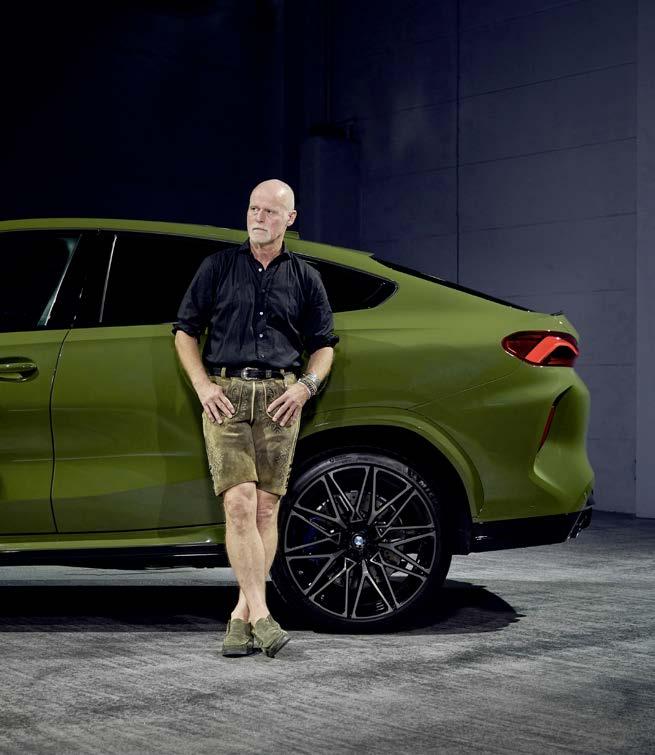
When top automotive performance meets uncompromising artisanship, something unique is created: in cooperation with the Meindl manufactory, BMW presents the “BMW X6 M Competition x Meindl” as a show car. What makes it special: the luxurious interior is furnished with chamois-tanned deerskin in old black, a nod to traditional leather trousers. This unique leather adorns the seats, center console and sun visors, among other things. Power is provided by the M TwinPower Turbo V8 engine with 625 hp (460 kW), which enables acceleration from 0 to 100 km/h in 3.9 seconds. Production of the edition with a BMW X5 M and X6 M Competition model is strictly limited. In addition to the Urban Green custom paint finish, other paint finishes are also available to order. www.meindl.de
A retro style that lives and breathes sustainability and defies the

“Zenzais are what the 80s would wear if they cared about the planet,” is the statement of the new premium sneaker brand from Mannheim, which manages to combine authentic 80s vibes with modern technology and sustainable materials. “We take the issue of sustainability seriously so that our customers can take it easy,” says co-founder Roland Sigmond. The brand’s goal: a fully circular and biodegradable sneaker. With around 90 percent natural materials, cactus leather made from 82 percent cactus, compostable soles and production in Portugal, the first three models are already very close to achieving this vision. www.zenzai.ai


Raffaello Rossi
“Hip teens don’t wear blue jeans”, as the song by the Frank Popp Ensemble in 2003 went. The world looks very different in 2025, including at Raffaello Rossi. The denim collection has grown considerably in recent years, not least thanks to the expanded range of styles. In summer, the pants specialist is focusing on a high lyocell content for flowing, lightweight styles. The highlight is a lurex-denim combination that gives the pieces a summery golden glow.
A total of 20 styles will be shown for spring/summer 2026, including denim shirts for all-over denim looks. www.raffaello-rossi.de

Since 2009, G-Lab has stood for modern outerwear in fusion with functionality and contemporary design. Thanks to the use of specially developed high-tech fabrics and multi-layered materials, the styles are windproof, waterproof, and breathable. The key style for spring/summer 2026 is the Hanna trench coat with an extra-long slit at the back and detachable sleeve yokes with buttons and loops. The pockets close magnetically, and the waist belt is hidden to prevent it from slipping. Carefully thought out down to the last detail! The collection is on display in showrooms in the D-A-CH region, France, Spain and Portugal. www.g-lab.com

With Mac 5ive, the pants specialist is opening a new chapter – for women who follow their own path. The collection offers five versatile looks for every moment of the day – from breakfast dates to rooftop sundowners.
“Mac 5ive is an expression of a new lightness that comes from comfort, clear lines and the right sense of zeitgeist,” says Head of Design Tatjana Loos. The silhouettes play with length and volume, from casual culottes, barrel legs, straight and slim cuts to capris and modern Bermudas. The colors combine urbanity and nature: Citrus nuances bring freshness, earth tones lend groundedness, delicate pastels lightness, strong accents provide excitement.
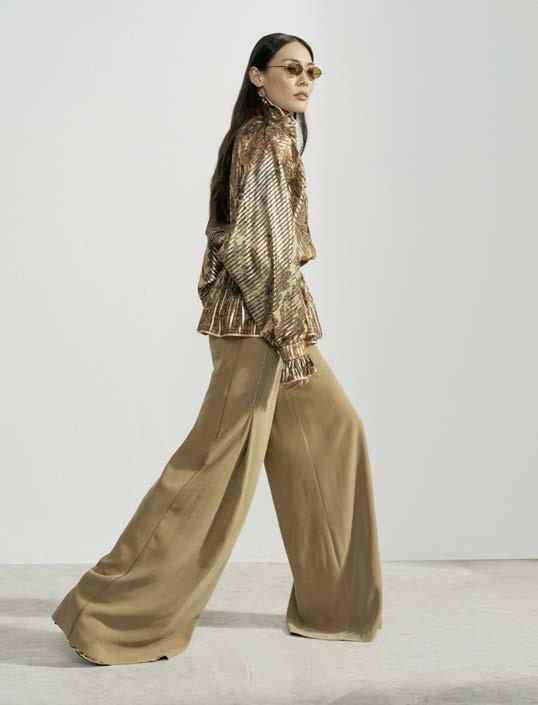

Tom Ripley
Tom Ripley’s grand campaign was already on display at Pitti Uomo, where it exuded a fresh spirit, complete with billboards at the Florence airport. The message? “We’re stepping up the pace,” says Managing Director Wolfgang Müller. “We’re all about uncompromising quality paired with a refined style and a relatable level of fashion.” The new collection reflects the joie de vivre of the 1950s and 1960s, including pastel shades. Resort wear exudes Mediterranean lightness and cultivated casualness thanks to lightweight terry sets, open-necked polo shirts, and shirts with Cuban collars. At the same time, knitwear is versatile, ranging from classic polo shirts to overshirts. Vintage stripes, chevron structures, and pappardelle ribs translate retro graphics into the present day. Natural materials such as linen, cotton, and crêpe yarns underline the focus on sustainability. “Production takes place exclusively in Italian family businesses, for slow fashion with attitude,” says Wolfgang Müller. www.tom-ripley.com

A variety of styles combining soft textures, clean designs, and feminine details.

Heidi Katzenberger, Head of Design at the Starnberg-based company, combines romantic boho themes and clean sportiness in her feminine looks. The wide-ranging collection emphasizes the personality of the customers with a trendy self-assurance.
More & More emphasizes the character and attractiveness of its customers. How is this reflected in current designs?
Heidi Katzenberger, Head of Design at More & More: In the latest collection, we place a particular emphasis on high-quality materials and unique finishes combined with timeless shapes and cuts. With elegant and feminine details, we also add fashionable and trend-oriented accents to emphasize the stylish charisma of our customers. The result is a harmonious overall look that is versatile and highlights the individual character of every wearer.
More & More has reinterpreted the classic denim. Where does the journey continue?
We are already developing ever larger jeans ranges featuring different washes. The focus is on all product groups, especially skirts and dresses, but jackets in new shapes, blouses with feminine details and fabric blends with Tencel or linen will also play a major role. The aim is to create a contemporary look that emphasizes feminine lines through innovative materials and detailed designs.
www.more-and-more.com



Daniele Fiesoli
At a time when everything is getting faster, brighter, and louder, Daniele Fiesoli has chosen a different path: pause, design and sow. Sow the World is the name of the new project: from now on, every item of clothing will be provided with a hangtag filled with seeds for wildflowers selected in collaboration with the regional beekeepers’ association in Tuscany. “Fashion should not only dress, but also inspire,” says Fiesoli. “With Sow the World, we want to set an example for more awareness, for more connection with nature.” For him, sustainability is not just a question of the supply chain, but of attitude. danielefiesoli.com

The new “Ho voglia di Capri” collection is a tribute to the Italian attitude towards life; to the lightness and elegance of a summer at the Mediterranean. Accordingly, Bugatti presented the spring/summer 2026 collection at a very special location: the Hotel Punta Tragara on Capri. Around 80 guests, including selected key accounts and influencers, gathered against the Mediterranean backdrop of the island to experience the new looks in an exclusive setting.
The collection translates the feeling of endless summer days into fashion. Light materials, flowing silhouettes and bold colors characterize the image. The design plays with Mediterranean colors and feminine and masculine elements, with fresh modernity.
“With the new collection, we want to awaken a longing for Italian lust for life and give our customers the feeling that they can hold on to a piece of summer,” says Chief Brand Officer Florian Wortmann. Influencers such as Stefano Zarrella, Tobias Reuter and Sarah Posch made sure that this message was carried far beyond Capri. www.bugatti-fashion.com


A HAND CRAFTED TRIBUTE TO 160 YEARS OF STETSON.
CUSTOM-MADE WOODEN FIGURES
HONORING A TIMELESS LEGACY.


A new lightness has been added for the new season, especially for women. “Here we are using denim with only 7 to 9 oz, which combines robustness with summery lightness,” says founder Claudio Parolini. Relaxed elegance is key. In menswear, the Japanese capsule is being developed further. Modern fits and Japanese denim handicraft are a tribute to the pursuit of perfection. Sophisticated design and high-quality materials are the hallmarks of the Italian collection, which also focuses on cotton-linen blends and fabrics with a soft touch – so that they are not only a pleasure to wear, but also feel good. www.thenimstandard.com
The new collection of golf and functional pants from Hiltl with the add-on The Course has been designed for playing golf, cycling, hiking or simply for a long walk through the countryside. Thanks to their technical qualities and finishes, the pants are ideal in all weathers. The flexibility of the outer fabrics and the waistband finish guarantee freedom of movement and crease resistance. For spring/ summer 2026, there are also functional swim shorts for the first time, inspired by clean lines and modern silhouettes that combine sporty elegance with comfort. www.hiltl.de



Viennese designer Julia Skergeth has been redefining luxury accessories since 2019. As a trained graphic artist and fashion designer, she combines aesthetics with innovation. Her models are not just possessions, they become part of a story. The now iconic basket bags are back for summer 2026: made in collaboration with an African NGO and with the support of Sisterhood Studio, they are hand-woven from elephant grass, reshaped in Vienna and finished in Italy with high-quality leather handles. www.juliaskergeth.com, www.modeist.com
One of the many Skergeth highlights: the basket bags. “They tell a story of cultures and artisanship,” says Julia Skergeth.
What does an accessory need to have to remain relevant on the market?
Alberto Zia, Managing Director Pin 1876: We have never designed our accessories specifically for a particular market niche. Instead, we consistently pursue the goal of creating products with clear, unmistakable characteristics. Anyone who appreciates precisely these values is our customer. The relevant characteristics are derived directly from Botto Giuseppe’s history: The highest quality, a fair price, and a consistent focus on social and ecological sustainability. How did the last sales campaigns go?
Turnover and volume have not increased, but we have been able to keep the figures from previous years stable – and that in a difficult economic environment. We see that as a success. Some markets, such as Germany - our strongest market for a long time - have slowed down noticeably. On the other hand, we were able to open up new markets, above all China. We are currently growing strongly there. For spring/summer 2026, we hope to maintain the level of previous years.

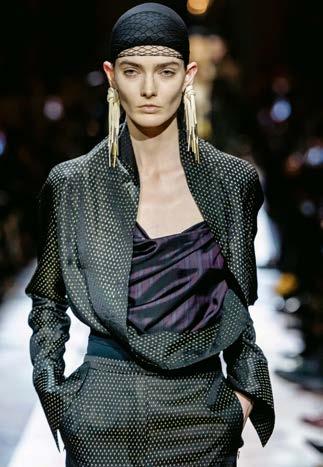
“For the first time since its creation, the use of social media is declining,” says DMI Managing Director Carl Tillessen.
“In German-speaking countries, the proportion of users fell from 84% to 80% in 2024, while weekly usage among 40 to 49-year-olds even fell by 6.4 hours. The pendulum is swinging back,” says Tillessen. “After years of bold, digital looks, there is a growing desire for fashion that can be experienced with all the senses. This is a great opportunity for bricks-and-mortar retailers: Clothes with interesting materials, subtle details and elaborate artisanship can be better presented and sold offline.”
www.deutschesmodeinstitut.de
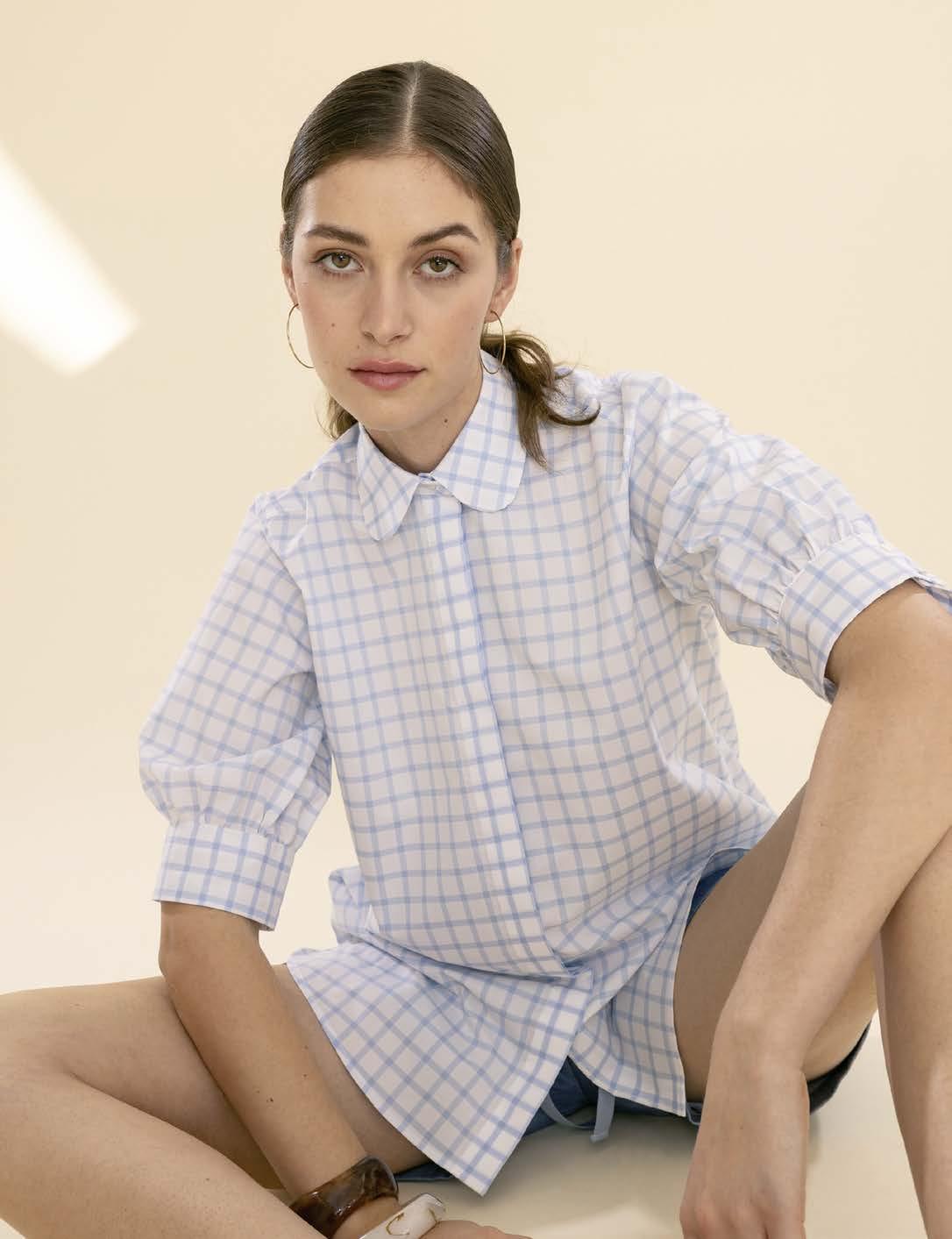

Style and essence: Diktat from Italy.
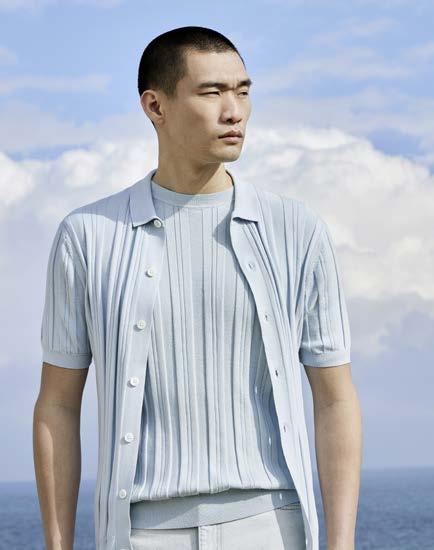
For spring/summer 2026, Italian brand Diktat is focusing on New Classic Essential Mood, with harmonious colors, high-quality materials, and urban design. Also new: a silk-cotton blend. The bestseller from Al.Ma.Tes is the Second Skin capsule, which is also suitable for traveling thanks to its functional cotton-nylon mix. Diktat is backed by 20 years of experience and expertise in knitwear. Sales figures are growing at double-digit rates, and not just in the home market of Italy. Agentur High Five is now responsible for sales in the D-A-CH region. “We are specifically developing products for the German market that cater to local tastes, with the aim of achieving significant growth here,” emphasizes Francesco Bosso, CEO Al.Ma.Tes. Presence at trade fairs such as Düsseldorf and Munich included. www.diktat-italia.com, @diktatitalia_official



In March, Casa Glücklich expanded its existing store in Eppan and now has its own shop, back office, product development, and logistics all under one roof.
Christoph Steiner, owner of Glücklich: Our goal was to present the entire product range of Glücklich and Alpe Piano in one place. We finally have the space we need to really flourish, while at the same time retaining the niche character of our concept.
What is your concept for the space?
We have placed our women’s products in the new space and also accommodated the back office and product development. A carefully curated men’s department has been created in the existing space.
How did the multi-brand idea come about?
Glücklich and Alpe Piano cover a large part of our range. We wanted to complement this with other products, so we brought in brands that share our philosophy, such as Pomandère, Danielapi, Floor, and Scaglione. This also includes innovative artisanship and designs from local manufacturers, ranging from fashion and accessories to cosmetics and jewelry. www.gluecklich.it


Jana Wieland
The creations of Austrian designer Jana Wieland stand for a dreamy, purist textile statement. “Relaxed people are inspiring people, are beautiful people,” is the leitmotif. The typical silhouette of the Viennese label is a declination of the classic shirt and wraps the body in flowing elegance. Series production of the collection takes place in two family businesses in Poland and Hungary, and all materials are GOTS-certified or reclaimed. Wieland herself founded her eponymous label after working for Marques Almeida in London and Acne Studios in Stockholm. The latest addition is the Weds collection, an unconventional wedding line that consistently upholds the language of the label. @jana_wieland

Triumph remains a pioneer in terms of comfort and innovation for spring/ summer 2026. The revolutionary Comfort Wire takes center stage again this season. It combines the support of an underwired bra with the feel of a bra without an underwire. The highlight of the season is the continuation of the collaboration with presenter and actress Palina Rojinski. Her capsule collection Waves of Glow stands for eye-catching, self-confident styles for women who want to feel seductive and fully supported at the same time. The collaboration was born out of Rojinski’s own search for the right bra. She has been working with Triumph’s design team since 2024 to bring her ideas to life.



“Quality matters…” – this is the statement with which Sold Out opens the Holiday 25/Spring 26 season. For the November 2025 delivery date, the label pairs relaxed chic with high-quality materials. Alongside the tried and tested modal fabric, a new cupro mix quality is celebrating its premiere. The collection tells a story of smart femininity. Sweatshirts, dresses, pants, and jackets are fashionably accentuated with subtle seam details. Cream, rosé, brown, navy, and black create harmonious, sophisticated total looks. A denim range is on the agenda for January 2026: three color variations, new trouser styles, and matching combination pieces in the form of blouses, jackets, dresses, and vests. A braided quality with a subtle shiny yarn provides a break in style. With around 60 pieces, the line is sufficiently extensive to stand on its own, yet it can also be easily integrated into curated ranges. Sold Out remains true to its brand essence: well-groomed, feel-good looks with substantial quality. www.modeist.com

AI IS NOT THE ENEMY OF CREATIVE OUTPUT, BUT IT DOES REQUIRE EXPERTISE IN ITS APPLICATION. THOUGHTS ON HOW THE CONFLICTING PRIORITIES OF CREATIVITY, LEADERSHIP, AND AI EXPERTISE CAN BE REIMAGINED IN THE FASHION INDUSTRY.
BY STEPHAN HUBER
It is what everyone is talking about – how artificial intelligence will disrupt everything from supply chains to concept development. Some fashion brands are endeavoring to utilize AI in their creative processes. Others are hesitant because they remain unsure whether the use of AI might destroy the very essence, the heart, the brand DNA.
Personally, I do not believe one should be afraid of AI. However, we should definitely be afraid of how we deploy it.
One thing should be clear: AI is not the enemy of creativity. Applied consciously, it can be a remarkable tool, a partner for developing ideas, a source of unexpected interconnections, a lens through which to question established patterns. It can assist a designer in drawing unexpected cues from architecture or literature, or a copywriter in varying tone and pace. It can even help a CMO simulate how their campaign might resonate with different segments, regions, or cultures.
The problem is that very few people actually apply artificial intelligence in this capacity. In fact, I have observed that AI is often not used as a tool for critical reflection, but rather as a substitute for the same – a shortcut to a convenient solution, a way of saving yourself the trouble, of not having to deal with oneself, and producing polished mediocrity at the touch of a button.
So, when we speak of being afraid of AI or the dangers of AI, this is precisely the critical point: because creativity does not arise from complacency. It arises from friction, from not knowing, from the tension between vision and implementation. It arises when you sketch five silhouettes that fail to work before you find the perfect one. When you revise a slogan 20 times until it feels just right. When you overcome doubt, dead ends, and complexity.
Besides complacency, we face a second central pitfall: the outsourcing of our own intuition, which a designer or storyteller cultivates throughout their life. When AI becomes the first voice you consult instead of listening to your own aesthetic sensibilities, an essential element is lost.
Just as ultra-processed foods have negatively impacted our sense of taste over the years, the misuse
of AI could atrophy our judgment, curiosity, and capacity for depth. The analogy to convenience food is more pertinent than it may seem at first glance: we have not only lost the ability to cook, but also our sensitivity to taste, our knowledge of ingredients, our cultural memory. In fashion and branding, we risk losing something equally essential: emotional dexterity, material understanding, narrative tension. This is already evident in some AI-generated lookbooks and campaigns: perfect symmetry, no energy, texts that sound like 100 other brands - technically sophisticated, yet emotionally devoid. Brands that once symbolized something are now in danger of fading into the mass of the ever same. And with an increasing number of brands relying on the same tools and data sets, we run the risk of accelerating a degree of visual and verbal homogeneity – they all sound the same, even if their values differ.
Then what is the alternative? The issue is not rejection, but responsibility. It is about using AI to open up possibilities, not to automate answers. Let me share a few recommendations for usage. Use it at the end of a creative process, not the beginning. Use it to test your gut feeling, not to replace it. Great creative ideas still require flavor, context, contradictions, and a willingness to take risks. And these things can’t be derived from a prompt. They stem from real people.
Here are a few simple principles that I firmly believe in and recommend to others:
• Never ask AI to replace the first idea. Ask it to question the tenth idea instead.
• Never outsource mood boards or visual strategies. Use AI to push the boundaries after you have determined your own visual logic.
• Use it to question what has been overlooked, not to tell you what to say.
• Treat it like a brilliant intern, not like the creative director.
At the end of the day, this is not about technology. It is about how we participate in the creative process. Because creativity – real creativity – is not only about beauty or novelty. It is about meaning. And meaning – especially in fashion – requires memory, intention, and human judgment. Embrace the machine, yes. Let it provoke you, surprise you, expand you. But never permit the machine to obliterate the human touch. If we want to retain that touch, we need more than mere reflection, we need structure. How teams learn to use AI, how they are taught to






question it, and how leadership sets the tone will determine whether we deepen culture with the help of artificial intelligence – or dilute it.
As AI becomes increasingly ingrained in our workflows, a new kind of cultural divide is emerging. Not between brands or companies, but within them. The difference is not one of access to technology. It involves a difference in skills, leadership, and intent.
Many creative teams are left to figure out AI on their own – in silence, in silos, without training, without debate. And that is dangerous. After all, how a tool is introduced also determines how it is applied. If AI is introduced as a shortcut, it will be exploited as such. If it is introduced as a substitute for critical thinking, it will do just that. However, if it is understood as a mirror, a provocation, a counterpart, it can actually shape the creative process more deliberately, rather than detract from it.
This responsibility lies, first and foremost, with leadership. The question is not “Do we use AI?”; ask the following questions instead:
• When does it enter our process – and why?
• Why are we using it, perhaps to avoid something?
• Do we allow ourselves time to reflect before we give instructions?
Because if leadership fails to set an example, the product is interchangeable:
• Lookbooks that mimic Pinterest.
• Brand voices that appear flat rather than distinctive.
• Texts that are syntactically perfect yet emotionally hollow.
Let’s make one thing clear: AI expertise involves more than just prompts or outputs. This is about judgment, about knowing when NOT to use the tool. This is about sensing when something seems too easy – and then moving on. The idea is to build a relationship with the machine, not to obey it. AI competence constitutes a form of discernment. And discernment is what culture is all about.
Which is why fashion brands – and the schools that supply them with talent – need a new approach to education and training. An approach based on curiosity, contradiction, and context. We have no need for even faster trend analysis. We actually need more capacity to interpret, digest, and resist what may not feel right.
What would this look like in practice?
Imagine workflows in which:
• Designers use AI to validate ideas against historical references – yet continue to sketch themselves.
• Copywriters use AI to augment metaphors –without losing their own distinct voice.
• Strategists use AI to challenge assumptions – but still retain a personal point of view.
This is what working with AI entails. Instead of imitating the machine, let it challenge your own limits from a position of presence. This is more than AI integration. This is creative maturity. Emotional intelligence will be just as important as technical competence, the ability to sense when something is too perfect, too familiar, too safe. This sensitivity is part of modern creative leadership. Which brands will emerge on top in the next ten years against this backdrop? Those that find the courage to pursue this path – not by rejecting technology, but by defending the underlying human decisions.
Ultimately, artificial intelligence will not destroy creativity. Yet human complacency could!




Florian, what’s new with you?
Florian Kuhblanck, CEO of Toepfer Agency: We don’t have a new collection – and that’s entirely intentional. Our focus is clearly on our existing brands right now. We want to strengthen them further, and they’re really hitting their stride at the moment.
For example?
PT Torino has long been one of the market leaders in men’s pants, and the women’s line is also steadily gaining momentum. Around 300 styles are available per collection – including denim, NOS and a top B2B range. High-quality materials and precise finishing speak for themselves. What’s happening in women’s fashion?
Siyu stands for femininity, with a variety of patterns and colors. The fashion is very easy to wear – especially the styles made from sustainably certified viscose crêpe, which are among the bestsellers! In addition, there is knitwear and swimwear, which are also produced in factories around Barcelona. Over the last few seasons, Semi Couture has been working on its own fashion signature that appeals to modern women of all ages. The average purchase price is 89 Euros, with modern B2B and excellent stock availability. This company also works very closely with its customers. What’s a classic brand for you?
Faliero Sarti! Many customers are now returning to this collection because it’s simply the most beautiful scarf you can find. New additions include small foulards, plain or printed.
Brands: Aragona, CAYA, Circus Hotel, Faliero Sarti, GMS75, La Couverture, Phisique du Role, PT Torino, Semi Couture, Silk95Five, Siyu www.agentur-toepfer.com
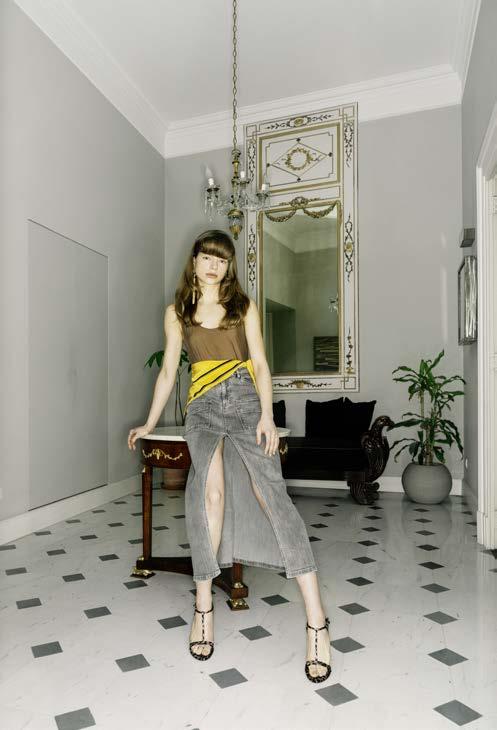
Stylish, casual, and feminine, Noir’n’Bleu brings a touch of elegance to everyday life.
For the new season, you can now be found in Düsseldorf at Kaiserswerther Straße. What are the highlights?
Dominik Meuer: That‘s right, we‘re moving to the other side of the Rhine with Igedo, which we‘re very happy about. Labels such as BOB, Hartford, Keeling, and Sacrécoeur have performed really well in stores. We will also be offering their blouses in Austria in the future. Beautiful products alone are no longer enough these days. What else do you offer?
Having your own identity is essential. Value for money, service, and early, complete delivery are indispensable today. We offer a threefold margin or more on almost all brands. The long-term success of our customers is really important to us.
What‘s new?
Alessandro Lamura. Great sports casual shirts from Italy with retail prices ranging from 100 to 129 Euros. Cashmere Company is a knitwear specialist from Perugia with great prices. Outhere by Graziano Moro and Renato Pignatti from Padua, who have worked for Stone Island, among others, offer top quality at affordable prices.
Brands: Abarca, Alessandro Lamura, BOB, Cashmere Company, Des Petits Hauts, Five Fellas, Four Ten, Hartford, Original Vintage Style, Outhere, Keeling, Koike, Prime Shoes, Sacrécoeur, The Jack & The Jackie, The Jacksons, Wool & Co
Italian brand Noir’n’Bleu combines a passion for fashion and a fascination with the history of denim with a distinctive identity. Starting this summer season, they will be represented by Good News Agency on the German and Austrian markets. As always, creative director Fabiano Ragosta skillfully plays with the contrast between contemporary minimalism and the timeless beauty of vintage pieces, blending the past and the present. Highlights include casual washed-out skirts and dresses with a used look, all made entirely in Italy, as well as wide blazers and shirt silhouettes. The collection comprises around 30 styles with up to three variations. Retail prices are around 200 Euros for a three-tier markup. The collection will be shown in Düsseldorf at Supreme and in Munich in their showroom.
Brands: Bomboogie, Flona, Niu, Isabelle Blanche, Noir’n’Bleu, Viamailbag @goodnewsagency

The agency’s big five are set, with Elisabetta Franchi, Liviana Conti, Patrizia Pepe, Twinset and Pinko. “We are also expanding in the price range below this, because we see a lot of potential here,” says agency owner Michael Schulz. For example Haveone, new at SchulzAco. “This very fashionable collection is rightly super successful in its home market of Italy and is now expanding internationally.” Haveone’s looks combine femininity with ruffles and flounces with masculine elements, at an average price of around 40 Euros purchase price. A capsule with the fashion essence will be released in mid-July. “This collection rethinks the theme of Pronto, namely with quality,” emphasizes Schulz. Eleh, which has been with SchulzAco for two seasons, also implements trends at affordable prices. “This makes the Italian collection very successful internationally and the pieces always sell out super fast. On top of that, Eleh works in various retail formats.”
One of Patrizia Pepe’s special projects is the Skin sneaker line, comfortable and in the brand’s signature style at retail prices between 179 and 249 Euros. Following the successful launch, the line will be significantly expanded for the summer.
Brands: Akep, Alessia Santi, Eleh, Elisabetta Franchi, Ermanno Firenze, Haveone, Liviana Conti, Lola Casademunt, Love Moschino Accessories, Moschino Jeans, Nenette, Parosh, Patrizia Pepe, Pinko, Rinascimento, Salty Skin, Twinset www.acomode.de




Shoe experts Wolfgang Dünkelberg and Sonja Heinermann from Düsseldorf have a new brand in their portfolio for Germany and Austria: Closed Shoes. The license and production are handled by Stil Tre from San Giovanni Ilarione near Verona. The collection for spring/summer 2026 features around 60 items, including sneakers, loafers and sandals. Retail prices for women are between 170 and 250 Euros, for men between 250 and 270 Euros. The shoes are made from the best Sciarda leather, a high-quality suede produced by Italian tannery Sciarada, known for its high sustainability standards. The shoes are on display in the showroom at Gelbes Haus in Düsseldorf and at the Style in Munich. Brands: Closed Shoes, MI/MAI Paris, Voile Blanche www.duenkelberg.com

SPRING/SUMMER 2026
17 – 20 June
Agency Esparza McAlpine
New in the line-up: Rhea, with knitwear at 150 to 300 Euros retail price. “Each piece impresses with subtle details,” says Petra Esparza McAlpine. “We are in love with the coolness of the collection!” Harris Wharf London is a permanent fixture with luxurious, timeless coats made from Italian and Japanese fabrics. Simkhai also has high standards. “Thanks to the level of fashion and entry-level prices in luxury, we have doubled our sales,” says Esparza McAlpine. Labo.Art stands for laidbackness made in Italy. The agency also stands for reliability. “Our strategy is organic, we respond to each individual.” What else turns customers into fans? “We’re starting the season with a lot of positive energy,” says Esparza McAlpine, who is showing on Munich’s Praterinsel. “The customers are in an equally good mood. What a gift!”
Brands: Amambaih, Ancient Greek Sandals, Ant 45, Arizona Love, Harris Wharf London, Jumper 1234, L’Agence, Labo.Art, Lapointe, Mii Collection, Radica Studio, Rhea, Santicler, Simkhai, Talking Walls www.esparza-mcalpine.de

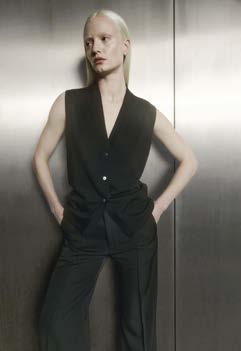


Modeagentur Christian Klaus DESIRABILITY
“We don’t just meet a need. We attract consumers with our lifestyle collections. That’s what defines fashion and what we enjoy doing,” says owner Christian Klaus, explaining his agency’s proven recipe for success. He is keeping his focus firmly on the current range, which includes stylish quiet luxury looks from labels such as Knit-ted, JcSophie, and Penn & Ink at reasonable prices with attractive margins. For Christian Klaus, criteria such as quality, fit, and delivery reliability are just as important as a high sales rate. His motto is: “We have to supply retailers with attractive labels – frequency and margin are the things we always keep an eye on.”
Brands: Absolut Cashmere, Freedomday, Gustav, Henriette Steffensen, JcSophie, Knit-ted, Maison Hotel, Marc Aurel, Margittes, Oakwood, Penn & Ink N.Y, Sacrécoeur, Unio Hamburg www.modeagentur-klaus.at
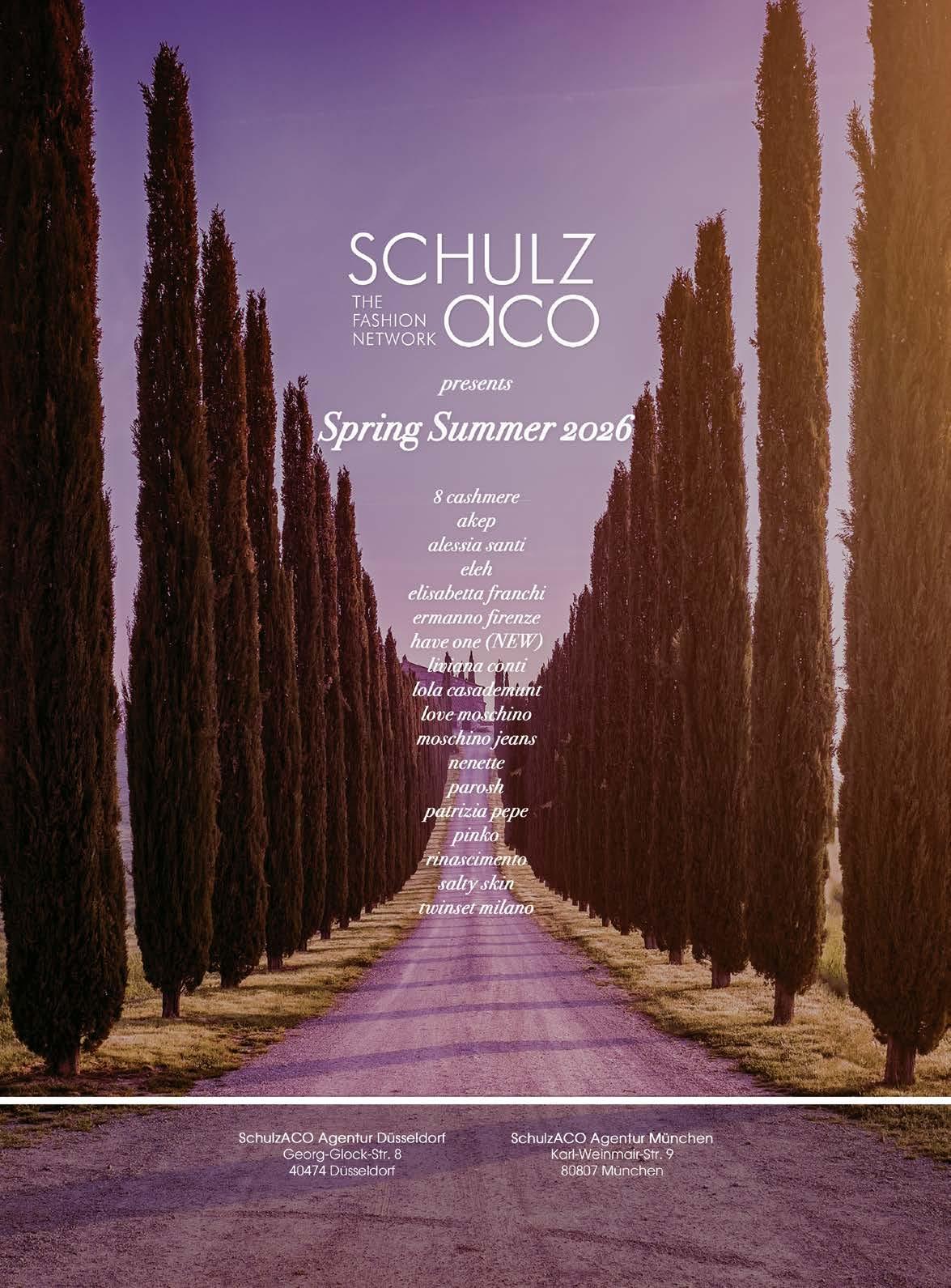



Newcomer:

Agentur Paul’s Selection
“COMMUNICATION IS THE MOST IMPORTANT THING OF ALL”
Paul, what highlights are you starting the season with?
Paul Schulz, owner of Agentur Paul’s Selection: With women’s bags from Themoirè, which are already being worn on the red carpet in the USA by stars such as Sharon Stone and Hailee Steinfeld. The brand stands for iconic design and vegan, environmentally conscious materials such as pineapple, apple and cactus. We have also added fashionable outerwear from OOF Wear for men and women to our portfolio, offering great value for money. Back with us: 3RD May with high-quality shirts and T-shirts.
What is particularly important to you?
The decisive factor for us is the successful combination of style, materials and function. If you then add good pricing and reliable service, the overall package is perfect. The best example of this is the Italian pants specialist GTA, which has perfected wearing comfort with its patented Waist Comfort Band and also offers a strong NOS range. Veneta Cinture is also expanding its NOS range and is launching fashionable women’s belts on the market for the first time, as stylish as the men’s version. Fabiano Ricci scores with sporty and elegant shoes for men and women. With Barmas, we are impressed by the fit, materials and the fine sense for quiet luxury.
You also have a new appointment at the agency.
Yes, Patrick Raschke is new on board. He strengthens us with his many years of whoelsale and retail experience. Now we can offer even more service, travel more and intensify our personal closeness with our customers. After all, two-way communication is perhaps the most important thing of all.
Brands: 3RD May, Arovescio, Barmas, Emmeti, Fabiano Ricci, Ghirardelli, GTA, OOF Wear, Sonrisa, Studio 73, Themoirè, Veneta Cinture www.paulsselection.com

• 2964 Grasegger •• Alpenherz Tracht & Fashion • Atie •• Ayasse
• BellaSusi • Bittner-Hüte • Boos • Cocovero • Creation Bauer
•• Daddy’s Daughters • Dirndl & Bua •• Elisabeth & Franzl
•• Farm um’s Herz • Frederic Meisner • Gaudiknopf • Glanz & Zauber
• Glücklich • Goiser • Gössl • Gottseidank •• Grasegger Manufaktur
•• Habsburg Kleidermanufaktur • Heimatglück Tracht
•• Hubegger Ela textile accessoires • Hund Sans Scho •• KaiserLich
•• LederGott • Lembert Hutmanufaktur • Lena Hoschek
•• Linda Neiber •• Litzlfelder •• Lodenfrey 1842 •• Luis Trenker
•• Marianna Déri Fashion •• Me°rchen Me°dchen •• Meindl Fashion
• Michaela Feyrsinger •• Münchner Lodenfabrik • Nihal Cashmere
• Original Haferl • Ostwald Bags • Ploom • Poldi •• Resi Hammerer
• Rita in Palma • Rockmacherin • Romy North Vienna
•• Säckler Manufaktur • Schuhwerk Schwangau • Seenberg
•• Stadler Tiroler Schuhmanufaktur •• Stajan Kunst & Mode
• Stephan Barbarino • Von & Zu • Vronikaa •• Wallmann
•• Waltl Holzschuhmanufaktur • Weat • Wildstelle • Wolkenstricker
• Xaver Luis Schuhmanufaktur

GUSSWERK SALZBURG 01 22–23 JULY 2025 02 22–24 AUGUST 2025
www.salt-salzburg.at @saltsalzburg

Open, vibrant, and welcoming – the Antones showrooms in Düsseldorf and Munich are places where you instantly feel at ease.
Antones? Antones! SARAH FREISE IS IN GOOD SPIRITS AND WELL-PREPARED FOR THE NEW SEASON. WITH GOOD REASON.
Antones? What’s the story behind this name?
Sarah Freise, founder of Antones: It’s a tribute to my grandpa Anton. He had this unique way of connecting – with everyone, everywhere. Curious, generous, a free spirit. That stayed with me. And that’s how I want to run my business. Built on intu ition, trust, and the kind of partnerships that last. What does Antones stand for?
We work with brands that are anything but generic – mostly owner- or family-run, all with a deep love for quality, craft, and color. Whether Moismont, Latinó or O´Mer, they all have soul. But beyond the product, it’s also about the energy we bring. Fash ion should be fun – and that goes for partnerships too. Especially today. That’s not just a side matter, this is the Antones DNA.
Are you also starting the season with a new brand?
Yes, we’re very excited to launch Nous Antwerp for Germany and Austria. It’s a collection with real personality – refined, modern, a little unexpected. There’s clarity in the shapes, a special touch in the colors, wonderful natural fabrics, and a lot of heart in the details. Nous fits perfectly into our range and is just right for independent retailers who value substance, emotion and a style that lasts. You sound optimistic about the season... I am! This is exactly the time to show up, create closeness, and keep things human. We’ve created warm, thoughtfully designed showrooms on Cecilienallee in Düsseldorf and in Lodenfreypark Munich – spaces that feel welcoming and alive. We’re also moving to a central stand at Supreme Munich, and with Moismont we’re trying Praterinsel for the first time – for more visibility, more exchange. I truly believe that in the end, it’s not about the numbers, but about the people. Brands: Moismont, Latinò, O’Mer, Nous Antwerp www.antones.de


sophisticated, and unique.
Moismont –this season for the first time also on





Sass Appeal is the newly founded sales agency of Michaela Sassenbach – born out of the desire to make independent, characterful collections visible together. The agency officially launches with the 2025 summer season under the sales management of Stefanie Günner. She is currently in charge of three lines. Sassenbach stands for feminine nonchalance, timeless silhouettes and uncompromising quality. All production takes place in Germany.

Cozy van Dorle, Doris Huber’s knitwear line, deliberately focuses on the essentials: A modern cardigan shape, made in Italy from specially developed yarns, oversized, with the perfect feel.
Lunatica Milano stands for iconic skirts with a figure-hugging waist and swinging A-line – handmade in Italy from fine fabrics, versatile and unmistakable. The perspective is also open to other labels. Prerequisite: the common denominator. Michaela Sassenbach: “We always work on an equal footing. We are united by attitude – not just style.”
Brands: Cozy van Dorle, Lunatica Milano, Sassenbach www.sass-appeal.com @cozy_van_dorle, @lunaticamilano @sassenbach_style
Agentur Knallgrau für Mode
Floor’s motto for spring/summer 26? Leisure, with navy blue and white, adding sporty power with red and burgundy. Denim goes well with this. “Agentur Sabine Lamann is now representing Floor for us in NRW,” says Harry Heinrich. “For the past season, Agentur Neonoak has been responsible for the North and East regions.”
One of the agency’s bestsellers is Seamless Basic from Denmark. “In the first two seasons, we have already been able to inspire over 120 customers,” says Bettina Groeger happily. “The styles for under and over are available in numerous variations as NOS and now also as pre-order in even more colors: Neonyellow, Skyblue and Bubblegum.”
The new partner agency for Seamless Basic in northern Germany is Prins-Juric, while the agency responsible for Switzerland is Puro Fashion. Knallgrau remains the general agency for both collections in the D-A-CH market.
Brands: Cute Stuff, Dawn x Dare, Floor, Liv Bergen, Noumeno Concept, Seamless Basic, Shirtaporter, Wuth Cashmere www.knallgrau-agentur.de

Maritime: Floor.



“There‘s nothing new,” says Henrik Soller - and laughs. Because of course things are moving at Komet und Helden. The agency run by Soller and Florian Ranft is not only remaining visible in the market, it is also developing substantially. The focus is particularly on shoes. “We are now serving the sector properly – with substance, structure and expertise,” says Soller. In addition to brands such as Superga, Sebago, Flower Mountain, D.A.T.E. and Nomap Society, Bob Wolf is a new addition – a hidden gem from California: „Still small, but with a high-quality positioning. The collection is popular with customers such as Flannels and Harvey Nichols - exactly the mix of heritage and zeitgeist that we are looking for.“
The internal structure has also been clarified with the divisions Contemporary, Denim, Shoes, and new: Kids. With K-Way Kids, Blauer Kids and Superga Kids, the aim is to score points in this highly competitive segment through brand identity. „In the kids segment, the product alone is not enough. You either have relevance or you compete directly with the verticals.“
Despite all the progress, “it will stay tough”, says Soller. The pressure on retailers and the industry is high, but many retailers are now more focused: "Dealing with pressure is becoming more professional. That helps us all."
A key topic is systematics: "We bring structure through tools such as Fashion Cloud - not sexy, but necessary. It‘s about a shared understanding of the brand - efficient, transparent, without frictional losses." Collaboration is being rethought as a partnership-based cycle: “Relevance is created through continuity, not actionism.” What does it take? „The right product at the right time at eye level and trust. It doesn‘t work without transparency."
Brands: 7 for all mankind, Aspesi, Baracuta, Blauer USA, Bob Wolf, Bowery NYC, C.T. Plage, D.A.T.E., Dickies, Elite 55, Family First, Filson, Flower Mountain, Icon Denim, K-Way, Le Bonnet, Nomap Society, Save the Duck, Seven Gauge, Sebago, Sunspel, Superdry, Superga, Ten C, The.Nim Standard, Two Jeys, Universal Works www.kometundhelden.de


Christian Sanders and Philipp Schlösser have added DillySocks to their portfolio for southern and central Germany. Distribution in northern Germany will be handled by Sand & Water and in Austria by Wilhelm Modeagentur. The colorful sock collection is designed in Switzerland and manufactured in Europe. Quality and sustainability are their top priorities. In addition to two main collections, there is also a third Christmas collection with matching gift boxes and Christmas trees. Key styles and around 20 plain styles are available from stock in Germany in the NOS program. Retail prices range from 13.90 to 19.90 Euros, with a markup of 2.7.
All collections for Germany, Austria, and Switzerland (Scandinavian Edition D-A-CH and Benelux) are on display at the showroom in Düsseldorf and, starting in July, at the new 100-square-meter year-round showroom in Munich.
Brands: Ay Studios, DillySocks, Edblad, Garment Project, Mono, Saburo Jeans, Scandinavian Edition www.lagom-fashionagency.com



The Noon Agency is kicking off the spring/summer 2026 order round with a fun twist. Visitors to the showrooms in Düsseldorf and Munich can look forward to a putting golf challenge on the agency’s own three-hole putting green. “We wanted to give the visit a special touch; something that connects, awakens a little competitive spirit and, above all, is fun,” explains agency owner Oliver Braun. “A little surprise awaits after a successful chip-in.”
There is also a lot going on in the agency’s brand universe, which mainly focuses on Scandinavian labels, denim and lifestyle brands. In addition to established brands such as Gabba, Von Jungfeld and Akaroa, two exciting new additions from last season are being expanded: Blue De Gênes from Denmark scores with its authentic denim aesthetic, modern fit and high-quality, detailed artisanship. “The brand stands for durable products with character and appeals to retailers who value authenticity and storytelling,” says Braun. Bianco brings Scandinavian coolness into play, with urban designs ranging from sneakers to loafers and boots.
“The focus is clearly on brown shoes. Fashion-forward design and suitability for everyday use are combined here,” says Oliver Braun. “Whether for fashion, for an exchange or for the perfect putt: We cordially invite you to discover the collections in a relaxed atmosphere and look forward to the next round together.”
Brands: Akaroa, Bianco, Blue de Gênes, Gabba, Von Jungfeld www.thenoon.agency


“Our customers respond to collections that are not only aesthetically pleasing, but also conceptually strong – and that’s exactly what our brands are currently delivering,” says Marc Kofler, Managing Director of Adventure GmbH. Un_artig, the successful T-shirt label, remains true to the tried-and-tested two-drop system. The summer drop impresses with new styles, wearable prints and its unmistakable signature. 120% Lino presents an all-round harmonious linen collection – inspired by travel destinations such as Cartagena, Capri and Miami. A new capsule with elegant, transparent looks is aimed at fashion-conscious customers. Janthee is also expanding its portfolio with sophisticated resortwear: tunics, two-pieces and flowing dresses complement the beachwear line. “It’s all about lightness, ambience and summer colors – exactly what our stores are looking for,” says Kofler.
Brands: 120% Lino, Anfiny, Be Able, Collezione N°01 Daniele Fiesoli, Duno, Janthee, Kashette, Kiefermann Women, Sainte Mer, Tonno & Panna, Trusted Handwork, UrbanCode, Un_artig. Wesentlich adventure-gmbh.de
Lino remains a summer bestseller.
Marcona3 is starting the new season with two carefully selected newcomers – brands with a clear signature and strong market potential. Latorre, the traditional manufacturer from Apulia, known for high-quality menswear, is launching a women’s project for the first time at Marcona3. The focus is on a new jacket concept that combines classic Italian tailoring with modern femininity. The portfolio is complemented by Purple from Los Angeles. The denim label stands for progressive aesthetics, strong washes and an urban premium look. With international retail backing and strong dynamics, Purple brings a breath of fresh air to the contemporary segment.
Brands: Adhoconcept, Amen, Batakovic, Chie Mihara, Costumein, Cultura, Ih Nom Uh Nit, JG1, JNBY, Latorre, Made in Tomboy, Purple, Raxxy, Repetto, Salvatore Santoro, Seven Gauge, The New Arrivals İlkyaz Özel, TRC 2038, Unimatic Watches, Veja marcona3.com

Latorre: Timelessly elegant.

Fashion & Interior concepts by Susana Arévalo
“TODAY,
Susana Kofler Arévalo is expanding her portfolio with a focus on accessories and interior products. She is working with Adventure Fashion Agency and is targeting contemporary concept stores and boutiques with a curated range. “Many of our customers want additions that create atmosphere and tell stories,” explains Kofler. “Accessories, fragrances, interiors - all of this brings emotion to the space.” The agency is presenting three carefully selected labels at the launch: Gas Bijoux, French jewelry with a sense of color and artisanship; Leomax Cashmere, luxurious Casmere scarves in clear statement tones, and Tiefenbacher Lehmann, a bag label from Hamburg with sustainable standards and a minimalist design language. “Accessories are no longer a minor matter today, they set accents, create identity and make stores unmistakable,” says Kofler.
Brands: Gas Bijoux, Leomax Cashmere, Tiefenbacher Lehmann adventure-gmbh.de

“We are super happy,” says Ludovi co Nees. “We are growing naturally with our fashion labels. Our lifestyle brands are also doing us well: more and more retailers are thinking in terms of concept stores, because they add variety and surprise to the range.” Like the coffee table books from Printworks, with essential tools or classic games. New are boxes that are finished with high-quality piano lacquer. “What do we like about this? Printworks acts seasonally, for example with wedding albums, and there are also exciting collaborations such as with Youtuber and Olympic chess champion Anna Cramling.”
Blouses from Academia are universally wearable and effortless. “The shirt specialist’s expertise is clear to see, and the set idea with drawstring pants also works really well.” Reason enough to expand the collection – with short and long skirts and dresses such as chemises longues.
Brands: Academia, Bongusta, Krakatau, Meyenberg, Mikks, Paltò, Printworks, Tenue, White Sand www.firstflooragency.com


Passionate: Samuel Schatten, Ludovico Nees, Johannes Strasser-Nunziati.


“True Religion Europe has established itself very well,” says Reinhard Haase. “Denim is core, and the blouses are also going down well with retailers.” The total look is now being expanded with casual non-denim pants and printed shirts that lend personality to the collection, as well as fringing, frill elements and embroidery. On top of this, there is a flash program with printed shirts and sportswear. Also positive: The development of True Religion USA, distributed by the Mad Agency, which is now also responsible for the women‘s collection. Boro Denim focuses on artisanship without compromise and Japanese selvedge denim. Colorush from Belgium shows cashmere with a lot of creativity. Another highlight is the CPress Studio collection, for which Cindy Press translates her art from the canvas to T-shirts, tanks and sweatshirts.
Unifa celebrates its 25th anniversary at DFD in the new Jades store on the Kö. Brands: Boro Denim, Colorush, CPress Studio, GLab, Love Future, Moussy Vintage, Nation, Sunny Somewhere, True Religion Europe www.unifa-fashion.com







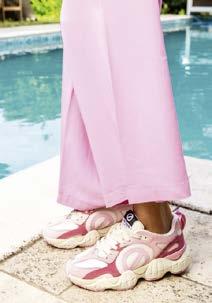


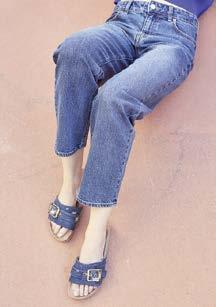










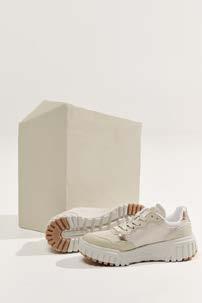



Matthias Schwarte is impressed by the current collections of his partners: “All suppliers have done their homework and really stepped it up.”
Parajumpers deserves special mention. Under the creative direction of Andrea Moro, the brand presents a modern, coherent collection with clear colors and not only outdoor expertise, but also an expressive total look. A clear development is also evident at Mason Garments. The women’s collection presented for the first time is closely aligned with the men’s collection –a signal for a consistent brand strategy. Schwarte says of Sundek: “It’s no longer just swimming trunks, but a completely coordinated outfit with polo shirts, T-shirts and sweatshirts.”
He concludes: “After a very good winter season, I see a stable and successful development for the summer.”
Brands: Armani Exchange, Balr, Daniele Fiesoli, Fil Noir, Manifattura Ceccarelli, Mason Garments, Parajumpers, Sundek, Whats, Whyat agentur-schwarte.de
With a keen eye for relevance and aesthetics, fashion agency Ventrella is expanding its portfolio with an exciting new addition: Mauro Grifoni. The Italian brand, which was considered the epitome of contemporary tailoring in the 2000s, is back – with fresh energy, a clear design signature and a new distribution structure. “We are delighted to represent Mauro Grifoni for the entire D-A-CH region. For us, the label has always been one of the most interesting in contemporary fashion design,” says Gaby Ventrella. Mauro Grifoni stands for excellent tailoring, striking silhouettes and a style that combines Italian artisanship with international nonchalance. For the relaunch, the company invested in its own showroom in Milan and restructured its production and design quality. “The collaboration immediately appealed to us. It is a carefully thought-out relaunch with a lot of substance that is allowed to develop organically, without short-term pressure,” explains Ventrella.
Brands: Avant Toi, Al Ain, Bazar de Luxe, Caliban, Le Sarte Pettegole, Mauro Grifoni, NDV, Nine in the morning, Novelle, PAO, Sorelle, Tagliatore, Tintoria Mattei, Vipera www.agentur-ventrella.de


A white T-shirt, sometimes that’s all you need. Heritage and Meystory know this too – two partners who are now joining forces again. “We give our partners the opportunity to offer their customers a complete look,” explains Michael Brockmann from Heritage. Malte Kötteritz adds: “The white T-shirt is timeless and versatile, the perfect product to set a clear focus.” In a new capsule, the T-shirt for men and women takes center stage. Even though the collection includes other items, the focus is on this one piece of clothing: “It’s not an add-on, it’s simply a good product,” says Brockmann. The shirt is permanently available as a NOS item. The price: 79 Euros for women, 89 Euros for men – each with a calculation of 2.8. Made in Germany from high-quality Pima cotton and fully twisted yarn, the product combines artisanship, quality and understatement.
Brands: Circolo 1901, Meystory, Myths, Robert Friedman heritage-showroom.de
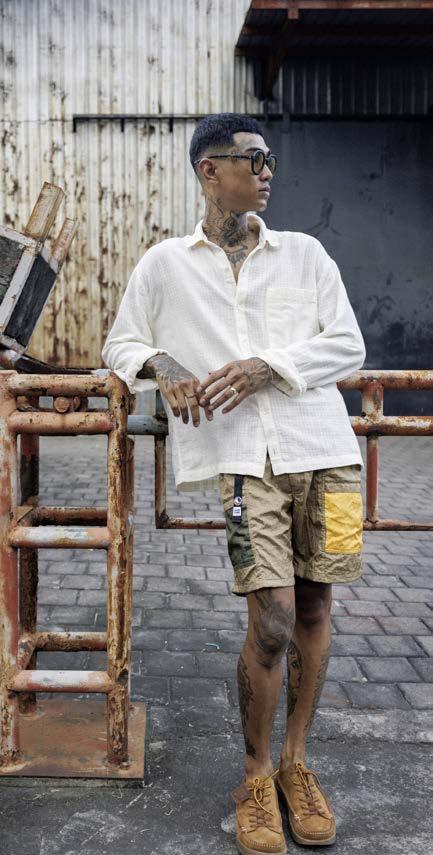


While the fashion market is characterized by uncertainty, consumer restraint and structural change, Fashion Factory by Mark Grütters provides a remarkably stable counter-model. “In midst of a turbulent macrocosm, we have managed to keep our small microcosm on course,” says Grütters. Its success is based on a clear concept: Niche collections with history, quality, and an authentic look.
Homecore, a new addition to the portfolio for the spring/ summer 2026 season, embodies precisely this attitude. Founded by Alexandre Guarneri in the Parisian hip-hop scene in the early 1990s, Homecore is now considered a pioneer in the sustainable use of existing resources – not least thanks to the innovative use of leftover materials. Customers honor this profile. On average, they now buy three collections from the agency’s portfolio – and the trend is rising. This is clear evidence of increased relevance and trust. “We have gained even more depth in recent seasons, not only in our product range, but above all in our partnerships,” says Grütters.
The women’s sector is a strategic growth area. The focus is currently still around 60 percent on menswear. However, bestsellers from the men’s collections – such as knitwear, outerwear, and jersey – have been successfully transferred to the womenswear segment. The dynamic confirms this: The unisex concept works if the quality, fit, and look are convincing.
Brands: Astorflex, Baestmor, Castart, Coldbreaker, Edmmond Studios, Homecore, Il Bisonte, La Mariole, Le Mont Saint Michel, Monchiqe, Oas, Our Sister, Pantherella, P.Lemoult, Portuguese Flannel, Pyrenex, Rivieras, Sanders, Schott NYC, Volver 1979 www.ffbymg.com

Vertrieb:
Supreme Düsseldorf: QG4, 4G11 / Supreme München: Halle 4, A405

Orderlounge offers answers to the current market dynamics with Contemporary and Affordable Luxury brands.
New to the agency? Le Petit Pulle from Italy, with classically feminine essentials made from certified merino wool, cashmere or viscose mixes. “The qualities are high grade, the look is classically elegant, I love it,” says Damir Prins-Jurič. “Lou & Odette is also new, with super beautiful basics. What’s more, the three-piece calculation is impressive.” The third newcomer is Mastai Ferretti, with fashionably wearable blouses and dresses. And what else? “We want to spread a good mood, and our portfolio is also very well positioned. My motto for the season is: You have to expect everything in life – even the good things!”
Brands: Aeon, Amaranto, Ana Alcazar, Ball, Bobi Los Angeles, Carta Libera, Deblon, Devotion Twins, Herzensangelegenheit, Hulken, Icon, I’m Brian, Janice, Johnny Was, Le Petit Pulle, Les Hommes, Les Tricots d’O, Lott, Lou & Odette, Mastai Ferretti, My Real Identity, Nebo, NiMo, Noend Denim, Outryght, Pera Lima, Penn & Ink N.Y, Pulz Jeans, Seemless Basic, Sincere, Vilagallo, Voluspa, Wushu www.prins-juric.com Successful: Penn &
"We are confident in our brand portfolio and are only planning minor adjustments for the new season. Our focus is clearly on the partners with whom we have been working successfully for years. And on new exciting additions such as Enterprise Japan, LAG World and Hibourama, which are already showing impressive potential after their first season with us,“ says agency owner Darius Herges and adds: ”Our long-standing partner Blauer has achieved a momentum that is convincing with new silhouettes and at the same time a lot has been invested in optimizing transport routes in favour of significantly shorter delivery times. This ensures that our showroom remains a meeting place for anyone looking for exciting brands and trendsetting collections.“
Brands: Blauer, Coccinelle Shoes, Colors of California, Ecoalf, Enterprise Japan, Good News, Hibourama, LAG World, Liu Jo, Napapijri, No Name, Replay, Ohiko www.orderlounge.de

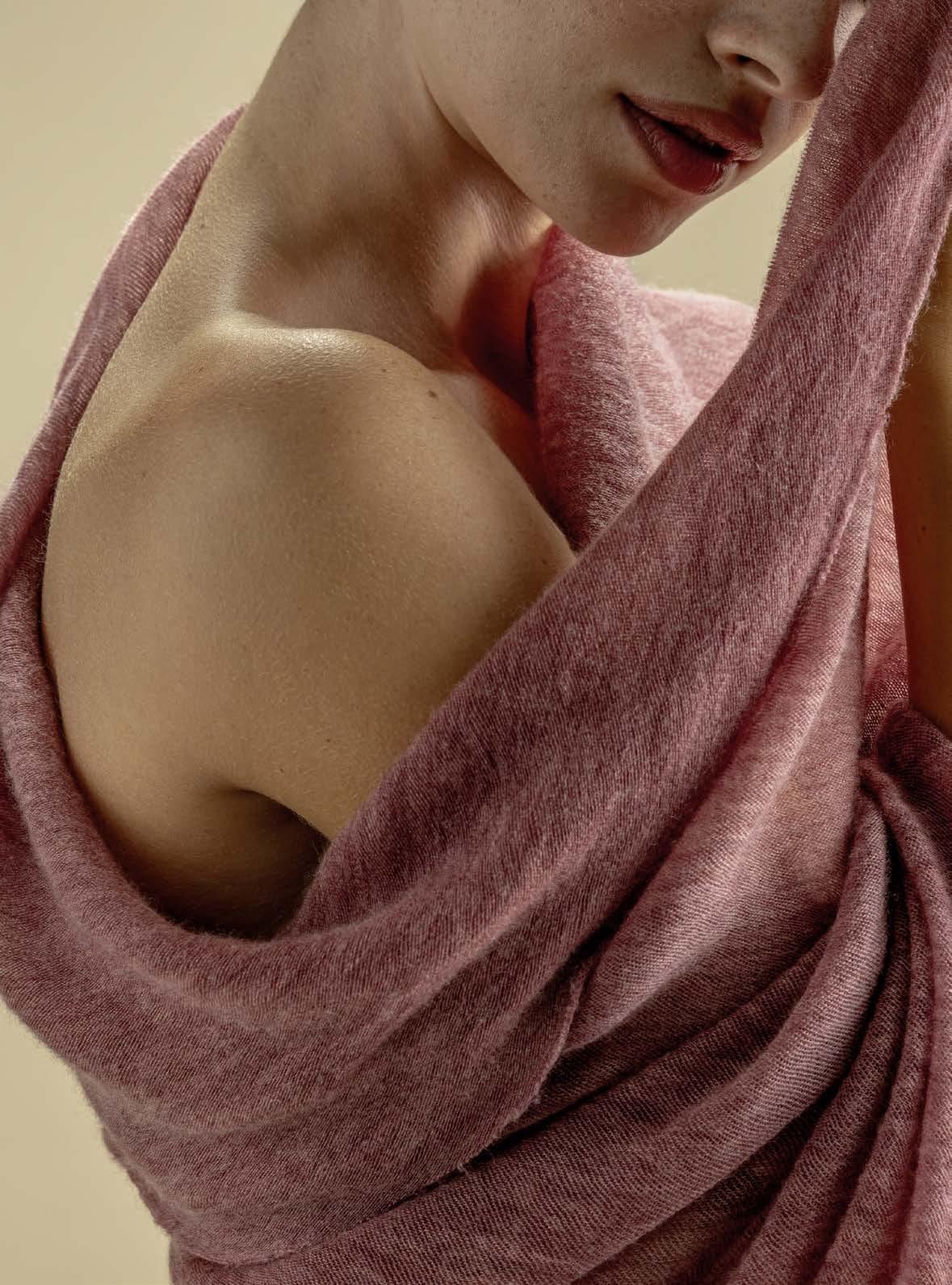

Comeback of the year: Fiorucci.
When everyone is allowed to grow in their strengths, the entire operation grows: the mother-son team at Modeist is on course for success. Firstly, because son Timothy Hoferer can develop his international and fresh focus, and secondly, because mother Marion Hoferer is free to take care of the development of the house brands. “Pride to Be had its best season ever in winter, and now we are proving our summer expertise,” says Marion Hoferer happily. Quite Luxury is new with its capsule concept: easy-to-wear pieces that are stylish from morning to night, without showing too much of their uncomplicated character. Timothy Hoferer is celebrating another international coup: Fiorucci is celebrating its comeback and is relying on Modeist in its selective development of the D-A-CH strategy. “Whether upper or middle range store, boutique or department store, every store will now find what they are looking for at our agency,” Timothy Hoferer is convinced. In addition to outdoor, pants, lounge and total look, Modeist is also increasingly focusing on shoes and bags with Alohas, now De Siena and Julia Skergeth. “With our work for Alohas, we have proven that we can sensitively build a next generation shoe brand. The breadth of styles makes it possible to serve About You with volume models and at the same time place a completely different selection with Huesken, Helmut Eder or Apropos,” explains Timothy Hoferer. The successful Spanish brand stands for young entrepreneurship – just like the new management team behind the iconic Italian brand Fiorucci. “There is a clear plan for the coming years as to how Fiorucci can bring a breath of fresh air to designer stores as a fashionable entry-price label. From 2026, Fiorucci will also no longer supply Zalando, another argument for our discerning customers to opt for this refreshed brand.”
Brands: 9AM by Dorlores, Alcidia de Veiga, Alohas, De Siena, Fiorucci, JNBY, Julia Skergeth, Less by JNBY, Nine to 9, Pride to Be, Sold Out, Quite Luxury



Elvis Fashion Agency is starting the summer with a breath of fresh air. From July 1, 2025, you will find the sales agency at a new address: Utzschneiderstraße 4, 80469 Munich.
Much remains the same at the new location – and yet there are exciting new features. In addition to the established brands in the portfolio, the agency presents two exciting new additions: Spanish beachwear brand Arrels Barcelona, which impresses with sustainable menswear for sunny days, and Italian accessories label Testoni, known for timeless elegance and high-quality manufacturing.
Brands: Arrels Barcelona, Bagutta, Brooksfield, Capobianco, Cruna, Fioroni, Manto, Testoni, The Gigi, Tombolini elvisfashion.com
Welcome on board: the fashionable outerwear originals from Blonde N8 are newcomers with Daniela and René Michaelis. “Retail prices range from 79 to 199 Euros and are well above average,” says René Michaelis. “We are starting with the women’s collection, which will be followed by a men’s line for fall/winter.” TWNS The Label is off to a strong start: colorful knitwear as a price base in the premium segment. “Deliveries for spring/summer will start on November 15; for fresh goods as early as winter.” Absolut Cashmere is also providing a flash of color in 30 brilliant colors. My White Tee, a premium T-shirt collection made in Portugal, is also introducing color for the first time. “Goldgarn impresses with a variety of denim, including styles for the fashion-conscious,” says Michaelis.
Brands: Absolut Cashmere, Absurd by OP, Goldgarn, My White Tee, One1Tee, TWNS the Label, Yippie Hippie, Zeitlos by Luana www.michaelis-fashion-agency.com



“Premium retailers are increasingly looking for collections with a convincing price-performance ratio – this is exactly where we come in,” says Michael Crone Andersen. Andersen and Petra Künkel’s agency started last season with the Peppercorn and Minus collections from Danish house Redefined Fashion, thus remaining true to its focus as a specialist for Danish collections. Peppercorn offers feminine casual wear with a French attitude. Dresses, for example, cost around 69 Euros retail price. Minus combines elegant sophistication with sporty elements and is located in the lower contemporary premium segment. “On the one hand, the collections are fashionably edgy and a little bit raw; on the other, they are suitable for everyday wear and commercial. Minus and Peppercorn manage to combine both with ease,” says Andersen. With no minimum quantities, six flexible delivery capsules per year and sizes up to 46, the range is tailored to consultation-orientated retail. www.mcaundco.de




Last January, Hubert Stolzlechner, owner of Agentur Stolz, was represented in Düsseldorf for the first time – a successful move. Stolzlechner comments: "This season, we will be on site again with Habsburg as a tenant in the MAB Villa from July 18 to 20. The market situation is currently not easy for industry and trade because the cost structure has changed massively. As an agency, it is therefore important to take a step towards the retail sector and use synergies, work together and think outside the box instead of playing elbow politics. That's what will move our industry forward now!"
Brands: Dirndl & Bua, Habsburg, Manufaktur Grasegger, Me°rchen Me°dchen, Wallmann www.hstolz.at
Brand new with Torsten Müller: Wool & Co from Daniele Fiesoli, featuring fashionable knitwear in cashmere blends, T-shirts, and striped linen shirts from 129 to 199 Euros retail price. “The brand also knows how to use color,” says Torsten Müller, “if you want beige, this beige is just right.” FlipFlop the Original is back. “The cult sandals made of super-light rubber are back in fashion and available in many colors,” says Müller. Tom Ripley plays with retro DNA, but with a fresh twist for polo shirts and knitwear, in maritime or pastel shades. P448 is on an international growth course: “The super-comfortable, high-quality sneakers are made in Italy from pleasantly scented leather.” Distretto is also on the road to success with doubled sales. “The casually unstructured jackets, which retail between 199 and 279 Euros, are hugely successful. The bestsellers are the travel suits made from technical fabric, which are comfortable and easy to look after.”
Brands: Distretto 12, FlipFlop, P448, Tom Ripley, Wool & Co, Zeybra Portofino www.roomninefashionagency.de
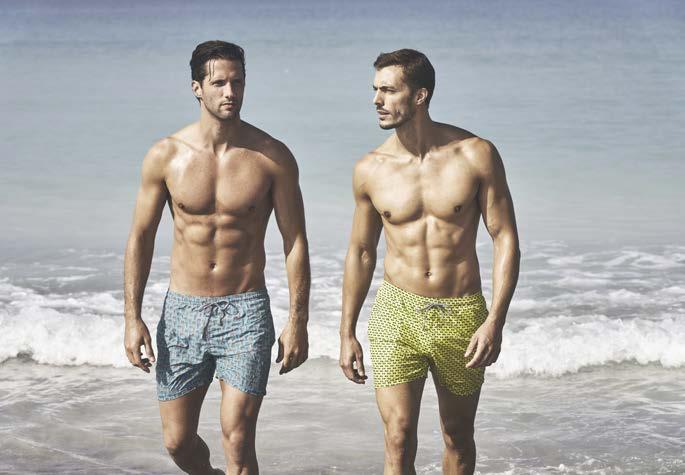
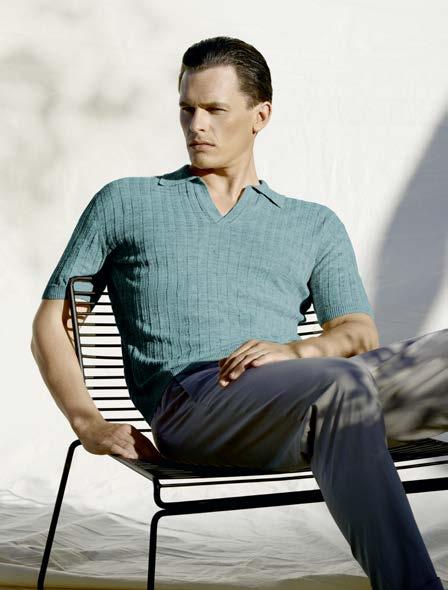

“We have been in even closer contact with our customers in recent monthsand are therefore better prepared for this season than ever before,” says Ben Botas. “We have drawn our conclusions from many conversations and visits and are expanding our support services in the areas of staff training, visual merchandising, reorder calls and in-store activities.” D2C brands such as Oh April continue to perform extremely successfully, but the newly launched Karo Kauer collection also has ambitious targets for a wholesale roll-out. There were two new additions to the Shoe and Progressive Department: Hoff and Palm Angels. Palm Angels, which was previously represented at the top, will be positioned more broadly.
Brands: Allsaints, A.P.C., Axel Arigato, Banana Moon, Chimi, CPH Muse, Dstrezzed, Ecoalf, Edited, Elias Rumelis, Filippa K, Flaneur, From Future, Gina Tricot, Hey Marly, Hoff, Karo Kauer, Lala Berlin, Les Visionnaires, Lois, Love Stories, Maison Kitsuné, Malina, Mason’s, Moose Knuckels, Napapijri, Oh April, Palm Angels, Peuterey, Rag & Bone, Second Female, Sporty & Rich, Steamery www.ben-and.com

sellthroughs.
Milan-based agency Lomme 2018 is once again on point with their brand portfolio for spring/summer 2026, perfectly combining fashion content and commercial relevance. Selia Richwood impresses with summery resortwear and top sell-throughs from 45 Euros purchase price. Aniye Records, the upper contemporary label from Italy, focuses on an exclusive presence at Revolve and Fashion Week visibility. KV Roes stands for avant-garde with attitude made in Italy, sustainably produced, uncompromising in style. Sami Miro Vintage from Los Angeles remains the sustainable it-label of the moment, worn by global icons and represented at FWRD and Selfridges & Co. Supplemented by strong players such as Manokhi, AniyeBy and Starlit, Lomme aims to remain a focal point for discerning buyers.
Brands: Aniye By, Aniye Records, KV Roes, Manokhi, Sami Miro Vintage, Selia Richwood, Starlit paulina@lomming.com, youwie@lomming.com


Strategy: Starting in the spring/summer 2026 season, Kiefermann Women will focus entirely on the main line.
Gerhard and Isabella Knaus announce a new addition for spring/summer 2026: Sustyle. The name says it all: the label stands for a successful fusion of sustainability and style. The range includes feminine shirts and sweatshirts with expressive motifs that are not only visually appealing, but can also be worn with a clear conscience. There is also news from Kiefermann: the Iheart collection will no longer be offered for wholesale. The strategic focus is now entirely on Kiefermann Woman, which has been with the agency since 2024. At the same time, the men’s collection, with which the agency has been represented in the upper-premium segment since 2016, remains a stable pillar of the company. Here, the company continues to focus consistently on expansion. Both collections bear the unmistakable signature of Alexandra Kiefermann: Honest, authentic products of the highest quality, minimalist and purist in design.
Brands: Arma Leather, Amaya Amsterdam, Distretto 12, G-Lab, Grace, Juvia, Kiefermann, Love Joy Victory, Sustyle www.knausoderknaus.at




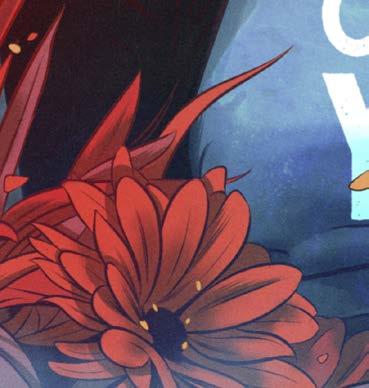
A BRAND CALLED YOU!
Daniela Soto-Innes was named the World’s Best Female Chef in 2019, at just 29 – a dazzling milestone for the daughter of Mexican immigrants who rose through the intense world of New York fine dining. Wunderkind. Superstar. And then? A radical pivot. Instead of chasing more stars, she chose depth over speed to open Rubra at the end of 2024: An omnisensoric creative space on Mexico’s mythical Punta Mita peninsula where food becomes a narrative, clothing becomes a ritual and presence becomes memories.
In conversation with Stephan Huber, Soto-Innes explores the science of tradition, the sensory power of space – and what fashion might learn from hospitality when it comes to emotion, relevance, and soul.
Artwork: Alexander Wells, @alexanderwells
Daniela, the world knows you as the youngest woman ever to be named World’s Best Female Chef. You’ve led iconic restaurants like Cosme and Atla in New York. And then you left it all behind – to come back to Mexico and start something entirely new. What was the deeper motivation behind that move?
Daniela Soto-Innes, Chef at Rubra: I wanted to walk my own path – but with the hands of my grandmother, my mother, and my great-grandmother still on my back. That’s how Rubra was born. I came back to build something that could reflect where I come from and what I believe in. Not just a restaurant, but a space with feeling. One that moves like I move. Where there’s music and joy and color and stillness. Where people feel seen.
That sounds like much more than a place to eat.
It is. Nobody comes to Rubra because they’re hungry. They come because they want to feel something. A connection. A rhythm. And that’s what I think about constantly: how do we create that rhythm – not just through food, but through space, sound, light, smell, clothing? We’re building a world, not just a kitchen.
Let’s go back a little. You were only 17 when you became a sous-chef. Your career took off at lightning speed. But from what I sense, there was always more behind it – something ancestral, even spiritual. Where does that grounding come from?
From the women in my family. Always. My great-grandmother cooked until she was 98. She used to say: “The only way you make good food is if your feet are grounded and your heart is light.” That stuck with me. My mother was a runner – super focused, super structured. And my grandmother was the joy, the emotion. I carry all three of them with me. When I was in kitchens in New York, it was always their voices in my head – not the chefs shouting around me. (laughing)
So even in the most high-pressure kitchens, your compass came from something much older – and softer?
I learned early on that my strength wasn’t in shouting louder. It was in feeling deeper. I watched everything. The rhythm of a person’s hands. The way they breathe when they cook. How they react to music. I started to understand people through their movement, their expression. That’s how I learned to lead. Not through ego, but through presence. Through energy.
That sounds like a very different kind of leadership –more intuitive, almost choreographic.
Oh…I love that word. Choreographic. Yes. I think of the kitchen like a dance. There’s tension, there’s flow. There’s discipline, but also spontaneity. You can’t just tell people what to do – you have to tune in to who they are. That’s something fashion and hospitality have in common: everything is movement and timing and feeling. And when it’s right, you don’t need to explain it. You just feel it.
Did your definition of success shift over time?
Absolutely. At first, it was all about proving something. Earning stars. Moving fast. But I started feeling like I was succeeding at something I didn’t believe in anymore. Now, success feels slower. Quieter. It’s about alignment. About making something that still makes sense five, ten years from now.
Let’s talk about Rubra. You built it from the ground up – not just as a space, but as a kind of world. How did that begin?
I wanted to start with silence. With space. Not noise. We found this unique place at Punta Mita and didn’t just walk in and decorate – we stripped it down to the bones. I worked with incredible artists like Pablo Kobayashi, who builds spaces that breathe. Everything had to feel alive. The materials. The light. The energy. I wanted Rubra to move like water. Like a song.
There’s something deeply aesthetic about the way you describe it. It sounds to me like fashion in the best sense: Atmosphere, haptic, detailed, narrative.
This is clearly a similarity. That’s why I say we’re not just a restaurant – we’re a feeling. And that feeling comes from being intentional. For example, we collaborated with AnaPa Studio for our uniforms. I didn’t want my team to wear “chef's clothes”. I wanted them to feel beautiful, confident. Like themselves. We spent months choosing fabrics, understanding how they move, how they breathe. It had to feel right on the body. That’s fashion, no? And it really was fun. One day I maybe want to design my own fashion line.
You’re talking about these uniforms as identity – like a personal language. Not a costume.
Exactly. Every person at Rubra brings their story. So the clothes had to support that. They had to say: “You belong here. You are seen.” We even had fittings,

Düsseldorf
SHOWROOM Cecilienallee 20: 10.-22.Juli
München
LODENFREY Haus C: 24. Juli-1. August
SUPREME neuer Stand, B307: 2.-5. August
neu: MOISMONT auf der Praterinsel (EG): 30. Juli-5. August
Kontakt
ANTONES GmbH * Sarah Freise +49 6174 9159566 * mail@antones.de www.antones.de
WE
DANIELA
adjustments. It was beautiful and so much fun. It was like preparing for a performance – but one that’s real, every day.
I can imagine many designers would envy that kind of intimacy with purpose. It’s often missing in fashion – this blend of function, soul, and presence.
That’s why we’re talking! (laughing) Because at Rubra, we don’t design to impress. We design to express. And that changes everything. I even created my own soap –well, it’s kind of a mix between a scent and a perfume. I didn’t do it to sell something. I just wanted Rubra to have a smell. Something you could take home with you. It’s subtle, but people notice. They ask: “What is that?” And I tell them: “It’s Rubra. It’s us!”
You once described your philosophy as “emotional, but precise”. That line stuck with me – especially when you talk about ingredients, rituals, and memory. Is that where your idea of The Science of Tradition began?
That phrase became the title of my talk at Harvard. We were studying fermentation – looking at ancestral techniques through a scientific lens. And I realized: the processes my grandmother used, the smells in her kitchen, the rituals – they weren’t just poetic. They were precise. They had chemistry. They had logic. But no one had ever explained it to me like that before.
Honoring the past without romanticizing it – by understanding its structure?
Exactly. And that structure holds emotion. It’s not one or the other. That’s what I try to do at Rubra. Everything we serve has a story – but it also has balance. Acidity, heat, texture, temperature. Feeling and form. That’s where the magic is.
Again, such a sharp parallel to fashion. Artisanship, silhouette, cut – those are structural. But what makes a garment unforgettable is often the story behind it. The energy it carries.
Agree! A perfect dish and a perfect garment aren’t so different. You don’t fall in love because it’s perfect – you fall in love because it feels alive.
So tradition isn’t the opposite of innovation – it’s the foundation of it?
If you understand the why, you can honor the how. The problem is that many people repeat traditions without
understanding their roots. Or worse, they break them without knowing what they’re breaking. But if you go deep – really deep – you can bring tradition into the future. With respect. With clarity. That’s innovation. Every ingredient has a memory. I think about how cinnamon smells in my grandmother’s kitchen, or how lime wakes up your mouth after mezcal. It’s the same with fabrics. The way wool warms. The way linen breathes. These aren’t just materials – they hold stories. Energy.
That again resonates so much in fashion. We keep returning to artisanship, heritage, the handmade. But often it’s treated as nostalgia, not potential.
Both fashion and food have to stop fetishizing the past and start learning from it. Not because it’s pretty. But because it holds knowledge. You just have to listen to it. You have to ask: where did this technique come from? Why this fabric? Why this herb? That’s how you grow something that has depth. That can last.
It’s almost like the deeper the roots, the more room you have to grow.
That’s the work. That’s what makes it exciting.
You’re not only a chef, but also a boss. One of my favorite things you’ve said is: “If you’re not a fun chef, it’s better to change your profession because the kitchen is a party.” That flips the cliché. Most people think joy and work are opposites – but you seem to connect them deeply.
Because they ARE deeply connected! Especially in the kitchen. Cooking is rhythm. Precision. Intuition. And when that flows, it becomes joy. But you can’t fake it. You have to earn it. You can’t dance in the kitchen if the mise en place isn’t tight. You can’t create magic if the basics aren’t mastered. That’s the discipline I’m talking about.
It’s almost like jazz. You train for years so you can finally improvise – and make it look effortless.
And that’s also how I lead. I don’t yell. I don’t dominate. I listen. I observe. I create space for other people’s rhythm. Sometimes that means stepping back. Sometimes that means turning up the music and letting the room shift. Leadership isn’t about being the loudest. It’s about being the most tuned in.
That feels especially radical in hospitality, where the work culture is still shaped by pressure, hierarchy, and exhaustion.

















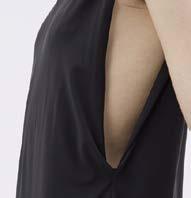


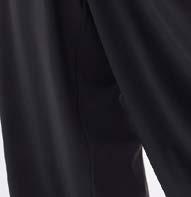






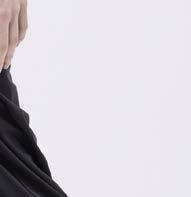









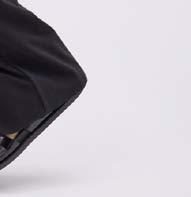



I’M NOT TRYING TO BE THE BEST RESTAURANT IN THE WORLD. I’M TRYING TO BE RUBRA. THAT’S ENOUGH. – DANIELA SOTO-INNES
Yes – and that’s why I left New York. I didn’t want to build something based on burnout. I wanted to create a space where people feel safe, seen, and held to a high standard – but through care, not control. That’s not softness. That’s power.
You’re redefining success – not as output, but as atmosphere, as what it feels like to be part of something.
Because that’s what people remember. Not just what was on the plate. But how they felt. That’s what lasts.
In fashion, we talk a lot about creating experiences – especially in retail. Hospitality seems to connect faster, deeper and more emotionally. Why do you think that’s the case?
Because it is about the senses. It’s physical. Emotional. Immediate. We feed people. We read their body language. We listen to their rhythm. It’s intimate. That teaches you to design for presence – not performance. You have to tune in. You have to care. At Rubra, every detail carries weight: how the playlist builds the night, how the scent in the hallway lands, how a team member moves. That’s choreography. That’s design. The food might bring you in, but the atmosphere – that’s what stays in your body.
I think a lot of fashion brands dream of that kind of emotional impact. But it requires a level of honesty and care that goes beyond brand building.
It does. And honestly? Fashion is already looking in this direction. I’ve felt it. Whether it was being on the cover of L’Officiel, or collaborating with Opening Ceremony – I never felt like I was modeling clothes. I felt like I was helping express a story. A feeling. That’s the kind of fashion I love – when it’s personal, not performative. That’s exactly how I feel about Lemaire, one of my absolute favorite brands.
Your approach to hospitality is almost like a slow-fashion designer – with full sensory storytelling, but no shortcuts.
I think the pressure to always do something new is hurting fashion. And food too. More menus, more launches, more drops. But people don’t remember more. They remember what was right. What was thoughtful. That’s what stays in the body. Because you can’t rush meaning. That’s something food teaches you. A dish might take days to ferment, to rest, to find its balance. And it’s the same with a look. You can’t fake the energy. You feel
when something’s been made with presence. And that feeling? That’s the future of luxury.
The way you speak about Rubra makes it clear that it’s not just a restaurant. It’s more like a creative universe. That’s what I always mean when I talk about omnisensoric. You seem to approach Rubra like a kind of living, breathing brand. Would you agree?
In a way – but I don’t even like the word brand. I think more in essence. In presence. Rubra is my essence. My team’s essence. I wanted to create something that carries all the little rituals and feelings that shaped me. It’s personal. It’s not about trend. It’s not about what’s cool right now. It’s about what feels true. I think that’s what people are looking for.
How do you decide what belongs to Rubra and what doesn’t?
I ask myself: does this carry the same intention, the same vibration? Is it honest? I don’t want to add just to grow – I want to deepen the experience. Slowly. With care. It started with food, but it’s already becoming something bigger. We’ve worked with artisans. We’ve developed scents. We’ve created uniforms. I’m dreaming about textiles. Maybe a perfume. Even furniture. But everything has to come from the same place: clarity and intention. No rush. No noise.
So it’s not expansion for the sake of growth – it’s expression through other mediums?
That’s how I want it. It’s not about building a concept. It’s about holding a vibration. That’s why I don’t say yes to every opportunity. If the energy doesn’t match, I’d rather wait. I’m not interested in being everywhere. I’m interested in being real – wherever we are.
That’s a radical position in an age of hustle and hype.
But I think people feel it. They respect the slow build. They sense the care. That’s what makes something timeless – when it grows like a garden, not like a campaign.
So instead of scaling up, you’re deepening. That’s a different kind of legacy.
I’m not trying to be the best restaurant in the world. I’m trying to be Rubra. That’s enough.
Thank you, Daniela.

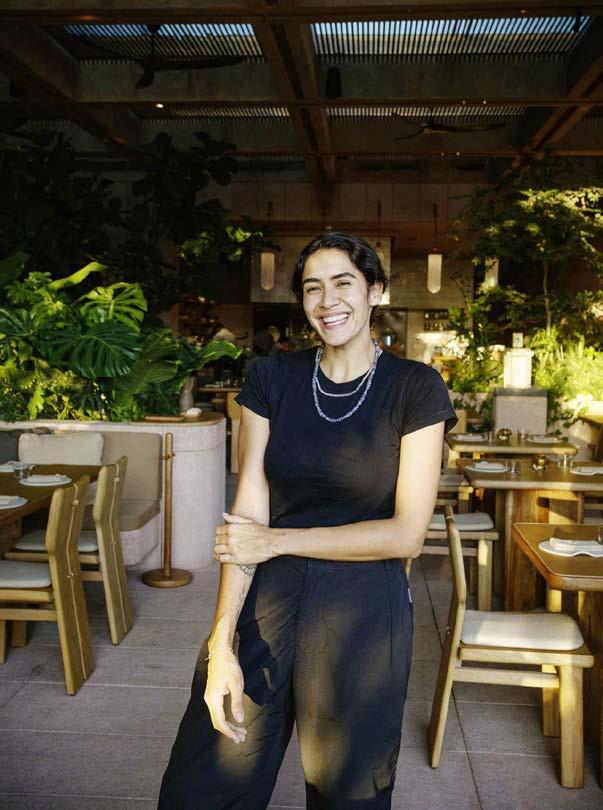
Daniela Soto-Innes is considered one of the most exciting voices in international gastronomy. At just 28 years old, she was named the best female chef in the world by The World’s 50 Best - not because she followed rules, but because she wrote new ones.
At the Ruba, her current project on Mexico’s Pacific coast, she is redefining haute cuisine: sensual, emotional, communal. For Soto-Innes, cooking is an act of connection, every course tells a story. Rubra is a retreat for her - no spectacle, no noise, just essence. The lush garden, the ingredients, the atmosphere, everything follows the idea of understanding food holistically. Her cuisine is more than just a craft. It is a statement about identity, about togetherness, about a future in which enjoyment and community are inextricably linked.
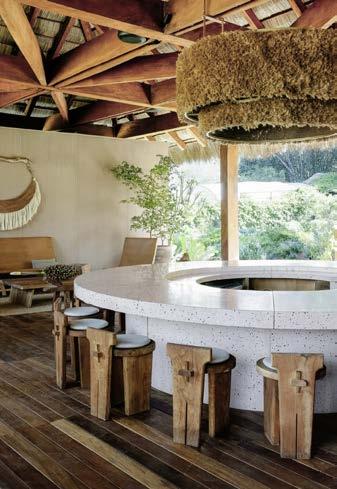
1 After an extraordinary start to her career in New York, Daniela Soto-Innes followed her intuition to Mexico.
2 On a sunny day, the interior of the Rubra expands seamlessly onto the spacious terrace, where tables offer a view of the forest and the sea beyond.
3 The dishes at the Rubra bear the chef’s unmistakable signature: a blend of bold, bright flavors and a good dose of spice. 4 A piece of wisdom from Daniela’s great-grandmother: “The only way you make good food is if your feet are grounded and your heart is light.”



„EVERYONE WANTS TO GET INTO FASHION, BUT FASHION WANTS TO GET INTO FOOD.“
An
essay by Stephan Huber
this quote, half ironic, half prophetic, captures a mood that has been quietly growing inside the fashion world. At a time when digital acceleration, mass consumption, and algorithmic sameness have stripped fashion of much of its mystery and meaning, something essential seems to be missing. That something is what food – and more broadly, hospitality – still holds: A deep connection to life, to feeling, to presence. Fashion used to be a mirror of culture. Today, it often feels like a mirror of marketing. What was once driven by desire is now driven by drop schedules. But if we look beyond the surface, we find a hunger – not just in designers, but in consumers, retailers, and even media –for a more intimate, sensual, and soulful kind of experience. Fashion, in this light, doesn’t just look at food as another lifestyle add-on. It looks at it like a language it has forgotten to speak.
Food is essential to life. No one argues about this. It nourishes, it connects, it comforts. It is, quite literally, what we are made of. But what we wear – what touches our skin, what we wrap around our bodies each day – is no less intimate. And yet, we rarely speak of fashion in such vital terms.
Fashion still has the potential to be a deeply sensorial experience. The feel of wool against skin. The ritual of getting dressed. The way color influences mood. But these sensualities have been muted by a system optimized for speed, scale, and clicks. Physical retail, once the site of the fashion theater, has struggled to hold ground – though some places, like Le Bon Marché in Paris, still manage to orchestrate atmosphere, curiosity, and storytelling in a way that engages the senses, not just the wallet. Clothing, like food, has always been about more than function. It tells stories – about where we come from, who we are, who we long to become. It carries memory. It carries identity. In many cultures, garments mark life’s most significant moments: birth, mourning, celebration, transformation. Just like food, clothing can be deeply emotional. The scarf that smells like your mother. The sweater you wore to your first job. The dress you associate with a specific city or season or love. And yet, fashion has spent decades detaching itself from that kind of meaning. In its race to keep up with demand, fashion’s language became impersonal: drops, clicks, checkouts. Quantity over connection. Meanwhile, food embraced the opposite arc. It reclaimed its roots. It honored regionality. It turned grandmothers into experts and ingredients into protagonists. The rise of farm-to-table wasn’t just about freshness – it was about storytelling. Perhaps that’s why we grant chefs a certain authorship that fashion once held – because they
never fully abandoned the emotional weight of their medium.
We accept that chefs have a philosophy. That a dish reflects not just taste, but a context: place, heritage, obsession, even grief. We know where our sourdough comes from, who made the miso, why the pasta at that one trattoria in Milan tastes like nowhere else. We respect signature. We understand intention. Fashion must learn from food – not to sell more, but to make people feel more. Because feeling isn’t just sentiment. It’s the gateway to meaning, connection, and memory.
This isn’t to say that fashion lacks vision today. Quite the opposite. But the structures rarely allow for it to breathe. What chefs seem to have protected – or reclaimed – is the right to move at their own rhythm, to speak their own language, to say no to scale when it threatens integrity.
So when I say hospitality is the new luxury, I mean precisely this cultural and emotional shift from material possessions to experiences and personalized service. This shift is not about abandoning beauty, or fantasy, or even hedonism. It’s about giving them weight. Relevance. Connection.
When fashion reaches beyond its borders, something remarkable happens: it stops being just an industry – and starts becoming a cultural force again. And an essential part of emerging models for a new kind of urban culture: small-scale, multi-sensory, high-empathy. Places that resist industrial noise and instead invite presence, participation, and emotional investment.
The implications go beyond aesthetics. In a time when city centers are struggling to hold onto meaning – when traditional retail is shrinking, and community is increasingly digital – fashion’s collaboration with other sensorial, story-rich disciplines could be an answer. Not just to bring people back into spaces, but to make those spaces feel alive again. Because now is exactly the right time. There is a growing, almost visceral longing for realness, for clarity, for connection. And fashion –especially fashion retail when reimagined with intention – has the tools to respond. It can offer presence. It can offer warmth. It can offer spaces that invite emotion, participation,
and a sense of belonging. And that’s not only hopeful – it’s actionable.
This interdisciplinarity can also unlock new economic ways of thinking. Where traditional retail alone may no longer sustain a space, a thoughtful blend of commerce and culture just might. A boutique that also serves food, hosts readings, commissions artists. A fashion studio that shares its kitchen with a ceramics collective. A concept store that becomes a stage, a café, a conversation.
These are not utopian visions – they’re already happening.
They’re driven by creative entrepreneurs who understand that experience is the new currency, and that relevance comes from resonance. From the LX Factory in Lisbon to Simon Miller’s new boutique in the heart of LA’s Arts District. From the Pop-Up Aquarium, the beautifully curated space Clemens Sagmeister opened on Lake Constance, to countless other local hybrids quietly redefining what a retail space can be.
The lesson? Creative convergence isn’t a threat to fashion’s identity. It may be the very thing that saves it. Not by making fashion bigger –but by making it deeper. More rooted in time, place, and person. More integrated into the urban imagination.
The future of fashion may well look more like a chef’s kitchen than a showroom – authored, rooted, local in scale but universal in resonance. Less about chasing newness, more about crafting meaning.
Because in the end, the strongest design – in food or fashion – isn’t trend-driven. It’s memory-driven.
Fashion is looking for relevance. And perhaps, instinctively, it knows where to find it: in food, in hospitality, in the shared rituals that make us feel alive and connected. Not because food is trending, but because it is true. Rooted. Immediate. Story-rich. Sensual. Everything fashion once was – and could be again. This is not about turning fashion into food, nor romanticizing the dinner table. It’s about recognizing that both fields – when they are at their best – rely on the same fundamentals: intention, authorship, and emotion. The power to create meaning, not just material. The ability to shape identity through presence, not just product.
By reaching across disciplines, fashion can become less isolated and more integrated – part of a wider cultural metabolism that includes architects, chefs, farmers, perfumers, artists. The future isn’t monolithic. It’s multi-sensory, polyphonic, and deeply local. Built not from the top down, but from the inside out.
In this world, fashion isn’t the main course –it’s a seat at the table. And that, finally, may be the most exciting place to be.

Between sketches and dim sum, photo shoots and restaurant cuisine, Xin Ge liu is among the most exciting personalities in italy’s contemporary culinary community. The founder of the Xinge restaurant in Florence combines fashion and food in a way that has long since transcended mere trends – she is embracing what many are only just discovering.
Text: Janaina engelmann-Brothánek. photos: Xinge

Born in 1993 in the Chinese province Hebei, Xin Ge Liu grew up in a working-class family. Her keen sense of aesthetics was evident from an early age: she designed clothes for dolls, spent hours watching her grandmother cook, and quickly developed a deep understanding of shape, color, and composition. “I regard a dish as a fashion design. It starts with a mood board, an idea, an emotion.” When she was 18, she relocated to Florence to study fashion design at the renowned Polimoda. Her first fashion label was ambitious but failed, yet Xin Ge Liu saw the failure as a creative reboot. In 2020, in the throes of the pandemic, she founded Xin Ge Gogo, a Chinese takeaway that quickly became an insider tip. Her style is distinct, uncompromising, and unmistakable from the outset. “I wanted to be free, free to create. I did everything myself – in the kitchen, but also the photos for the website.”
The next, even more significant step followed in 2023: the fine-dining restaurant Xinge. The location is an experience – as carefully curated as a fashion show. Light, music, presentation, atmosphere – they all reflect a dramatic concept. Xin Ge Liu regards the menus as collections: seasonal, limited, creatively condensed: “Today’s guests desire more than mere food.
They crave emotions, an experience for all five senses.” She is not surprised that luxury brands are placing more emphasis on gastronomy: “The fashion industry is suffering. People are buying fewer bags, but they still wish to travel, enjoy, experience. Lifestyle is replacing luxury products.” Xinge’s culinary approach does not go unnoticed. It has been decorated with awards from Gambero Rosso, Identità Golose, TheFork, and Fortune, which included its pioneering founder in the list of the 40 Under 40 in the Food Industry. Forbes, Vogue, Rolling Stone, Elle Decor, and Guida Michelin have also featured the exceptional creative chef with a fashion background. Despite all the success, Xin Ge Liu remains curious, tireless, and brimming with ideas. She is currently working on a new after-dinner location with music, a DJ, and multi-sensory experiences as an extension of her restaurant and her vision of a holistic, elegant culinary concept. If you ask her which ingredients she would choose to describe herself, the answer comes promptly: “Salt, sugar, and chili – the three ingredients that should never be omitted.”



Launch in record time: Only six weeks passed between signing the contract and the grand opening.

04651/ A trip in a bag offers everything you need in your weekender for your next short vacation.
a glass loft on the lake, brimming with colorful, creative fish: clemens and caroline sagmeister’s aquarium in Bregenz is a concept store that is so much more than a mere retail space. it represents a response to the crisis in traditional retail, a vibrant meeting place for creative minds from the region and beyond.
Text: lisa hollogschwandtner. photos: marcel mayer
Upon entering the Aquarium in Bregenz, you immediately sense that this space is different. Occupying 400 square meters, boasting breath-taking views of Lake Constance, this is not a traditional store, but a vibrant, ever-changing stage. To Clemens Sagmeister, who launched the project together with his wife Caroline, this is a response to many questions of our time and a direct reaction to the current challenges facing the industry. “It constitutes an attempt to highlight new solutions and demonstrate how modern retail works. After all, we all know how it fails by now,” explains Sagmeister. The familiar approach of buying merchandise six months in advance, taking a risk, and hoping for a positive outcome is no longer sustainable.
The Aquarium offers a counterproposal in the form of a radical partnership concept. Sagmeister provides the curated space and qualified staff. The partners contribute their products, rent space temporarily, and pay a small commission on sales. “This reduces the risk for the retailer,” says Sagmeister, which, in turn, frees up space for creativity. It is an individual playground for a wide variety of brands and creatives, yet curated according to clear criteria. On the one hand: the Sagmeister quality standard. “Each product we stock has passed the Sagmeister quality check. That in no way means it has to be expensive, just special, new, or different.” On the other hand: a shared mindset. To Sagmeister, the concept does not require lengthy explanations. You either feel it and understand it – or you do not.
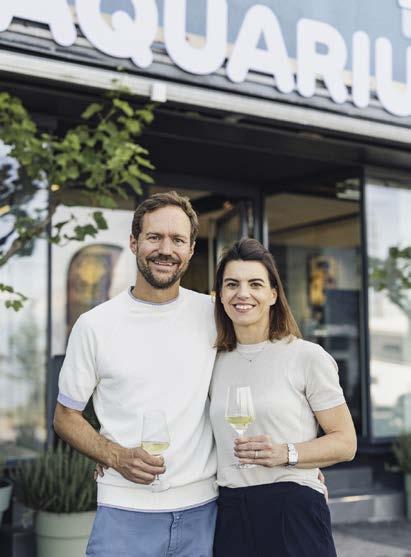

“Everyone here understands that the product next to their own is not a competitor; instead, the range is mutually beneficial.” This principle is the driving force behind the concept. Originally planned with ten partners, the Aquarium launched with 23. The list of potential further candidates includes more than 100 names.
The variety of products at Aquarium is truly impressive. Under the initial motto “Endless Summer”, the concept store currently features fashion by brands such as AlphaTauri and 04651/ A trip in a bag alongside a sports pop-up by Stopolobo. The latter is a welcome addition, as Bregenz no longer houses a sports store. They are complemented by furniture from Casa, plants from Tiefgrün, books from Buchhandlung Brunner, and beauty products from Valentina & Philippa.
A particular focus is placed on culinary delights and local heroes. There is freshly baked bread from Marenda Brotkultur, delicatessen from Frau Kaufmann, sushi from Sakura Sushi Bar, and even sustainably produced meat and sausages from the butcher “Der Jogi”. Everything you need for a spontaneous day on the opposite lakeshore – from barbecues to water-filtering drinking bottles.
The concept is aimed at “open-minded people aged 9 to 99”. A separate area co-designed by children, the “children’s pool”, makes the store especially family friendly. At the same time, the Aquarium has a distinct identity. A rainbow flag outside the door and a “No Cash Please” sign subtly communicate who is welcome, and who is not. This is about creating an open, appreciative community.
The cards are reshuffled every four months. Then the motto changes and new partners come on board, while established partners reinvent themselves. The project is all set for the next four years. It is more than just a store. This is a lively experiment, a courageous and inspiring alternative concept, a vision of what retail can look like in the future: Collaborative, dynamic, and full of passion.
Fashion has gone foodie! more and more labels are staging themselves through hospitality – with their own restaurants, pop-ups or cafés. a sign of good taste? examples that speak for themselves.



DaV by Da Vittorio Louis Vuitton
after three years of restoration, louis Vuitton reopened the doors of its historic milan location palazzo Taverna in april 2025. included: café da Vittorio and the daV by da Vittorio louis Vuitton restaurant – the brand’s first gastronomic concept in italy. under the direction of edoardo Tizzanini, the three-time michelin award-winning da Vittorio Restaurant Group offers a casual fine dining experience with exclusively italian cuisine. creative details such as saffron risotto in the shape of the iconic lV flower or desserts decorated with a monogram pattern, served on tableware from the art de la Table collection, allow guests to experience the louis Vuitton universe with all their senses. louisvuitton.com

new york streetwear brand aimé leon dore opened its own cafés in its stores in manhattan and soho in london in 2019, it began collaborating with the catering industry. The current collaboration with italian espresso machine manufacturer la marzocco is the culmination of this liaison. connection through uniqueness: la marzocco’s expertise in italian espresso preparation; aimé leon ore is currently being celebrated by the streetwear community. The espresso machine is accompanied by a small capsule in an authentic color and style world. www.aimeleondore.com, www.lamarzocco.com



in February, saint laurent reopened its Rive droite maison in paris with a new look after a year of renovations and presented its second permanent sushi park after los angeles. The restaurant serves only the most exquisite seasonal dishes from Japanese cuisine – all in the style of chef peter park, who also creates the menu in the californian metropolis. The integration of different kinds of artisanship into a coherent overall experience is one of the central goals of the international expansion strategy launched by yves saint laurent in 2024.
sushiparkparis.ysl.com

Gab Bois, a multidisciplinary artist from montreal, combines art, fashion, and culinary arts in a special way. What began as photographic art with edible props developed into wearable design objects. in 2023, she launched her first ready-to-wear line with the Rhubarb collection – including bags made from 3d-printed rhubarb leaves. This was followed by clementine heels and the now iconic jumbo shrimp earrings. With her designs, Gab Bois wants to offer her audience an intense experience and invite them to immerse themselves in her surreal world. gabbois.shop



For the spring/summer 2025 campaign, sportswear brand Gant is collaborating with five-star hotel château de Théoule and its beach resort la plage Blanche –a stylish production on the French Riviera. modern coastal flair is combined with timeless style to create an immersive experience that reinterprets the summer lifestyle.
“This collaboration gives us the opportunity to build a deeper connection with our target audience through emotional experiences,” explains Fredrik malm, eVp Global commercial, Brand & product at Gant. “la plage Blanche reflects the effortless elegance and relaxed energy that characterizes Gant’s summer lifestyle.” @gant
photo: davide Frandi
Malmö Chokladfabrik
uncompromisingly fair production, climate-conscious packaging and free from nuts, soy and gluten – malmö’s chocolate is free from everything harmful. many varieties are vegan, all are 100% certified organic and handmade in sweden. classics such as sea salt meets milk chocolate or dark chocolate with licorice are packaged in a scandinavian look. in Germany, sales are handled by haven agency in nuremberg. crafts cost 7.50 euros in stores, cones & Tegel 7.99 euros and Bars 2.20 euros. customers include Glore stores, Grüne Wiese in münster, Riinstok in leipzig, Fraunholz in nuremberg, Jac in Würzburg and Treibholz in munich. www.malmochokladfabrik.se


in summer 2025, lacoste invites you to enjoy a stylish dining experience at shangri-la paris. summer by lacoste is an elegant open-air restaurant that will be open daily from midday to evening. The pop-up takes the class and atmosphere of renowned hotel restaurant la Bauhinia, which is known for its French-asian-inspired cuisine and reinterprets it with a sporty lacoste spirit. The menu includes lobster noodles, truffle croque and a crocodile-shaped dessert with raspberry and pistachio. signature drinks such as the pamplemousse spritzer and a margarita ace are served in the historic garden setting of prince Roland Bonaparte’s former residence.


· Mittlerer Osten / Nordafrika: Fehmi Chama, info@chama-fashion.de
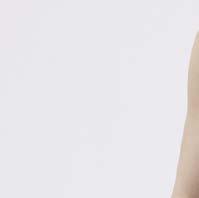




CH: Zirlewagen Modeagentur GmbH , +41 796 31 17 18 , nathalie@zirlewagen.ch , www.zirlewagen.ch , zirlewagen



nineto9.de




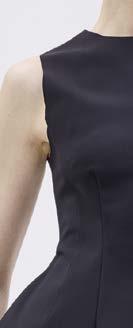



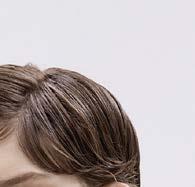



DE & AT: MODEist GmbH , +49 151 54 73 28 67, info@b-kleidung.com, www.modeist.com, modeist_
FR: Showroom Funkygame, Bordeaux, funkygame@orange.fr · EN: Paperkiss Showroom, London, sales@paperkissshowroom.com



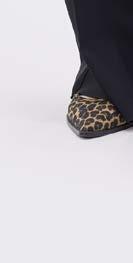




















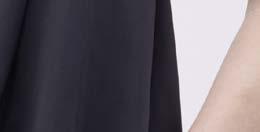






hospitality is far more than mere service – it is an invitation to unwind, indulge, and partake. a few striking examples.
Text: ida hanak. photos: Warm me, Be […] my Friend, Gut oggau
First, Gut Oggau itself: run by Eduard and Stephanie Tscheppe, this biodynamic winery in Burgenland is attracting international attention due to its natural wines and visionary storytelling. The estate not only produces wines with a distinctive character, but also forges connections between nature, people, and creative worlds. One of these relationships involves our cover interview guest Daniela Soto-Innes. After leaving her acclaimed New York restaurants Cosme and Atla, the Mexican chef, who was recognized as the best female chef in the world in 2019, has opened a new chapter with Rubra, where she combines tropical flavors and traditional milpa farming with a carefully curated selection of wines. The latter features biodynamic and organic wines from small family-run wineries, including those from Gut Oggau. These are characterized by a unique concept. Presented as members of a fictional family, each of the three generations – from young, vivacious wines to mature, wise vintages – conveys their own character and story that goes far beyond grape varieties and terroir.
In 2024, these iconic personalities inspired a collaboration with Austrian cashmere label Warm Me, founded by Theresa Steinbacher. Inspired by Theodora, one of the distinctive wine characters, a capsule collection made of

100 percent Mongolian cashmere was created, combining traditional craftsmanship with the individual history of the wines from Gut Oggau.
The spirit of hospitality was extended at a pop-up event entitled “Be Paris My Friend” in March as part of Paris Fashion Week. There, Warm Me teamed up with the Salzburg-based restaurant Furō and the cosmetics label Be [...] My Friend, which was founded by Petra Schröckeneder in 2015. The label’s mission?
To create high-quality, purely plant-based skincare products that are multifunctional and combinable. Between natural cosmetics, fashion, and fine cuisine, a temporary space was created in which hospitality was staged as a holistic experience. In this case, the presentation included wine from the Markowitsch winery in Göttlesbrunn, Lower Austria.



Are classic role models in crisis? How is today’s masculinity defined? These questions determine the following menswear chapter, as does the realization that the answers to them are diverse. Menswear is fragmented. But precisely in this break lies an opportunity: Where conventions are broken, space is created for a future that we shape ourselves.


traditional masculinity is in transition. the concept that was propagated for decades is no longer keeping with the times and is undergoing a process of deconstruction. While traditional images are called into question, a counter-concept has not yet been established. the present is fragmented; the future remains intangible. this means that modern menswear involves enduring discomfort and embracing the search for orientation as a process that is often non-linear.
text: Lisa hollogschwandtner. Photos: Brands
How valuable is an article that raises more questions than it answers? Perhaps the role of modern journalism is to highlight issues that have yet to be resolved, and to deliberately preserve the space that this uncertainty creates. In a world where ChatGPT provides answers at the touch of a button, it is becoming increasingly difficult to accept ambiguity and uncertainty. But it is precisely this uncertainty that challenges us – intellectually, emotionally, socially – and harbors potential for growth. Rather than instinctively covering up this reality, confronting it head-on is a central theme of menswear for spring/summer 2026. Preconceived images are in flux, leaving consumers hungry for guidance.
How do these conditions influence purchasing decisions in the Contemporary to Luxury segment? This question is first directed at Rafael Duleba, Contemporary buyer at Steffl department store in Vienna. “I view the dissolution of rigid role models as a liberation. However, newfound freedom can also be overwhelming. We observe this very clearly among our customers.

They are seeking guidance and often find it on social media. This is an important source of inspiration, albeit one that is largely determined by external factors.” Against this backdrop, what determines purchasing decisions? What guides a buyer in times of disorientation? “Their own voice.” For Duleba, menswear is taking on a calmer tone, with less dependence on big labels and workwear influences appearing subtly in details rather than boldly. Korean brands are doing particularly well at Steffl: “These brands do not rely on loud marketing but focus entirely on the product.”
The trend towards reduced volume and sharp product focus is echoed by Costas Karageorge, founder and buyer of The Business Fashion: “Menswear is extremely sleek and clean at the moment. If you place it all on one rack, it becomes boring very quickly. That is why we rely on a mix that is as rich in contrast as possible. Then the tailoring piece hangs next to something that is distressed and destroyed. It is precisely this friction that creates interest. Quality is always important to us. We favor natural materials such as fine cashmere or high-quality cotton. We deliberately avoid synthetics.”
Instead of referring to trends, menswear is thereby progressively focusing on attributes that go deeper. This is a radical shift in view of the past seasons, which were characterized by buzzwords such as old money aesthetic or gorpcore, which, in turn, unleashed a wave of interchangeability. The coveted look came in genuine starter packs: tailoring in neutral colors with accessories that suggest a generous inheritance, or garments adopted from the performance sector and placed in a new urban context. The latter trend has seen brands such as Arc’teryx and Salomon soar in popularity. However, these trend waves are always accompanied by a flood of imitators at the expense of long-term brand loyalty and genuine customer loyalty. Malique Morris, direct-to-consumer correspondent at The Business of Fashion, comments: “They all offer some variation of the same: accessible, timeless, stylish, and good-looking, but completely non-committal. Everything is good, yet nothing is truly great. And if everyone is well-dressed, nobody is really cool in the end.” Merely interchangeable.
The renewed relevance of authenticity and the desire for individuality present a countertrend to which retail and the industry are responding with answers that increasingly draw on cultural references. Katarina and Vincent Unden-Dimou, who run Anouk on Vienna’s Westbahnstraße, are no exception. A small store, firmly anchored in the heart of Vienna’s 7th district – and in that of its community. Lacoste understood the importance and celebrated its 90th anniversary by teaming up with the couple in October 2023. Austrian glass artist Robert Comploj was enlisted for the project. Under the title “from the court to the street”, he created a Lacoste tennis ball as the central element of one of his unique

1820
pieces in homage to the brand’s history. This collaboration was not an isolated case, as creative exchange is common practice at Anouk: “Our aim is not to make money at all costs. We wish to make a statement with our store, represent something, show who we are, and ensure that everyone is welcome here. In this context, our events are key. We adopt an interdisciplinary approach, combining fashion, art, culture, food, and music. Isolated trends are less relevant today. It is much more important to convey entire lifestyle worlds.”
That still raises the question of which products underline this fundamental shift. Vincent Unden-Dimou says: “Purchasing is currently extremely demanding. Products can achieve hype status overnight, only to be rendered irrelevant again shortly afterwards. If you chase this cycle, you can only stand to lose. This makes it all the more important for buyers to have a very clear identity. Today, men are looking for clothes that suit
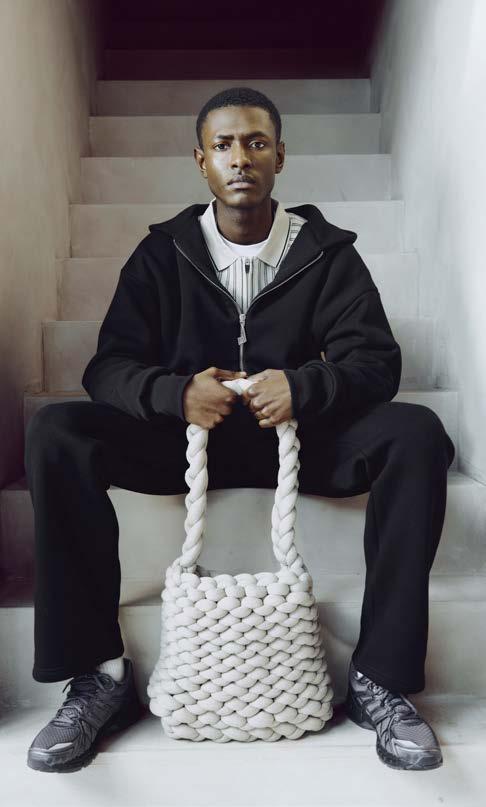
them and make them feel good about themselves. In fact, this applies to all our customers - regardless of gender. That is why we try to break down rigid categories as best we can in our store. Just because we buy styles from the womenswear collections of brands, it does not mean that we have to designate them as such on the sales floor. We hang the goods the way we like them, thereby reflecting the zeitgeist.” Katarina Unden-Dimou also identifies the opportunity for retailers to focus on their own DNA. “We buy very much by feel and focus on products that we personally believe in. For me, it is not about differentiating between womenswear, menswear, or genderless fashion – these are ultimately just categories. It is far more crucial to reach a point where everyone can wear what they like.”
As a matter of fact, the trend towards fluid fashion is nothing new, as such. On the contrary, womenswear and menswear have always drawn inspiration from each other. Armani’s flowing suits in the 1980s probably had a more profound long-term impact than many of today’s runway productions. In line with the adage that every trend causes a countermovement, segments of the market are currently experiencing a resurgence of traditional masculinity. However, as with fluid fashion, this is more of a fringe phenomenon than a commercial formula for success.
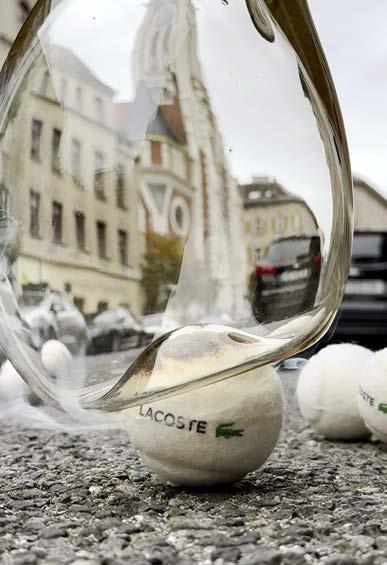







Saendorn epitomizes the fusion of functionality, quality, aesthetics, and comfort, thus meeting current demands in
So, how does a traditional men’s outfitter interpret the current situation? This question goes to Sebastiaan Vadasz, co-founder of Swiss menswear and tailoring specialist Pelikamo: “I can only speak from our perspective and would never claim that this reflects a broader trend. However, the suit is currently performing very well again, especially among our target group of urban professionals. We are observing that classic role models are once again stepping to the fore. Our customers are turning their attention to familiar images. What does a traditional banker, a lawyer, or someone from the tech industry wear? Such images are strongly influencing purchasing decisions.” Bespoke is equally popular, and the overall look is becoming more classic: “À la Loro Piana or Brunello Cucinelli, featuring high-quality materials and plenty of natural tones. It is also exciting that our customers' approach to aesthetics is evolving. In my opinion, men are much more attracted to beautiful pieces these days. In the past, the car was the main status symbol, but now other aspects are gaining in relevance. How their home looks, for example, but also art and culture.”
Hugo Boss Creative Director Marco Falcioni shares this observation in our lead interview: “Over the past decade, gender fluidity has for sure reshaped menswear – though perhaps not on the same visible scale as in womenswear. I would rather argue that there is a gender fluidity in the attitude of men towards their wardrobe. The attention men pay to what they wear, care products, and brands has certainly changed dramatically.”
This includes a new focus on individualism, on a wholly personal interpretation of matters.
Individuality is the guiding principle at The Cave in Palma. The store itself is an absolute must-see, designed and managed by Iside Pellegrino Preite and Roberto Zampione. Both are deeply rooted in the fashion world. Roberto is an art director, Iside a photographer. Together they also founded Artwork Hub, a design-thinking agency that offers creative direction, as well as production and consulting services for fashion brands. The couple, originally from Italy, initially moved to Ibiza before relocating to Palma, where they opened their own concept store. The location is a treasure and was treated as such during the renovation. The original terrazzo floor was laid bare; the Mares wall made of Mallorca sandstone was carefully cleaned. The cash desk and changing areas were designed by Roberto and Iside themselves to blend seamlessly into the overall concept. “A brutalist vibe, though not cold or impersonal,” says Iside Pellegrino Preite. The duo also relies on a similar interplay of contrasts in their range. “Roberto is heavily inspired by the US West Coast and Nordic aesthetics – always combined with our Italian DNA. And that is exactly what appeals to our customers. They are looking for this sweet spot – sharply cut suit pants in contrast


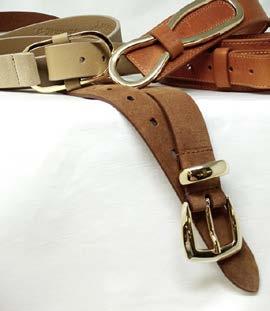









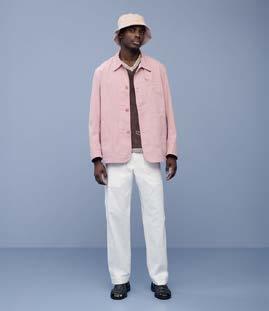



to wild, expressive shirts. Sometimes sneakers, sometimes polished loafers. We merge timeless tailoring with up-and-coming streetwear voices, creating looks with personality and edge.”
So, what can we deduce from these findings for the spring/summer 2026 season? Men are gradually abandoning classic status symbols and thus logos and hype, but not quality and fit. The color cards are correspondingly calm, while the material palettes are appropriately elaborate. Steffl-Buyer Rafael Duleba coined the term “quiet cool”. Tailoring is important, yet discreet. Workwear-inspired details lend a contemporary look. Menswear draws performance features from the world of sport. Brands that combine functionality with elegance define this segment. Streetwear is moving away from hype and becoming more wearable, more cultivated. Grace Wales Bonner’s latest collection for Adidas is a recent example, though only one of many. This is about blending relaxed tailoring, performance, and cultural references.
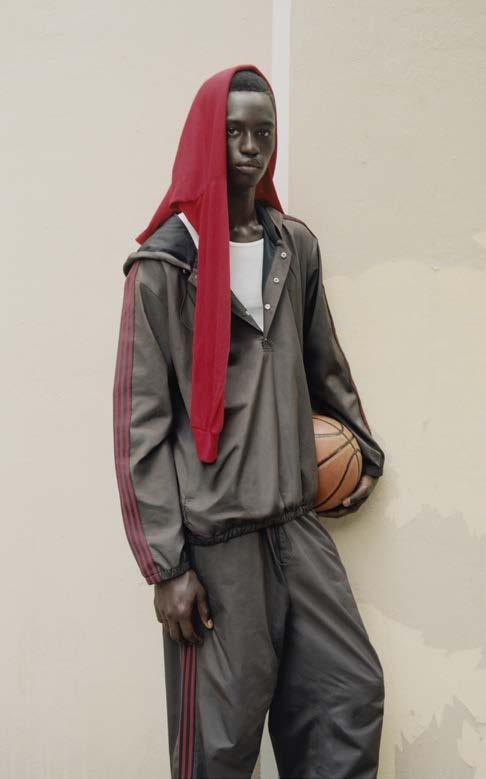
Maybe this text offers more answers than one might initially realize. In any case, one message is clear: fashion should not allow us to lose ourselves in a discourse about boundaries and rigid rules. It should provide orientation but also afford freedom for individual expression.
Consumers have long since outgrown being pigeonholed - and perhaps they no longer need a classic role model. Matthew McConaughey once said in his Oscar speech that he had to have someone “to chase” – a hero of sorts. He was not referring to a stranger, but to his future self. When the role model is oneself, fashion transforms into a tool for self-realization. Like a blank canvas that serves as a stage for personality. This is the stuff that modern menswear is made of: Stitching modern manhood.

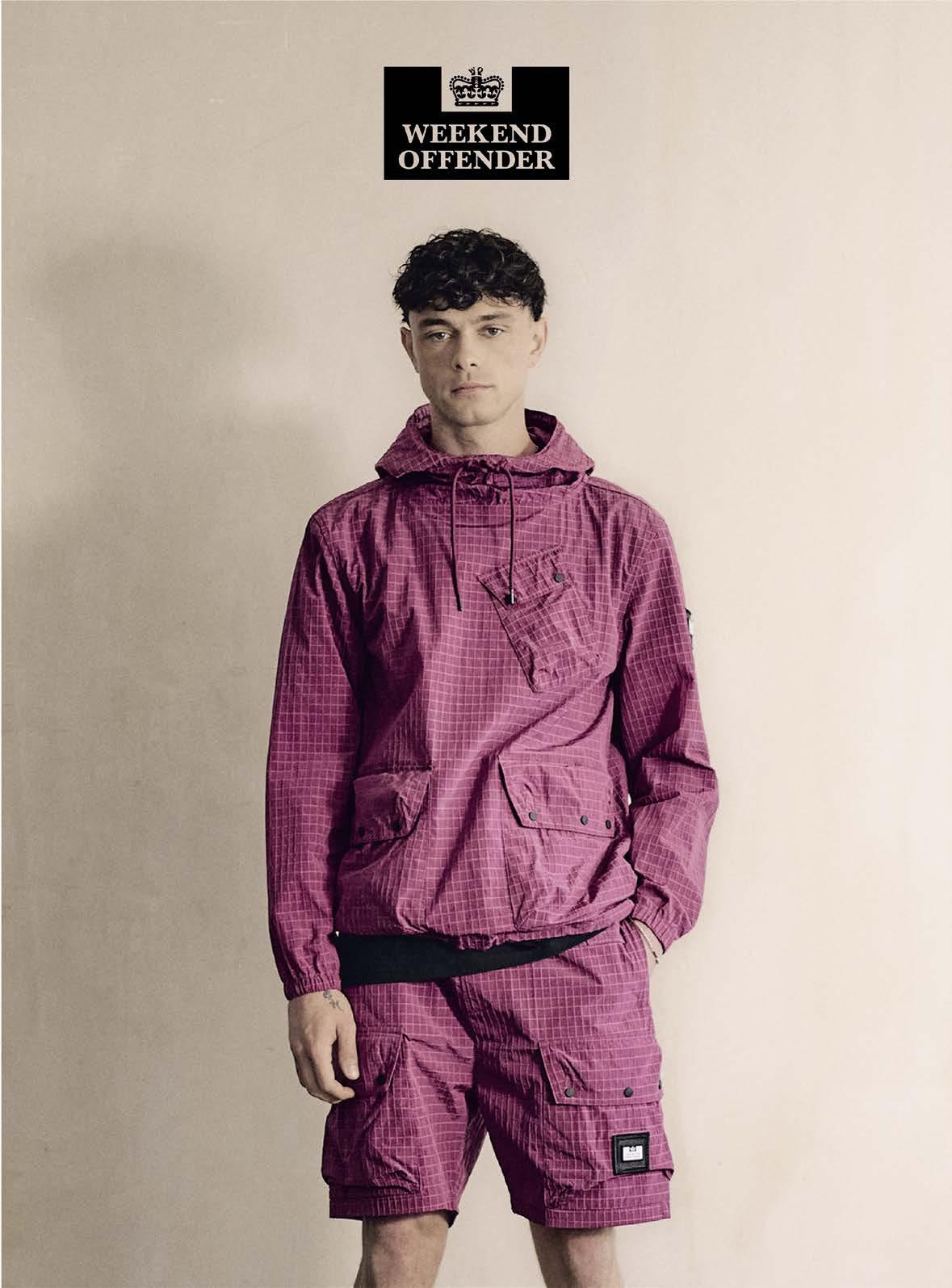


Modern menswear is caught in a paradox. traditional archetypes are being questioned or outright dismantled. But what is rising in their place? to explore this moment of change, we brought together two voices from very different worlds: Marco Falcioni, creative director at global fashion brand hugo Boss, and Mathis Molinié, chef at restaurant Philippe in rouen and a rising digital presence. Under Falcioni’s creative direction, Boss and hugo have repositioned themselves around ideas of reinvention and modern identity, while Molinié represents a new kind of public figure – approachable, influential, and grounded in real life. t heir conversation delves into the search for new sources of inspiration and the meaning of cultural relevance over fleeting hype. interview: Lisa hollogschwandtner. artwork: alexander Wells @alexanderwells
For decades, men’s fashion revolved around clearly defined role models – each with an aspirational look. Today, many of those figures are being questioned, if not entirely dismantled. Traditional masculinity is under scrutiny, yet no new dominant blueprint has emerged. Does menswear still need role models?
Marco Falcioni, Creative Director Boss: In my opinion, we will always have role models. But society – and how it evolves – shapes who those role models are. When it comes to style, we have clearly moved away from the icons of the past. I have always admired figures like Gianni Agnelli or John F. Kennedy – style icons with a consistent, refined aesthetic, often loyal to specific brands and tailoring codes. Today’s icons are more fluid. Take Timothée Chalamet –his style is constantly evolving. Right now, he is channeling vintage vibes; three years ago, it was more contemporary. He is straight, but his energy and style project a fluid sensibility. A$AP Rocky is another great example – bold, fluid, and experimental. Then there are timeless figures like David Beckham, whose style shifts effortlessly from a ripped denim to a sharply tailored suit. But even he is not pushing for a traditional sense of masculinity – it is more relaxed, more modern. Role models still exist, but they reflect the times and a wider range of identities.
Mathis Molinié, Chef at Restaurant Philippe: I agree that we have always had role models, but what is fascinating is the shift in what defines them. It is less about a specific physical appearance or a rigid set of external qualities, and more about the passion and character of the person. This is a much more profound connection, I believe. Style, in this context, becomes something deeply personal that truly shows the universe of that individual – their thoughts, their craft, their values. It is about what they do, their dedication, and the unique perspective they bring to their field, whether it is art, sport, or cuisine.
That is a great segue. Marco, with style becoming more personal and less about dominant macrotrends, what kind of aesthetic does a brand like Boss stick to?
Marco Falcioni: I think we can all agree that macro trends are history by now. You cannot walk out of Fashion Week or a shopping spree and pinpoint one precise trend. Frankly speaking, this is great; it is the ultimate confirmation of individualism, which I really like. This is one of the most significant mindset shifts we aim to convey to our customers: moving away from the suit as a rigid business uniform toward em-
bracing the suit as a form of personal expression and enjoyment. Blazers with denim, for example, are back – a classic 90s combination that merges American casual wear and European sartorialism. So, it is not about rules anymore. It is about individualism and your own interpretation of suiting and sportswear.
Individualism is a perfect bridge into my next topic: gender-fluid fashion. Coming from womenswear, I feel it has seen more commercial success there. How do you view the role and relevance of gender neutrality in fashion today? Mathis, maybe you would like to start?
Mathis Molinié: Historically, women have always borrowed from men’s wardrobes. What is new is seeing men confidently adopt elements traditionally associated with women’s fashion. You see this shift clearly on social media, with guys styling womenswear into really unique looks. It is refreshing. This mutual exchange opens up fashion as a playful, expressive space.
Marco, what is your take on this? Especially considering Boss’ strong background in menswear?
Marco Falcioni: Let us be honest, we owe a lot to pioneers like Coco Chanel and Yves Saint Laurent, who blurred these lines long ago. Marlene Dietrich, too, was a master of masculine-feminine play. Over the past decade, gender fluidity has for sure reshaped menswear – though perhaps not on the same (visible) scale as the other way around. I would rather argue that there is a gender fluidity in the attitude of men towards their wardrobe. The attention men pay to what they wear, the products they use, the brands they buy from, has certainly changed in the last ten years. I have straight friends talking to me about Korean beauty routines, for example. So, to come back to your question: it is happening on a different scale than in womenswear, but it is happening. When it comes to Boss, of course, our man still refers to certain archetypes and codes, which are coming back, by the way. Yet, the love for softer fabrics, certain hand-feels, constructions, and silhouettes, which were historically more in the women’s wardrobe, is now affecting our male client. You probably would not see a Boss client in a skirt, but you would see him in a fluid cashmere coat, definitely.
The headline we are exploring for this issue is “relevance”, and everyone seems to have a slightly different definition for that term. What is your personal definition of relevance, especially from your professional viewpoints?
Marco Falcioni: In the context of fashion, staying relevant is one of the biggest challenges we face as


brands and creative directors. For me, relevance starts with a clear understanding of what you stand for –because authenticity is absolutely key to connecting with the consumer, or with our fans, as we prefer to call them. So first, define your purpose. Then, you need to consistently demonstrate that purpose – not just talk about it occasionally. To avoid becoming redundant or outdated, you have to ensure your values are continually evolving. I always say: 50% of a collection should be firmly rooted in the brand’s DNA, while the other 50% should push boundaries. I really challenge my team to create something new –something with a fresh perspective. That is how we remain relevant: By filtering out the noise and focusing on what truly matters to the brand.
Mathis Molinié: For me, relevance is born from a deep-seated passion and an unwavering authenticity. We are drawn to people, and by extension to brands, because we genuinely appreciate what they do and the sincere passion with which they do it. It is not about a fleeting image or a manufactured persona; it is about a true, heartfelt connection. A relevant brand, as Marco has already put it, is one that consistently and genuinely reflects what they stand for and does so with a passion that ignites something in others. To me, it is this palpable dedication that builds trust and creates a lasting impact.
Given the strong performance of Boss in recent years, it is clear the brand is getting a lot of things right. In your view, Marco, what do you think has been key to that success?
Marco Falcioni: I hope we are doing a lot of things right at Boss – thank you. But of course, not everything always works out. Sometimes you have to try and fail in order to get it right. For me, failure is one of the greatest opportunities to learn. There are brands out there doing incredible work. What all of them, and also Boss, share, is a sharp message and a strong sense of identity at their core, that they bring to life. They are able to connect the dots and create a bulletproof brand experience by cutting through the noise and staying focused. I also believe another key element is a sense of community and belonging. Sure, you want a product because it is beautifully made and valuable – but also because it connects you to a certain community. And on social media, Mathis, I think that sense of community becomes even more visible. People want to be part of something bigger. They invest their money, their time, and their energy into that community – and they defend it. That sense of belonging is what truly drives the success of a brand or a talent.
I see Mathis agrees with you on that – and so do I. Fashion is becoming less and less about the superficial – it is increasingly about depth and meaning.
In our womenswear chapter, we explore the idea of substance over status – a shift away from logos toward brands that reflect personality and lifestyle. Do you see a similar movement in menswear?
Marco Falcioni: Honestly, I think women are significantly ahead of men in this regard. It has somehow always been a bit like this – men tend to focus more on status, while women prioritize substance, whether in fashion, art, or culture. But in general, I definitely agree with that observation.
Mathis Molinié: From my perspective, substance is undeniably becoming increasingly important – and rightly so. However, I believe that iconic luxury houses will always occupy a unique and special place in our collective imagination. They have the power to inspire dreams and often symbolize aspiration precisely because they remain out of reach for most people. This element of dreaming, of striving for something extraordinary, is a fundamental human desire. It’s essential for all of us to have these sources of inspiration. So, high-end luxury brands offer that dreamlike, aspirational quality, which holds its own distinct value and allure alongside the growing demand for authenticity, substance, and personal meaning.
Touching on your personal styles, do you have any fashion role models or people who inspire you?
Marco Falcioni: For my personal style, not really, I simply choose what I like. But I am strongly influenced by what is around me. For example, after returning from a holiday in Texas, I showed up at the office wearing cowboy boots, just because. When it comes to clothes, I usually stick to my jeans and t-shirts. It is funny – I am a creative director at a suit company, yet I wear a suit maybe twice a year. But when I do, I do so because it really feels right. When it comes to inspiration from others, I am drawn to some emerging designers. Grace Wales Bonner for example, is incredible; she channels a very sophisticated aesthetic grounded in cultural context, which is hard to do without falling into clichés – yet she never does.
Mathis, how about you?
Mathis Molinié: I have no specific style icon in the traditional fashion sense either. My greatest role model, the person I have always looked up to, is my father. He is incredibly passionate about everything he does, with a profound dedication to his craft. That unwavering commitment and love for his work is what truly inspires me – and it always has.
Marco, in fashion we have been talking for quite a while about the blending of streetwear and for-

Wholesale enquiries
Distribution for Germany & Austria
Die Hinterhofagentur
Hartford Showroom 6 Rue du Mail 75002 Paris (FR) showroom@hartford.fr
Roemerstraße 14 80801 München (DE) office@diehinterhofagentur.de Distribution
Limmatstraße 256 8005 Zürich (CH)
mirjam.gerber@macrame.ch
@hartford www.hartford.fr
malwear. How relevant are streetwear influences today? Has the trend already peaked?
Marco Falcioni: I hope so, personally! (laughs) But listen, I like to frame it slightly differently. If you allow me, I would like to talk about “street style” rather than “streetwear”. Obviously, in the last few years, streetwear has been dominant – luxury houses selling hoodies for 900 Euros and basketball caps for 500 Euros. I think that is fading out. What is still important, and always will be, is street style. Creative directors and design teams, in my opinion, cannot be in an ivory tower looking down from the top; they have to be on the street and see what people wear. For me personally, that is the biggest source of inspiration. So, street style is very, very relevant, has always been, and will always be. Streetwear, not so much anymore.
This connects directly to what we at style in progress refer to as cultural relevance – a quality we believe brands should be focusing on more than ever. From a product perspective, that means shifting away from hype-driven moments and moving toward pieces that are not only wearable but also rooted in a deeper cultural narrative. What is your take on that?
Marco Falcioni: Absolutely. It is again about the sense of belonging, of standing for something. Fashion has always been about mirroring the times. Now, our challenge is not just to mirror, but to fill the brands with values that represent the times.
Mathis Molinié: I am also convinced that cultural relevance is absolutely key – and it is shifting. For decades, traditional role models often came from the worlds of film or sports – figures who were often quite distant. Coming from the world of hospitality and cuisine, I find that my community values a different kind of connection – one built on accessibility and shared experience. People can perhaps connect more easily with someone like me because the interaction feels more direct, more grounded, more “boy next door” than a distant movie star. They can relate to the passion for food, for creating, for sharing. This relatability, this sense of being approachable and part of their world, is what makes the connection culturally relevant and ultimately much stronger and more meaningful today.
Talking about connection: In an age where digital presence often defines first impressions, how is social media shaping what is considered stylish or relevant in menswear?
Marco Falcioni: Social media plays a crucial role because it creates a bridge between the runway and real life. As Mathis mentioned, it is often those individuals who feel relatable yet have a strong sense of style
who help translate what we admire on the runway into something tangible and wearable. The runway is a beautiful spectacle, a source of inspiration – but it is when you see that same jacket, those shoes, or that bag integrated into someone’s everyday look that the magic really happens.
Mathis Molinié: I completely agree. What we see on the runway is often a heightened form of creative expression, which is inspiring but can sometimes feel very far away from what ordinary people can realistically achieve or feel comfortable incorporating into their daily look. When you see an influencer style a piece, you understand how it can be integrated into your actual wardrobe. He or she is somewhat like a middle person, a translator of trends, if you want to put it that way.
I would like to finish with one last insight. If there were one word that the fashion industry, or even society in general, should embrace more, what would it be? Mathis, would you like to start?
Mathis Molinié: I guess for me it would be passion. Passion represents so many vital things and is a powerful, driving force. When someone genuinely shows their passion for what they do, it has the ability to truly inspire people and make that individual, or their work, more relevant and resonant within their community. People are drawn to that authentic energy; they follow you because they connect with that fire.
Marco Falcioni: For me, the word would be togetherness. Society today feels deeply fractured – divisive and dividing. If there is one meaningful role fashion can play, it is to bring people together. And I do not mean inclusivity in the buzzword sense – it is a term that has been used so often it risks losing its impact. I am talking about genuine connection – not just within our own familiar circles, but across different communities. True togetherness means building bridges, fostering understanding, and creating spaces where people feel seen, heard, and united.
I truly believe these two words – passion and togetherness – are deeply intertwined. Few things connect us more profoundly or strengthen our sense of belonging like a shared passion. Thank you both for this truly insightful and inspiring conversation.
Marco Falcioni: Thank you, Lisa. And Mathis, we need to cook together next time I am in France. I am from Rome. I can do the perfect carbonara.
Mathis Molinié: Deal – I am looking forward to it already! Thank you both.

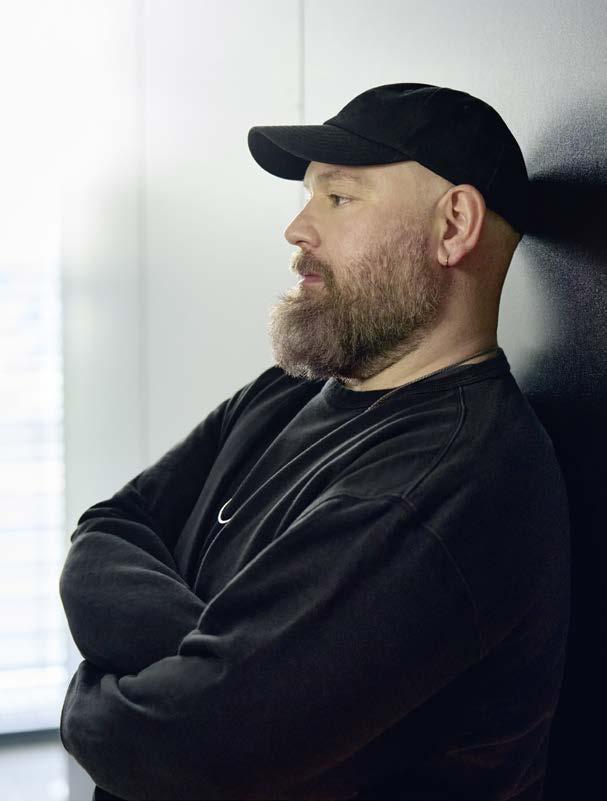
he is the roman man behind the creative upswing at hugo Boss: Marco Falcioni. as creative director, he is instrumental in shaping the design direction of both brands - Boss and hugo. With a keen sense for design and a pronounced entrepreneurial mindset, he has not only redefined the visual language of the brands but also strengthened their position on the international market. all this despite the fact that, as he reveals in the interview, he rarely wears suits himself. the italian finds inspiration
“on the street”, streetwear is his main source of inspiration, and his cell phone is brimming with photos of passers-by.
he attributes hugo Boss’ continued success to a clear brand identity – a strong dna that is consistently refined. and to community:
“People do not merely invest in well-crafted products, they invest in a community, in a sense of connection.”
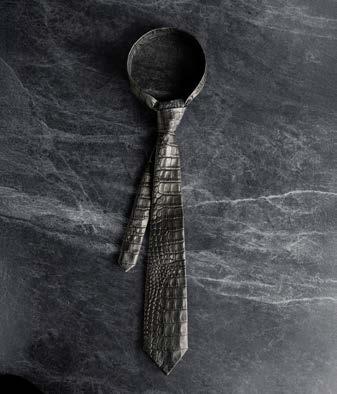
1 He designs suits, occasionally wears cowboy boots himself and, according to himself, cooks “the best carbonara”: Marco Falcioni.
2 A balancing act: 50 percent of the collection is rooted in the Boss DNA, 50 percent is intended to push boundaries. 3 Tailoring redefined: A look from the spring/summer 2025 show in Milan. 4 With the Art Basel Awards, the Hugo Boss Group is pursuing the goal to foster discoveries and dialogue at the intersection of fashion and art. Pictured: Marco Falcioni at the 2025 award ceremony.




Mathis Molinié is head chef at the Philippe restaurant in rouen, as well as one of the most exciting voices of a new generation of culinary and digital role models. at his side: his greatest role model and mentor, his father Philippe, with whom he not only maintains the family restaurant, but also reinterprets it.
Mathis Molinié embodies passion in both the kitchen, and in life. he is convinced that authenticity is key in a world that is often reduced to outward appearances. this is precisely why hundreds of thousands follow him on tiktok and instagram.
today, he combines two worlds: the analog world of traditional French hospitality and the digital world of social media. through his success online, he is also being recognized beyond the kitchen – as part of a new generation in men’s fashion that is abandoning traditional role models in favor of an open, contemporary interpretation of style and identity.




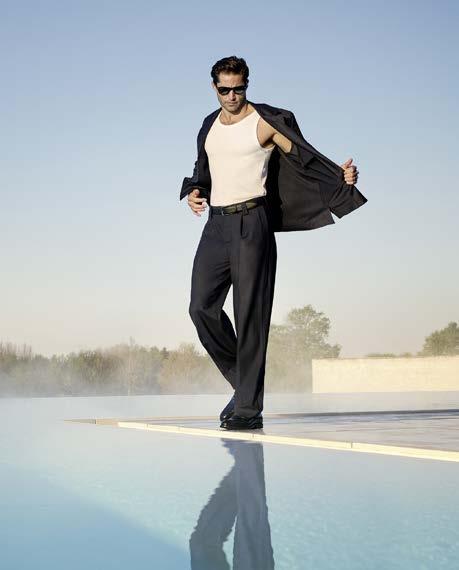

text: Lisa hollogschwandtner. Photos: alberto
Traditional masculinity is under scrutiny – and with it many images that have long dominated menswear. Does men’s fashion still need role models?
Marco Lanowy, Managing director of alberto: i believe that menswear is seeking new roles and role models now more than ever. i find the duality in our industry very exciting. We are experiencing both dilution and overload simultaneously. Many suppliers are trying to be everything to everyone, losing their stylistic focus in the process. But it is precisely that clear stance that is essential. Fashion is allowed to be disruptive. Where does menswear find guidance?
Streaming services such as netflix & co are certainly shaping new iconic figures. i am also noticing that the look is becoming more dressed up again. You are sitting opposite me in a double-breasted suit, but oversized; i am wearing a cravat instead of a tie. this development harbors a great deal of positive energy – and poses a huge opportunity for our industry. i would like to see us disengage a little from the discourse around noS and permanent resupply, a business concept in which everyone does
the same thing. this only contributes to collective uncertainty. When brand statements and products become interchangeable, when everything looks the same, then it is clear that the customer no longer knows where to buy. in this context, issues such as quality, sustainability, and social responsibility play an increasingly prominent role. emotional connection to the brand is also gaining in importance – something that is often underestimated in the retail space.
It used to be said that fashion sells dreams. Is that still true today?
Yes – and that is exactly what we need more of today! this is why events are so essential. i am convinced that we in fashion can learn a great deal from other industries. it is about creating new small universes that inspire, as the food and sports sectors are already doing, for example. The core topic of our summer issue is relevance. What does the term mean to you? in my mind, it comes down to a very simple question: is this really necessary? and to providing a profound, honest answer. relevance is one of those terms that goes much deeper than its common usage. if we take the idea further, this one term encompasses our entire style world: traditional, yet future-oriented. Unfortunately, relevance is often misunderstood as a pure marketing tool and therefore somewhat devalued. Yet it should, in fact, be a matter of course – an inner compass that determines the attitude and activities of a brand.


Who or what is currently setting the trends in menswear? gianni Klemera, Fattore K house: Modern men’s fashion is geared towards individual forms of expression and social changes. designers such as Matthieu Blazy, Miuccia Prada, and raf Simons emphasize playful, nostalgic elements that evoke childhood memories and convey joy. Meanwhile, topics such as sustainability and artisanship are gaining importance.
Which products inspire the modern menswear customer? they appreciate products that combine quality, comfort, and individuality. Popular styles include structured, lightweight blazers, relaxed cuts, sustainable materials, and subtle accessories. More playful elements such as eye-catching knitwear or nostalgic prints are equally well received.
What are the most successful labels excelling at?
Successful brands such as Prada, carharrt, or Universal Works combine artisanship with innovative design and a distinct brand identity. they succeed in addressing current social issues without compromising their authenticity.
Merz b. Schwanen believes that relevance in menswear does not stem from hype, but from attitude: “contemporary menswear does not draw its most profound inspiration from fleeting trends, but from a renewed appreciation of enduring values – heritage, sustainability, and functionality,” says nicolas Plotnicki-Morales, global Marketing & communications Manager of the albstadt-based brand. they focus on genuine craftsmanship: loop wheel shirts, manufactured on traditional machines, epitomize quality and longevity - no quick impulses, just substance. the image of the modern man is evolving: “classic style icons –grant, McQueen, dean – once had impact. today, attitude, authenticity, and meaning are replacing these role models.” Plotnicki-Morales is certain: “Style does not entail imitation, but intention.” the modern male image is reflected, calm, genuine –a fashion style that shows attitude without being flashy.

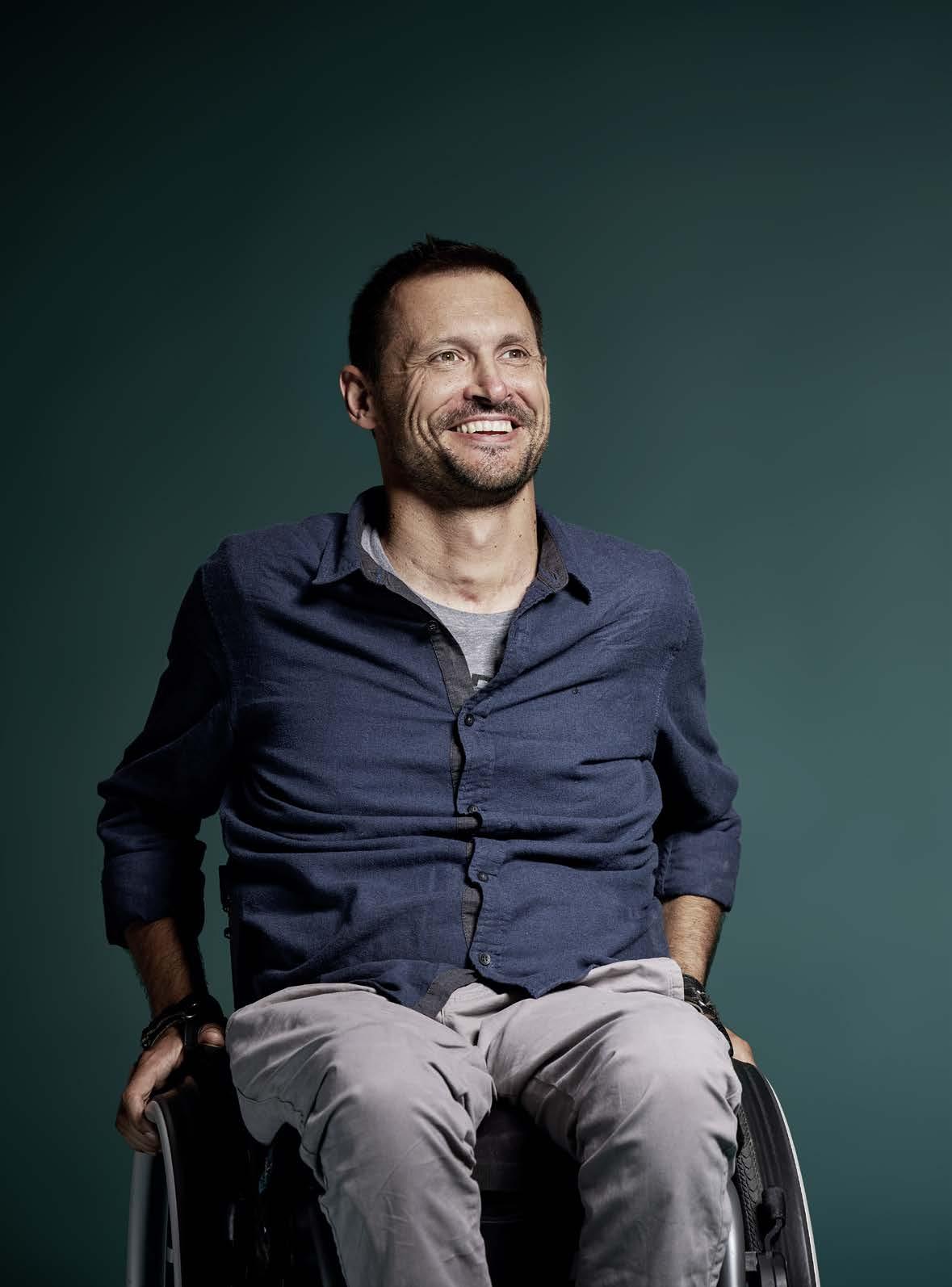

Does the modern man still need (visual) role models? thomas Jaeger, Managing director of dressler: in visual terms, not necessarily, yet role models are still a necessity. today, it is all about attitude and values. i myself have two people who inspire me greatly in terms of how they approach life and how they perceive matters, in both good and challenging times. against this background, fashion role models need to reinvent themselves. at dressler, we prefer to think in style groups rather than target groups. how do these people live? What interests them? it is about health, culture, politics, and art – across all generations, regardless of age. Quality, value for money – these are aspects that are currently gaining even more importance. What have been your priorities at Dressler since you started on January 1st?
i have always regarded dressler as a strong brand with excellent fits and quality, yet in some respects it was still a diamond in the rough. We are now reinforcing our strengths: modern suits for business, weekends, and evenings. We also offer outerwear, leather, knitwear – a whole attitude to life. dressler represents premium quality and luxury with poise – wearable, high-quality, authentic. our fits offer reliability across all sizes. our aim is to offer favorite pieces that are fun and can be worn in a variety of ways.
What does relevance mean to you?
i believe relevance means being real, acting in line with my values. it is about having fun, feeling at ease, and being courageous –even going against the mainstream at times. this requires attitude and backbone. this is exactly what our products should convey.
Where does the modern menswear customer find assurance?
Katharina and gregor grüner, co-owners of Modehaus güner: not in classic role models, but in lifestyle and authenticity. our customers desire a style that suits their everyday life – smart, confident, yet never overdressed. Brands such as circolo 1901, Mauro ottaviani, or 1868 by grüner strike a chord because they combine clean lines, high quality, and everyday practicality with a modern approach.
Are classic role models still relevant?
no. the modern man no longer relies on a prefabricated template. he wishes to define himself through his profession, his values, his lifestyle. clothing is an expression of that mindset. the more freedom, the more important personal aspects become. this represents an opportunity – not least for us as retailers. Which products truly inspire?
Products that convey a story. a circolo jersey jacket that resembles a jacket but wears like a sweatshirt – that is relevant these days. or our private label 1868, which features italian fabrics and a clear message: there is another way.


With more than 20 years of experience in marketing and sales, Thomas Jaeger is an expert in the areas of business analysis, brand development, and strategic brand positioning.

TOTHEWORLD

IN COLLABORATION WITH INNOVATIVE AND EMERGING ARTISTS, WE LAUNCH A CHARITY T-SHIRT COLLECTION EACH SEASON MADE FROM 100% ORGANIC COTTON €5 FROM EVERY SHIRT SOLD IS DONATED TO THE ORGANIZATION WIR (WATER IS RIGHT)
IN 2014, THE FIRST “SCRIBBLED PORTRAIT” WAS CREATED BY MANNHEIM-BASED ARTIST MARILENA HAMM FROM WHAT INITIALLY APPEARS TO BE A RANDOM JUMBLE OF LINES, EXTRAORDINARY DRAWINGS AND PORTRAITS EMERGE - DEPICTING THESE DEPICT INSPIRING PERSONALITIES FROM THE WORLDS OF MUSIC, ART AND SPORTS, AS WELL AS ANIMALS AND OBJECTS FROM OUTER SPACE AS PART OF A NEW COLLECTION FOR GOLDGARN CHARITY, SHE HAS CREATED THREE UNIQUE DESIGNS INSPIRED BY THE MARINE WORLD PROCEEDS FROM THE SALES WILL HELP GENERATE VITAL FUNDS TO SUPPORT WATER PROJECTS ACROSS THE WORLD

Jan Mangold is
Managing Brand Director at Windsor.
He speaks out for attitude and clarity in the brand statement, especially in challenging times.

Jan, let us start with a status update. How does Windsor assess the current developments in menswear?
Jan Mangold, Managing Brand director at Windsor: i believe we are currently experiencing an extremely differentiated and fragmented situation in the menswear sector. We no longer observe one major trend or direction. instead, opposing trends coexist. archaic masculinity images à la andrew tate on the one hand, and new, more sensitive role models such as harry Styles or timothée chalamet on the other. For young men in particular, these currents are extremely difficult to categorize. Who are my role models? Which direction is authentic or right? everyone is trying to piece together their own image in some way. How does a brand navigate times lacking clear direction? at Windsor, it means we maintain what we have been doing since 1889 – menswear with a tailoring focus. our task is to remain true to this commitment while constantly reinterpreting it. Precisely because there is no clear direction, we as a brand have to state all the more emphatically: this is who we are, this is what we represent. of course, some of our spectrum is also subject to change. at times it becomes a little softer, other times classic tailoring is in greater demand again. Yet our focus remains a constant.
In womenswear, we are experiencing a move away from major labels and an increased emphasis on quality. Is this also true for menswear?
absolutely. in the german-speaking market in particular, we are observing that consumers are paying more attention to product quality and values. the extreme price escalation of many luxury labels has triggered a countermovement. Many people no longer wish to afford these products, even if they could. Windsor offers a credible alternative in this respect, offering substance at fair prices.
How do you feel going into the new season? the creative climate is very exciting at the moment – many small trends, countertrends, more courage to combine. economically, the situation is challenging for everyone. Which term should we, as an industry, take more to heart? attitude. this applies not only to design and communication, but also to our responsibility towards the environment and society. and, quite pragmatically speaking, perseverance is probably the second most important term given the current market environment. after all, better times will certainly follow!
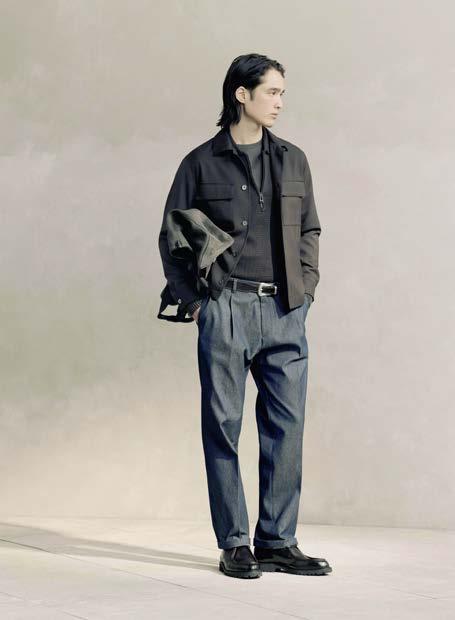


At a time when there is no universal trend: what does Hiltl focus on? What provides orientation?
thorsten grönlund, ceo of hiltl: as a traditional company with a 70-year history, trends are not our guiding principle. We define our brand in terms of values such as quality, artisanship, and fit. this is why hiltl customers are very loyal to our brand. overall, however, we are observing a shift in silhouettes towards wider trouser shapes, which is currently fueling sales. Womenswear is abandoning logos and hype in favor of brands that reflect personality and lifestyle. Are you experiencing a similar trend in menswear? here too, our history is an important asset in building customer trust. We have never been loud and never will be. Silent luxury certainly reflects the brand effect of hiltl trousers very well. however, i can confirm your statement that there is a general shift away from “over-branded” fashion. What is the essence of successful brands? they deliver on their brand promise, be it quality, fit, style, or exclusivity.
Are we experiencing a fundamental transformation in menswear?
tobias Schellenberger, ceo of rossi: absolutely. Men in particular are increasingly questioning traditional role models – and also how they choose to dress. People like harry Styles or timothée chalamet are already significantly influencing the new image of what masculinity can and should look like, especially for a younger target group. in classic menswear, where many customers are over 40, it is often even more difficult to find identification figures. Yet a great deal is changing here too. Men no longer just want a new pair of pants. they are seeking something special, regardless of age. and that is exactly what we at rossi have been observing lately: our fashionable, unisex pants are equally highly popular with customers well over 30. How do you approach your collections creatively? traveling is our biggest source of inspiration – be it Paris, Milan, Seoul, or La. We keep an eye on things happening in fashion-forward stores and what people are really wearing. instagram is the second major source. We follow many exciting personalities who indirectly help shape our designs.
Looking back, how did the launch of the unisex concept go and what has changed?
When i debuted the collection in July 2022, many people scoffed at us. others showed interest, yet they lacked the courage to approach the topic. today, that has completely changed. genderless is no longer a vision – it is a reality that reflects the zeitgeist.

as of September 2025, cg – club of gents presents itself with a new branding. ralf Klute, head of design, insists on clear recognizability and a strong external impact, with a consistent focus on the core brand, paired with a relaunch of the two sub-labels. Savile row by cg - club of gents is more modern and fresher, creating a smart look between classic and contemporary. Men wear shapes as graphic Bauhaus echoes in short-sleeved knits and summer shirts and show the suit in a new light. Your own Party combines the classic with style, providing a reliable look for exquisite occasions. Light natural tones bring a sense of ease, while bold green and blue add modern accents. contrast is provided by vests and accessories in paisley, floral pastel shades, or fine Vichy checks, accompanied by detailed ties made of wool crepe. ralf Klute presents the current spring/summer collection of the core brand with a new understanding of sobriety and minimalism. Shot in classic Bauhaus locations, his designs echo the architecture in straightforward and simple neutrality. “our looks are becoming more relaxed and cleaner, enhanced with a flash of color. the game changers of these casualized classics are shirts, t-shirts, and knitwear,” explains Klute. the new suit look – “less business, more street” – combines the casual suit with jackets and overshirts instead of the classic suit jacket. relaxed fits are increasingly replacing slim fits. From spring/summer 2026, cg – club of gents will make a statement in the direction of a total look with its first footwear collection. www.cg.fashion

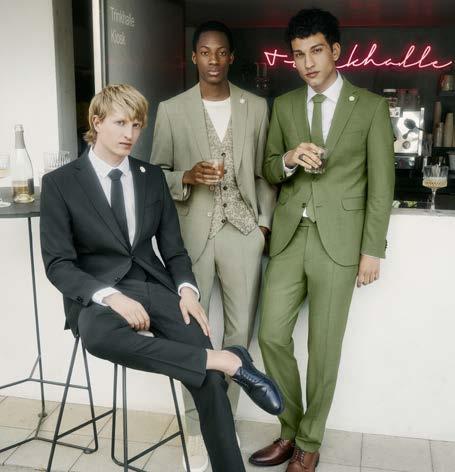

“Peace, love, unity, and having fun; these are the core values of my home,” says alexandre guarneri of homecore, describing his vision of streetwear. he is considered a pioneer within the French community. the central stylistic element of all his designs revolves around the theme of sustainability, which he conveys through colorful patchworks created by, for example, upcycling excess material from overproduction. For the current 2026 summer collection, homecore explores the balance between man and nature, which is primarily reflected in the choice of colors and fabrics. new additions include patchwork jackets and shirts.

With the guiding principle: “empowering men to show their emotions openly. redefine what it means to be a man in modern society”, hot Boys cry sees itself not only as a fashion brand, but also as a cultural movement. the aim is to question traditional images of masculinity and redefine emotional openness as a strength. Founded by alex nicolaus, the brand consciously uses fashion as a tool for social change. accompanied by formats like a movie night or charity initiatives around mental health, a strong community is created. the products appear in curated quarterly drops and are currently only available online – high time to make them visible in brick-and-mortar stores. @hotboyscry
Skergeth est. 2021 is a joint design project by Julia Maier-Skergeth and her husband ronni Maier - originally intended for men, today reinterpreted as a balance of masculine clarity and feminine versatility. the limited-edition leather briefcases (21 per color) are made in italy and reflect the couple’s personal style. instead of form follows function, at Skergeth est. 2021 the focus lies on stylish functional accessories – everyday luxury with character. a special highlight: each bag is personalized and is therefore unique, making it an ideal gift or personal keepsake. @skergeth_est_2021


With his brand, Martin niklas Wieser pursues the goal of questioning social structures. his aesthetic emerges from an examination of proportions, silhouettes and the relationship between the body, clothing, and technology. Subcultural references and questions about identity, luxury and consumption determine his designs. he produces in italy and designs in Vienna, focusing on transparency and a human scale. Wieser studied in Berlin and London, worked for Proenza Schouler, among others, and draws on his working-class background as well as a critical view of capitalist structures. in May, he was recognized with the Munich fashion award. @martinniklaswieser

anything but a newcomer – and yet one of our editors’ Picks, because it is so in tune with the times: ten c, designed by alessandro Pungetti and part of the FgF group, stands for high-quality clothing that goes beyond short-lived trends. the designs combine functional elements of military uniforms with urban sophistication. the focus is on original Japanese Jersey – an innovative fabric that impresses with its exceptional durability and versatility. elaborate piece dyeing gives each item its individual character. artisanship, material research and timeless design with substance are anchored in the brand’s dna What does relevance mean for Pungetti? “Seriousness - and honesty.”
@ten_c_official


o, a and S are the three initials of the founder, oliver adam Sebastian. he found inspiration to create the brand on his numerous trips to Barcelona. originally started with espadrilles, the brand developed into an international resortwear brand. however, the styles are not just suitable for the beach. rather, the exciting material combinations, summery patterns and designs inspired by art, architecture and the global creative scene strike a chord with a new menswear customer. the company works closely with family businesses and manufacturers to ensure consistently high product quality. @oascompany
the altar is a lifestyle brand founded in Berlin that combines natural forms and urban Berlin aesthetics. the vision: to create places of retreat – bold, sensual, expressive. earthy tones, asymmetries and handcrafted details meet influences from Berlin’s nightlife and creative diversity. Many pieces are created in cooperation with Berlin creatives, selected according to vision, attitude and design language. the name refers to altars as places of mindfulness. the range includes jewelry, candles, silk scarves and decorative objects. the rings are made of pure sterling silver, handmade in Berlin. www.thealtarberlin.com

Womenswear is changingfar beyond trends. The new currency is no longer hype but depth, not abundance but meaningfulness, not status but substance. At a time when lives are becoming more complex, fashion is taking a step back – and at the same time, a big step forward.

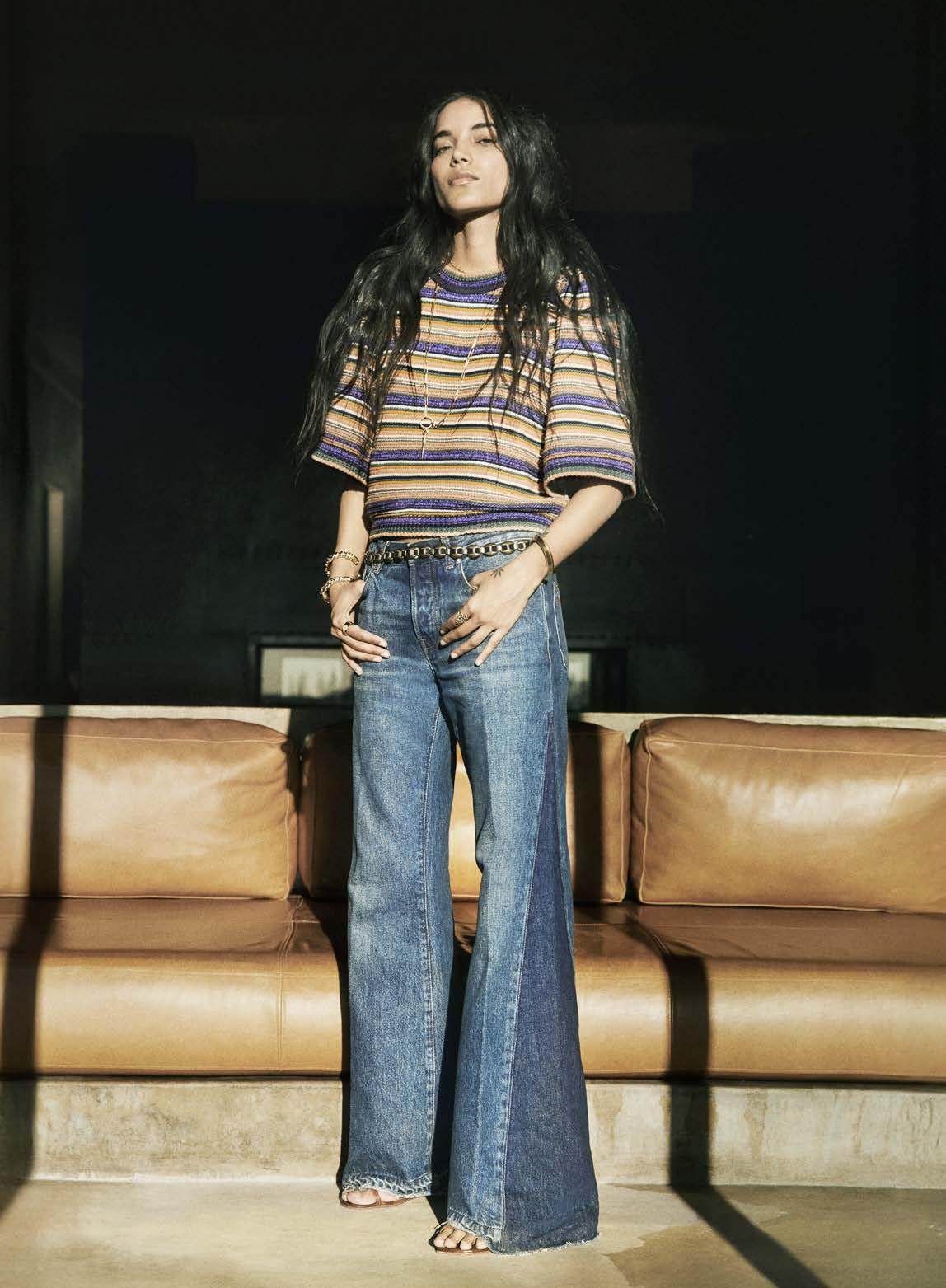
Lifestyle instead of dress code – this is every bit as important to consumers as an honest priceperformance ratio for the fashion they wear.
Logos, labels, luxury? things of the past. today, womenswear is no longer defined by big brands, but by the women who wear it. trends are no longer the decisive factor, but rather whether fashion reflects the lives of consumers. the realization that fashion still needs to earn its place in life.
text: nicoletta Schaper. Photos: Brands

Has the balance of power reversed for good? Contemporary womenswear is undergoing a major transformation, one that is both organic and progressive. We are in the midst of this shift. Style is no longer dictated by brand design but interpreted individually. The one trend or dominant brand no longer exists; a new diversity is shaping fashion instead. Looks with feminine coolness are not loud but rather radiate a certain nonchalance and naturalness. The cuts? They are carefully crafted and yet relaxed. It almost seems as if contemporary womenswear has grown up. “Customers demand universally applicable clothing that suits their lifestyles,” says Timothy Hoferer of the Modeist sales agency. “Instead of being restrictive, fashion adapts to the everyday lives of women who often fill several roles simultaneously.” With this in mind, the agency added Less by JNBY, a collection from the JNBY stable, to its portfolio in summer 2024. It is available at retailers such as Donna of Hannover, Laufsteg of Augsburg, and Bailly Diehl of Frankfurt. “The style is clean with sophisticated details, while the quality and price are spot on – customers immediately recognize whether the price is justified,” says Timothy Hoferer. “I am convinced that the collection still has great growth potential.”
“More than ever, fashion needs to provide a reason to buy it,” says Elisa Gaito of the eponymous Milan-based sales agency. “Merely serving status is no longer sufficient. Contemporary womenswear has evolved and now bears cultural and sociological references.” “Women are no longer willing to buy overpriced fashion that is not worth their money,” says Petra Esparza McAlpine, whose agency represents brands such as Simkhai, Harris Wharf London, and Labo.Art. “Logos are barely relevant anymore, with quality becoming super important instead. The mindset has fundamentally changed.”
Quality and wearable chic at a reasonable price. These attributes are often ascribed to French brands in particular and they are currently in high demand on an international level. Collections such as Isabel Marant Étoile, Sandro, Sessùn, and, more recently, Lemaire are but a few examples – and the niche is vibrant. “French contemporary is absolutely on the rise,” explains Regis Benabou, whose MAB Fashion Agency markets the Ba&sh brand in German-speaking countries. “Their feminine style is expressed with casual confidence, while the looks refuse to follow any particular trend and can be worn in a variety of contexts. What is crucial, however, is that the price-performance ratio is just as attractive as the brand image.”
Thus, contemporary wear also appeals to a new generation that has grown up with Uniqlo, COS, or Arket and has learned that excellent quality can be affordable. The target group is evolving – away from the purely trend-conscious customer towards the more discerning shopper. Many younger B2C labels, including Sézane and Soeur, have injected even more dynamism into this process via social media. “We are in a noticeable state of transition,” confirms Mila Naderer of Bluma Store in Linz. “The last few years have been dictated by fast fashion and trends were meant to be consumed immediately. Now even young people are realizing that this approach is too short-lived.” In her store, she stocks Samsøe Samsøe, Rotate, and Baum und Pferdgarten, among others. “Our customers expect a range that is suitable for everyday use with long-lasting quality, but not at exorbitant prices.”
There is another attribute that influences the new buying habits: “Today, no collection can survive without a cool image,” says Petra Esparza McAlpine. “When women discover a new label in a store these days, they immediately scrutinize its image on insta.” The key is how the label communicates – whether


Branddriven had its day. The one dominant brand or trend no longer exists; the wearer defines her own style. She is not interested in being seen, but in being understood.
F.l.t.r.: elleme Paris, nous antwerp, Simkhai
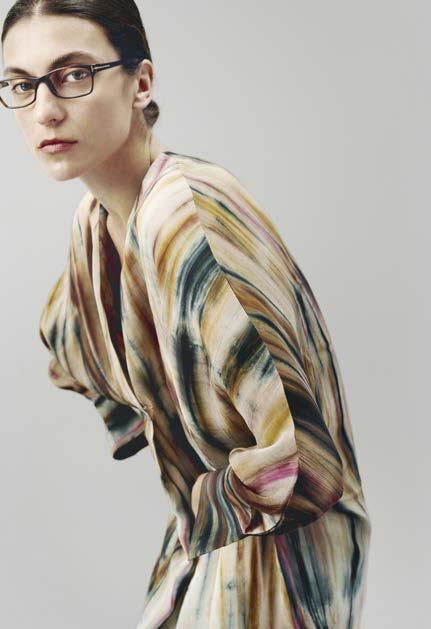
it tells a story and, crucially, whether the lifestyle matches their own. Esparza McAlpine cites the Rhea collection, new to her agency, as an example: “At a second glance, every piece reveals something special, such as a ruffle, extra-long sleeves, or a deep V-neck that appeals to young women in particular.” Purchase prices from 60 Euros provide further convincing arguments.

Uniqueness, as offered by some niche labels, is gaining in significance. With Nous Antwerp, Lore Heyman has created a collection that emphasizes artisanship: tie-dye and shibori dyeing techniques yield favorite pieces that are as special as they are timeless. “Our fashion is highly individual, whilst being comfortable and easy to wear,” explains Lore Heyman. “Instead of mass-produced clothing, we strive to offer an honest product that is only available in limited quantities at reasonable prices between 119 and 389 Euros. Modern women expect fashion to offer added value and to be functional. For example, a hand-dyed silk kaftan can be worn over a bikini during a summer vacation, but it is also suitable for a night out, spiced up with a belt and a beautiful piece of jewelry.”
The traditional definition of luxury? Interchangeable. “Today, luxury is a silent presence,” Ivana Batakovic insists. “My label Batakovic Belgrade creates items that support women, rather than impose on them. Our timeless designs are rooted in exceptional artisanship and a deep understanding of how fashion expresses personal power.” Longevity trumps impulse buying, as the demands of modern consumers have, quite simply, evolved. “Fashion has to earn its place in a woman’s life,” says Ivana Batakovic. “That’s why I create functional and versatile clothing: Luxury pieces that enhance every experience, whether it’s a business trip, a special event, or a selfcare moment.”
Speaking of selfcare: fashion is facing ever more competition from this segment. Nowadays, women are spending less money on clothing. Not only when their personal consumption budget decreases, but also when it remains stable – it is simply allocated differently. “The woman of today takes three-day spa vacations, goes out to eat, and invests in tech or further education,” observes Petra Esparza McAlpine. “Everything related to selfcare has become very popular.” Beauty, wellness, travel, sport – all these elements
















Women’s contemporary looks are diverse and often work just as well in everyday life as they do in the evening, wearable and individual. Not loud and exaggerated, rather casual, feminine, timeless, and comprehensible.
F.l.t.r.: Less by JnBY, Sandro, Batakovic Belgrade
define a personal lifestyle. “Fashion as an expensive status symbol is a thing of the past,” says Elisa Gaito. “A pair of trousers for 2,000 Euros that you also have to take to the dry cleaners no longer suits modern life. Today, we have other interests; fashion is only one part of our lifestyle that it must adapt to.”
Timothy Hoferer believes that, in order for the fashion business to remain viable, both collections and retailers need an even clearer and more stringent concept. “That means fewer styles, yet more depth. Colors need to be consistent, qualities convincing. Incidentally, they also need to offer a sensible size range that goes beyond M or L. If all these requirements are met, retailers can transform themselves into a brand by offering a niche product.” The Flow Store in Florence succeeds at doing just that: “Our customers are more interested in a unique look that cannot be found elsewhere and enhances their personality rather than a brand,” explains owner Gabriella Pecchioli. The key is that fashion carries meaning for the wearer. This can be reinforced through personal experience and emotion. “Our customers want to feel comfortable here. They are looking for something that will accompany them throughout the day and still look great in the evening when there is no time to change. We really enjoy advising them accordingly, right down to accessories and hairstyles. This builds trust, almost like a friendship. You form a relationship with the customer, allowing them to understand many things that you cannot explain online.”
In the past, brands created a lifestyle. “Today, the entire concept has to be a lifestyle, right down to the space in the store and our advice,” explains Mila Naderer. Even in premium retail, pop-ups and events are now a widely used tool. All the more personal they need to be. Mila Naderer draws inspiration from impressions made in Copenhagen. “In April, we hosted a brunch in cooperation with our local baker,” recalls the retailer from Linz, who is keen to create a meeting place instead of a sales event. “It is important to me to think outside the box, so we offer cappuccino and excellent conversation instead of forcing people to buy. The more personal, the more enthusiasm we can inspire.”
This principle remains valid today, despite all the challenges posed by our geopolitical situation and the revolutionary innovations brought about by AI – perhaps even more so. Petra Esparza McAlpine shares this conviction: “Our lives will change fundamentally, and we are not yet sure how. This is a very challenging time for our industry. But that is precisely why it is so much fun.”



WHAT WE’VE WOVEN TOGETHER
giada Forte, founder of italian brand Forte Forte, and Laurence a ntiglio, owner of Zurich-based store Vestibule, have been expressing a different narrative in womenswear for more than two decades – one that does not dress up or seduce, but that liberates. t heir fashion is not a mere mantle, but a reflection of one's inner self: soft, clear, full of soul. in a world characterized by urgency, they give women space to exist – and to breathe.
interview: Janaina engelmann-Brothánek.
Photos: Forte Forte, Vestibule Store
Let’s start with the first question: How did you meet and what was your first impression of each other?
Giada Forte, founder and CEO of Forte Forte: What a wonderful question. I remember it well: Forte Forte was still in its infancy – made up of just a few pieces that were intuitive, almost raw. Our strategy was not fully developed – and yet the vision was clear. Our desire was to create a small, poetic universe. And then I discovered Vestibule. This store had a soul, and it felt like a home; like an open, highly personal closet. I knew immediately that I wanted to see Forte Forte in this wardrobe. I then wrote to Laurence – I think it was an actual physical letter – and really started courting her.
Laurence Antiglio, owner of Vestibule: To be honest, the courting phase did not last long! (laughs) I had discovered Forte Forte myself in a Paris showroom and was immediately fascinated. So, I placed an order as early as the second or third season. It was more than fashion: a world of textures, light, feeling. The fabrics, the colors, the little poetic touches like the pearl on the label that you get to keep, like a promise. It all spoke a language that I understood immediately. For me, Giada embodies her designs in every sense: warm, quietly powerful, full of grace – and gentleness.
So, your collaboration goes back a long way?
Laurence Antiglio: Yes, 20 years – and these two decades have been an incredibly enriching time for me. When I think back, our relationship has always been more than business; it is a creative dialog, almost a friendship. I remember, for example, a capsule collection that we created together to mark the tenth anniversary of Forte Forte. It was an expression of our connection.
Giada Forte: That was a real labor of love. At Forte Forte, we regularly develop small capsule collections – not for marketing reasons, but out of an inner need. We often work with archived fabrics, with production remnants, sometimes even older prototypes. We take them apart, rework them, and lend them a new lease of life, almost like upcycling with a soul. With partners like Laurence, it feels like a gift to them, their space, and the communities that share their world with us. Our capsules should express exactly what Forte Forte represents to them and what Vestibule means to us.
Laurence Antiglio: It was a really special experience for our customers. Many have known Forte Forte
for years and are strongly attached to the brand. To suddenly discover a piece that is really only available from us moved them. This is not just about exclusivity, but about the feeling of being seen. It is like a small gesture of affection, like an invitation to be part of this shared history.
Giada Forte: Exactly. The idea is to create clothes that leave space – to breathe, for your personality, and your own pace. Our pieces are meant to be soft, open, sensitive. No masks. No poses. Clothing as an inner space. Dare respiro e spazio per essere. Breath and space to simply be yourself.
Who is she – the woman of Forte Forte and Vestibule?
Laurence Antiglio: That truly is a key question, and as time goes by, our idea of the woman we are addressing is becoming increasingly distinct. Of course we strive to remain open, but over the years it has also become clear that our customers are no longer 20. Many of those who visit us are 40 or 50 and know exactly what they want. They are well informed, even better than ever as a result of social media. This woman cannot be fooled: she does not follow fast trends, but is looking for depth, attitude, substance. She has style, values, and a clear idea of what suits her. She does not need empty shells, she seeks authenticity.
Giada Forte: I totally agree with you, Laurence. Our woman does not dress to be someone else or to conform to a system. She chooses clothes because she knows who she is. She does not require a mask. What sets her apart is curiosity, openness. A passion for what connects fashion, art, travel, and life. She lives consciously, even economically. Nowadays, the fashion budget is only part of a bigger picture – and that is a good thing. When she chooses Forte Forte, it is because she sees herself in it.
So, your customer is not merely wearing clothes but rather expressing an inner truth. How much does this aspiration shape your work? Is it a responsibility that inspires you, or does it occasionally create pressure?
Giada Forte: I have never perceived this as pressure because I do not consider myself a classic fashion designer. I possess a great sensitivity for fabrics, for materials, for everything that feels real – for pure, quiet beauty. That is something we need to safeguard, today more than ever. Forte Forte embodies precisely this aesthetic, and the resulting authenticity is palpable. It is not about perfection, but about the real thing. Our customers sense that too.
Laurence Antiglio: This authenticity also plays a central role for me in the store. I curate the range like Giada curates her collections – with intuition












































































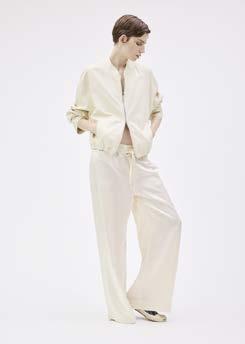



































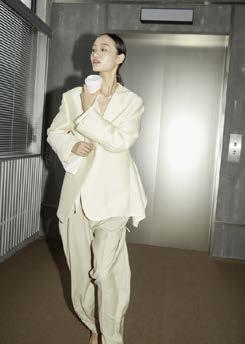







































































































and respect for the customer; different season after season, not rigidly organized by brand, but fluidly, by color, by mood. Of course, I also sense the next trend – maybe red will be the next color or leather jackets the key piece. I listen to these signals. But the central question always remains: does it belong in our Vestibule universe? Does it suit me, my message? I know that if I tell my customer that Gwyneth Paltrow is wearing this piece, she will smile, but she will not buy it any more likely because of that. The hype is irrelevant, what counts is the attitude. That is why I make all decisions with one goal in mind: it has to feel right and coherent. For the customer – and for me. But without pressure.
Speaking of relevance: the main theme of this edition is exactly that. What does the term mean to you?
Giada Forte: I understand relevance to mean deep value and respect – for the garment, the manufacturing process, and all the people involved. Fashion gains relevance when it is authentically created, consciously conceived, and responsibly implemented. This is not about fleeting trends, but about staying true to a clear vision and making the artisanship of a place tangible.
Laurence Antiglio: Relevance is my inner shopping filter. With every piece, I ask myself: does this make sense for me, my customers, and for Vestibule? Quality, purpose, and attitude are paramount. That means I choose fewer, but more consciously. For me, true relevance is never accidental.
Is luxury still relevant? Or is it time to rethink the concept of luxury?
Giada Forte: Luxury has radically changed in recent years. In the past, it was often synonymous with exclusivity, high prices, and status symbols. Yet many people are no longer drawn to this traditional concept of luxury. It seems unapproachable, detached from everyday life, and therefore also loses its emotional significance. It would appear that people have grown weary of being constantly categorized and pigeonholed – be it as millennials, Gen Z, influencers, or fashion victims. This tendency to categorize people has spread to the concept of luxury and robbed it of much of its original power. Today, luxury means something completely different. It refers to things that have real value - in the sense of care, dedication, and respect in their creation. Luxury is what stands the test of time, what has been created with artisanship, what tells a story. For me, a piece of clothing is luxurious when you can feel that it was created with inner conviction – not to follow a trend, but to convey beauty and meaning. Authenticity is at the center. If this attitude is reflected in a product, then that is true luxury for me.
Laurence Antiglio: I, too, define luxury not just by price, but by quality, rarity, and individuality. If I see the same Bottega Veneta look in a shopping center in Abu Dhabi as I do in Paris or online, I miss the sensation of uniqueness. Modern fashion is often interchangeable, predictable, uninspiring, even if it is expensive. A truly luxurious product should not exist in masses. If five of my friends are wearing the same bag, it loses its appeal. Today, true exclusivity is not the visible logo, but the personal connection to a product that authentically suits me. Brands like Forte Forte demonstrate how things can be done differently. They have a clear identity, yet they do not come across as loud. Their clothes are not made to be recognized immediately, but to be worn and experienced. The focus is on individuality rather than uniformity – and rarity.
The French look is currently enjoying a resurgence in popularity. Laurence, you have been talking about it for years. What makes it so current in your opinion?
Laurence Antiglio: True, I really have been talking about the “look à la Parisienne” for 20 years! (laughs) But yes, now it has well and truly arrived. I believe it is this famous nonchalance, this l’air de rien. French women look like they are not trying very hard, but in reality, they are very informed, very aware. They make the style their own, interpreting it in the context of their personality. It is quiet sophistication, sophisticated but never strained, and perhaps that is precisely why it is so contemporary. Keyword: Jane Birkin, feminine and masculine, with jeans, t-shirt, blazer and braided bag. This is a classic that never gets old or boring because the woman who wears it makes it personal.
Giada, how would you define the Forte Forte look in this context and how has your signature style changed over the years?
Giada Forte: Perhaps Forte Forte is an Italian Parisienne. Refined, but not pretentious – this casual elegance, la douceur, sophistication without formality. Many people thought we were a French label at the beginning, but we are Italian to the core. Yet this idea of wearing a cashmere blazer, a silk dress, or a poplin blouse with the same relaxed naturalness, that is precisely what Forte Forte is all about. We started with ten pieces – fine, transparent fabrics, hand-embroidered t-shirts, a single fisherman’s trouser model and everything in black and white. This “young woman” has gained experience over the years. The silhouettes are clearer, the materials even more exclusive, and we are now also colorful. One thing has always remained the same: The desire to create something that touches the soul.


giada Forte, born in Vicenza in 1972, grew up in a traditional family business that has stood for high-quality knitwear for generations. She developed a keen sense for materials, knitting techniques, and haptics at an early age. after studying Knitwear design at nottingham trent University, she spent formative years in Paris, where she honed her creative signature at Kenzo and in a small studio at galerie Vivienne. Back in italy, she worked at Benetton for more than seven years and finally as head of Knitwear at Sisley. the industrial fashion world, however, ultimately felt too anonymous and alienating to her. together with her brother Paolo, she founded Forte Forte in 2002 – a label that goes far beyond fashion. it represents an homage to timeless femininity, a quiet, sustainable aesthetic, and a deep desire to create clothing that forges a connection between the wearer and craftsmanship. all collections are created exclusively in italy, respecting materials, people, and sustainable processes.
today, Forte Forte is one of the major players in the international womenswear segment with eleven own stores and 600 retail partners



Laurence antiglio, who lives and works in Zurich, is the founder of Vestibule, a multi-brand store launched in 2005 to provide a stage for international designers who show attitude and style.
after graduating from École hôtelière de Lausanne and spending several years in the marketing department at Unilever, she decided to pursue a career in fashion in 2003 and completed a master’s degree in Fashion Business Management at the institut Français de la Mode in Paris.
Vestibule presents a carefully curated selection of labels that do not simply follow trends, but embody quality, authenticity, and sustainability. From established names such as Forte Forte, isabel Marant, and chloé to carefully selected niche brands, Laurence brings French esprit and global perspectives to Zurich.
in 2014, she expanded the concept with a second store, which she runs together with her husband, who has been a managing partner for ten years. She attaches great importance to a strong visual identity, a keen sense of storytelling, and the connection between fashion and lifestyle.

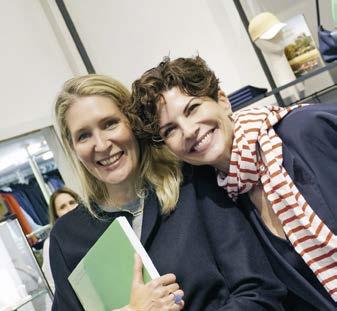

As Head of Design and Creative, Ella
is responsible for Arket’s creative direction.
C"CREATIVITY NEVER HAPPENS IN ISOLATION"
With its store opening in Vienna, a rket officially entered the austrian market. to mark the occasion, we sat down with ella Soccorsi, head of design and creative, for a conversation at café Kandl. her interest in design stems from curiosity – about people and what is happening in the world. over coffee, we spoke about the concept of nordic lifestyle, the evolving meaning of modern luxury – and the creative force that lies in human connection.
interview: Lisa hollogschwandtner. Photos: arket
Ella, is it your first time in Vienna?
Ella Soccorsi, Head of Design and Creative at Arket: As an adult, yes. I have actually been here once as a child. I would really love to stay a few more days. A friend of mine gave me a whole list of things to do and see. So far, I managed to check out some vintage stores yesterday. And now I am really excited about our opening tonight.
So is Vienna! But first, I want to talk to you about your perspective on the current state of womenswear. Our lead article is titled “Substance Over Status”. What comes to mind when you hear that?
It really speaks to me, because that is exactly what we are seeing at the moment. People really want to get value from the money they spend – rather than status. So, I definitely see a big shift there. That is probably why more and more of the big fashion houses and luxury brands are inviting customers to take a closer look at how pieces are made – to talk about and show the artisanship behind them. And I truly believe that is what people are gravitating toward right now: understanding why things cost what they cost. That also means the level of attention to detail and care we put into every piece is worth a lot more than it might have been in the past. So, coming back to your question: yes, I definitely see that shift from status toward substance. And for us at Arket, that is a beautiful thing. Our mission has always been to democratize fashion – to offer high-quality, long-lasting pieces at a reasonable price point, and to raise awareness about what quality in fashion really means.
So, education is a big part of a brand’s role right now…
It is definitely not education in the sense of “We as the brand know everything, and you, dear customer, do not”. But we do see that our customers really want to learn more and more. And they already have access to a huge amount of information – thanks to the internet and social media. That has really changed in the last, let us say, ten years.
You briefly mentioned the big luxury houses. In my opinion, the definition of luxury is changing a great deal right now. Would you agree? And how would you define it yourself?
Well, I think that luxury is more and more about artisanship. It is the sum of all the time and attention
you spend in the process before the product even exists – how it is designed, how it is made. And that is why the label itself is becoming less and less important. Or simply not enough anymore. The definition of luxury is more personal now – it is about finding something that is precious to you, and maybe only to you. People are no longer chasing status like they used to. What they really want is an emotional connection – to things, places, people, brands. And to me, the biggest luxury we have is time. The time you invest in creating or curating something is a key part of a luxury experience.
I have probably said this a million times, but I totally agree. I think most of the problems our industry is facing stem from the lack of time – in basically everything. There is no room for creativity or progress if you are constantly chasing your to-do list…
I totally agree! And that is one of the things I really appreciate about working at Arket. Our range of essentials is the foundation of the brand – and it is such a privilege to have the time and mental space to keep working on a product like a cotton T-shirt until it is perfect. That is my personal luxury in my daily work life.
With the definition of luxury changing, we are also seeing a reallocation of personal spending. People are not spending less overall – they are just more conscious of how they spend. How are you responding to this shift at Arket?
We are definitely seeing those changes in consumer behavior too. And to be honest, I think it is a good thing that there are more important things in people’s lives than clothes. At Arket, we have always aimed to be a marketplace – more than just a fashion brand. We want to present our vision of a beautiful everyday life – it is more about a lifestyle than one specific product.
There are so many layers to our assortment: garments for women, men, and children, home accessories, our bath and body section, and of course, the Arket café. For people who want to be active or spend time outdoors, we have our athleisure collection. And then there are our external brands too. So, what we do really goes beyond fashion. It is about making everyday life better – more beautiful, and maybe even a little slower. The Arket lifestyle, if you want to put it that way, is not just about the clothes you wear. It is about how you take care of yourself, how you spend your time, what coffee you drink, or what soap you use to wash your hands. It is the little things, really. We all live busy lives, so our goal is to make things a little easier for our customers. Their lives, their needs, and maybe also their struggles are always the starting point for our design process.




Let us talk about pricing for a second. A lot of luxury brands are raising their prices to extremes. While many customers cannot afford those products anyway, others simply do not want to spend that much on a bag or a piece of clothing. On the other end, we have ultra-fast fashion players like Shein, offering ultra-low quality at ultra-low prices. Where does Arket position itself in this landscape?
We are convinced that you can have both: quality and reasonable pricing. And to us, it really comes down to what you get for your money. What is interesting is that our customers shop in very different ways. Some of them wear Arket almost exclusively, sure. But for the most part, our collection is the perfect foundation that can be combined with contemporary, luxury, or vintage pieces. Our aesthetic is long-lasting – pretty much timeless. And the way you put things together adds your personal touch.
In your stores and online, you also offer other brands – like New Balance or Adidas when it



The product range includes womenswear, menswear, and kid’s wear, as well as accessories and a wide selection of home and lifestyle items. In addition to Arket’s own collections, external brands are also part of the assortment – “experts in their field,” as Ella Soccorsi puts it.
comes to shoes, or a variety of labels in your home department. Why did you choose this multi-brand approach?
Well, we always say: why make something if someone else has already perfected the idea? It is really nice to collaborate with experts in different fields. We do not need to reinvent something that’s already there. And for us, it is inspiring to work with other brands –whether through collaborations or simply as a retailer. The brands we offer in our stores are all partners we deeply respect – and that we feel share our vision and the Nordic lifestyle we represent. It is a balanced approach to life – connected to nature, yet rooted in the city, with all the different layers that make up your day.
Speaking of connection: why do you think it is important – especially in increasingly digital times – to be physically present with a store?
Because it is crucial for us to meet our customers faceto-face. The stores give us the opportunity to show our brand in depth. It might seem like a small detail, but even things like the scent in the store, or the smell of the cinnamon buns from our café, strengthens the connection to our brand. To really experience Arket, a physical space is essential alongside the digital one.
Browsing your online shop, I came across the editorial section – featuring interviews, articles, recipes, and collected insights on a variety of topics. How important is storytelling for you as a brand?
I think it is really important. It is a wonderful way to meet people – like-minded or not. Hearing their perspectives, their creative approaches – whatever it is – is always exciting. It energizes us and sparks our own creativity. For me, creativity is all about dialogue
– about meeting people, it never happens in isolation. And I think it is also really nice for our customers to get to know all these different people through our channels. Anything that puts humans at the center feels very relevant right now.
Speaking of relevance, this term is the key theme of our issue. What does relevance mean to you?
Wow, that is a big question. I love words, and that is actually a really good one. When you say relevance it feels like there is importance behind it – something meaningful. And I think everything we do is affected by the times we live in, by the world around us. We are not isolated beings. So, in that sense, relevance is also about connection. From a brand perspective, I am convinced that you can only be – and stay – relevant when you speak to enough people and have trust in yourself. Trusted people trust you.
Let us end with two short questions. What is the best advice you have ever received?
My sister gave me this advice a while back when I was worrying a lot – I think it was when my kids were very little. She told me: “The worry can be there, but just like a balloon floating above you. Sometimes you bring it down, look at it, and then let it float away again.” I think that is a really important mindset – in both life and business. Observe it, rather than get caught up in it.
You told me you love words. What’s one word you think the fashion industry – or even society as a whole – should embrace more?
Compassion. I think if people could understand where others are coming from, a lot of things would work better.

"LUXURY AS IT WAS ALWAYS MEANT TO BE"
What does the customer really desire? this simple question is at the heart of any creative discourse at aeron. Founded by eszter Áron and based in Budapest, the label embodies high-quality materials, artisanship, and a new understanding of luxury. this is, in the words of the creative designer herself, fashion that one does not endure, but rather desires to wear. a conversation in Vienna. interview: Lisa hollogschwandtner. Photos: aeron
Eszter, my first question may seem somewhat unconventional. Eszter Áron, founder and creative director of Aeron: Nice, I like that.
What is your first childhood memory that indicated a career in fashion?
That is an interesting question. I grew up in a very creative household. My father was an actor, and my mother owned a textile business. Accordingly, fashion, design, and creativity have always been a constant in my life. Nevertheless, my mother chose to protect me from this path to some degree. If she had had her way, I would have studied law and pursued a more financially secure career. As I grew up, however, it became increasingly clear that fashion was my preferred avenue. So, I started researching suitable schools and tried to convince my parents to let me study fashion design. The compromise we reached involved a combination of business and fashion. I completed both courses alongside each other and worked in several other companies before I decided to start my own business. Unfortunately, my mother passed away very early, before I founded Aeron. Yet I think she knew that this would be my journey.
The brand name is based on your surname. Yes, correct. Áron is my surname, and the E represents Eszter.
I recently had an interesting exchange with a designer of a German fashion conglomerate. He suggested that a major name offers the advantage of being able to hide behind it at times. An option that is not available if the label bears your own name. Did venturing into self-employment require courage?
I believe the first challenge I faced was finding myself. Before Aeron, I had always worked for other companies, building on existing aesthetics and creative visions. When I founded my brand, I was suddenly faced with completely different questions: who am I? What are we doing here? And what do I want to do?
Another important lesson I learned was that a label carrying your name hardly allows for any distance. It feels like every aspect of my personality is connected to Aeron. That is great yet also challenging. I wear all my designs, to understand if they really work. I design as a woman, for women. That is a perspective you cannot escape – and I think that is also what lends my brand its authenticity.
What do you think modern women truly desire?
Modern women shop very consciously these days. Investment pieces are gaining in importance; the items must be of high quality, durable, and have relevance. Garments also need to retain long-term value for the wearer, offer sustainability in the sense of longevity. This often entails buying less, but more prudently. Such garments also place a new demand on function, accompanying the wearer throughout the day, from morning to evening. This is where changeability comes into play. I believe that the way you wear something is more important than ever. Fashion should not be too loud or conspicuous, as the wearer should take center stage. Clothing supports you, but it should not force you to compromise or endure something that you do not really want to wear.
Conscious consumption is the perfect segue to my next question, or rather observation. An increasing number of women are redis-


tributing their personal consumption budget. In addition to fashion, aspects such as self-care, beauty, travel, and interior design are gaining importance. Are you observing this trend too?
Yes, that is something we sense very keenly at Aeron - and I honestly believe it is a positive development. Clothing is important, but there are so many other important things in life. The logical consequence for us is to produce less and in a more purposeful manner. A woman does not need a hundred pieces in her closet, she needs the right ones. I feel the solution to the debate concerning overproduction is to ask ourselves a very simple question: what does the customer really desire? Sustainability is extremely complex. There is no perfect approach. Yet I believe that as long as our pieces find their rightful place in our customers’ closets and are worn for a long time due to their quality and aesthetics, we are on the right track.
Does that translate into more staples, less statements?
I love balance. To me, 50/50 is a healthy ratio. A statement piece styled with something simple. I also find the interplay between masculine and feminine exciting.
You mentioned playing with contrasts. How realistic is a gender-neutral future of fashion in your opinion?
I am very receptive to the topic. In fact, we are currently planning a capsule collection along these lines. Yet as a small brand, this is naturally also a question of resources. Every new segment you want to tap into constitutes an additional investment. However, some of our pieces are already unisex. I believe that the future lies not so much in a specific definition, but in a new degree of openness. By that I mean: it is less about consciously designing in a gender-neutral style, but rather about a new
self-conception of fashion that allows everyone to wear what they want.
You describe Aeron’s brand philosophy as: “Luxury as it was always meant to be.” What does luxury mean to you personally? For me, everything starts with the fabric. Thanks to my mother, I was introduced to many different materials at an early age. The aesthetics come next, followed by the finishing. Every piece in our collection is designed and manufactured at our studio in Budapest. To me, genuine artisanship is at the heart of luxury. Many of the big heritage brands have abandoned these principles. Of course, they will continue to exist, but I personally find it much more exciting to discover luxury through smaller brands – featuring real stories, via personal contact. It feels like discovering a hidden treasure when you come across a brand that not everyone is aware of yet.
ABARCA
ALESSANDRO LAMURA
AMAYA AMSTERDAM
BOB CASHMERE COMPANY
DES PETITS HAUTS
FIVE FELLAS FOUR.TEN
HARFORD
KEELING KOIKE
ORIGINAL VINTAGE STYLE OUTHERE
PRIME SHOES SACRÉCOEUR
THE JACKSONS
THE JACK & THE JACKIE WOOL & CO

Pitti Uomo Florenz
17.06. – 20.06.25
Showroom Munich, Römerstr. 14, München
07.07. – 15.07.25
24.07. – 29.08.25
Düsseldorf, Showroom Concept
17.07. – 22.07.25
Karl Arnold Platz 1 (Ecke Kaiserwertherstr.)

Mediterranean effortlessness with a reflected attitude: Pilar Ortí, CEO of Siyu, discusses women who find their style by moving beyond frenetic pace – and explains why the Spanish collection is a perfect niche product for specialized retailers.
interview: nicoletta Schaper.
Photos: Siyu
Pilar, you describe a new, more reflective customer. What do you observe specifically?
Pilar ortí, ceo of Siyu: our customers pursue trends, but they must correspond to the reality of their lives. they desire versatile fashion for different roles, yet without compromising on style. Quality, sustainability, and comfort are more valuable to them than flashiness.
What does relevance mean for fashion?
it means freedom for women to question traditional norms and embrace diverse identities. Fashion enables its wearers to reinvent themselves and celebrate their own personality. We at Siyu are a small team, almost exclusively women. accordingly, it is easier for us to empathize with these differing needs. What does that imply in terms of the product?
a wide variety of cuts, patterns, and colors. the pieces can be combined individually. our bestseller is an FSc-certified viscose crêpe: easy-care, crease-resistant, ideal for traveling. Fit and comfort are essential to us, which is why we source and test intensively. We manufacture exclusively in Spain – specifically in the Barcelona area. We collaborate with small workshops for knitwear, ready-to-wear, and swimwear, which guarantees quality, fair conditions, and short routes. our fabrics are also sourced from europe, which is why we are certified as a 100% european manufacturer.
Siyu is not available online. Is this a commitment to stationary retailers? our fashion needs to be felt, which is only possible at brick-and-mortar retailers. that is why we cooperate closely with selected specialized partners who share our values, because we owe our success to these partnerships! agentur toepfer has been handling sales in the german-speaking market since 2012. together, we aim to find additional retail partners who understand and share our philosophy.

A fine and detailed collection with

Knit-ted
A conversation with Petra Stapper, founder and co-owner of Dutch label Knit-ted, about successful brand building and the importance of timeless simplicity for success.
interview: claudia Jordan. Photos: Knit-ted
Knit-ted has a strong brand philosophy. Could you briefly describe it? We believe clothing should feel like an extension of yourself. Something that moves with you, supports you, and never asks for too much. that is what we call the ease of elegance. at Knit-ted, we design pieces that feel good on the skin and drape effortlessly, to give you confidence without the need to try too hard. With just two collections a year, we take an intentional and consistent approach. timeless design, soft materials, and a fit that stays with you, season after season. i started Knit-ted with a love for knitwear. For its comfort, its versatility, and the beauty of a single thread becoming something meaningful. that feeling is still at the heart of everything we do. Personal style is becoming increasingly important for the modern woman. How do you define the new look?
For us, the new look is not about fashion trends. it is about feeling at ease in what you wear. Your clothing shapes how you move through the day, how you enter a room, how you feel in your own skin. at Knit-ted, we design pieces that make it easy to look good. comfortable, refined, and timeless. Made to support your rhythm, not distract from it. Style starts with a strong foundation that feels close to who you are. What steps are you currently taking to position the brand?
We are staying close to our essence; we are not chasing fast fashion or loud statements. through thoughtful storytelling, seasonal campaigns, and a strong visual identity, we bring our philosophy to life across all channels. We are also deepening our presence with the right partners: retailers who understand our vision and value the long term. We focus on building real relationships, both B2B and with the women who wear our designs. We are in it for the long run – with our clothes, and with the people we work with. www.knit-ted.com


& Cozy van Dorle
How the brands of Michaela Sassenbach and Doris Huber respond to the changing self-perception in womenswear.
What does fashion mean to women nowadays?
Michaela Sassenbach, founder of Sassenbach: i get the feeling that modern women have a very acute sense of what suits them and what does not. this is less about portraying something, more about expressing yourself. and that is a huge difference. Fashion is more personal, more conscious, and, at best, more self-evident.
What concrete changes does this entail in the design, in the collection?
Michaela Sassenbach: not much at Sassenbach, actually. We have always designed our clothes with the women who are meant to wear them in mind. our customers buy Sassenbach because they appreciate our quality and feel (stylishly) confident in our products. our company values revolve around responsibility. We manufacture exclusively in germany, pay fairly, and collaborate closely with our suppliers. this is about connection and trust. Because the women who manufacture for us also spend their lives with our products – you can really feel that dedication.
So, nothing is staged?

Michaela Sassenbach: i think you can tell when something stems from genuine passion. We never ur customers require no hey desire clothing that accompanies them nd that is exactly what we aim to offer. Quiet, clear, precise. Doris, what does that mean for Cozy van Dorle? ozy van dorle: radical strive to offer the perfect cardigan – in a small pronto collection that can be ordered at any casual, oversized, timeless – in the highest quality. We have developed our own yarns and manufacture in italy with partners who share our understanding of quality. our hey are not interested in effects, but in something that lasts. Something that does not restrict them but envelops them.
Has the relationship with the customer changed
Yes, definitely. in the past, it often amounted to a one-sided dialogue. today, it ur customers are part hey know what they want, and they also show a new sensitivity for processes, his creates a different kind of closeness and a new level of responsibility. efinitely. When women design for women, it creates something different. not simply better on principle, but perhaps more conscious, and i think that is
exactly what many women crave. sassenbach-style.de, @sassenbach_style cozy-van-dorle.com, @cozy_van_dorle
Strong patterns, clear cuts at Sassenbach –fairly manufactured in Germany.


Today more than ever, fashion is a lifestyle. What does this sentence mean to you?
Marina chareton, creative director of hartford Women: the woman who wears hartford lives a versatile life, so her wardrobe needs to be flexible and stylish. We consider clothing to be her daily ally: comfortable, uncomplicated, yet elegant.
Are you observing a greater price sensitivity?

Yes, the demand for quiet, genuine quality is rising. hartford has always symbolized restraint, a clear signature without any unnecessary fuss. that is why we are often referred to as the discreet hartford. that creates trust. anyone who knows our brand knows that we are consistent in our approach and always rely on high-quality, durable materials.
What significance does the brand’s heritage hold for the present?
it is part of our family history, as my father founded it more than 45 years ago. We grew up with it; it was always present, almost like another family member. today, we do everything we can to preserve this spirit. Many of our partners have been by our side since the very beginning. this established loyalty encourages us to continue hartford as a brand offering timeless fashion.
www.hartford.fr
Kennel & Schmenger
“WE CREATE SHOES FOR GENUINE
Collabs with presenter/podcaster Mareile Höppner and influencer Marina the Moss showcase Kennel & Schmenger as a brand associated with women who are genuine personalities with a mindset. What is the thinking behind this?
andreas Klautzsch, ceo of Kennel & Schmenger: authenticity, attitude, and heart are our guiding principles. We only collaborate with women who really embody our values, who not only have reach but also something to say – women who understand our target group because they are part of it themselves. Right now, substance is gaining in importance in womenswear. Do you observe that women no longer allow their looks to be dictated to them?
absolutely. these days, women are much more self-confident about fashion and choose what suits them in terms of style, life, and attitude. that is great for us: We create shoes for genuine personalities, not for short-lived fashions. Fewer trends, more individuality also applies to shoes? trends inspire, no question. Yet our customers expect more than just the look of the moment. our models should evoke emotions, long after the first glance. www.kennel-schmenger.com


Andreas Klautzsch, CEO of Kennel & Schmenger: “Our customers expect more than just the look of the moment.”



How can a functional jacket hold more value than a silk blouse? In this interview, Mela Bauer of Melagence discusses the new sincerity in womenswear – and the connection between the Camino and luxury. interview: nicoletta Schaper. Photos: Melagence
The tide has turned in women’s contemporary fashion. Ten years ago, designers called the shots, but today women decide what to wear for themselves. Do you agree?
Mela Bauer, owner of Melagence: Yes, a great deal has changed. today’s target group is often older and more self-aware. however, i sense a contradiction. are women truly more self-determined, or has social media simply given rise to new role models? In other words, role models have been replaced. Yes, it seems that way to me. in the past, you were either a dries Van noten woman or a Prada woman. today, things are more fluid. inspiration is drawn from role models we find in the digital world. entire business models are based on insta ads and influencer marketing.
How does this affect fashion?
Functionality is a prerequisite. Performance wear has long since established itself in the luxury segment, as collaborations between Louis Vuitton and football clubs demonstrate. no one dons a cotton jacket in the rain simply because it looks great. durable materials, weather protection, and excellent design are essential.
How does that reflect on the price?
transparency is crucial these days. if a dress by christian Wijnants costs 1,000 euros, it is important to demonstrate why: because the prints are created in-house and manufactured in europe. People compare; they are well-informed. they recognize when the price-performance ratio for a t-shirt by John Smedley is more transparent than one by the row.
Lifestyle also plays a central role. Fashion is no longer solely an expression of style, right?
no. influencers not only share their new bag, but also their morning routine, their bowl, or their favorite coffee. Fashion is often just a companion, but it needs to keep up all the way.
Does this also apply to younger consumers?
to some extent. among men, i observe a high degree of acceptance for functional high-end brands such as arc’teryx, Veilance, or Satisfy. they will occasionally pay 800 euros for a jacket if the quality convinces them. When it comes to basics, women tend to go for cos and combine it with a designer piece. they, too, cannot be duped anymore.
Talking about community – how important is this sense of belonging in the fashion world today?
Very, as the Berlin Marathon recently proved to me. nike, adidas, and even smaller labels organize events and form running clubs. after the run, everyone gathers on the street to drink their matcha lattes. For many brands, such events are more relevant than any fashion week.
What else makes fashion relevant to you?
a brand needs to remain true to its identity. instead of adapting trends, brands should tell stories that reflect their character, like aeyde or Jacquemus. or arc’teryx, who say: our red jacket is for the mountain rescuer. Period.
Does that shift the concept of luxury?
Luxury is no longer only status or price; it is defined individually. i walked the camino de Santiago in april. taking the time to do it was true luxury! after all, luxury is not something you simply consume. it revolves around the things that truly touch us.



“i am accessible to my customers.” Katharina hovman
Katharina Hovman
Monochrome looks, subtle power: The Katharina Hovman collection exudes a quiet energy, a revelation at second glance. text: nicoletta Schaper. Photos: Katharina hovman
“My blouses are too expensive to be just good,” says Katharina hovman with a wink. “i am serious: they are made for everyday wear.” For more than three decades, the hamburg-based brand Katharina hovman has embodied wearable elegance - understated, clear, and effortless. the focal point is a fine microfiber taffeta, developed in the northern italian silk region, with a silky sheen, light weight, and absolutely easy to maintain. the yarn-dyed material has it all: in each of the colors developed especially for the collection, it reveals depth, radiance, and a modern look. “over the last ten years, this material has become the dna of my collection,” explains Katharina hovman. in spite of this constant, the collection remains dynamic. Katharina hovman loves to explore new shapes in her own studio, experimenting with bows and ruffles with torn edges and sophisticated collar solutions. “the challenge is to avoid being boring. i always find new ways to reinvent the collection in the same material.” this primarily involves blouses and dresses, followed by coats, padded bomber jackets, and jogger-style pants. Special features for the spring/summer 2026 season include a floral tone-on-tone jacquard in cream white, candy, and olive, as well as an amazingly realistic denim look in taffeta. the fact that fashion works in monochrome colors, as well as in clear white or black, can be experienced at the likes of the treasury Vienna, idea erlangen, and ezati heidelberg. Katharina hovman can be found in stores alongside Yamamoto, issey Miyake, or rick owens, or in a more commercial context, at retail prices between 280 and 800 euros. the palpable passion in the european-made collection is one thing. the other? “i enjoy exchanging ideas, i am accessible to my customers,” says Katharina hovman. “the fact that i listen carefully makes my collection approachable.” www.katharinahovman.com


Edelle
Expertise from the shirt sector, paired with a feminine eye for design and attention to detail – this is what Edelle represents. After successfully expanding its presence in the D-A-CH region, the focus has now shifted to internationalization. text: Lisa hollogschwandtner. Photos: edelle
Hilke, you founded Edelle after designing shirts for 25 years. How much of your expertise from menswear remains in the collection to this day?
hilke Blömeke, ceo & creative director of edelle: a great deal – in particular the focus on details, artisanship, and the base fabric. nevertheless, edelle is clearly a feminine proposition. My love of fabrics, especially colored materials, has definitely stayed with me ever since i started designing shirts. therefore, the use of highest-quality materials is an important criterion for us. We source 90 percent of our fabrics in italy, with the remaining ten percent also coming from europe, where our manufacturing is based. We also order buttons and ingredients directly – nothing is purchased ready-made or bought in from the Far east.
Reflecting on the woman who wears Edelle, how would you describe her?
She is a self-confident woman, professional yet not strictly classic. People are versatile – perhaps a little more formal at work, casual in their leisure time. Both aspects are reflected in our collection. She is not a woman who wears loud fashion. at edelle, we deliberately refer to quiet luxury. i attach great importance to the idea that our pieces are items of clothing that you enjoy taking out of the wardrobe every day – not just once a year.
Looking ahead to the next summer season, how is the style world evolving?
People desire exciting, special pieces. Last summer, for example, our range featured an embroidered fabric that was also subtly overprinted. this combination was an absolute bestseller - be it as a blouse, dress, or skirt. Speaking of skirts, these are performing particularly well for us at the moment, even supplanting dresses. For summer 2026, we are also expanding our range to include shorts and pants.
How do you feel going into the next season?
Very positive. i am fundamentally an optimistic person, which is why i regard the current challenging market situation as an opportunity, especially if you offer an honest product. our price-performance ratio is very fair, which plays into our hands. i am very much looking forward to exhibiting at White in Milan in September. our aim is to continue to inspire in our core d-a-ch market, but also to grow beyond these borders. our fantastic sales partners are supporting that objective: Birgit Wissemann in düsseldorf for germany and austria, and the Wearhouse/daily Business in erlenbach for Switzerland.



With Oflab, Frauke Ortner has created a collection that she herself felt fashion was lacking. The success of the line, which is now entering its second season, proves that she is not alone. text: nicoletta Schaper. Photo: oflab
Frauke, you scored a surprise success with your label Oflab, which you founded a year ago. What is unique about the concept?
Frauke ortner, founder of oflab: My objective was to combine technical performance materials with clear, feminine cuts. Many women, me included, no longer feel like choosing between style and comfort. this is exactly where oflab comes in. i, too, was surprised by the reception. We sold the first styles exclusively through my ortner store and some models sold out on the very first day. i knew then that we had hit a nerve. What makes Oflab so special? We call it tech-tailored womenswear. these feminine-cut pieces are made of a performance material that is typically used in the sports sector: easy-care, skin-friendly, crease-resistant, and odorless. the fabric is sourced in italy and is Ökotex-certified; we manufacture in Poland. the stretch in our pieces offers maximum freedom of movement, whether you are working, eating, or even hiking. i have tried it myself! hence our slogan: design that keeps up. in terms of style, our looks are timeless and deliberately minimalist to allow room for personality. Speaking of timeless, what does seasonality represent for you?
i strive to think as non-seasonally as possible. our collection is designed to function independently of seasons. this not only makes it easier for retailers to coordinate their product ranges, but it also meets the desire of many customers for well thought-out, timeless fashion. that is exactly how i believe fashion should be. What is the best compliment i can get? anyone who buys oflab once will return. not because we are nice, but because they really feel comfortable in our pieces. www.oflab.de
Mark, Penn & Ink N.Y. is celebrating its 15th anniversary this year. What are the plans?
Mark de Lorme, founder & creative director Penn & ink n.Y.: to mark our anniversary, we are organizing a very special event during Modefabriek. We have rented an old factory building right on the waterfront, which we will furnish as our own showroom, featuring pieces from 15 years of brand history. old labels, vintage prints, reinterpreted styles – we invite our guests on a journey through our dna in addition to the current collection, we are also showing ten limited-edition sweaters, t-shirts, and hoodies with archive prints. on Sunday, we will celebrate with customers, manufacturers, and our Penn & ink family – hopefully in beautiful weather.
What characterizes your current collections?
We are increasing our focus on remaining independent of seasons – fewer pieces in more timeless styles and colors that work in both summer and winter. our winter collection feeds directly into the summer line. this allows retailers to build up their range with every order. it works extremely well.
What does a brand need to maintain relevance these days? Partnership. the market is challenging, for brands and retailers alike. Sustainability is important, but it requires time and cooperation. We cannot just think within the brand – we need to strengthen the industry together, not least for the next generation.



2025 is all about art at Luisa cerano, specifically art created by women. in april, the label celebrated its collaboration with Katharina grosse by hosting a vernissage at the Kunstgebäude in Stuttgart. a collaboration with Studio Pasquale, a young artist at the dawn of her career, follows in September. the label is opening the new spring/summer 2026 season under the motto the Luxury ease. the focal point lies on the interplay of contrasts: utility-inspired aviator looks meld with feminine vibes. the color scheme is typified by neutrals in a powdery hue. classic black provides strong accents and sharpens the silhouette. references to the 1960s and 1970s are evident. a collection with balance – between clarity and emotion, strength and nonchalance. www.luisacerano.com
The powdery color range features Soft and Golden Camel, Smokey Rose, Creamy Blush, and Cream.
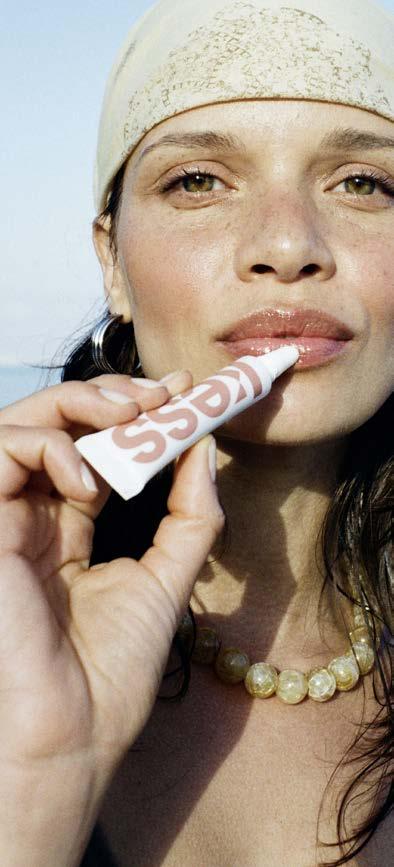
Kess stands for products that are intuitive and uncomplicated. Felix eckert, Marketing director Kess Berlin, knows that this meets the needs of today’s customers: “today’s customers are looking for products that do more than just look good. right from the start, our aim was to put substance before superficiality: intuitive use, smart multifunctionality, strong performance, packaged in a clear design.” Kess focuses on bricks-and-mortar retail as well as online: “cosmetics are an experience product. You want to feel whether something works. concept stores are the perfect environment for us. there you can meet entrepreneurs who curate with real passion. this closeness to the product is exactly what suits us.” @kessberlin
the brand vision of best-selling label Selected is more relevant than ever: a mix of minimalist style and exceptional artisanship inspired by the Scandinavian lifestyle of denmark. timeless collections in high-quality fabrics appeal to contemporary women with their everyday wearability and exude a natural effortlessness for special moments. Understated looks inspired by an essence of femininity with an eye on the environment, people, and sustainability: clothes we want to keep forever and wear again and again. Selected currently has locations in denmark, Belgium, the netherlands, Finland, and Sweden and has expansion plans for austria and germany. www.selected.com


Fashion-forward yet timeless, haveone appeals to women of all ages. romantic lace, ruffles, and scalloped edges are feminine elements that, when mixed with masculine oversized silhouettes, create a contemporary and exciting look. Founded in Bologna in 2019, haveone is on an international path to success and expansion and is now represented by agentur Schulzaco. “We are absolutely thrilled,” says agency owner Michael Schulz. “haveone casually implements trends without compromising on quality. What’s more, the average prices of 40 euros/wholesale price are a strong selling point.” Starting in mid-July, there will be a special capsule collection for germany, austria, and Switzerland featuring the fashion essence of the collection, which will already be delivered in mid-august. haveone_official, www.acomode.de
Minimalist design, conscientious production. Souleway bags meet the tastes of an urban demographic. the label was founded in 2017 by Flemming Kühl and hagen Streit with the aim of creating affordable weekenders with style. today, the range also includes backpacks, accessories and bags, produced fairly in a worshop in hamburg. Particularly popular? Bags made from vegan leather, using leftovers from olive oil production. Souleway’s retail prices vary between 49 and 389 euros. “Since the fall, we have shifted the focus from d2c to a combination of retail and online; the products have been very well received,” says an elated Flemming Kühl. www.souleway.com


destination haway, founded in 2020 by alessandra Bruno, combines high-quality sportswear materials such as jersey and fleece with innovative, elegant cuts. draped skirts, cut-out dresses and oversized hoodies meet a modern color palette from pistachio to ruby red, creating looks that can be worn from morning to night. instead of seasonal collections, destination haway focuses on a flexible, fluid design philosophy that celebrates freedom and individuality. the clothes tell stories of urbanity and self-confidence – perfect for anyone who wants to follow their own path while remaining stylish. destinationhaway.com
christian heikoop gets the utmost out of leather for his bags, with a luxurious vision, uncompromising quality, and astonishing lightness: “We let the material guide the form for our aesthetic,” says heikoop. the bags nestle softly against the body and have a calm design, “but i always try to incorporate a kind of energy and movement.” For the new collection, heikoop pushes the boundaries of what leather can do with woven bags and suede with a corduroy texture. the basis remains calfskin from one of the last dutch tanneries. Production takes place in italy with a focus on artisanship that impresses worldwide, including at Biffi, corso como, Vestibule, and Bergdorf goodman. www.maeden.nl



Fashion used to set the tone for culture. But somewhere between seasonal drops and perpetual discounting, it lost its rhythm. in its place, a new paradigm emerged – rooted in clarity, longevity and trust. Beauty is no longer about surface. Wellness is no longer fringe. Janine Knizia and chloé de ruffray explain how clear beauty and the longevity mindset have transformed what we value – and how retailers, designers and fashion brands can catch up.
interview: Stephan huber. illustration: alexander Wells
Janine, how was your launch? From what I’ve heard, it wasn’t exactly smooth sailing?
Chloé de Ruffray: Yes, tell us everything! Janine Knizia: Oh no, it was total chaos – in the most surreal way. I was in London picking up samples for our press trip, while Chloé was hosting this amazing Longevity Dinner in Paris, which I sadly had to miss. We had about a hundred skincare units and no idea how to get them into France in time. So, Renzo and I packed them in separate suitcases, booked a last-minute Ryanair flight, and pretended not to know each other at the airport – just to dodge customs.
You smuggled skincare?
Janine: Basically, yes. But it worked. We made it to the Côte d’Azur, and the press event went better than I could have imagined. I didn’t even pitch the brand to anyone. Retailers came to me – London, Dubai, New York. All unsolicited. That’s when I knew: this isn’t about marketing. It’s about trust. And trust, it turns out, is the most powerful currency in this new luxury world.
Chloé, while Janine was smuggling, you were hosting one of the most talked-about wellness events of the season – the Longevity Dinner in Paris. Tell us about that moment from your side.
Chloé: It was a beautiful evening – intimate, meaningful, and very intentional. We brought together people from different disciplines – longevity experts, biohackers, holistic aestheticians – and explored how health and beauty are evolving. It was less about products, more about perspective. That same week, Janine was launching something she’d been working on for years, and it felt like everything aligned. A shared mindset, expressed in different ways.
Let’s rewind a bit. You both came from fashion – what was the moment where it stopped making sense?
Janine: The turning point? Honestly, I think you’ll remember this too – it was that moment in the fashion industry when everything began to lose its value. When the rhythm broke. I remember a store in Düsseldorf discounting collections just six weeks after delivery. Winter goods were arriving in July. Retailers were nervous, always one foot on the panic button. Nothing felt considered anymore.
Chloé: Yes. It became noise. I was working in trend forecasting, doing Who’s Next and Première Classe
in Paris, Berlin... and suddenly it felt like we were documenting a machine that had lost its story. It was all about “what’s next?” – but without asking “why?” And without “why,” it all becomes hollow.
Janine: Exactly. Fashion used to be about people, emotion, creativity. But I found myself acting more like a therapist in showrooms than anything else. Trying to motivate buyers who were clearly burned out. And I was burned out too – physically, emotionally. That’s when I stepped away and started studying integrative nutrition. I thought it was just for me –but it became the beginning of everything.
So both of you reached a point where fashion felt empty – and you pivoted. But not into another industry, exactly. Into something broader. More human. What made wellness feel like the right path?
Janine: I didn’t have a grand plan. I was simply exhausted – mentally and physically. I signed up for a course in integrative nutrition, thinking it would help me feel better. But very quickly I realized: this is more than personal healing. This is a new way of thinking. A way to reconnect with what matters.
Chloé: My experience was similar. I was in love with fashion, but it wasn’t nourishing anymore. During the pandemic, everything slowed down. I launched a digital meditation and yoga club – and people responded immediately. There was a hunger for calm. For rituals. But the big shift came when I worked on a longevity study for a renowned luxury brand. I spoke to experts like Kayla Barnes and realized longevity isn’t just about age – it’s about how we live. How we show up. That was the moment I knew: This is what I want to explore deeply.
Janine: And that’s when we reconnected. We’d both left fashion, in different ways – but were suddenly orbiting the same ideas: health, beauty, clarity, longevity. Not just as products, but as philosophies.
Let’s dig into that philosophy. Fashion, for decades, has shaped desire. But it feels like longevity is now reshaping identity. Has it replaced fashion in terms of cultural relevance?
Janine: In many ways, yes. Fashion is built on change – on reinvention. And that’s beautiful, but also impermanent. With wellness and longevity, you’re dealing with something much more personal. You can’t change your face every season. You only have one body. One nervous system. You can’t throw them away when a new trend comes around. That’s when I realized: we need to educate people. We need to help them care more – not just consume differently. Chloé: And longevity isn’t just physical – it’s emotional, spiritual. For a long time, beauty was about fixing things. Covering flaws. Looking younger. But now, it’s about vitality. How much energy do you

have? How clearly do you think? How present do you feel? That shift – from aesthetics to presence – is everything. And it resonates deeply, especially now. Janine: I used to think beauty was about looking a certain way. Now I see it’s about feeling resilient. Stable. That glow people talk about? It’s not about makeup. It’s the result of sleep, micronutrients, hormonal balance, hydration. It’s radiance from within.
That’s what strikes me – this idea that wellness, and especially longevity, isn’t just another trend. It’s more permanent than fashion. Maybe even more desirable.
Chloé: Because it’s honest. It’s not seasonal. It’s about building a life that feels good, not just looks good. That’s why people connect with it on such a deep level.
Sounds like we’re talking about a new kind of status. Not based on logos or access – but on radiance. On health. Would you say that’s become the ultimate luxury?
Janine: Absolutely. We used to layer makeup to cover everything up. Now, glowing skin is the new status symbol. Because it can’t be faked. You can’t buy it overnight. It reflects how you live – how you sleep, eat, move, and breathe. That’s what people aspire to now: A kind of natural, lived-in wellness. And it’s also about credibility. Clean beauty got us started – removing toxins, parabens, silicones. That was necessary. But then we entered what I call the clear beauty era. Full transparency. Brands had to disclose sourcing, formulation, even lab results. PostCOVID, it wasn’t enough to just be clean – people wanted science. Clinicals. Data. Results. And if you couldn’t deliver that, you were out.
So it moved from “free from” to “here’s exactly what, why, and how.”
Janine: Exactly. That’s what I wanted to reflect in my own brand. No fluff, no white-labeling, no diluted formulas. It had to be fully developed, fully disclosed, and fully functional. Because today’s customer sees through everything.
Chloé: Yes. During COVID, people became incredibly educated. They started reading labels, comparing INCI lists, understanding ingredients like niacinamide, peptides, adaptogens. I call them sciencetellectuals – people who don’t just want pretty packaging. They want understanding. They want facts. They want to make informed decisions.
Janine: And if you meet them with honesty, they reward you with trust. When we launched the €1,000 biohacking skin kit, it sold out before a single product had shipped. No ads, no influencers – just community and trust.
And that’s the rarest commodity now.
Janine: Exactly. Trust takes years to build – and seconds to lose. That’s why I protect it with everything I do.
Let’s flip the script. What can fashion learn from all this – from clean beauty, longevity, and the trust economy you’ve both described?
Chloé: Fashion still sells desire – but often without depth. It rarely teaches. It rarely listens. People want to understand what they’re buying, who made it, why it matters. But too often, it’s just drops, noise, more noise.
Janine: In beauty, the most desired products are often the most niche. The best hand cream might come from a tiny lab in Switzerland. A life-changing supplement might be something you can only get from a naturopath in Zurich. That’s quiet luxury. Not about logos – but about knowledge. About access to something meaningful.
Chloé: And about honesty. If a fabric pills, say it. If a product won’t be back for six months, explain why. We’ve seen in beauty how honesty creates loyalty. That applies to fashion too. The customer is more intuitive than ever.
So it’s not about perfection. It’s about connection.
Janine: Exactly. Educate. Curate. Share your process. That’s how you stay relevant today. Trust isn’t something you post about – it’s something you prove. Again and again.
Let’s take this one step further. What does all of this mean for retail? Especially physical retail –which has been under pressure for years. Can it adapt to this cultural shift?
Chloé: It has to. But not by getting louder. The future of retail isn’t about more – it’s about meaning. People aren’t looking for transactions anymore. They’re looking for rituals. Emotional anchors. A reason to return. When you find a store that feels aligned with your life – your values – you don’t just shop there. You build a relationship.
Janine: Totally. That’s the question I keep asking: how do you turn a store into a ritual? Into something you want to return to – not just for a product, but for a feeling. For the trust, the energy, the curation. That’s where fashion can evolve. Less spectacle, more substance. Less seasonality, more soul. And it’s not just emotional – it’s economic. The values have shifted. Health, energy, hormonal balance – those are the new aspirations. That’s why we say health is the new status symbol. Because it’s rare, visible, and can’t be bought in one transaction. It requires commitment. That’s why people are moving from the
€50 impulse serum to the €500 protocol that actually changes something. Because today, transformation is luxury.
Chloé: And this isn’t theoretical. It’s already happening. I recently fell in love with a flower shop near my home. It’s small. Locally sourced. Thoughtfully curated. It’s not about quantity – it’s about presence. When you walk in, you feel seen. That’s the new luxury: To feel seen and understood.
Janine: I had a similar experience in Australia. Everyone kept telling me: “You have to go to Bangalow.” I’d never heard of it. But when we arrived, it was magic. A single street – 300 meters long – lined with independent shops. Beauty, food, lifestyle. All curated. No chains. No algorithms. Just real people with real taste. It reminded me of what retail used to be. Before spreadsheets and drops and must-haves. Before it became about clicks per minute.
So the future of retail might not be radically new. It might just be deeply human.
Chloé: Exactly. It’s not about reinventing everything – it’s about coming back to what works. Curation. Intuition. Emotional intelligence. That’s where small retailers have an edge. They can build community. They can respond with feeling, not formulas.
Janine: And customers are craving that. Not automation. Not perfection. But presence. A founder who’s visible. A team that cares. A story that unfolds slowly. That’s what turns a store into a ritual. That’s what creates meaning. And meaning – that’s the new exclusivity.
Janine, your line launched on your 40th birthday. That timing feels symbolic. Is this your legacy?
Janine: In a way, yes. But I also think of it as a beginning – one I want to protect. I made a conscious decision not to scale fast. Not to say yes to everyone. Every partner has to be 1,000% aligned. Every esthetician, every doctor, every store needs to understand the philosophy. It’s not about placement – it’s about purpose.
Chloé: That’s rare. And it’s powerful. In fashion, there’s so much pressure to perform instantly. To expand quickly. But what we see in wellness is the opposite: slowness as a strength. Selectivity as a signal of authenticity.
Janine: I’d rather go slowly and preserve the integrity of what I’ve built than grow fast and lose the connection. My audience knows this. They appreciate the wait. They value the restraint. That’s why the brand feels intimate – even as it grows.
It reminds me of how fashion used to work – fewer collections, deeper storytelling, more intention. Maybe we’re returning to that logic. Not because we have to. But because it feels better.
Chloé: And because it lasts. That’s the irony. Fast growth burns out. What’s slow, thoughtful, and grounded – that’s what truly scales.
To wrap up: If you could teach the fashion world just one thing from what you’ve learned – what would it be?
Chloé: Educate your customer. Don’t just show –explain. Don’t just sell – connect. We’re in a moment where people want more than a product. They want to be part of something they believe in.
Janine: Protect your integrity. Seriously. Trends will come and go, but trust? Trust is everything. It’s the most valuable luxury in the world – and the hardest to earn back once you’ve lost it.
Thank you both. This conversation wasn’t just about beauty or wellness. It was about how to build something that matters. Slowly, honestly –and with soul.
Chloé: Thank you. Let’s keep the dialogue going. Janine: Yes – but next time, no smuggling.

chloé de ruffray is a trend researcher, speaker, longevity expert, and culture analyst who is always on the lookout for the hidden trends that will shape tomorrow.
after studying social and political sciences at humboldt University in Berlin, she began her career at the international trend agency carlin creative in 2012. ever since, she has been consulting companies in europe, the Middle east, and china on cultural change, innovation, and future scenarios.
after 15 years in germany and Portugal, she now lives with her husband in France between Paris and the Loire Valley, where the urban heartbeat collides with rural depth. in addition to her work in trend research, chloé also teaches Kundalini yoga and meditation, always in search of a balance between inner knowledge and social movement.


1 After 15 years abroad in Germany and Portugal, Chloe now lives in France with her husband Valentin and daughter Antonia. � “Every time I travel alone, I love spending time in cafés to soak up the local atmosphere.” Here: The Moon Shell in Riyadh. 3 In our conversation, Chloe raves about her collaboration with an exceptional florist: “Every bouquet is an ode to life.” 4 Chloe’s happy place: A large table full of inspiring people, who she also likes to bring together at her home.


Janine Knizia embodies a new definition of luxury: holistic, conscious, forward-looking. as the founder of Muse & heroine, she is shaping the international beauty landscape with an approach that extends far beyond skincare – a symbiosis of science, herbal medicine, and spiritual thinking.
1 After her time in fashion, Janine felt tired – mentally and physically. So the exit followed, initially without a concrete plan: “I signed up for a course in integrative nutrition with the hope that it would help me feel better. But very quickly it became clear: this goes far beyond selfhealing. It’s a way of thinking, a new way of connecting with what really matters.” 2 It took eight years to turn the vision into reality: Janine Knizia Haute Regenerative Skincare. 3 Founder, CEO – and dog mom. 2 3 1
initially rooted in the fashion world, Janine has, over the years, evolved into an expert in active ingredient science and longevity. She set new standards in 2017 with the launch of europe’s first clean Beauty showroom in Paris.
today, she is followed by a global community and a generation that embraces self-care not as a trend, but as a mindset. Janine herself pursues an uncompromising mission to decipher the science of skin longevity through skincare, nutrition, technology, herbal medicine, mindfulness, and epigenetics. her company is 100% independent and focuses on results rather than marketing.
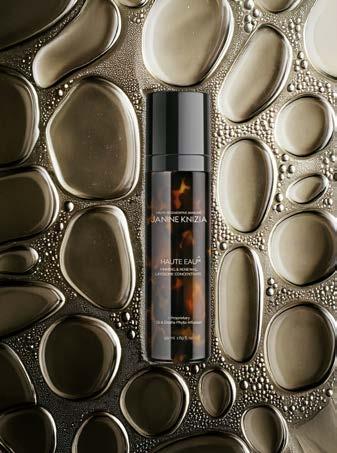


“For
us, renewal is a subtle process.”
Franco Vivaldi, consultant at Astorflex
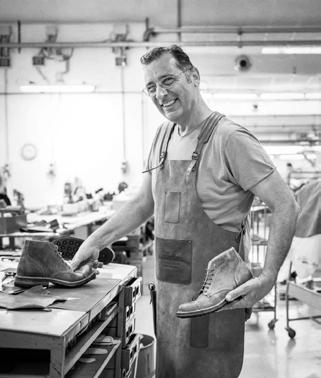
Astorflex has been making shoes for over six generations. What does longevity mean to you – especially in a market that is driven by speed?
Franco Vivaldi, Consultant at Astorflex: Today’s market is fast-moving and tends to wear out products much faster than in the past. However, what really endures from any project are the values, roots and passions from which it was born. Consumer-driven marketing makes things go out of fashion quickly. For us, however, renewal is a subtle process – one that brings small, often invisible improvements while remaining true to the essence of the product. This is exactly what Astorflex has done throughout its 200-year history: Passing on the same values and passions from generation to generation to make comfortable shoes from natural materials and using traditional methods –always evolving, but never losing its core. Classic silhouettes, but always changing; what defines the Astorflex look in 2025?
While staying true to our values of comfort and naturality, we have expanded our range to include lighter materials, such as soft, thin leathers, braided leather options and soles not only in crêpe or rubber but also in leather – again, a natural choice. What makes a good retail partnership for you and what can retailers expect when working with Astorflex?
Retailers expect one thing above all else from a manufacturer: a good product. That is the foundation. But Astorflex has always believed that this must go hand in hand with a strong, reliable service. Our NOS program, for example, is the key to long-term partnerships. It allows our partners to rely on constant availability of our core models. And because we are small manufacturers, not a distribution company, we can react quickly to market needs. We can reproduce missing colors, materials or sizes in a short time because we produce everything ourselves and locally. I think that’s a key difference between companies that actually make their own products, and those that just sell them. www.astorflex.it


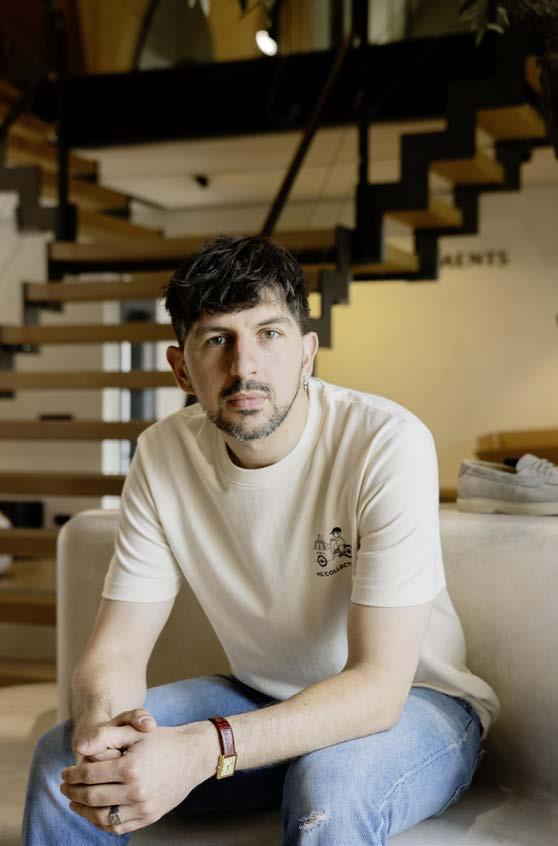

at a time when fashion is gaining pace and sustainability is deteriorating to a mere buzzword, Mason garments demonstrates that true relevance comes from artisanship and distinct values. ceo Soufyan el hammouti provides a look behind the scene.
interview: Janaina engelmann-Brothánek.
How does Mason Garments maintain relevance?
Soufyan el Hammouti, CEO of Mason Garments: We are not interested in quick trends or short-term success, but in honest craftsmanship. We remain independent, without investors. This affords us the freedom to focus on design, quality, and genuine partnerships. Each model is created in close collaboration with small family-run manufacturers in Italy. A silhouette can be copied, but our relationships cannot. To us, relevance involves creating a strong product with the right partners.
Does that mean the collection is a form of dialogue?
Yes, our partners in Italy are family businesses, often extending back generations. This experience shapes our design process. Around 150 models are created each season – too many, to be honest. (laughs) This creative exchange is what drives us. All our shoes are manufactured using the Sacchetto method – an elaborate, flexible construction technique with a particularly good fit – and our prices remain fair. Between 250 and 300 Euros is very competitive for truly Italian shoes.
The bestseller?
The Tia – it is the heart of the brand. For our founder Rendi Aditia, it was the first model where everything came together. Retailers appreciate its timeless contours.
What comes next?
We are currently launching our first women’s line – an exciting challenge! In Germany, we are expanding in partnership with Agentur Schwarte, but always responsibly. And soon Mason Garments will be launching its own ice cream in cooperation with one of Amsterdam’s most famous gelaterias.



“THIS
STATEMENT!”
Ten years of Goldgarn – how do you celebrate an anniversary without just looking back?
Kerem Özcelik, Founder Goldgarn: It was clear to us that this anniversary needed a statement. That’s why, together with ISKO, we developed a capsule collection that gets to the heart of our understanding of modern denim culture – responsible, aesthetic and technologically innovative. The fabrics made from recycled cotton and polyester fibers are super high-quality with a great feel and are extremely durable. This is Denim 2025 – exactly the direction we want to go in.
Goldgarn is clearly positioned at the interface between fashion, art and responsibility. What does that mean in concrete terms? For us, denim is never just a product. It’s about attitude and how you make things visible. For the anniversary, we are working with Carolin Wanitzek, who is designing a set made from recycled denim that looks like an underwater landscape. At the same time, there is a charity collaboration with Mannheim-based artist
Marilena Hamm, alias Scribblezone: her marine motifs appear on T-shirts, the proceeds of which finance water projects. This combination of aesthetics, regionality and global responsibility is what Goldgarn stands for today.
And what remains the most important lesson after ten years of brand development? Authenticity. We started in Mannheim and that was never just a place for us, but a mindset. We didn’t want to be a brand that constantly chases trends, but one that stays true to itself and grows in the process. Today, we sell in over 600 stores in Europe, mainly family-run specialty stores and independent multi-brand stores. And I think that’s precisely because we are genuine, and we take the responsibility that comes with success seriously.
www.goldgarndenim.de
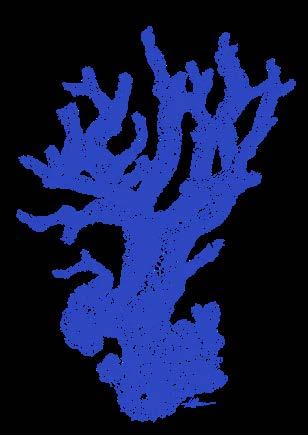
Alohas
Founded in 2015 by Alejandro Porras Martorell, Alohas now represents a combination of modern design, sustainable manufacturing methods, and an on-demand business model. The latter was transferred to wholesale in the DACH region in collaboration with the Modeist sales agency – with steadily growing success. “I describe Alohas as a total look collection for shoes,” says Timothy Hoferer of Modeist. “It is so broad that we can serve both volume customers and very selective formats.” Both offline and online retailers benefit from the high following and awareness among young target groups. “You no longer have to establish the brand first,” emphasizes Hoferer. The first mono-stores in major cities such as Amsterdam and New York are adding even more brand power. Hoferer: “The combination of an innovative business model, sustainability, a sensible value-for-money ratio, and style fascinates customers.” www.alohas.com, www.modeist.com



Myths/White Sand
“WE
gdM Srl has quietly yet systematically established its labels Myths and White Sand among the most exciting players in the premium segment. Sales have quadrupled over the last six years, and the company is now represented in some 500 stores worldwide. the Bernardi family is now sending a clear message with a new headquarters covering 3,000 square meters in San Mauro Pascoli, italy. growth comes with attitude and relevance starts with the product. an interview with brothers Simone and giovanni.
text: Janaina engelmann-Brothánek. Photos: gdM Srl
The last few years have been a roaring success, bucking the industry trend. What was the key to maintaining relevance?
Simone Bernardi, Co-CEO of GDM Srl: We achieved growth when many others were losing ground, because we never tried to cater for everyone. Two brands, two voices: Myths represents modern, timeless elegance, while White Sand is more urban and fashionable –more street, more silhouette, more now. Giovanni Bernardi, Co-CEO of GDM Srl: Relevance is not created by volume, but by a product that is on point – at the right time, for the right target group. That was our focus: No compromises in fabric development and pants design.
Simone Bernardi: Exactly. We do not equate relevance with trends, but with authenticity. Our motto is Research Attitude, because we base our thinking on the material. Ice Cotton, for example, is already a bestseller. Ice Wool will follow this season – the same philosophy, in wool.


Your expertise in pants manufacturing certainly served you well. How did the brand development come about?
Simone Bernardi: We were originally a supplier to a pantalonificio, founded in 1981 with a focus on Bermudas. When I became involved at the end of the 1990s, we started evolving gradually. Myths was our first step beyond contract manufacturing, featuring our own signature. White Sand followed later.
Giovanni Bernardi: White Sand was our creative outlet. We wished to demonstrate that Italian craftsmanship can also be bold and light – with volume, techno fabrics, new silhouettes.
How much growth have you experienced?
Giovanni Bernardi: Seven years ago, we generated a turnover of three million Euros, today we reach roughly 13.5 million – and that without external capital or commission sales. Everything is based on real orders and genuine trust. Our new headquarters of 3,000 square
meters was the next logical step; we had run out of space in the old HQ. (laughs)
Simone Bernardi: We supply around 500 stores – some 200 per brand located abroad. Customers such as Lodenfrey, Gruener, and Braun Hamburg prove that the product speaks for itself as long as it is convincing. What makes us particularly proud is that each store has its own character, and we get to be part of it.
You executed a generational transition without any drama. How did you accomplish that?
Simone Bernardi: Our father was never authoritarian. He entrusted us with responsibility early on and allowed us to make mistakes. That is how you learn to manage a company steadily.
Giovanni Bernardi: To us, leadership equals trust. No ego, no micromanagement. I am responsible for White Sand and manufacturing, while Simone handles Myths and sales. Our
sister Francesca is in controlling, occasionally assisted by our father Luciano. Yet we allow each other space. That works well.
What are your next steps?
Giovanni Bernardi: Continue to internationalize, but in a selective manner. We have no ambition to be everywhere, only where it fits. Simone Bernardi: We will continue to invest in fabrics. I consider our new machine-washable vintage wool – 100 percent natural fiber, no-iron, zero care – to be a powerful statement.
“relevance is not created by volume, but by a product that is on point – at the right time, for the right target group.”

The contemporary jewelry brand was founded by Vanessa Fischer and combines timeless design with high-quality natural materials such as gemstones, gold, silver, and freshwater pearls. Each piece is handmade and tells a story – always in harmony with humanity and nature. With Laluma, the founder pursues her vision of rethinking gemstones and transforming them into real statements. Instead of following fast-moving trends, she focuses on creating long-lasting pieces with emotional value. The focus is on the conscious use of resources, female empowerment, and a new definition of contemporary aesthetics. @lalumachains
Ikat
Founder Isabella Stadler’s label combines sustainable fashion with artisanship and traditional ikat weaving techniques from Uzbekistan. Most of the collection is made in Germany. Small manufacturers weave the ikat fabrics by hand in the Fergana Valley in Uzbekistan, following traditions that date back thousands of years. The dyes are environmentally friendly, and the trade is ethical. Elegantly crafted Suzani embroidery appears on fine silk, reflecting the richness of detail and depth of traditional artisanship. Lampas fabrics from San Leucio in Italy add further accents and lend the collection additional elegance with their stylish Louis XVI design. www.belleikat.de


Breaking away from the classic collection principle, Lisa Zaiser’s brand presents a clear vision with an emotionally charged line of customizable jewelry and high-quality essentials made from recycled gold, fairly sourced gemstones, and certified lab-grown diamonds. Whether filigree necklaces, delicate bracelets, or simple earrings, the minimalist jewelry impresses with its timeless design and long-lasting quality. Highlights include birthstone necklaces with sparkling colored gemstones that give each month a personal meaning, as well as the letter collection with elegant letter pendants and matching chains. New to the range: Custom-made rings. www.deardarling.berlin
Avonté
Shocked by a Portuguese production facility filled to the ceiling with unused rolls of fabric, Pia Egelkraut and Marlene Marx decided to launch their sustainable sleep and loungewear brand in the summer of 2023. Avonté uses only salvaged, high-quality fabrics for its products, which are produced in close collaboration with long-standing partners in Portugal. This season, for the first time, the brand is using fine silk satin. In addition to Lyocell, Avonté also uses classic cotton woven fabrics such as poplin and summery seersucker. With designs for all generations, they combine style, comfort, and sustainability. The nightgown costs 139 Euros, and pajama sets are available starting at 160 Euros. www.avonte.de


The bags by Berlin label Rayas Collective are made in El Salvador by a small, women-led team of experienced craftswomen. They are made from lightweight, UV-resistant, hand-woven HDPE synthetic material. New to the range is the Baguette Bag for 130 Euros, a compact all-rounder – elegant and handy for the evening, but with enough space for an iPad or A4 documents. A removable zippered pocket made from deadstock nylon protects important essentials. The Tote Bag for 135 Euros combines lightness and everyday practicality and, despite its slim design, offers enough space for a laptop or sportswear. www.rayascollective.com
Created by Lore Heyman and Geoffrey Gillon, Nous is defined by its calm, confident aesthetic and rooted in true values: Mindfulness, clarity, and craft.
Nous collections feature dresses, blouses, and trousers for women – effortless, refined silhouettes in natural fabrics like silk, cotton, Tencel, and wool. Iconic hand-dyeing techniques and traditional artisanship give each piece a unique character.
Designed for women who want to feel like themselves – authentic, sensual, never overstyled – Nous is perfect for high-end specialty retailers who curate with purpose. The brand is not driven by volume or trends, but by connection. Each garment is an invitation to slow down and rediscover fashion as a tactile, emotional experience. Starting this season, Nous is set to take off in Germany and Austria with Antones by Sarah Freise. www.nous-antwerp.com

California-based down manufacturer Allied and Japanese luxury outerwear manufacturer MN Inter-Fashion have jointly developed an ultra-light jacket collection that, following its successful launch in Asia, is now also available in Europe. Designed and manufactured in Japan, the line embodies an urban look combined with the latest technical materials from the sports sector. The outer material is from Pertex and the RDS-certified down for the ExpeDRY insulation with 1,000 fill power is from Allied. Retail prices for the vests, coats, and jackets range from 300 to 1800 Euros. The color spectrum ranges from black and white to navy and anthracite to khaki. www.alliedfeather.com


Japanese brand Teclor has over 60 years of experience in manufacturing suits. Crafted with meticulous attention to detail, designer Takeshi Morisaki focuses on his timeless total-look collections, combining a high level of expertise in fabric technology with his own distinctive design language. His interpretation of simplicity in shapes and proportions is evident in sculptural yet soft silhouettes combined with architectural lines. The brand is gender-neutral, effortlessly combining utilitarian aesthetics with the essence of tailoring. www.teclor.jp
Since the mid-1990s, this cult brand from Tokyo has been impressing every season with its expertise in traditional dyeing and construction techniques. “We strive to produce comfortable clothing and other everyday items that will bring joy for a lifetime,” say the creators. The most important features of the collection are the use of natural indigo, elaborate handcrafting techniques made in Japan, a distinctive design signature, and patina. MBS in Paris is responsible for distribution in Europe. Highlights each season include not only pants, but also linen vests and patchwork overshirts. www.bluebluejapan.com


The Leipzig-based designer combines an exciting vision of colors and fabric combinations that turn everyday looks into real eye-catchers without drifting into extravagant trends. The garments are produced in Eibenstock, Saxony, from high-quality, certified materials such as Tencel and organic cotton. The target audience are career women who are looking for outfits for every occasion, whether at home or traveling, and who value fair production and long-lasting quality. “We create pieces that can be integrated harmoniously into everyday life, but always have that certain something – perfect for anyone looking for fashion that is both functional and stylish,” explains Maria Seifert. www.mariaseifert.com
Narli is a total look collection that impresses thanks to its laid-back modernity and product expertise: with high-quality materials and loving details such as embroidery, special buttons and tailoring solutions that leave the average behind. No compromises are made, as demonstrated by the use of Cariaggi cashmere for luxurious knitwear.
“We go all out, and our customers can feel that,” says founder Erol Narli, who has his products made in his own atelier in Istanbul. With an average purchase price of 80 Euros, hardly any returns and reliable delivery, Narli is a reliable partner for specialist retailers. www.narli-collection.de


The combination of functional design, traditional materials and minimalist aesthetics makes Itti’s bags, wallets, and accessories versatile everyday companions. They are mainly manufactured in downtown Tokyo by specialists who have gained experience in long-established companies and now work independently. Designer Wataru Aoki is not only a graduate of Musashino Art University, but also the grandson of the famous Showa-era calligrapher Koryu Aoki. After establishing a renowned bag brand, he left that company and founded Itti in 2017. www.itti-tokyo.jp

Équipement de Vie
These technically sophisticated shoes were developed in collaboration with Captain Nat Lemieux, an experienced American sailor. All models are quick-drying, breathable, and feature integrated drainage channels. The soles are made from a patented, non-slip, non-marking compound that ensures safety, maximum traction in wet conditions, and stability, not only on the deck of a boat. The sneakers are manufactured in China by a Taiwanese-Chinese joint venture. New models were presented at Pitti Uomo in Florence for spring/summer 2026. Retail prices range from 165 to 200 Euros. There is no agency for Germany, Austria, and Switzerland yet. www.equipementdevie.com
Elina Cima’s brand from Riga stands for handmade, natural scented candles, diffusers, and skin care products inspired by Nordic nature. Made from soy and rapeseed wax, the products contain the essence of forests and meadows. The ingredients are Cosmos certified. The company attaches great importance to artisanship: from the selection of natural raw materials to the careful placement of moss, flowers, and herbs in each candle to sustainable packaging. Retail prices range from 18 to 83 Euros. The stores in Riga, Berlin and Barcelona also offer creative workshops on candle making, perfume creation, and natural cosmetics. www.themunio.com


The Californian brand has been completely climate neutral since 2021 and consistently uses sustainable materials for its activewear in sizes XS to 6X. Over 60 percent of the fabrics and all packaging are made from recycled materials. Together with ThredUp, Fabletics promotes the circular economy and avoids waste in the textile industry. In addition, the label is committed to fair wages, safe working conditions, and transparent supply chains, which are monitored by independent audits. In addition to its environmental commitment, Fabletics invests in programs for equality, education, and health to drive positive social change. www.fabletics.de
The new label at Modeist brings summer flair to retail: De Siena combines Italian design with sustainable artisanship. Raffia, hand-embroidered details and natural colors characterize the look of the slippers, loafers or sandals – each pair is made by hand in over four hours. Particularly exciting for individual store concepts, especially in resort destinations: from eleven pairs upwards, the brand offers personalized designs, for example with place names or desired motifs. The brand is already perfectly positioned with 450 international stores, and now the aim is to grow qualitatively with Modeist in the D-A-CH region. www.modeist.com


Quite Luxury is a new label entering the market that is based on the idea of a capsule wardrobe in which everything can be combined. 30 pieces in high-quality jersey at prices in the lower premium segment. Pants, shirts and coats are also in the mid-price segment. They are produced by FDH Agency, which has its own structures in China and will also ship on time in February. Staple styles that are often worn, easily complete the wardrobe and can be adapted to the occasion. Launched via Modeist in D-A-CH, with the aim of expanding in the future. www.modeist.com
With Anonym Apparel, the Austrian agency Room with a View is expanding its portfolio by adding a label that deliberately focuses on substance rather than surface. Originating in France and rooted in Peru, the brand combines European design with traditional artisanship and a clear commitment to sustainable production. It works in long-standing partnerships with local manufacturers who process Pima cotton – also known as the silk of the Andes –and alpaca into high-quality essentials. The collections stand for timeless silhouettes, vibrant colors and a feel that makes quality tangible. Retail prices start at 66 Euros. www.anonymapparel.com, roomwithaview.at

A low-key dialogue between eras – the spring/summer 2026 pre-collection by AVANT TOI fluctuates between the refined romanticism of the 19th century and the free, imprecise language of today. This tension gives rise to silhouettes that interweave past and present to create something timeless.
Delicate chiffon layers, muted colors, softly flowing drapes – inspired by historical garments, reinterpreted in breezy dresses, soft shirts, and light skirts. Details such as covered buttons, raw edges, metallic finishes, and deliberately irregular surfaces lend the pieces a sense of depth. Each surface – hand-painted, dyed, crinkled - recounts movement, transformation, and a look inwards. The color palette alternates between vanilla, wisteria, dusty blue, and earthy tones such as fango and fiume – delicate and powerful at the same time. Stretch suede, silk scarves, ties, and obi belts complete the look.




WITH SMARTLEISURE, SAVE THE DUCK IS CONSISTENTLY DEVELOPING INTO A TOTAL LOOK LABEL.
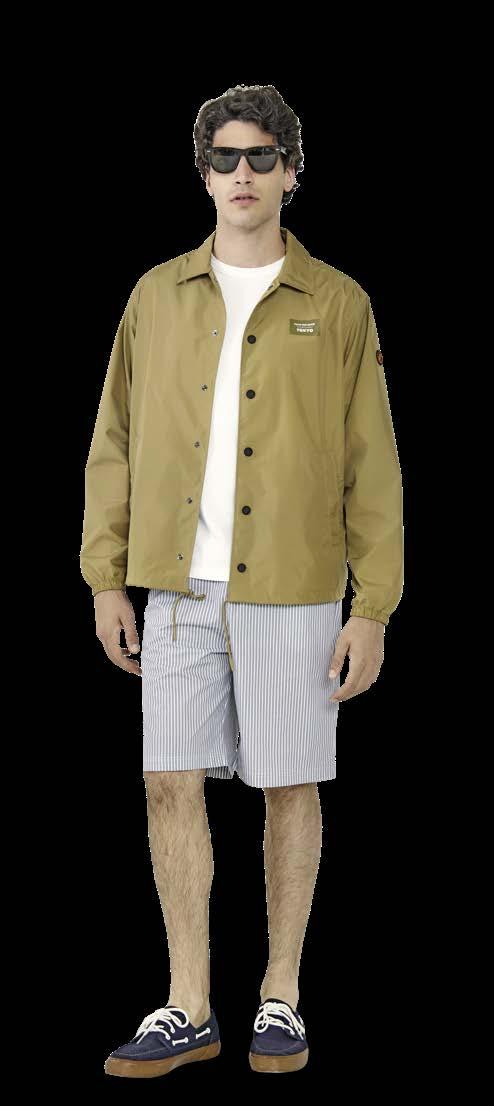

With the spring/summer 2026 collection, SAVE THE DUCK once again under lines what the label stands for: progressive outerwear, animal-free, technically sophisticated and stylishly on point. The Smartleisure line caters to urban nomads who move effortlessly between business and leisure. Lightweight, recycled materials, clear cuts and uncomplicated care make them the perfect companion for dynamic daily routines. To reduce water consumption in the interests of sustainability, recycled fibers are used instead of cotton. In collabo ration with Japanese designer Satoshi Yamane, new standards are being set with the enhanced Pro-Tech line – minimalist design meets maximum performance. Wind and weather protection are guaranteed without compromising on wearing comfort. Clever accessories including ultra-lightweight bags and sun hats with a modern twist complete the range.


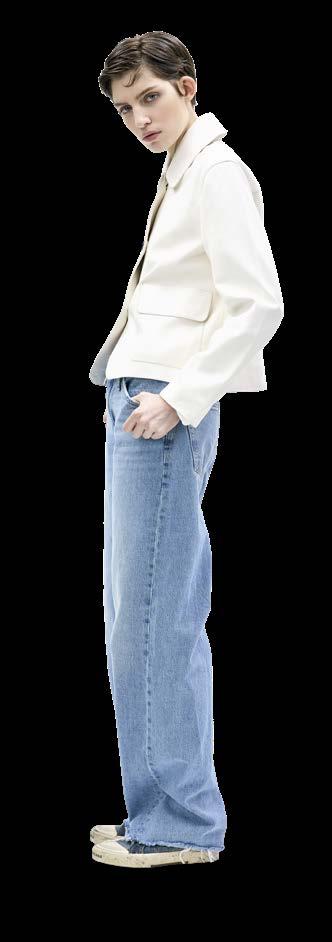

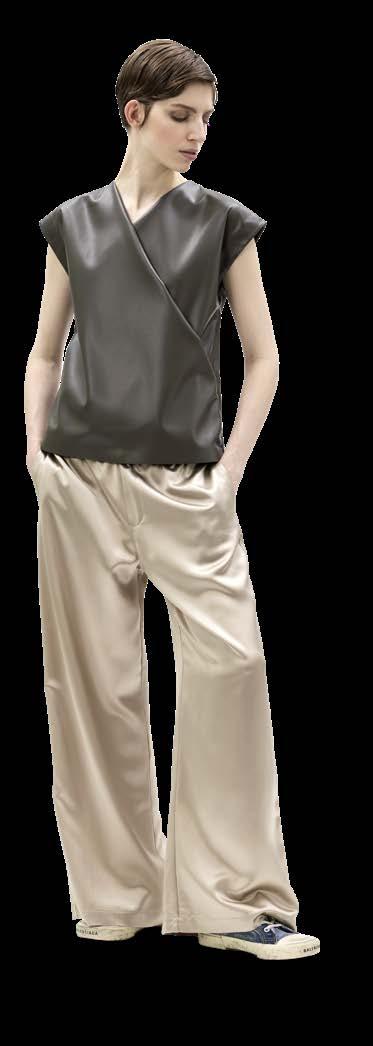
The success of the fall/winter collection is an incentive: has performed as a top label at the Modeist agency and has won numerous well-known new customers, department stores and boutiques alike. Pride to Be is now not only bringing out winter highlights, but is also significantly expanding its range for spring/summer with a fully-fledged program for the November 2025 and January 2026 delivery dates.
The focus: new materials and complete summer looks. Wafer-thin faux leather in soft shades meets trendy satin pieces that are perfect for layering. In addition, buttery-soft vintage leather looks in blazers, skirts, jackets and dresses as well as a suede range with new jacket shapes and it-pieces.
“We wanted to meet our partners’ desire for a serious summer range that goes beyond the classic transitional jacket,” says Marion Hoferer, Creative Director of Pride to Be. This is achieved with the usual reasonable price-performance ratio, a consistently 3.0 calculation and the option of working as a private label on request.
Pride to Be remains true to its strategy: exclusively for independent specialist retailers, no online sales, no major suppliers. This makes the range not only special, but also price-stable. @pridetobe

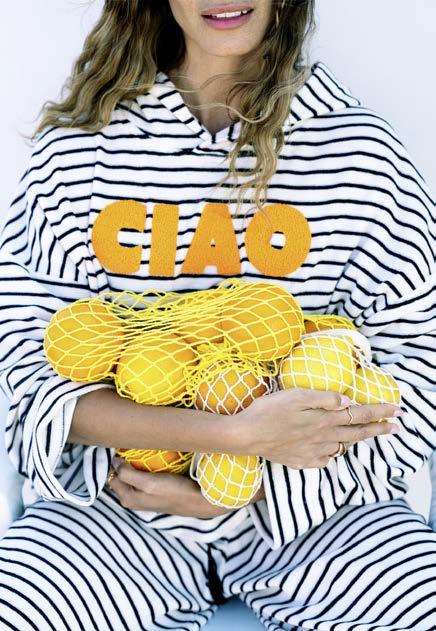
In the 2026 summer collection from YIPPIE HIPPIE, Mediterranean lightness meets urban boho chic: “Our styles are designed to carry the feeling of summer on the skin; airy, relaxed and full of energy,” says Christiane Braun Prettin, founder of Yippie Hippie.
The colors? A firework display of lime, turquoise, emerald, rosé and pink. Whether bold or sun-bleached –they appear in bold stripes, floral prints or as surprising contrasts.
In addition to flowing dresses, blouses and skirts, light cotton, soft viscose crêpe and jersey make a statement. “We love details, be it crochet accents, terrycloth with a statement print or our new velvet in a batik look,” says Braun Prettin. For a summer evening with a wow effect: Lurex materials in sand tones with a gold shimmer. A strong partner returns for the start of the season.
Agentur Heudecker is taking over sales in NRW, Hesse and Rhineland-Palatinate. At the same time, Yippie Hippie is growing internationally and is now represented in the UK and Ireland. www.yippiehippie.de

At a time when the outside world is getting louder, the longing for inner silence is growing. Biophilia is becoming a design principle. At the same time, Tokyo shows how spaces are opening up in-midst pulsating urbanity that allow for contemplation. Where technology meets nature, there is no contradiction, but a new harmony.


Specialty retail has figuratively arrived in the wellness era. United under the term biophilia, the desire for tranquility, peace, and inner growth is expressed in designs inspired by nature and a feel-good atmosphere. Being prevails over having. The store embodies a psychosocial system that appeals to all senses. It’s about more than just green plants on the sales floor. Here, artificial intelligence is combined with natural intelligence, and conceptual elements such as constructing different climate zones within a single room, fragrances, and immersive effects play a major role. From a mega mall project in Japan to a small lifestyle store in Kuwait, nature is involved as a style icon, muse, and inexhaustible source of inspiration. Text: Isabel Faiss. Photos: Stores
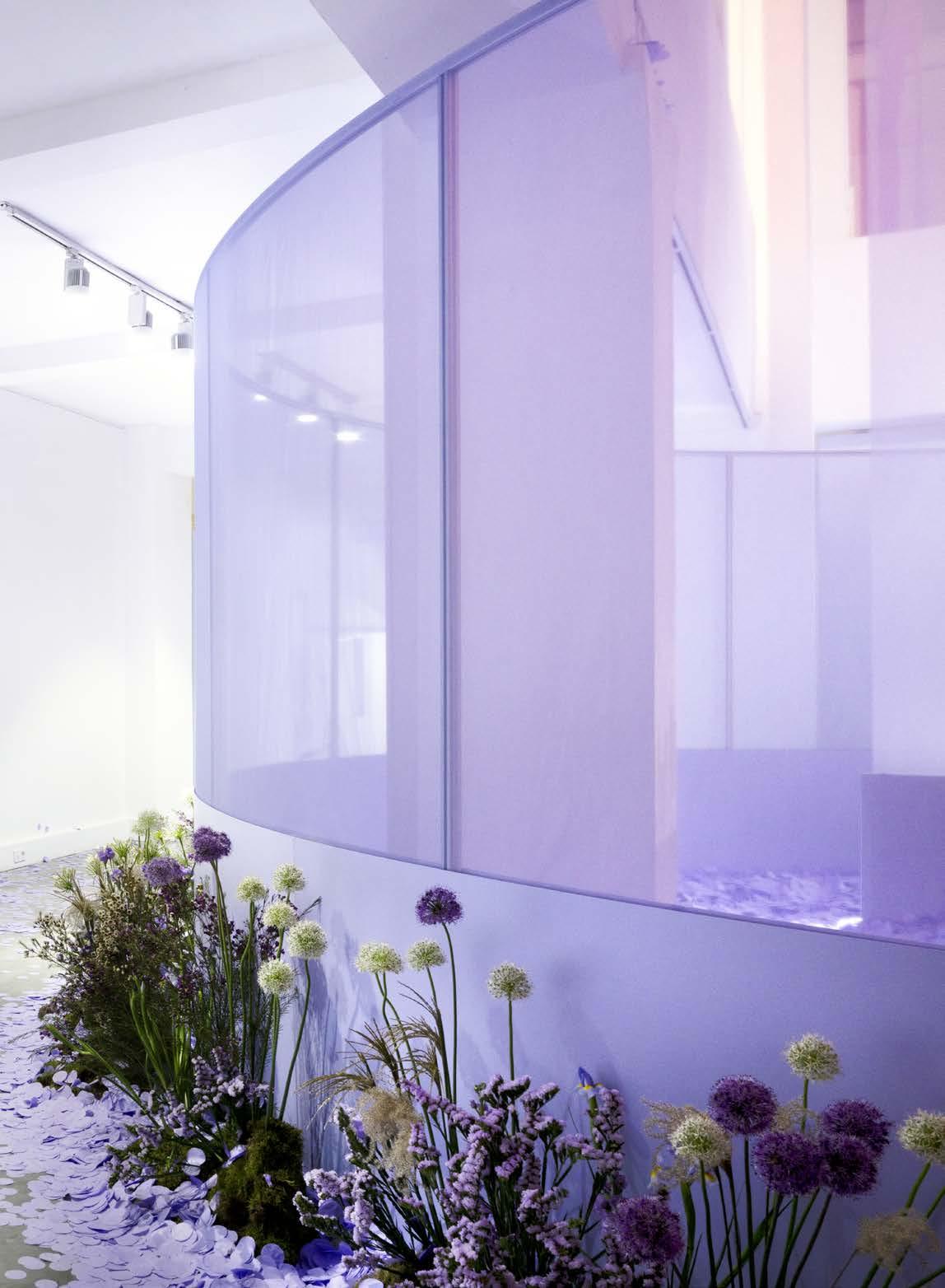
Natural intelligence boosted with AI: for the launch of their fragrance Fleur, Glossier collaborated with Random Studio last March to create this immersive pop-up store in Paris. At its heart is an interactive pavilion that uses AI technology and sensors to respond in real time to guests’ facial expressions, emotions, and body language by projecting corresponding poetry, colors, and content onto the surfaces.

Like in a dream: poetry and nature merge into a multisensory experience. Random Studio created an AI-controlled, living flower field for Glossier in Paris.

The Glossier/Paris
at Galerie Joseph in Paris’s le marais district, random Studio staged a nature-inspired, aI-controlled pop-up store for Glossier. Surrounded by pastel-colored flowers and petals, they created an imaginary field of flowers. True to the motto of the launch event, The Wonder of You, not only did the digital projections in the three themed pavilions in the gallery adapt to the presence of each visitor by displaying aI-selected poetry quotes, but petals also moved in sync with what was happening inside the rooms.


Spacemen Studio staged this Trove store in Kuala lumpur like a secret hidden beneath the waves of a secluded bay, revealing itself in all its glory only during brief moments of low tide. The products are arranged on linear, wave-shaped shelves that not only embody the movement of waves, but also the interior of a cave. The unconventional room concept is designed to relax visitors, transport them away from everyday life, and inspire them to go on their own journey of discovery through this natural spectacle.

Aila/Kuwait
Inspired by nature and its constant change, Saccal design House created an interior concept for fashion and lifestyle store aila in Kuwait that extends from the ceiling to the floor and, like an ecosystem, is extremely adaptable. like vines, the shelving systems can be individually rearranged at any time, sometimes to emphasize the impressive overall height of the room, sometimes to create space for events. The calm and deceleration, which is also reflected in the color scheme, is intended to relax and invite visitors to linger.


Amiko Gelato/Barcelona
Used as the source of all life: the literal life-giver of this art deco ice cream parlor in a miami Beach style in downtown Barcelona draws on the elemental power of nature. as a stylistic element for color and form and a symbol of the impressive life energy of an oasis in the middle of the urban desert. The Spanish design studio masquespacio draws inspiration from nature in almost all of its projects. always with a special twist, as in the case of amiko Gelato, where it clashes with art deco and striking materials such as ceramic and stone. The highlight of the store is a lighting concept that changes throughout the day, mimicking the actual lighting mood in nature as the day progresses.


Nuna x Liberty/London
Flower romance spreads across the entire eight meters of the oxford Street store window with XXl blooms and fabric wallpaper. For a campaign with baby brand nuna, the famous liberty department store window display was temporarily transformed into a floral fairy tale land that conveyed not only the harmony of nature but also the power of human connection. For this design concept, liganova used nature as an emotional medium that, under the title Fantasy land, combines boundless, childlike imagination with the purity, authenticity, and reliability of mother nature.
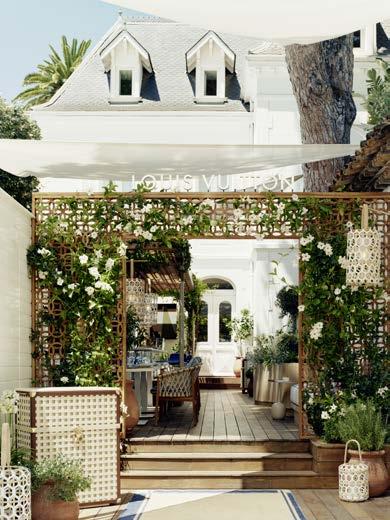
The most impressive example of a liaison between nature and gastronomic pleasure is currently the louis Vuitton restaurant in the exclusive Hotel White 1921 in Saint-Tropez. For this summer, the team has recruited two renowned michelin-starred chefs, arnaud donckele and maxime Frédéric, who will be creating the menu throughout the season. The entire ambience of the restaurant is in the style of louis Vuitton’s By The Pool collection, with elements from the in-house objets nomades line, such as lanterns by Zanellato/Bortotto, featured in the interior. artistic origami flowers by ateliers oï and green walls complete the small, private-feeling idyll.

Biophilic design with a wink: Spacemen lets an abstract mammoth tree trunk grow through the store.
Let’s Pollinate/Amsterdam
... as a social program? This was precisely the approach taken by amsterdam and Paris-based agency random Studio with its innovative concept let’s Pollinate in amsterdam in march 2024. The primary goal was to use the possibilities of technology and aI to bring people together in a physical place and create something new together – in this case, a Garden of eden with aI-generated plant species. This was made possible by a combination of ChatGPT and dall-e. By scanning a Qr code on their smartphones, guests could create their own plants, which could then be “planted” in a community garden on a large screen. let’s Pollinate was one of the most successful projects of living lab, a division of random Studio headed by director roel Wouters.


New plants designed via smartphone: Curiosity meets nature and AI.

Urban Bloom is the name given by design agency Spacemen to its concept for a new series of experimental brand stores for bag manufacturer Braun Buffel. The idea premiered in 2022 with this store in the malaysian city of Putrajaya in the form of an abstract, living tree as the centerpiece. originally the center of the natural forest ecosystem, it was symbolically transplanted here to become the heart of the experimental retail approach pursued by Urban Bloom. In contrast, the store is designed like a design laboratory, with the living tree growing and constantly changing at its center.
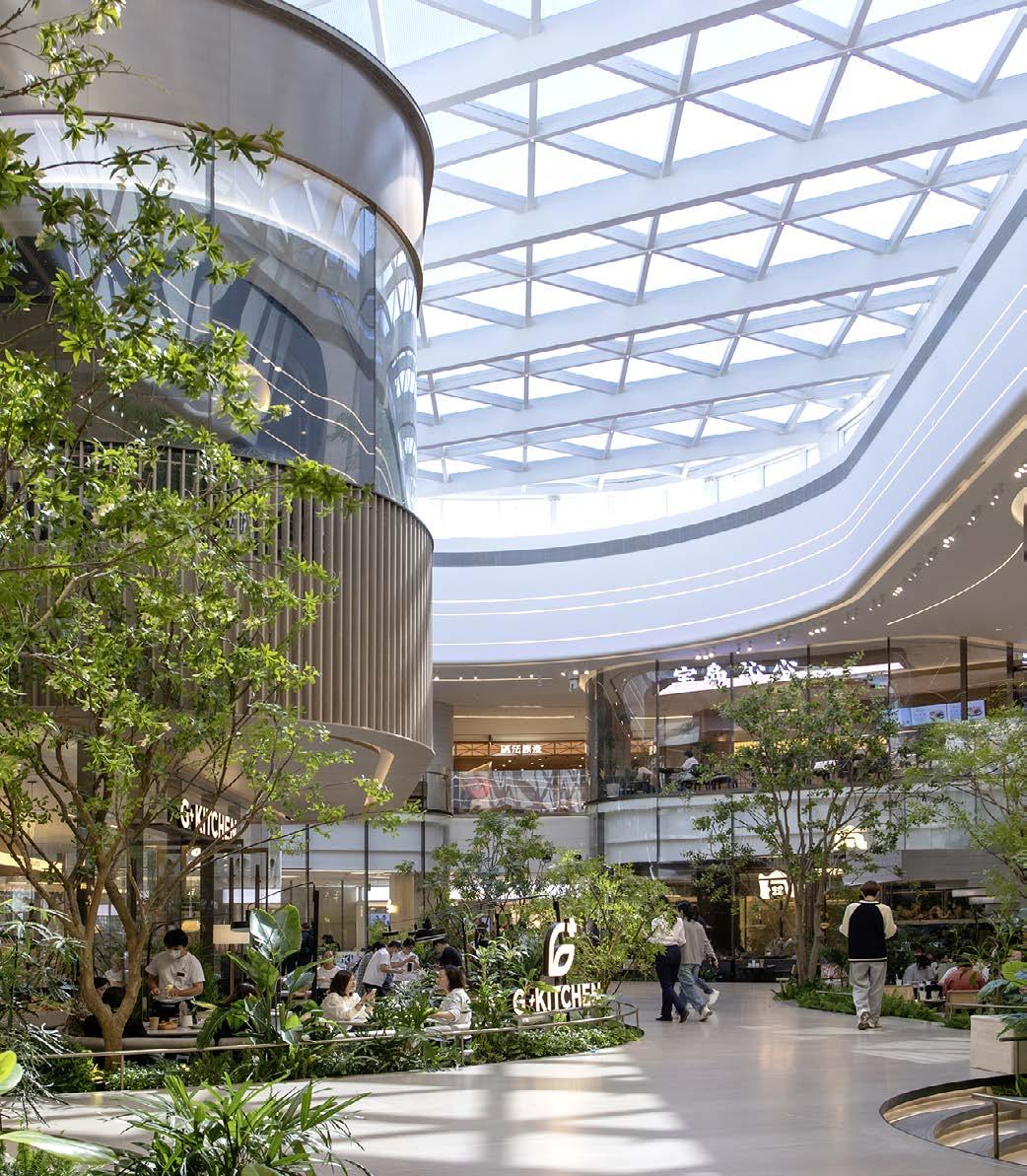
Recreation and relaxation as a new approach in the Chinese retail landscape: Paradise Walk, a mega mall in Suzhou, is setting new standards.
Xiangcheng Paradise Walk/Suzhou
For the Xiangcheng Paradise Walk shopping mall in Suzhou, China, arizon design studio created an overall concept spanning the entire 300 meters of the building and all seven floors under the motto “dancing Waters in Forested Streams.” Flooded with light, defined by natural forms and inspired by the various shapes, reflections and surfaces of water, this mall, which opened in 2024, sets a new benchmark for biophilia on a large scale. at its heart is moon Island, an urban island covering over 3,000 square meters on levels 5 and 6. as a center for social interaction, this space is not about consumption, but about the luxury of taking a break – a revolutionary approach for Chinese malls. Paradise Walks are popping up in more and more Chinese cities, but with this one, nationwide mall operator longfor Group is setting a new standard, including in terms of sustainability, which plays a major role in the overall concept in Suzhou.
originally, the city of osaka had the lowest proportion of green space per inhabitant compared to other prefectures in Japan. This situation was finally remedied by the Grand Green osaka urban planning project, which is scheduled for completion mostly in 2024 and finally 2027, according to plan. The 22-hectar site comprises 11 hectares of various office and hotel buildings, several shopping malls and, at its center, the famous Umekita Park with an event stage. The Umeda district is known for its malls and shopping streets and has significantly increased its appeal with Grand Green osaka. This is also evidenced by the arrival of brands such as Kith, ne Quittez Pas, and Paul Smith in the South Buildings, which opened at the beginning of the year. a total of 260 brand and multi-brand stores are located on the site.

Comeback of the multi-purpose area: With the Grand Green Osaka space concept, the city is adding the philosophy of the Japanese garden to its most popular shopping district.

retail specialist doesn’t even come close to describing what marco Burkhardtsmayer, Ceo and founder of muSe Content and Stoked aI, does. It starts with technological solutions for spaces and quickly leads to the intertwining of various disciplines to form a coherent overall concept: from brand architecture, seamless communication, and self-checkout to intuitive data collection. This interview reveals just how analytical his insight into current topics and trends in the retail business is. Text: Isabel Faiss. Photos: Brands
Marco, which store concept has impressed you the most recently?
The Dynafit store in Kiefersfelden. From the quality of the store design to the choice of materials, use of technology in this context, and the forward thinking in terms of human interaction on the sales floor. To help the service team better gauge their customers, there are wristbands in four colors, each representing a key topic that interests the customer. This allows customers to select their core interest as soon as they enter the store.
A buzzword that is currently popular is the experience economy in retail. What is your current best practice for a successful approach?
Definitely the Harry Potter Store in New York. It’s like a completely over-the-top merch store, but the experience is so onpoint like I’ve never seen before. Every room takes you into individual film sequences that have been interpreted as shops and inspire with technological effects. But customization is at the heart of the whole experience. All fan wear and products can be personalized on site. This creates an emotional connection with the customer.

What can be learned from such concepts for retail?
The unconditional focus on the target group and authentic core messages that are communicated consistently! If you leave aside the whole Harry Potter fan culture, that’s the key message that can be applied to all areas. It’s about the meaning of a brand. If you stand for something, you stick in people’s minds because you address your customers on a meta-level that is not linked to a specific product.
Isn’t the focus on a certain community also a departure from the idea of globalization?
There is currently a huge shift towards localization. The best example of this, in my opinion, is Mediamarkt’s Xperion stores. On the top floor, there is a live stream gaming area where up to 100 people can play games for free. In front of it – and this is the really exciting part –there is a huge bar area with tables where people meet to play Pokémon cards. All of this serves a community that finds a physical space here to gather. The focus is on coming together, meeting, and sharing experiences. That’s what the concept of Third Places is all about: A place where like-minded people meet and celebrate their shared values, lifestyles, and brand experiences.
Dynafit is focusing on color in its newly opened HQ store in Kiefersfelden: A wristband tells the sales assistant what the customer is interested in.
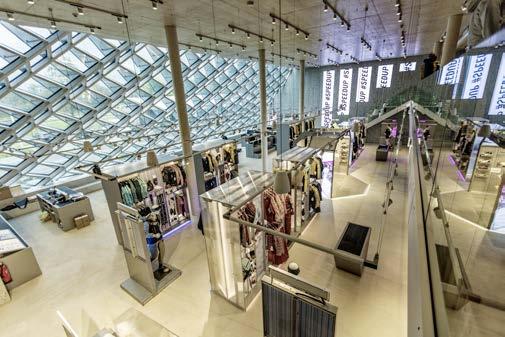

“No one shops for the product here. You take a piece of the branding home with you,” says Marco Burkhardtsmayer, describing the magic of the Harry Potter store in New York.



location: a prime spot at Zurich’s Bahnhofstrasse, right at the beginning of the street and just a stone’s throw from lake Zurich. The property: Bongénie, a luxury store that has just opened at this location. The boss: loïc Brunschwig, 31 years young and determined. The question for this cover story: To what extent is such a statement building relevant?
Text: dörte Welti. Photos: Bongenie
We meet a relaxed Loïc Brunschwig in the Emile restaurant at Bongénie, one of the assets that make this store what it is, albeit by necessity, but more about that later. A brief recap: in 1913, the Grieder fashion house, founded in 1889 by Adolf Grieder as a leading silk fabric distributor at the time, moved into an imposing building at Paradeplatz in Zurich. In 1972, the business was sold to Geneva-based family company Brunschwig & Cie, which had been running a similar business in French-speaking Switzerland since 1891 under the name Bon Génie. Grieder continued to operate under its own name as a luxury fashion department store. In 2015, the Swatch Group purchased the historic building on Paradeplatz (for 400 million Swiss Francs) and did not renew the lease with Brunschwig & Cie. SA, as the company is now called. In a lengthy process, Brunschwig tried to keep the historic location, but lost in Federal Court. Time was of the essence; a new location had to be found, and it was eventually located 250 meters away at Bahnhofstrasse 3. The decision to move was made in 2020. However, the commercial building dating from 1880, in which Brunschwig rented 4,000 square meters, was undergoing extensive renovation by its owners, the Baugarten Zurich Foundation and Cooperative. This was a project that had already started in 2015 and was in full swing. The ambitious plan to move into the new premises before the 2024 Christmas shopping season had to be shelved during the course of the construction work. The opening then took place in the first weeks of February 2025.
Loïc Brunschwig, what do you associate with the term relevance?
Loïc Brunschwig, CEO Bongénie, Brunschwig & Cie SA: I find it interesting that you want to talk about relevance. In preparing for our conversation, it was an eye-opener for me. Of course, relevance is the driving force behind all your decisions. You have to be relevant. Our static businesses are relevant to us. Our first store was in Geneva, the second was always Grieder in Zurich. Both stores each account for almost a quarter of our sales. So if we had a large store in Geneva and no longer had one in Zurich, we would lose a lot of sales and still have high back-office and head office costs to cover. A significant volume is therefore relevant for us. In addition, this project offered us the great opportunity to find a location on Bahnhofstrasse that we could develop from the ground up. The whole process has now taken eight years.
Eight years ago, you had barely finished school. That’s right. Eight years ago, I had just completed my business administration degree. But I wasn’t involved in the project to relocate Grieder from the outset. I had worked in the digital
and marketing department of our company for two and a half years and then went to Union Bancaire Privée UBP for a year, which is now our neighbor on Bahnhofstrasse, but that’s a coincidence. I wasn’t involved in the whole process with the Swatch Group; I only joined when we were able to sign for this new location.
It’s worth mentioning that you are very young to be CEO of such a large family business as Brunschwig & Cie. SA. Previously, my uncle Pierre Brunschwig and my father Nicolas were in the company management, together with their cousin Anne-Marie de Picciotto. A good three years ago, they decided to step down from operational management. Anne-Marie and Pierre have other interests and commitments, and my father was appointed Chairman of the Board of Directors at Rolex, but they remain shareholders and members of the Board of Directors. They asked me if I wanted to come back, not in the technical role I had previously held, but to manage the company. I said okay, but asked if they could consider a co-CEO model, as I was only 27 or 28 years old at the time. I mean, I was a bank employee, and suddenly I was supposed to manage 550 employees at 18 locations – I didn’t think that was a good choice. They agreed, and so I started working as co-CEO with one of our directors, Paolo Pitton. However, Paolo left last year, and I have been the sole CEO since Spring 2024.
Do you feel left on your own?
No, not at all. My family members are very involved; they still have their office on the top floor of the Bongénie store next to mine. We have a good team, with people who have been with us for many years. What has changed somewhat since Paolo left is that we used to work in tandem on questions from the group, interviews, and various other matters such as meetings with suppliers. Now everything comes to me. My schedule is a little more complex.
You mentioned that a quarter of your sales come from the Geneva and Zurich locations, but you have a total of 18 stores. How is the relevance distributed?
Of course, they are all relevant. We have four large stores in Geneva, Zurich, Lausanne, and Basel. The other locations have floor space proportional to the size of the city; in Lucerne or Bern, 4,000 square meters is not the goal. Having the largest possible sales areas is not our strategy. There are smaller stores that are very profitable and larger ones that are less profitable. Lucerne, for example, is a very profitable spot, even though it is rather small, boutique-style with perhaps 20 brands, only for women, no men’s, no children’s, no home or
beauty department. The location of our stores in the cities is crucial – we regularly have real estate agents who are interested in taking over some of our locations.
You also work with Max Mara stores in Switzerland. We hold a 50 percent stake in the Max Mara stores in Switzerland. Our headquarter in Geneva is home to accounting, IT, back office, logistics, and everything related to the operational functions that support the running of these stores. Nationally, we operate around 30 stores in Switzerland, either directly or in joint ventures.
What current challenges can be turned into advantages? We have two online shops. For various legal and logistical reasons, we currently only ship our e-commerce orders to Switzerland and Liechtenstein. It’s a logistical decision, but would it really make sense to ship goods to the US when e-commerce is widespread worldwide and there are already so many US shipments? You order socks from Zalando, get the wrong size, and send them back by plane. But storage is too expensive for Zalando, so the socks are destroyed. That makes no sense at all. Our real strength in Switzerland is that we deliver everywhere in Switzerland. Not just where we don’t have a store, but where you can find a retail store within 30 minutes and simply return the goods. It makes more sense from an ecological point of view, the shopping experience is better, and our reputation is better. When you order online from Bongénie, you know where to find them if there’s a problem. The service is there, the history is there.
Back to the new location in Zurich. What did you come up with to attract customers to a static store?
In the past, all you needed was good products and a good location. Today, that’s no longer enough to attract customers. Products are available practically everywhere, and a good location in the city center is usually difficult to reach by public transportation. So, we knew we needed the architecture to make people feel comfortable and want to come here. The owners of the building insisted that a bar and restaurant be included in the renovation, so we strategically placed them on the ground floor. The concept is for people to perceive the store as a place full of life, something that attracts them. With service in the shopping areas, we bring you a coffee and you can relax. You are also welcome to take your products home with you for three days to try them out.
How relevant should Bongénie be for the city of Zurich? It is very important to us to design each location individually, while at the same time connecting it to the city. How we choose to personalize each store depends on the building and the owner of the chain. For this building, for example, we decided to use only Swiss wood. The stone comes from Northern Italy. The building is LEED (Leadership in Energy and Environmental Design) Gold certified, an international environmental label. We had many rules and restrictions from the owner and the historic preservation authorities, which we took very seriously. To promote the architectural harmony of the store, we asked all brands to keep our ceilings and floors and not to use a shop-in-shop concept with separate boxes. The only exception was Chanel. They opened their first dedicated shoe store worldwide with us. Chanel is a long-standing partner, and we have a good relationship. They wanted to design their area with Peter Marino, a well-known architect in the US, so we let them do it. However, we don’t want to be a luxury shopping center, but rather a store with brands curated by us and our own assortment. We generate 90 to 95 percent of our sales with products that we select ourselves. We are not a department store, but a specialty store in the classic sense. Bongénie aims to contribute to the attractiveness of the
shopping experience in the city. There are many international brands on Bahnhofstrasse, but only a few Swiss stores. Rents are high, and local tenants have been driven out. We are trying to reestablish this Swissness at Zurich’s best address.
Why did the name change from Grieder Bongénie to Bongénie when you moved?
The name Grieder is carved in stone at the old location, on the façade of the building, and is protected, so even the new owner, the Swatch Group, cannot change it. We felt that we couldn’t leave the Grieder building and keep the Grieder name. Out of respect for the building and for the people of Zurich. The name is protected, but Grieder is also a very common family name in German-speaking Switzerland. Choosing Bongénie was logical. We also changed the logo and introduced a new blue as our signature color. Of course, it was important to convey to people that we remain an elegant, traditional Swiss family business. It’s also a kind of label, because we don’t manufacture our products ourselves, but present a selection to our customers. The label stands for good prices, good products, good service, and a good guarantee. Bon, in essence.
How long can you stay at this location in Zurich?
We have very long-term contracts. We could stay here between ten and 30 years, but most likely 30 years, given the investments we have made.
Where do you want to grow, if at all?
That depends on opportunities. We invest in projects that we believe are of high quality. We don’t aim to open one or two stores a year; that’s definitely not our strategy. We know the market situation. The market is not easy, so the philosophy is to do less and do it better. Of course, we want to improve our existing stores. We have some leases that are expiring and therefore need to be renegotiated. If you are good at what you do, can improve, and more and more customers come because they think you are great, then that is better. We define growth differently. Of course, we try to keep our profitability stable to ensure that we are financially strong enough to stay in business. However, our goal is not to maximize profits and dividends. The family has not paid dividends for about ten years. All the money generated by the company has remained in it to support our long-term goal of staying alive as long as possible, and to have the money to finance some very important projects, such as this one, which represents an investment of over 25 million. For us, growth does not mean that revenue grows with the age of the company. Our goal has always been to pass the company on to the next generation. I am only at the beginning of my generation. It would not be optimistic, but presumptuous, to say that I will be able to hand over the company to our children, but that is our big goal.
And the children have to take over if the family business survives? Or do they have a choice? Were you able to choose?
You do have a choice. Tomorrow, I could tell my partners: I want to study law or medicine, or go to an island, sell sandwiches, and surf. I am free to decide; I have no obligations whatsoever. But of course, you are involved from an early age when you grow up in this environment. The family sticks together. We have a family rule that partners are not allowed to work in the company. Only blood relatives. It’s a decision that seems old-fashioned from the outside, but it preserves the good understanding and harmony within the family.
Good products and the right location?
Loïc Brunschwig knows that today, that’s no longer enough. The architecture is all the more important – to make people feel comfortable and want to return.
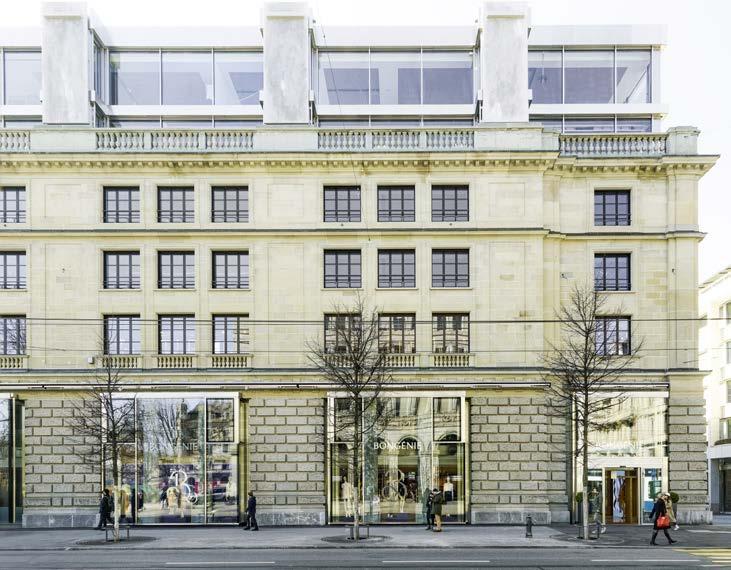



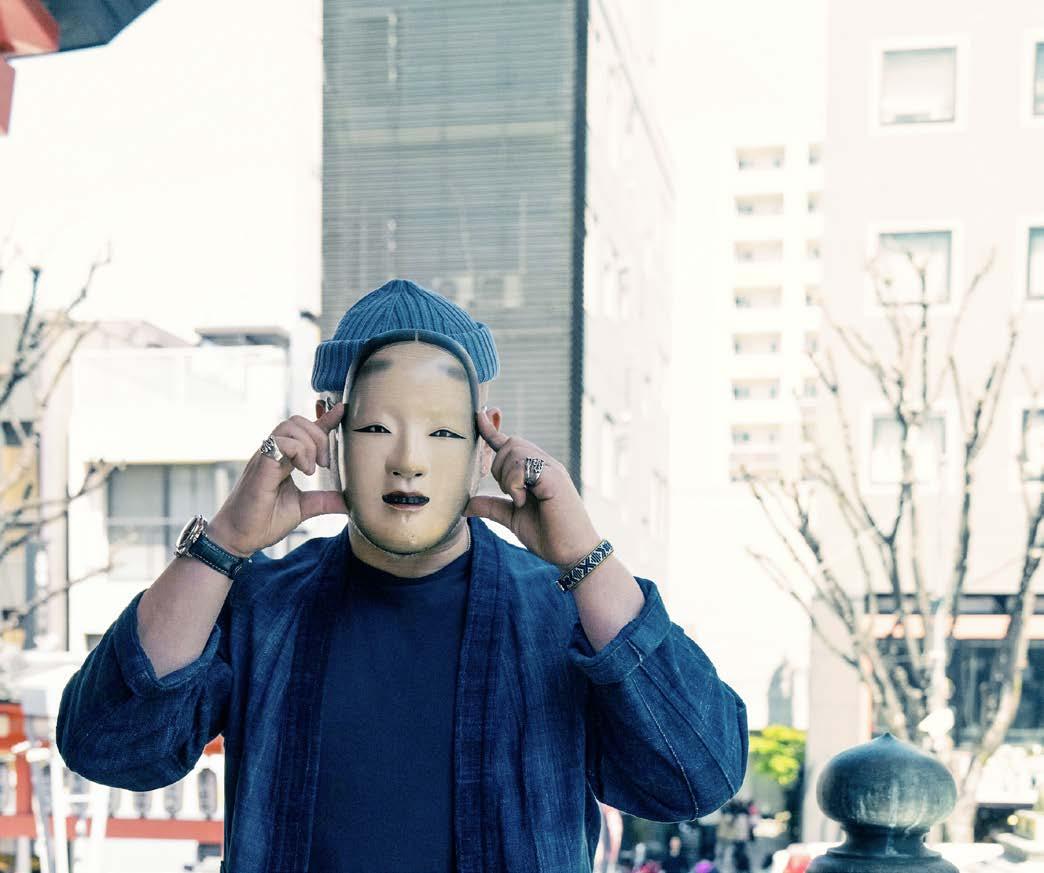
In the seams of a coat, the silence of a tea bowl, the choreography of a street corner – Japan has shaped the way the world thinks about clothing, beauty, and meaning. nowhere is this quiet influence more present than in Tokyo: a city where heritage and hypermodernity meet not in conflict, but in cadence.
From fashion to food, from subcultures to artisanal slowness, Tokyo doesn’t just follow trends – it absorbs, distills, reinvents. and today, a new generation of Japanese creatives is carrying this spirit forward. rooted in tradition, open to the world, they are not merely reacting to the global conversation. They are redefining its tone. By malene Wagner, @tigertanuki_japaneseart. Photos: Taro Karibe, @tarokaribe
(1F, Shinrin Building, 1-34-11, Tomigaya, Shibuya, Tokyo)
like he just stepped out of a 1970s movie, Yusuke is effortlessly cool, calm, and collected, with a nostalgic twist. His Blue Store in Tomigaya oozes the same stylish feel – modern, yet rooted in tradition and artisanship. The denim brand KUro, which Yusuke established in 2010, similarly embraces the essence of Japanese cartisanship and balances tradition with innovation. The design incorporates elements of architectural aesthetics, using fabric from seven different suppliers. Blue Store is a true haven for denim enthusiasts and a must-visit.


(Kanda Jimbocho, Chiyoda, Tokyo)
Jimbocho is the historical book area of Tokyo, dating back to the edo period (1603-1867). Today, it remains a book lover’s paradise, with one store after the other offering endless selections of old and new books and magazines. Yusuke’s latest find is a catalogue of Yokoo Tadanori, one of Japan’s most renowned graphic designers known for his 1960-70s psychedelic meets edo pop aesthetics.
(1F, Berubi Matsuya, 1-6-7, Tomigaya, Shibuya, Tokyo)
Yusuke’s favorite café little dipper is only a short walk from his store. It opens at 12pm and you are welcomed by the eccentric and heart-warming owner Yoshio Kobayashi. The food and coffee are delicious. also making it worth a visit are his out-of-this-world homemade lemon cookies!

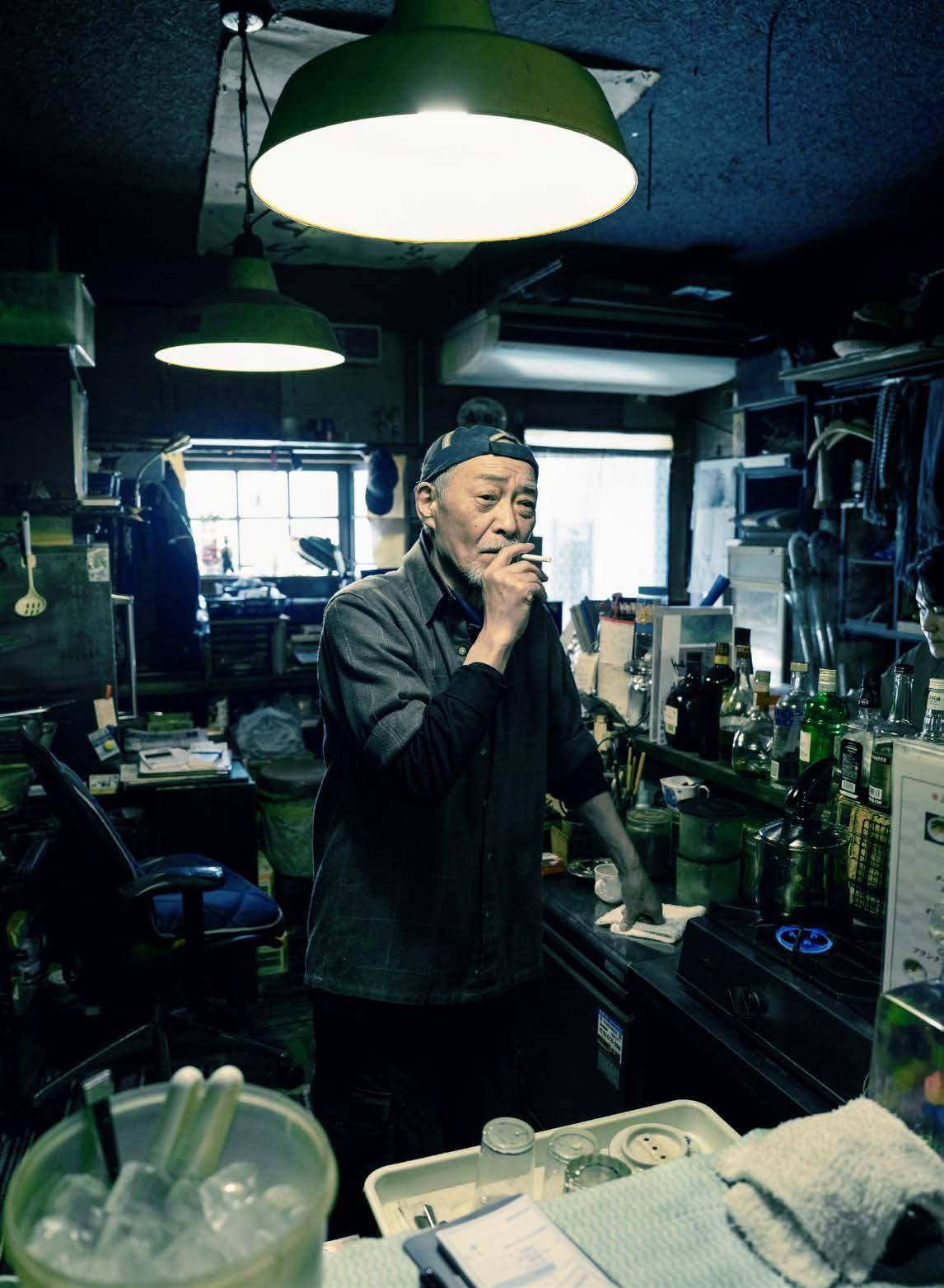
(1F, Berubi Matsuya, 1-6-7, Tomigaya, Shibuya, Tokyo)
little dipper is one of the most unique establishments you will come across. and that says a lot in a city full of quirky and quaint spots. This has much to do with the personal and cosy atmosphere and interior, but even more so with the man behind the counter: owner Yoshio Kobayashi. He has been running the place for forty years, attracting people from all walks of life, with a long list of regulars that include designers, famous actors and tv personalities. Yoshio quickly strikes up a conversation, becoming both your friend and therapist within two minutes.


Yoyogi Park
(2-1, Kamizonocho, Yoyogi, Shibuya, Tokyo)
not too far from Yoshio’s café is one of Tokyo’s largest parks, located in the heart of Tokyo in the popular area of Shibuya. in the middle of Tokyo’s busy life and traffic, this is a place where Yoshio finds peace and quiet to contemplate. It might be slightly touristic but by venturing down almost untrodden paths, you can find yourself in a dreamy garden with a lake, carps and water lilies.
(5-1-1, Yoyogi, Shibuya, Tokyo)
a short walk from Yoyogi park is a ‘hidden’ time pocket on top of a small, wooded hill, where Yoshio also enjoys spending some down time. The Shinto shrine dates back to 1212 and is dedicated to Hachiman, a deification of emperor ojin (201-312) and the guardian god of warriors.
(Higashiyama, Meguro, Tokyo)
after graduating from Bunka Fashion College in 2009, Kaori worked in costume production and production management for Japanese brands before launching her own brand in the Fall/Winter of 2019/20. From her studio in meguro, she has a new project under way, as she plans to rebrand, and rename her current label to laloH in 2026. Her style is clean and elegant, with a gentle sculptural effect drawing inspiration from both east and West.




(1-23-2, Uenokoen, Taito, Tokyo)
The national museum of nature and Science was founded in 1877 and is one of the oldest Western-style museums in Japan. It offers a comprehensive collection of exhibits about the earth, life, science and technology. Kaori often spends long hours here, finding inspiration as she reflects on the ideal relation between humanity, nature and the environment, as well as on the past, present and future.


(29-20, Sarugakucho, Shibuya, Tokyo)
Kyu-asakura House is an old wooden house in the center of modern Tokyo, built as a private residence in 1919. The house was designated an Important Cultural Property by the Japanese Government due to its architecture, history and because it is a rare example of a large wooden house that survived the Great Kanto earthquake of 1923. “The beautifully designed garden harmonises delicately with nature, allowing visitors to experience the changing of the seasons. Inside the house, the carefully considered lighting and spatial design, crafted with a distinctly Japanese sensibility, create an atmosphere so serene that it is hard to believe you are still in the heart of Tokyo”, Kaori explains.

(1-13-11, Aobadai, Meguro, Tokyo)
a hairdresser for more than fifteen years, his Salon “fil” is located in the idyllic area along the meguro river, where his exclusive clientele (including many celebrities – but don’t tell anyone), come to have their hair done. elegant and understated, the salon mirrors its owner. recently Takahito launched lynarch, a new product line for everyday haircare. The products are silicone-free, and with the woody amber scent of patchouli as the main ingredient and a refreshing green top note. Tried and tested – this is truly an amazing product. For appointments: info@fil-hair.com
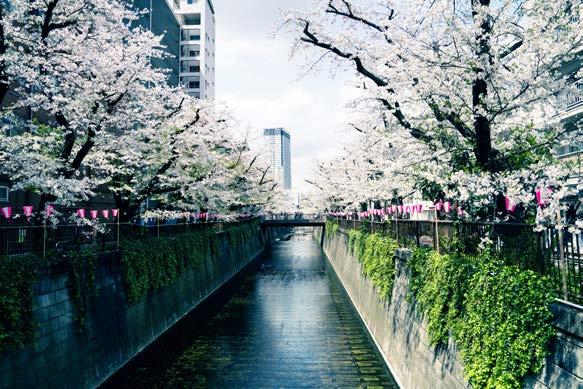

meguro river
(1 Aobadai, Meguro, Tokyo).
It is no coincidence that Takahito’s salon is situated by the meguro river, as this is one of his most beloved spots in Tokyo. especially during cherry blossom season in early spring, the area turns into a pink dream of sakura, as people gather along the water to celebrate the special time of the year.
(2-12-2, Kamimeguro, Meguro, Tokyo)
Wine Bar SCad in nakameguro, which has been running for more than ten years, is owned by an excellent sommelier, a friend of Takahito’s, and it is his local hang out. However, many people also come from afar to try the special wine selection, not to mention the pasta and sandwiches – they come highly recommended.
(2-3-10, Yanagihara, Adachi, Tokyo)
Shurin’s studio is located near busy akihabara, tucked away down a small side street, where the young artist works on her toy sculptures. She studies at the prestigious Tokyo University of the arts in the design department and is one of the very few creating prototypes using CG software and producing figures mainly using a 3d printer. Her works incorporate the strangeness and abnormality of horror and suspense movies, as well as pop images from cartoons. She recently participated in the exhibition “Print the Future” at laforet.


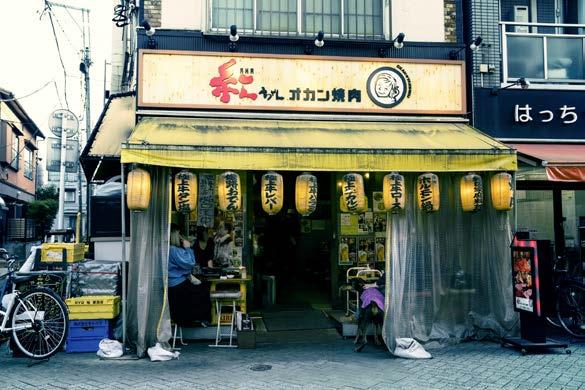
(5-52-15, Nakano, Nakano, Tokyo)
For a culture obsessed with robots and toys, it is no wonder that the shop “robot robot”, specializing in vintage Japanese and Western toys and figures, is a collector’s mecca. From Godzilla and Bandai to my little Pony and marvel – you will meet all your childhood heroes (and horrors) here. This is a world that Shurin loves and in the store located on nakano Broadway Shurin finds endless inspiration for her own weird and wonderful creations.
Barbecue restaurant akachan
(Hirata building, 21-6, Senjuasahicho,Adachi, Tokyo) located in Kita Senju just around the corner from Shurin’s studio, this is the local barbecue restaurant where she often goes with her artist friends after a hard day’s work. Her favorite dish on the menu: all-you-can-eat grilled horumonyaki (made from beef or pork intestines).

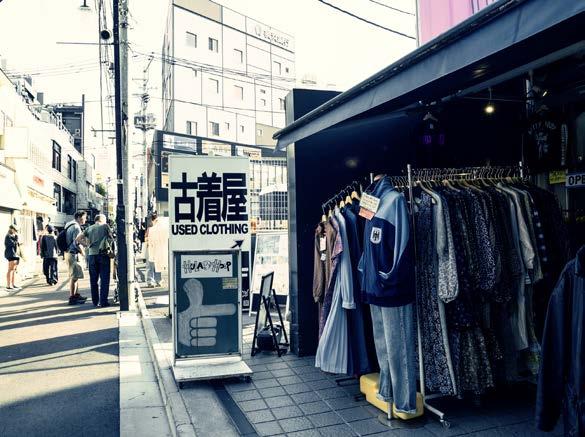

Shimokitazawa
(2-24, Kitazawa, Setagaya, Tokyo)
also known as Shimokita, it is Tokyo’s bohemian neighborhood in Setagaya in the western part of Tokyo, known for its vintage clothes, trendy cafés, indie music and bookshops. With a rich subculture and among Tokyo’s best spots for thrift shopping and vintage clothes, nene enjoys browsing and finds not only inspiration but also gems to compliment her very cool wardrobe.
Unko museum
(1-1-10, Aomi, Koto, Tokyo)
Unusual, yet very Japanese is the Unko museum (poop museum) in odaiba, in the eastern part of Tokyo. The museum even has its own theme song. This museum is a favourite of nene’s - “it’s all about breaking down stereotypes,” she says. “Come and enjoy this unique unko kawaii (disgustingly cute) world and look at, touch, photograph, and play with poop, for a unique experience that can be found nowhere else.”
unkomuseum.com/tokyo
(3-10-9, Sotokanda, Chiyoda, Tokyo)
nene is part of the pop idol group, meme ToKYo Idol, which was formed in 2019 and consists of six members. The group performs at dear Stage, one of the most popular night spots for akihabara’s legion of otaku (simply put: geeks). The group’s popstar uniform might be difficult to differentiate from others at first sight, but once you notice the details, it is clear that each member’s style is unique and has a somewhat rebellious approach to the generic kawaii (cute) concept. nene is a true example of someone who thinks outside of conventions and reinvents them, which is also demonstrated in her solo project romantic addiction where her roots in funk, r&B and hip hop are combined with romantic lyrics and a sprinkling of realism.

(3-27-14, Jingumae, Shibuya, Tokyo)
Beginning in 2005 at the age of 26, Ichibay started doing tattoos independently at his family’s house. He then began training under his teacher Sabado, but true to Ichibay’s rebellious nature he was told to leave after only six months. This didn’t faze Ichibay, who kept at his work, and also started painting, with much of his art having been turned into merchandise. Today he is one of the leading tattoo artists of the renowned Three Tides Tattoo Studio, which was established in 1998 in Tokyo and osaka, and people travel from abroad just to get an appointment with him. also an art collector, Ichibay’s studio is filled with quality flea market finds (especially from oeodo), including sculptures and original woodblock prints (ukiyo-e) – not to forget his pet turtle, the goldfish and the latest addition to the family, the 1-yearold Japanese Chin, momotaro.


(6-14-1, Jingumae, Shibuya, Tokyo).
In the same building are two of Ichibay’s go-to-places for food that take you from the hustle and bustle of the busy streets of Shibuya to the alleyways of a bygone time. one is local vegetable shop matsumoto Seika. on top of the stairs is his favorite sushi spot, where he often treats his foreign guests to the most delicious sashimi.
(12-18, Udagawacho, Shibuya, Tokyo).
Formerly called Tokyu Hands, Hands is a hobby department store that focused on crafts and dIY, the first which opened in Shibuya in 1976. Here you can find any and everything your crafty and creative heart desires. over the years more sections have been added and now the all-encompassing store includes everything from stationary to carrot peelers and toilet covers, and anything you need for your pet. This is also the place where Ichibay goes to find toys and treats for momotaro.








Ueno-Park
(4, Uenokoen, Taito, Tokyo) a place that Yasuko likes to visit is Ueno Park. It is one of Japan’s five oldest public parks and is home to many of Tokyo’s larger museums. The park was established in 1873 following Western ideas, which dominated much of Japan’s rapid change and modernisation during the meiji period (1867-1912), after almost 250 years of isolation from the outside world.
Tokyo Skytree
(1-1-2, Oshiage, Sumida, Tokyo)
Tokyo Skytree in oshiage was designed by nikken Sekkei in a neo-futuristic style. It opened in 2012 and changed the neighbourhood of Sumida, which has flourished as a manufacturing town since the edo period (1603-1867). For Yasuko, Skytree symbolises the development and change of the old district area that became soewhat neglected towards the end of the 20th century, but now draws both Tokyoites and tourists to its many shops of crafts, design, and fashion, which includes Yasuo’s own business.


(1-10-2, Narihira, Sumida, Tokyo)
The store was founded during the Taisho period (1912-1926) and is still run as a family business of workwear. owner is the most welcoming and delightful Yasuko, now in her late 70s, whose grandfather started the business. Initially, they produced traditional construction workers’ shoes (jika-tabi), made entirely by hand by eight different craftsmen and -women, each contributing to a specific part of the production. But with modern times and new safety rules being put into place, there are no longer customers for the age-old design and consequently, no craftspeople are left to pass on their skills to future generations. The shop luckily survives by providing workwear clothes of the highest quality fabric that is both durable and lightweight, using original and traditional techniques. However, as the need for and appreciation of traditional crafts diminishes, there is a risk of Yasuo’s shop having to close.

(5-36, Kagurazaka, Shinjuku, Tokyo)
at first glance, Bidou might be mistaken for someone working in high-end fashion, with his distinctive and curated look. But Bidou is a craftsman. an artist. a maker of traditional noh masks for almost thirty years. noh theater is a classical dance-drama that has been performed since the 14th century, where the dancers wear iconic masks representing specific characters. The Zenkokuji Temple in Kagurazaka is dedicated to Bishamonten, the god of war. It was from him that Bidou’s sensei [teacher] drew his artist name ‘Bidou’ as a symbol of victory. as a testimony to Bidou’s immense talent and high technical skills, after only 4.5 years of training his teacher decided that he had learned enough of the traditional craft. Since then, Bidou found his very own path and moved outside of the traditional noh culture with his mission to create a new history in the world of noh mask makers. This has brought his pieces that convey the Japanese idea of mysterious beauty, known as yugen, not only to international stages of performance, but also to museum collections in europe and USa


(3-57-4, Koenji Minami, Suginami, Tokyo)
Safari is a vintage clothes shop and probably the best known in Koenji. It consists of six shops specializing in different things, including one selling antiques and art. as a big lover of fashion, Bidou often finds unique items, including his latest purchase: a vintage military jacket.
(1-18, Gotenyama, Musashino city, Tokyo)
Bidou’s favorite park is located near Kichijoji Station, a large wood park west of Tokyo. With around 500 cherry blossom trees and a large beautiful pond in the middle, Inokashira Park is a fantastic sakura [cherry blossoms] spot in Tokyo in Spring and a place to unwind.
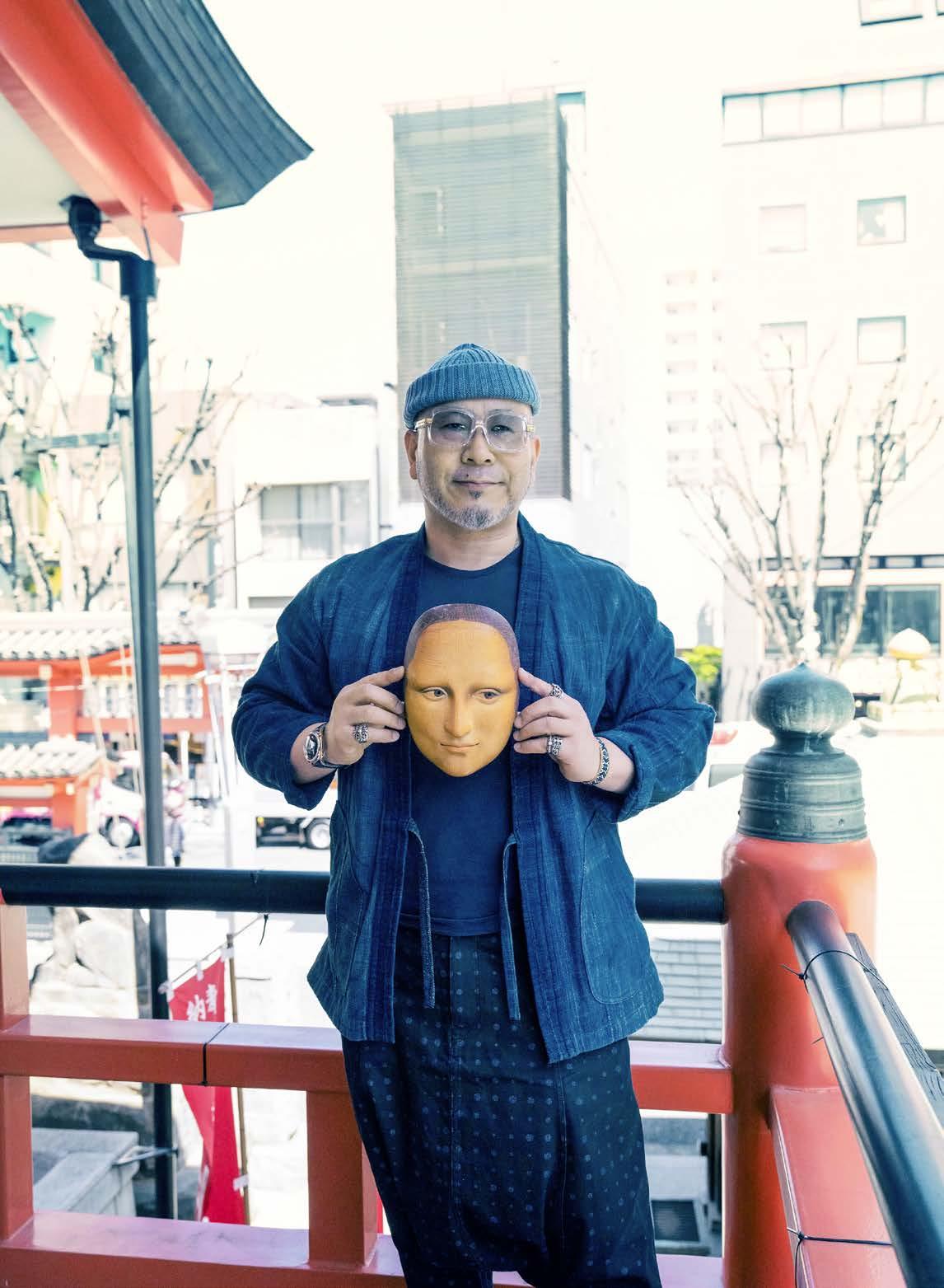
Relevance is not a fixed value. It is a process. The following pages delve deeper into exactly where the future is decided: At the interface between progress and responsibility, between technology and humanity, between meeting and meaning.



it is one of the paradoxes of our industry: in a world that is in a constant state of interaction, the very spaces that were once considered the epitome of exchange – trade fairs – are wavering. What has functioned for decades as a self-evident platform for presentation, trade, and networking is increasingly losing appeal. yet this loss of relevance is merely the surface of a more profound shift. Traditional trade fair formats have reached a turning point – and with them the idea of what a modern trade fair can and must be. companies are rethinking their presence, budgets are being reallocated, and some events are disappearing altogether. What used to be a staple now has to prove itself anew.
Text: Janaina engelmann-Brothánek. photos: Trade fairs
WWhat role will trade fairs perform in the future?
What requirements must they fulfill if they are not only to survive, but to flourish? These are the questions that inform our conversations with Sofie Dolva, Director of CIFF Copenhagen, Raffaello Napoleone, CEO of Pitti Uomo Florence, Massimiliano Bizzi, founder of White Milano, and Florence Rousson, CEO & President of Première Vision.
Together we take a look into the future of trade fair formats.
Design Week is often considered a role model for the evolution of trade fair formats. Why does it not only appeal so strongly to the design industry, but also to the fashion industry? The answer lies in its unique concept: the eventization of the city – a dynamic that is particularly visible in the interaction between Salone del Mobile and Fuorisalone. Every year, this partnership transforms Milan into a lively stage for exhibitions, events, and design installations that go far beyond traditional trade fair halls. It ensures that the entire cityscape feeds into the experience and blurs the boundaries between art, design, and fashion. This transformation not only attracts a diverse, international audience, but also turns the trade fair into a cultural event that is far more than merely a commercial space. Is this model the answer to the crisis of (fashion) trade fairs?
It has long been abundantly clear that traditional fashion fairs have come under pressure. However, anyone who only talks about a trade fair crisis is ignoring the bigger picture. “A trade fair is a mirror of the industry,” says Florence Rousson, President of Première Vision. “If it no longer functions as such, it means that something is fundamentally wrong out there.” In fact, the fashion industry is undergoing a profound change: while luxury is becoming increasingly disconnected from the reality of many consumers’ lives, fast fashion continues to dominate the market – fast, cheap, suitable for the masses. Orientation is difficult – for brands and retailers alike.
“In Italy, around 26,000 stores have been shuttered over the course of the past three to four years,” reports Raffaello Napoleone, CEO of Pitti Immagine. A structural break that is inevitably reflected in the statistics relating to trade fairs. The number of exhibitors is dwindling, and once impressive visitor numbers are stagnating, or even collapsing. “From 2018 until the pandemic, White had grown dramatically – almost 600 brands took part,” recalls Massimiliano Bizzi, founder of White

Sofie Dolva, Director CIFF Copenhagen “We consider all aspects much more carefully these days. What kind of story do we want to tell? Curation is no longer simply an aesthetic criterion; it is now a strategic factor.”
Milano. “Pitti Uomo had up to 24,000 visitors per edition,” explains Napoleone. The picture is very different today: the last edition of Pitti in January attracted 13,300 buyers – a year-onyear increase of 6.5 percent at least – while the number of brands represented at White halved.
Yet the causes of this development cannot simply be explained as the result of the pandemic or digitization. It is not the formats that are in crisis here; it is the self-image of interaction, visibility, and relevance. “People used to come to trade fairs because they had to attend,” says Sofie Dolva, Exhibition Director of CIFF Copenhagen. “Today, brands only attend if they really want to. That constitutes a radical paradigm shift.” Bizzi speaks candidly about the inevitable reassessment required as a result: “We had lost our DNA – too expansive, too confusing. The pandemic prompted a reset. Today, I am very happy with 300 brands. It allows us to curate in a much more targeted manner.”
At a time when attention is the scarcest resource, it is no longer enough to merely fill halls. Trade fairs have to demonstrate attitude, generate relevance, and curate content intelligently. “In the past, the more brands, the better. Today, the opposite is true,” Massimiliano Bizzi asserts. “We systematically scout the world for labels that are compatible and create a common narrative. This raises the entire event to a different level.” He emphasizes a shift in perspective that has changed the way many organizers perceive themselves: “We work for the brands, for our exhibitors, and especially for the buyers.” Florence Rousson also stresses the new responsibility of trade fair organizers: “We create spaces that inspire, not just sell. People not only attend for the products, but because they are seeking inspiration that they cannot obtain elsewhere.” The trade fair thus evolves into a stage for ideas, a place where content is on an equal footing with the product. Organizers are now endeavoring to assume what used to be the primary responsibility of buyers – to identify trends, establish themes, and tell stories. The trade fair format is morphing into a three-dimensional content hub – a lively space in which products, people, and ideas engage. “We consider all aspects much more carefully these days. Who stands next to whom? What kind of story do we want to tell?” explains Sofie Dolva, taking a similar line. “Curation is no longer simply an aesthetic criterion; it is now a strategic factor.” This is particularly evident in the example of Pitti Uomo. Raffaello Napoleone describes the selection process for exhibiting brands as “precise and forward-thinking”.

Raffaello Napoleone, CEO Pitti Uomo Florence “Italy’s saper fare, its masterful artisanship, is a real asset. In this context, Pitti provides a stage for the unique – through a curated, immersive format.”
“We scrutinize every single label before we approve them. We review them in consultation with a committee of buyers and manufacturers, people who really know the market. We have collections sent to us in advance, lay them out, and discuss their merits. Yes, it is a time-consuming process, but it is the only way to ensure we avoid bypassing the market with what we put on display. In many cases, this even places us one step ahead – and that is crucial.”
In an increasingly fragmented world, an international profile is no longer a foregone conclusion, but a strategic imperative. Trade fairs that once guaranteed international attendance due to their geographical location alone must now actively build bridges between markets, cultures, and mindsets. “Today, a trade fair needs to think beyond Europe and think globally – while still retaining local credibility,” Florence Rousson succinctly explains. For her, internationalization is not a mere slogan, but a promise of diversity, openness, and cultural exchange.
Raffaello Napoleone describes Pitti’s objective as follows: “We now speak differently to China than to the US, differently to Korea than to South America. Our aim is not merely participation, but involvement. We aim to make international players feel part of the whole.” Italy’s identity plays a decisive role in that respect. “Italy’s saper fare, its masterful artisanship, is a real asset. Even international luxury brands rely on Italian manufacturing. In this context, Pitti provides a stage for the unique – through a curated, immersive format,” says Napoleone. He continues: “Where else can you find such a focused, international, high-quality overall picture in just four days? There is no comparison. That is why we have to try to remain unique with every edition.”
The CIFF, too, is stepping up its commitment to internationalization – albeit with a strategically broader perspective. After all, the global relevance of a trade fair is not decided in its halls alone. “Three days of trade fair are not sufficient to form an international network or open up new markets,” explains Sofie Dolva. “That is why we support many of our exhibitors throughout the year – with pop-ups in New York, international events, digital concepts, and curated collaborations.” A paradigm shift is also underpinning the atmospheric staging here: CIFF increasingly understands itself as a year-round brand partner – not just as a host of a one-off event.
Massimiliano Bizzi no longer regards White

Massimiliano Bizzi, founder White Milano “We need a fashion week that opens up, tells stories, invites people in, lets them participate, just as the design world has long exemplified – as a collective experience with character.”
Milano as a purely Italian platform, but as a “European hub for global trends”. This mindset is clearly reflected in the format: panels in several languages, strategic guest nations, tailor-made program items for international visitors – all this makes a trade fair more accessible, regardless of origin, language, or market size. Furthermore, the future of White lies in expanding into new, non-traditional markets. “India, Arabia, markets that are not considered traditional – they harbor new energy, new ideas, and brands that you cannot find anywhere else. That is where we want to go,” Bizzi elaborates.
Florence Rousson emphasizes: “We specifically invite brands and creatives from new markets – not to add an exotic touch, but as equal partners. The aim is to expand the creative ecosystem – not just to export, but also to import.”
Do successful trade fairs follow different rules? It is no longer simply a matter of order numbers and stands, but rather of exchange, inspiration, and experiencing beautiful things collectively. Trade fairs are, as they always have been, places of encounter – just on a new, more profound level.
“People need to meet. This constitutes a fundamental need – especially in an industry that relies so much on haptics, emotion, and atmosphere,” says Sofie Dolva. At a time when budgets are dwindling, the attendance at traditional order fairs is falling, and brands are looking for new ways to position themselves, CIFF is focusing on transformation rather than tradition. “We need to rethink trade fairs,” says Dolva, “as an experience, as a stage, as an emotional ecosystem.”
A visit to Copenhagen illustrates what this entails in concrete terms: classic order areas blend into immersive brand spaces, curated dinners, talks, exhibitions, and music performances. The CIFF is no longer a trade fair in the traditional sense; it is a festival that appeals to all senses. “Our industry thrives on emotions,” says Dolva. “And it is precisely these emotions that we seek to recapture. The result is a hybrid space –somewhere between Coachella and a business conference. The trade fair creates a meeting place for creatives from the worlds of fashion, art, and culture. The brands not only tell their stories, but they stage them. And Copenhagen itself becomes a stage, too.”
At Pitti Uomo, too, the location is more than a mere backdrop. “Florence offers human proportions – everything is within walking

Florence Rousson, CEO and President Première Vision
“We create spaces that inspire - not just sell. People not only attend for the products, but because they are seeking inspiration that they cannot obtain elsewhere.”
distance. This atmosphere is unique,” says Raffaello Napoleone. The city itself acts as a vibrant extension of the trade fair – from the historic palazzi and courtyards to spontaneous encounters on the street. This is not just about fashion, but about style, spirit, and exchange – at a pace that allows for real conversation.
For Rousson, Paris is also much more than a logistics hub: “Paris remains Paris – an eternal source of inspiration for the fashion world,” says the Première Vision president. “It is therefore our duty to future-proof this location.” This means improved infrastructure, targeted visitor guidance, and close collaboration with the city council. “A trade fair visit should not drain your energy; it should inspire you.”
When asked why the Salone del Mobile serves as an event for an entire city, while the Fashion Week is gradually losing its appeal, Massimiliano Bizzi answers: “Because Design Week is accessible – fashion, on the other hand, aspires to remain exclusive,” he explains. He believes this is precisely what makes all the difference. In the future, fashion will have to emerge from its bubble, move closer to people, closer to the moment. “Today, everyone wields a camera in the shape of a smartphone. If you ignore that, you lose relevance.”
His plea: a fashion week that opens up, tells stories, invites people in, lets them participate, just as the design world has long exemplified. Not as an event by a select few for a select few, but as a collective experience with character.
From this perspective, trade fairs are no longer isolated events, but lively resonance spaces –places where conversations, coincidences, and shared moments often achieve more than any order block. The trade fair of the future? It is inspiring rather than overwhelming. It creates connections instead of fragmenting. It is not a mere showcase of things to come, but an expression of a new self-conception, a new vision of how an industry and its community want to meet, network, and innovate.
One aspect remains crucial: every trade fair must remain true to itself. Its strength lies in its identity – and this is not only created through content and staging, but also through the location that supports it. The rhythm of the city, its history, its atmosphere – all this is more than just a backdrop. It is part of the narrative.
i still consider trade fairs to be essential – not only to discover collections and place orders, but also to experience brands in context and engage in exchange. What is lacking, however, is structured knowledge transfer. many aspects remain 1:1, yet we need more open formats that make expertise visible. The industry as a whole can only grow if knowledge is shared. Trade fairs could be more: platforms for real learning, reflection, and further development.
Yasemin Demirci, The Store by Schneeweiss, Vienna


We are keen advocates of trade fairs. They represent one of the last spaces where our industry can evolve holistically: by physically experiencing materials, scouting new labels and ideas, and assessing quality and value for money. For them to realize their potential, the fashion calendar needs to be better coordinated. only coordinated schedules prevent frictional losses and ensure that trade fairs provide real added value for the entire industry.
Berit und Jan Petersdorf, Angelo’s, Hamburg
Buyers continue to attend trade fairs in pursuit of new discoveries, attracted by the added value of exchange, comparison, and curation. decisive factors include timing, a visually well-conceived concept, and an opportunity to view men’s and women’s collections in compact formats. Trade fairs should be more than mere rows of showrooms. They need to create space for interaction: informal, inspiring, open. Formats such as panels, dinners, or evening events are essential.
Huy Do, Jades, Düsseldorf

The younger generation of retailers rely on social media to scout and – to a certain extent – pre-screen brands. however, trade fairs remain indispensable for us. They offer an opportunity to experience quality first-hand, to test fits on the spot, and, above all, to experience real, authentic interaction. digital impressions transform into real experiences, and personal exchanges take on a new, deeper dimension.
Medo Diet, Homegirl, Munich
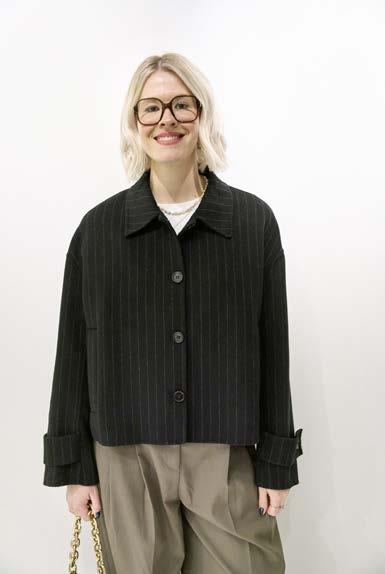

small, curated stores have different needs than large stores. They are not interested in mass, but in individuality that transcends comparability, personality that defies standards. For trade fairs to retain relevance, we require room for real conversations: at eye level, with time, depth, and context. This is the only way to forge connections that last beyond a season. a win-win for both sides!
Anika Hoffjann, by A store, Schermbeck
Trade fairs are equally essential for specialized stores such as Glore, which exclusively offer sustainable products. clear labeling of sustainable brands would empower buyers to make the best choices quickly and to find the right products. Trade fairs also offer sustainable brands and stores the opportunity to strengthen their standing, network, and benefit from current trends. This is where the conversations that will shape the market of tomorrow take place.
Victoria Gebhart, Glore, Vienna


Trade fairs remain a central reference point for the market, provided they are precisely synchronized, clearly positioned in terms of content, and offer more than mere product presentations. Beyond that, we need room for genuine exchange. The best conversations happen after 6pm, when the trade fair day has ended, and atmosphere outweighs agenda. connections are forged in these relaxed moments: Relationships that last beyond a one-off order.
Winni Klenk, Abseits, Stuttgart
Trade fairs create unique moments: spontaneous interactions and discoveries that breathe life into the fashion industry. yet the exclusivity and wow effect of previous years are gradually dwindling. To bring back the magic, they should not only showcase new brands and innovations, but also create a space for emotional encounters that enhance the experience. only then will trade fairs retain relevance for the younger generation.
Karla Reyer, Reyer, Salzburg


major retailers such as l&T primarily utilize trade fairs as a source of inspiration rather than a direct order platform. in future, they ought to emphasize visual and emotional staging, for example by means of catwalk elements or more creative stand designs that enhance the fashion experience. a clear distinction from other events, as well as the integration of exclusive brands and products that are not yet available in Germany, could increase appeal and exclusivity.
Maria Bröer, Buyer Womenswear L&T, Osnabrück

design and fashion are ever more intertwined, and milan design Week provides the perfect stage. The eventization of the city generates energy and attention but raises the question of whether it does justice to the creative depth of design.
Benedetta lenzi, director of ied Florence and curator, views this change skeptically. When spectacle supplants creative discourse, the city loses its essence. a conversation about brand invasion – and co-creation as a solution.
interview: Janaina engelmann-Brothánek. photos: ied
Fashion and design seem to be converging ever closer in Milan. Coincidence or strategy?
Benedetta Lenzi, director of IED Florence: It is decidedly strategic. In recent years, Milan Design Week has gradually adopted the logic of Fashion Week – in terms of timing, communication, and audience appeal. The city is transformed into a vibrant, almost surreal stage where every corner seems to be designed for maximum visual impact. That energy is, without a doubt, palpable, but it comes at a price. The urban infrastructure is being stretched to its limits; rent and service prices are soaring. This creates a hostile environment for emerging designers, independent studios, schools, and cultural institutions. These are the very voices that once shaped Milan’s unique design identity - and they are now, step by step, being marginalized.
How does this affect the DNA of Design Week?
It is changing it fundamentally. There used to be a fragile yet crucial balance: the Salone del Mobile formed the commercial center, while the Fuorisalone offered space for experimentation, failure, and cultural exchange. This friction was productive – it made the ecosystem dynamic. Today, however, even the Fuorisalone is increasingly curated from the perspective of brand management and media impact. The focus has shifted from process to presentation, from research to spectacle. What we encounter today are immersive environments designed for the camera, rather than for critical reflection. The city serves as the backdrop for a brand invasion.
Where does this urge for staging stem from?
It stems from cultural and systemic changes. The closure of Ventura Lambrate symbolized the loss of a place where experimentation and imperfection were welcome – a reflection of the general retreat of research-driven design. Concurrently, social media and the digital economy have established visibility and shareability as the new
currency. The rise of districts such as Brera clearly demonstrates this: design is characterized by aesthetics and staging, rather than critical debate or innovation. The result is a fashionization of Design Week.
Should we counteract this development? We must not romanticize the past, but we need to rethink our models. I envision a future that combines the reflective depth of a Biennale with the participative spirit of a community festival. We require formats that promote genuine exchange, where the focus returns to content and collaboration. Events that no longer ask: “What does the brand
want to show?”, but rather: “What conversations should we have as a society?”
Is the IED Glitch Camp project heading in that direction?
Yes, exactly. Glitch Camp is a free urban design camp launched by IED in collaboration with the City of Milan and Milanosport. It invites young creatives to actively shape public spaces through practical, site-specific installations. The focus is on process, experimentation, and co-creation – offering an alternative to the increasingly curated and brand-dominated atmosphere of Design Week.

"i envision a future that combines the reflective depth of a Biennale with the participative spirit of a community

at first glance, The union may seem niche to some. yet, behind the scenes, it is a powerful driving force promoting a new breed of fashion business. a simple showroom collective has transformed into a curated platform for genuine exchange and business at eye level. This is more than just a trade fair – it is a community, an attitude, perhaps even a small revolution. a conversation with Felix engelmann.
Text: Janaina engelmann-Brothánek. photos: The union
Felix Engelmann, initiator of The Union, describes the format as a movement that deliberately sets itself apart from traditional trade fair concepts. “The plan never envisaged launching a trade fair,” he says. What began with just a few brands evolved organically, never geared towards rapid growth. Instead: invite only, consciously limited, focused on quality. “We are The Union – a community of brands and stores that champion each other and prosper together.”
“A place for good business” is a simple motto that communicates a strong attitude. It is not about doing more, but doing it better. No crowds, no queues, no distractions. Access is intentionally exclusive –not as a matter of arrogance, but as a matter of principle. What matters is interaction, substance, and commitment.
What makes The Union special is its flat structure. Decisions are reached collectively. In October 2024, for example, a joint decision was made to cap the brand contingent at a maximum of 100. A bold move that illustrates how growth at all costs is not the objective. Even retailers and brands from Japan, who are usually rather cautious, supported the measure.
The Union also remains resolute in its selection. The brands are not those featuring large logos, but those where the logo serves as a hallmark of quality. “Substance outshines visibility,” Engelmann emphasizes. Retailers visit from all corners of the world – from Japan to Israel. The Union focuses on trust and targeted quality instead of gatekeeping. The success in Berlin has led to a new milestone: a first-ever Tokyo edition took place in March 2025. A logical step to advance the movement.
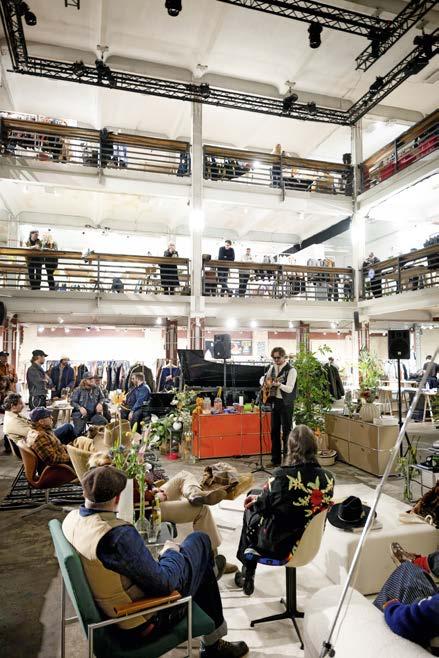
ILM Offenbach
now that’s a bold statement – yet how does a trade fair from offenbach succeed in establishing itself as a global platform for bags and accessories? ceo arnd hinrich Kappe discusses distinct concepts, a loyal community, and why a down-to-earth approach may be more effective than glamor. interview: nicoletta schaper. photos: ilm offenbach
Arnd, how is the ILM so successful – in Offenbach of all places?
Arnd Hinrich Kappe, CEO of ILM Offenbach : For a start, Offenbach is anything but provincial! We are part of the vibrant Rhine-Main region, an international hub with creative potential. The ILM was founded 75 years ago by leather goods manufacturers as their own platform. We maintain this heritage resolutely: Not as an event show, but as an order fair.
So, reliability is the key to success? Exactly. While other trade fairs change their concepts regularly, we remain predictable. This creates trust, which is why 70 percent of visitors return time and again.
Is that sufficient nowadays, especially as the relevance of trade fairs is hotly debated? We do evolve. Supporting programs with practical relevance transform the ILM into a platform for community exchange. In addition, we are cautiously expanding the portfolio to include sunglasses, scarves, and jewelry. That requires persuasion, as the industry can be slow to adapt. Yet we keep at it, patiently and persistently.
What about fashion buyers, for whom the ILM is likely to be of increasing interest? Is the timing a good fit? Honestly? It’s not perfect. Mid-January and July would be a better fit for textiles. However, we remain committed to mid-February and August as a compromise between order cycles.
What plans do you have for the future?
We continue to expand our international presence by cooperating with trade fairs in Hong Kong and New York. In July, we will be launching a barefoot shoe trade fair, aptly named Barefoot, which is an exciting growth segment. Our small, twelve-strong team acts as one, and our partners sense that. Offenbach is no coincidence, but a remarkable piece of trade fair history. A story whose end is not in sight.
ILM Offenbach Edition #162: 30.08. – 01.09.2025


marie aigner takes a holistic approach to design – as an architect, designer, and material strategist. in cambio, she found a partner who addresses sustainability and aesthetics sincerely. at the last milan design Week, they proved that fashion and design can do so much more than just set trends. interview: Janaina engelmann-Brothánek. photo: cambio

Marie, you staged an exhibition with Cambio at this year’s Design Week in Milan. How did the collaboration come about?
It was one of those happy coincidences that you cannot plan. Cambio was initially interested in one of my acoustic objects – and that quickly evolved into an idea about collaborating on a larger scale. I simply asked whether sponsorship was possible, followed shortly afterwards by a resounding yes. No loud branding, no ego, but genuine interest. That seemed like a strong indicator to me.
What was the result?
I have been working with recycled materials for years and denim is an underestimated material: emotional, stable, visually strong. We developed design objects made of denim remnants, including a daybed with cushions made of recycled PET. Locally produced, transparent manufacturing – this reflects my understanding of contemporary material culture. I was also invited to design a capsule collection. The aim was not to create show pieces, but rather wearable statements. Three pieces made it into the final line – two pairs of pants and a culotte.
What links fashion and design?
Both fields work with space, body, material, identity. In architecture you plan from the outside in, in fashion you plan directly on the body. It is all about function, emotion, attitude. Milan Design Week shows how intensely these disciplines can converge. It opens up space for exchange and creates new narratives – quite different from the exclusive Fashion Week. At Design Week, the press days are Sunday and Monday and from Tuesday on, everything is open to everyone – it is an immersive experience.
With a curated exhibition of 35 premium and luxury brands, petra esparza mcalpine has created a unique gathering place on the praterinsel. The concept is compelling, and the industry is taking notice. What is the secret?
interview: nicoletta schaper. photos: petra esparza mcalpine
Petra, with Praterinsel you have established a new format during the order phase in Munich. What was your aspiration? Petra Esparza McAlpine, organizer: I hope to inspire visitors – I want them to come in and think: "Wow!" We exhibitors not only share space, but also common values: quality, authenticity, creativity. Our aim is to create experiences in the premium and luxury segment for a community that desires and embraces exactly that.
On a somewhat critical note, is the Praterinsel not in competition with existing formats in Munich?
On the contrary. We deliberately coincide with other events. Our approach is to cooperate rather than compete. Praterinsel is our contribution to the industry. We firmly believe that we can mutually empower each other. There is room for everyone! In addition, the central location of Praterinsel allows customers to reach other showrooms and trade fairs easily. What specifically do you do differently? For one thing, Praterinsel offers a unique backdrop. For example, we exhibit collections by the likes of Rossi, Simkhai, Stouls, Ancient Greek Sandals, Vanessa Baroni, and Jérôme Dreyfuss on 1,500 square meters over two floors. Careful curation allows our brands to unfold their full radiance. It is crucial that
each brand is able to present its own world, with its own personality. Even when it comes to interior design, we leave nothing to chance. The concept is complemented by fresh art that provides additional inspiration, as well as trees and plants that add life and energy. Perhaps this is ultimately our USP: we create an inspiring environment with a warm atmosphere, where you can discover without any pressure, but also order with focus. This combination is rare.
Praterinsel: 30.07. – 06.08.2025 www.esparza-mcalpine.de



Performance Days
What can a modern trade fair deliver? a great deal, if it has the courage to think differently. General manager marco Weichert on content with substance, encounters as added value, and the performance days as a platform for genuine exchange.
interview: stephan huber. photo: performance days
Marco, many traditional trade shows are not only grappling with declining attendance, but, more importantly, dwindling relevance. What are you doing differently?
Marco Weichert, General Manager of Performance Days: Relevance really is the key issue these days – for every brand, every platform, every event. If you lack a clearly identifiable USP, you simply cannot succeed. Relevance arises not from size or volume, but from attitude. We were never interested in simply creating another trade show. That particular space was already occupied. We aimed to create something that had not existed yet, a platform that focused on the topics that really mattered to us: innovative materials, sustainability, and innovation. Above all, we strived for a space in which a genuine, personal exchange could take place – beyond the pressure to sell and beyond superficiality.
So, you created a format that you desired yourselves at the time?
Exactly. Yet not as an arbitrary stage open to anything. We are not an eBay where anyone who pays can set up shop. We do not engage with agencies or chambers of commerce that fill halls – we deliberately choose our partners. That is not arrogance, that is attitude. We have no desire to attract just any number of exhibitors, but the right ones. Why is that so crucial?
Because we bear responsibility. We neither sell space nor square meters. We create formats that offer orientation, initiate discourse, and generate real added value – in terms of content, people, and strategy. Because the result is what counts. Visitors should feel that they have learned something, that they were inspired. That is our goal.
Do you gauge this impact?
Yes, our Net Promoter Score currently stands at 8.7, which is exceptionally high by international standards. That is something we are immensely proud of. It proves that we have managed to earn genuine trust within our community over the years. Yet this trust is not a given. It has to be earned anew with every event. You need to listen and deliberate – or rather: Think ahead.
How has your visitor base evolved? The younger generation in particular perceives trade shows very differently.
Today, visitors may attend more consciously. Not by simply showing up at the trade show, but because they expect a concrete benefit. Many attend because colleagues or acquaintances have said: “You have to see it.” Organic word of mouth is more effective than any advertising campaign. This applies to all generations. For some it is guidance, for others inspiration and concrete know-how. The mix makes all the difference.
So, relevance is derived from individual added value?
That is essential, especially among the younger generation. Try getting a 27-yearold designer excited about On Running simply because they attended last time? Not a chance. They want to know what they can learn this time around. They want to know which benefits to expect. If they invest time, they expect substance – and that is exactly what we deliver.
Meaning that your extensive and highly sophisticated supporting program is important?
Even crucial! Without the panels, trend forums, and conferences, the event would not function. The program provides perspective, discourse, a look at the bigger picture. We have to offer both information and inspiration. We are not just a marketplace, but also a source of ideas.
Trade shows are ultimately places of encounter. This aspect seems more relevant to me than ever.
Absolutely. In the past, personal interaction was almost taken for granted, whereas today it is a rarity. People work remotely, in hybrid environments, often across national borders. Many processes are digitized, but this is precisely why the desire for real, physical connection is on the rise. This is exactly what we create space for. Our boulevards are an excellent example: we deliberately forego up to 60 marketable stands, despite a long waiting list. We need these open spaces: zones where conversations can take place, without a fixed date and pressure. Places that belong to no one but are open to everyone.
A glimpse into the future: What remains, what changes?
Our approach remains the same. We have no intention of turning into a format that eventually nobody understands anymore. We
are not interested in growth at all costs, but in depth of content and long-term relevance. We reflect on every step we take. How can we remain agile without losing our DNA? How do we open up to new topics without neglecting our community? This is only possible if you have a very clear idea – even of what you are not doing.
So, attitude as a strategic foundation?
This is our answer to the question of whether trade shows are still relevant. I believe they are, but only if they generate genuine relevance themselves. And that can only be achieved through precision, clear curation, and authentic exchange. If we continue to deliver these benefits, we will still be a relevant platform in ten years’ time, no matter how the formats around us change.
One can sense that this curatorial approach is really important to you. How do you manage to remain open to new ideas, especially in an industry that is constantly evolving?
By remaining curious while maintaining a clear position. The textile industry is in the midst of a profound transformation: new technologies, new materials, a new awareness of sustainability and responsibility. For us, this is not a threat, but a tremendous opportunity. We consider it our task to recognize and classify relevant developments at an early stage and make them accessible to our community. Not by chasing after every trend, but by placing the topics in a meaningful context. And that is exactly what makes our work so exciting.
Performance Days: 29. – 30.10.2025 www.performancedays.com

interview: lisa hollogschwandtner. photo: messe Frankfurt
How do you, as a trade fair organizer, define your central purpose today?
Olaf Schmidt, Vice President Textiles and Textile Technologies, Messe Frankfurt: Messe Frankfurt is the international market leader, hosting 60+ textile events under the Texpertise umbrella. Our mission is to identify market trends, understand the industry’s challenges, and propose solutions. Targeted investment in knowledge and exchange is the key to future viability.
How important is sustainability to you?
Messe Frankfurt has been deeply committed to sustainability since 2008. In order to advance change even more resolutely worldwide, we decided in 2023 to bundle the sustainability activities of our international textile events under one banner: Texpertise Econogy.
What is the underlying core idea?
Econogy combines the terms economy and ecology. A central element of the program is our Econogy Check, which transcends national and trade fair boundaries. Exhibitors at Messe Frankfurt’s textile events are invited to undergo this check to make their commitment to sustainability visible.
Heimtextil: 13. – 16.01.2026
interview: lisa hollogschwandtner. photos: munich Fabric start
Going forward, you intend to bundle all exhibition areas under one roof at the MOC, thus offering a one-stop sourcing solution. How important is such a universal platform today – and are niches still relevant?
Peter C. Dumont and Florian Klinder, Managing Directors of Munich Fabric Start: The requirements of the industry have changed markedly in recent years; speed, efficiency, and orientation have emerged as decisive factors. Our one-stop sourcing solution reflects the industry’s desire to simplify processes while utilizing time and resources more efficiently.
Yet we also firmly believe that innovation often stems from niches. That is why we deliberately allow space for special topics and smaller providers within our concept. The combination of breadth and depth – i.e. generalists and niche players – is key to providing future-proof, creative, sustainable solutions for the entire industry. Which items top the agenda of Munich Fabric Start’s new management team?
Our number one priority is to further reinforce the relevance of Munich Fabric Start as a forward-looking platform for the international textile and fashion industry. This primarily includes the further development of our content offering, the targeted integration of innovative topics, and the broadening of our international reach.
Munich Fabric Start: 02. – 03.09.2025 www.munichfabricstart.com
Techtextil & Texprocess: 21. – 24.04.2026 www.texpertisenetwork.messefrankfurt.com



interview: lisa hollogschwandtner. photos: salT
Our issue revolves around the term relevance. What exactly lends a modern trade fair or showroom relevance?
Hubert Stolzlechner, founder of SALT Order Days: The key factors are the right blend and exhibitor quality. Today, the focus has shifted to the product more than ever before. Product reliability is therefore a top priority. And how does one achieve this “right blend”?
The selection is determined by actions. In fact, it is not a matter of a company making an inquiry and then us deciding whether to accept or reject it. Our regular exhibitors alone paint a very clear picture of what SALT represents. This often generates a strong momentum of its own. Our aim is to offer an environment in which companies can present themselves to retailers collectively, and mutually
stimulate each other in the process. I myself am also constantly on the lookout for manufacturers from foreign countries such as Spain or France, who I then approach and invite to participate in SALT. The blend of reliability and unexpected surprises is what makes SALT so special to me.
And this blend has proven to be attractive?
Definitely. Nevertheless, it no longer suffices to stand in the showroom on order days and wait who shows up. Even for the most renowned exhibitors, preparation is key: We repeatedly invite our customers to our events and draw their attention to that fact.
SALT 01: 22. – 23.07. 2025
SALT 02: 22. – 24.08.2025 www.salt-salzburg.at





sorbet island, founded in Vienna in 2014, has evolved from a bracelet brand into an internationally acclaimed lifestyle label. The brand’s one-size swimwear embodies lightness, inclusivity, and female empowerment. Founder sophia mamas has always regarded trade fairs as more than a mere platform – they are where her brand becomes tangible. in this interview, she explains why she continues to attend trade fairs to this day.
interview: Janaina engelmann-Brothánek. photos:
How important are trade fairs to Sorbet Island?
Sophia Mamas, founder and CEO of Sorbet Island: Trade fairs have always been hugely important to us – right from the outset. Even before we had a formal structure, I attended trade fairs with my bracelets to share my vision. They were my access point to the industry. For a young, unknown brand, they are the best path to gaining visibility and making valuable contacts.
Does that still apply today?
Absolutely. We now attend more than 30 trade fairs a year, at a cost of approximately 300,000 Euros. At trade fairs, I can present Sorbet Island exactly as I would like a store to present the brand: in terms of color, storytelling, and atmosphere. Trade fairs are our natural habitat.
Many brands are cutting back on trade fair presence. Why do you remain so committed?
Because our industry thrives on personal interaction. Trade fairs are catalysts; they bring people together, create space for emotion and inspiration. Sometimes I wonder why this is no longer appreciated. A trade fair can be so much more than just a platform for placing orders – it can be an experience. And that is exactly what I draw from it.
What do modern trade fairs need to do to remain relevant?
Trade fairs must create room for genuine networking: facilitate interaction, create atmosphere, arouse emotions, be desirable. If you only sell space, you fail. Meanwhile, trade fairs
also have to evolve to combine the digital and physical worlds, creating a true omni-experience. Yet no matter how seamless technology may become, the personal encounter is what lends a brand its soul. Trade fairs are stages where my brand really comes to life – with a depth and authenticity that no digital format can ever match.


ucon acrobatics combines minimalist German design with functionality. a conversation with the founders.
How do you perceive sustainability in today’s fashion industry?
Jochen Smuda & Martin Fussenegger, founders of Ucon Acrobatics: Only two or three years ago, sustainability was the dominant topic at trade shows – visible, relevant, at the center of discussions. Today? To be honest, the focus has shifted. Instead of responsibility, price and speed are paramount again. We not only find this disappointing, but also extremely short-sighted. Of course, the global situation is complex. Yet this is precisely why we need to think long-term and not regress. We have converted our entire production chain to a circular economy. This was not a marketing project, but a decision with purpose. There is no way back for us. The future is circular. Period.
You have set out to present a contrasting concept to conventional ideas. You are driving progress in fashion. Looking back, what are you particularly proud of?
When we first launched recycled PET backpacks ten years ago, it was practically a gamble. Sustainability was considered expensive, complicated, and supposedly irrelevant. Today,

everyone is talking about impact. We, for our part, talk about action. We never waited for investors, never waited for permission. We took action – step by step, line by line. We are now at a point where our entire collection is made of recycled textiles – not just the outer material, but every detail. Everything has been reimagined on the foundation of textile waste. Each product contains over 90 percent recycled material. Made possible by three different recycling processes: mechanical, depolymerized, downcycled. We recycle transparently, honestly, open to technology. Not because it sounds cool, but because it is necessary. We are proud that we are not merely talking about change and that we have found partners who are on board – against all odds. What will the new season bring and what items are on your agenda for the immediate future?
The next season does not represent a facelift but a reset. We are fundamentally reorganizing our collection. New materials, new models, new standards. Anything that is not better, more recyclable, or more functional is being dropped. No more compromises.


on the 22nd of may 2025, the eternal city of Rome was not just the typical backdrop for sunshine, streams of tourists, and dolce Vita, but rather the setting for a vision. The opening of the new headquarters of inside out Fashion, Textiles & home represents a powerful statement by suzy amis cameron and matteo Ward. The time has come to radically rethink lifestyle, sustainability, and responsibility – from the inside out and, more importantly, now. We were on site and invited them to chat.
Text: Janaina engelmann-Brothánek. photos: io
Responsibility is no longer a footnote, rather it is the new narrative. Yet in an industry that thrives on spectacle, fast pace, and constant reinvention, this raises an uncomfortable question: can fashion ever be truly mindful? Suzy Amis Cameron and Matteo Ward are convinced it can. But only if we are prepared to rewrite the entire process – from supply chains to how we perceive ourselves. As founder of Inside Out, Suzy Amis Cameron outlines a holistic impact framework that connects fashion, food, education, and media – an entire ecosystem based on responsibility. Matteo Ward, co-founder of WRÅD and now CEO of Inside Out Fashion, Textiles & Home, contributes more than a decade of activism, strategic thinking, and design disruption to this new dimension of influence and purpose. “At the end of the day, this is about our children,” says Suzy Amis Cameron during her opening speech and asks those present to reflect on an important child in their lives. The sentence resonates and captures the essence of this initiative: Responsibility for the future from the perspective of children – and their children’s children.
Allow us to take you back to the beginning. What happens when an environmental activist, former actor, and three-time author meets a radical fashion innovator? The result is more than a mere collaboration; it is a genuine connection with the power to fundamentally change the status quo. When Suzy Amis Cameron first heard about Matteo Ward’s documentary “Junk – Armadi Pieni”, she was sitting in her car. “I called immediately and expressed my desire to contribute as an executive producer.” A spontaneous impulse that quickly evolved into a deep, trusting collaboration.
“I initially thought it was a joke,” recalls Matteo Ward, who had worked at Abercrombie & Fitch in the American fast fashion business before founding the WRÅD platform. With more than a decade of experience at the interface of design, research, and activism, he realized
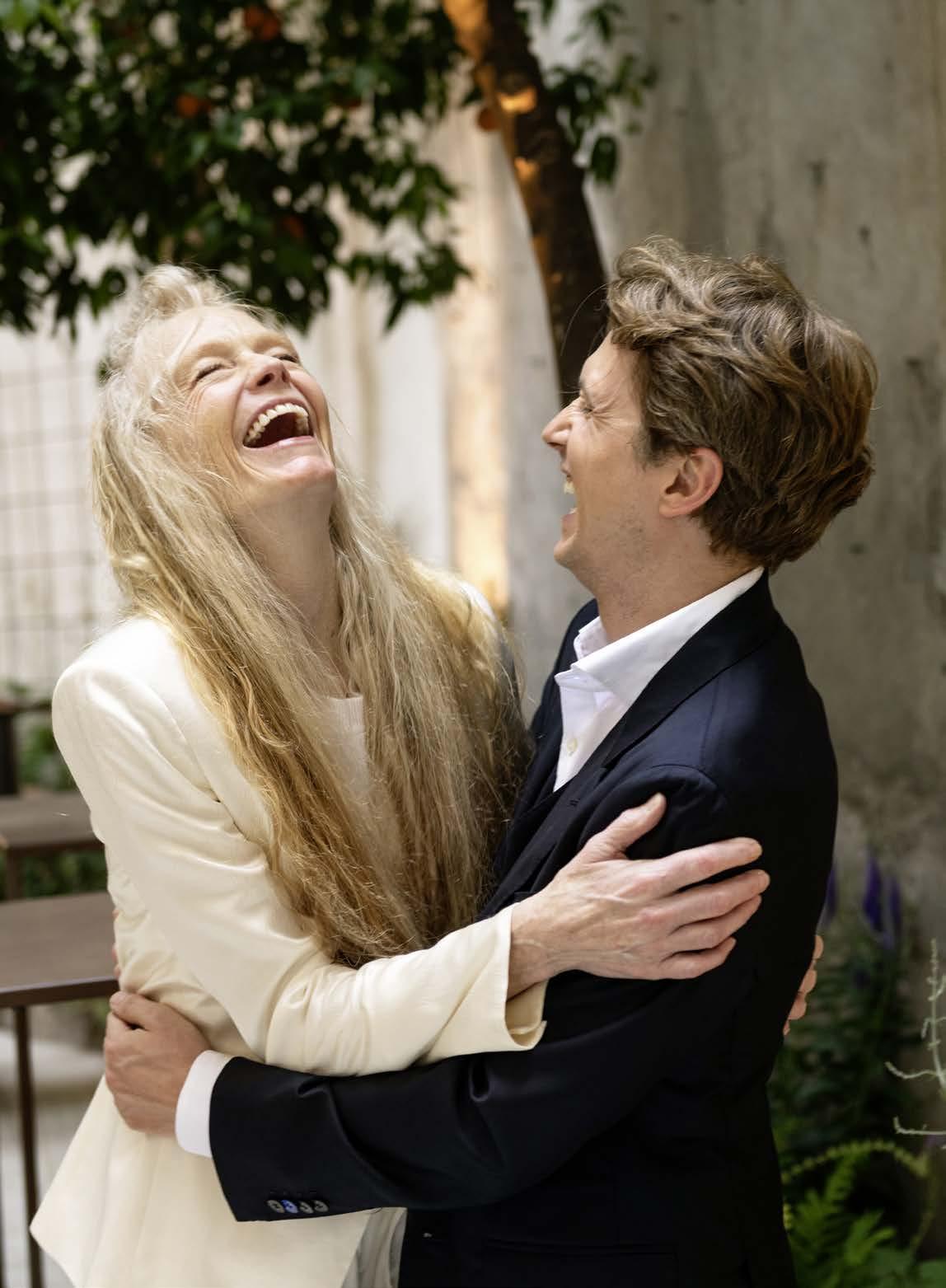
immediately: “We not only share the urgency, but also the vision and, above all, the will to rise above criticism.” Jointly, the duo is now weaving together threads that have long hung loosely alongside each other: education, technology, textiles, architecture, agriculture. The goal is radically new: Regenerative systems that are based on responsibility instead of exploitation – neither of people nor of resources.
“What we wear is not a neutral act,” Suzy Amis Cameron is convinced. Clothing is much more than a textile shell; it is a statement, both political and personal, and often a reflection of our own values. This is precisely where Inside Out Fashion, Textiles & Home comes in: at the sensitive interface where aesthetics, ethics, and everyday life converge. Suzy Amis Cameron has advocated this approach for some time. She founded the Red Carpet Green Dress initiative back in 2009, long before sustainability emerged as a buzzword in the fashion industry. The idea was to harness the glamor of the Oscars to introduce environmental responsibility to the world’s most visible red carpet.
The year 2025 marks a new chapter. In an emotional statement on insta, Suzy Amis Cameron announced the end of RCGD Global and her next, greater step: the full integration of the initiative into the new Inside Out Fashion, Textiles & Home platform. “It was time to lift the topic out of its niche,” she says. Red Carpet transforms into Real Change.
“Fashion was never just about clothing,” adds Matteo Ward. “It has always been an instrument of power and exclusion. Today, we stand before the ruins of this ideology. Clothing has become a disposable commodity. We need to rewrite the system.”
Inside Out does exactly that and consistently approaches fashion as a systemic issue. Fast fashion is replaced by durable materials, regenerative supply chains, local production, circular thinking. Greenwashing is replaced by real research, new technologies, educational partnerships. In collaboration with universities, start-ups, and biotechnology labs, they develop textile innovations that are measurably better – for both people and the planet.
Sheep Inc of New Zealand, a label that combines regenerative agriculture with CO₂-negative production, is an excellent example. As is the Italian start-up Orange Fiber, which produces fibers from citrus peels – luxurious, vegan, and biodegradable.
“This is not about abstinence,” says Suzy Amis Cameron. “This is about redefining beauty – with responsibility, transparency, and the clear goal of protecting the world for the generations we will never know.”
This redefinition requires more than just products. It is about new narratives – or rather counter-narratives. “We firmly believe in the transformative potential of education,” explains Suzy Amis Cameron. “Not just in schools, but everywhere.” To this end, Inside Out is partnering with universities such as MIT, Texas Tech, and Georgia Tech in more than 17 interdisciplinary research fields – from soil health to water purification. One of the flagship projects is CASFER, a portable device for detecting antibiotic residues in drinking

water. “Technology should not be a luxury,” says Matteo Ward. “It must be accessible, democratic, and scalable in order to have a truly systemic impact.”
Matteo Ward regards education as an active lever for change and a project dear to his heart. His WRÅD Living platform has been providing radical, visual education in schools, at festivals, and in museums for years. The aim is never to moralize, but to create curiosity and context. One example is the “Storia di una maglietta”, a free workbook for children developed together with the FAO, which is available in 17 languages worldwide. It is a tool for early awareness-raising that is both playful and well-founded. “If we expect the next generation to consume differently, we need to invite them to engage early on,” says Matteo Ward. At Inside Out, education is not considered a checklist, but a process, an invitation to think, a collective act of cultural rewriting.
Why Rome? “Because Rome is Rome,” explains Suzy Amis Cameron with a chuckle. That sounds trivial, but there is much more to it than that. Rome is both a symbol and a system, past and present, chaos and energy. A

city in which politics, culture, spirituality, and civil society have been conflicting for centuries, a field of friction that gives rise to dynamism.
“Rome can be a resonance chamber for genuine change,” adds Matteo Ward. “This is where global decision-making centers meet local realities. This is exactly what we need: places that listen and broadcast.” Inside Out’s new headquarters are strategically located in the heart of the city, within sight of the FAO, UNESCO, and WHO. A deliberately selected position that combines visibility with connectivity – because real transformation does not work in solo mode; it thrives on connections.
However, Rome not only symbolizes the interconnection of power and practice, but also continuity and renewal. “This city carries the spirit of repetition, but also of rebirth,” says Matteo Ward. And it is precisely this attitude that the sustainable fashion and lifestyle world of Inside Out depends on: A departure from fast-moving trends in favor of an attitude that has a lasting effect – deeply rooted and future-oriented.
To Suzy Amis Cameron, sustainability is not a final destination, but a continuous journey. One that never ends and challenges us to rethink responsibility. It is not about sacrifice or restriction, but about true liberation. Fewer possessions can grant more freedom. Longevity is emerging as the new status symbol, while transparency is developing into the most valuable currency.
When asked what practices they would remove from the fashion industry forever, Matteo Ward’s answer comes loud and clear: “Planned obsolescence. This concept
that products are consumed and discarded rapidly must be eliminated. Instead, we need planned regeneration that renders fashion sustainable and alive.” Suzy Amis Cameron adds: “Fashion must be designed in a way that uplifts people, nature, and society rather than exploiting them. This is the only way to make it sustainable.” Cooperation is key for Suzy Amis Cameron. “In 2009, we often encountered closed doors,” she explains. “Yet, slowly but surely, many luxury brands are opening up - not out of choice, but because the market demands it. We collaborate with Vivienne Westwood, Armani, and Louis Vuitton. Little by little, things are moving forward.” When doors close, she looks for windows, roofs, or chimneys to gain access. Matteo Ward emphasizes how important it is to preserve WRÅD’s own identity along the way: “Our DNA has not changed since we joined Inside Out. The values align perfectly. This means we can protect what we have achieved and pass it on, even when we are no longer here.”
Ultimately, one realization remains. This is a mission, not a marketing campaign. Suzy Amis Cameron, a mother of five and grandmother, says: “I do not want to lie in a coffin knowing I could have done more.” Matteo Ward, 39, adds: “We are the first generation to know all the facts, and perhaps the last able to act.”
That is why they continue to build, in small steps and persistently. With materials, platforms, curricula, tools, and, above all, with determination. “This is not about us. I am doing this for the generation I will never even know – and for their children.”

ecoalf built its name cleaning up the ocean. Fishing nets became sneakers. plastic bottles became parkas. The spanish brand stood for recycling before it was cool and proved that waste could become premium. But even pioneers reach limits. now the brand is entering a new chapter – and it begins with Regenerative cotton.
Text: stephan huber. photos: ecoalf
“For us, recycling was never the end goal,” says Carolina Álvarez-Ossorio. “It was just the beginning.” That beginning has now grown into something new, bolder, and even more progressive: regeneration. “We have always protected the sea. Now we are committed to healing the soil,” says Carolina. “These are the two pillars of our future.”
So, what does regeneration, specifically regenerative cotton, entail? Unlike conventional or even organic farming, regenerative agriculture rebuilds ecosystems. It focuses on restoring soil health, increasing biodiversity, improving water cycles, capturing carbon, and supporting communities. “An organic cotton farm is quiet – almost dead. A regenerative one is alive,” Carolina explains. “You hear insects, you see beetles, birds, worms. It is a living system.”
The results speak for themselves. In India, Ecoalf has partnered with Materra, working with farmers in the Ahmedabad region. For this season, they produced 2,100 kilograms of cotton while reviving 51,000 square meters of degraded land. For the upcoming spring/ summer 2026 season, the target is 27,000 kilograms, restoring 657,000 square meters of land. As part of this initiative, Ecoalf will launch its first woven collection made of 100% regenerative cotton and with natural dyes. It includes t-shirts, cargo pants, dresses, skirts, and shirts. “The quality is incredible,” says Carolina. “The fabric is soft, lightweight – and when we brought the t-shirts back to the farmers, they were amazed. They could not believe it came from their own fields.” This kind of circularity starts with trust and ends in pride.
But Ecoalf is already looking further than cotton. Regenerative wool is already in development for winter collections. “This is not a trend,” Carolina insists. “It is the only real tool we have to fight climate change. Regeneration is about rebuilding what is broken. And it applies far beyond fashion.”
Indeed, education is now central to strategy – be it through farmer training, consumer awareness, or cross-industry partnerships. One long-term dream? “We would love to create something like an Ecoalf House”, Carolina says. “A place where we can share everything we have learned with others.”
That vision underscores a larger truth: real innovation lies not in the product but in the perspective. Recycling taught us how to handle waste. Regeneration asks us to work with nature. It is slower, less linear. “This is not about doing more,” says Carolina. “It is about doing it differently. And doing better – together.”


The current state of global politics has also impacted fashion. This is reflected in two major trends. Firstly, an almost romanti cized departure from everyday life in favor of nature, beauty, and tranquility. Secondly, a focus on classicism, consistency, and tradition in the guise of reduced, clean styles with a high degree of qualitative depth in terms of materials. The impulsive coun termovement featuring sporty and functional looks is by no means absent, but in the wake of general de-casual ization it is much more muted than usual. Fashion has become more thoughtful.



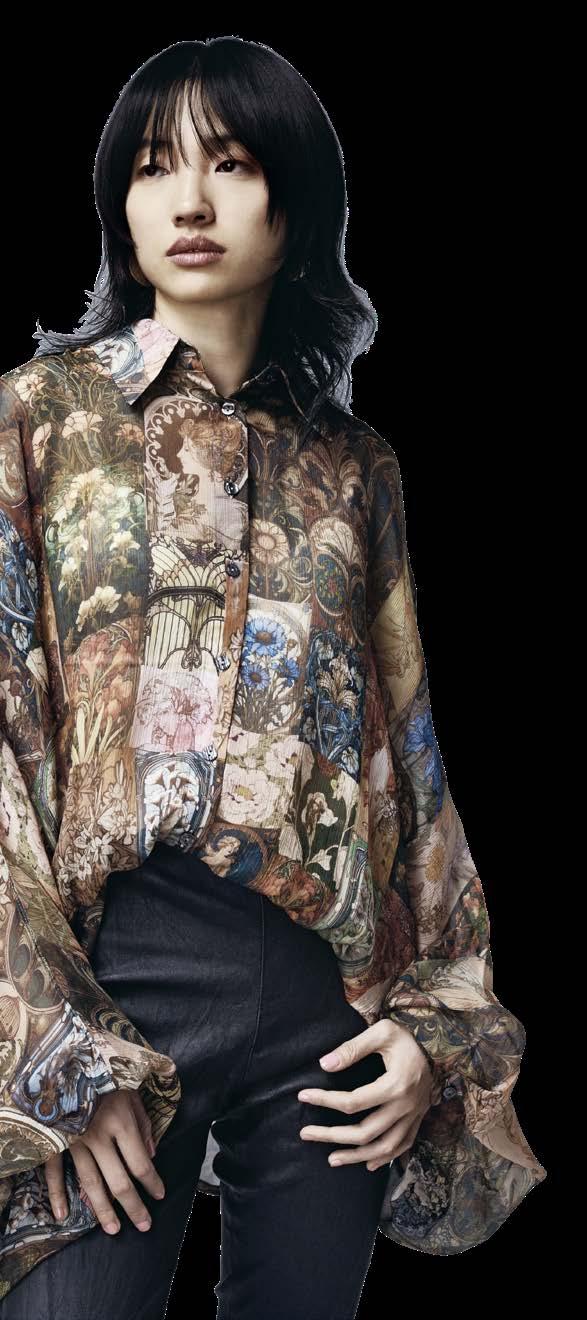


Briefly setting aside the romantic softfocus filter glorifying the Jane Austen aesthetic, this trend reflects a shift towards natural, unagitated, and unadorned looks. Delicate, natural fabrics and materials in natural colors embrace the aspiration of timelessness with a certain vintage charm. Quiet classics with a completely natural twist.











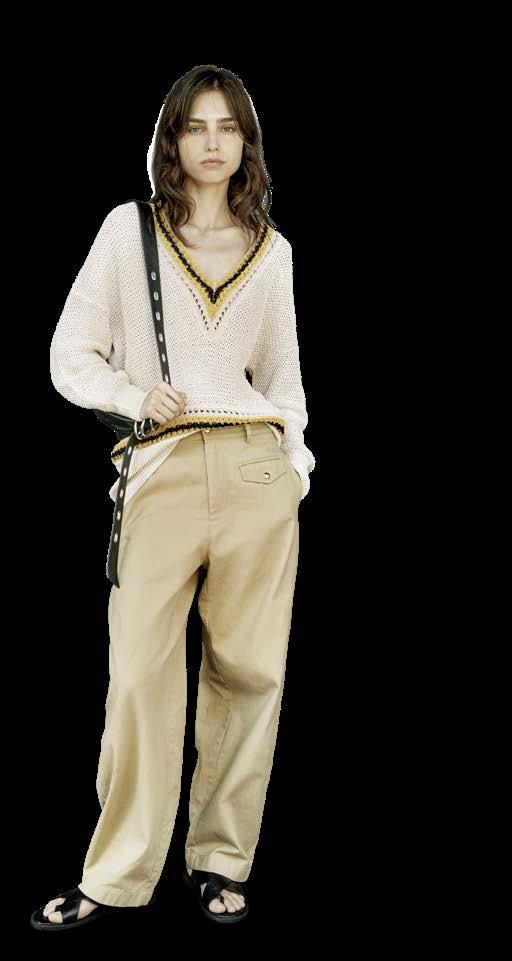




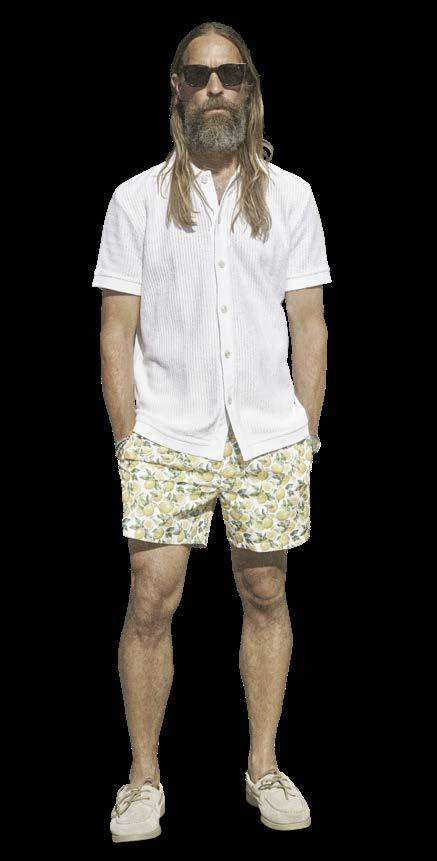





Express yourself! Colors, logo prints and slogans, eye-catching accessories, and materials that make a look unique – all of which contribute to the overall attitude. Futuristic designs emphasize the functionality and simultaneous misappropriation of technical materials. Bold statements that are fun.



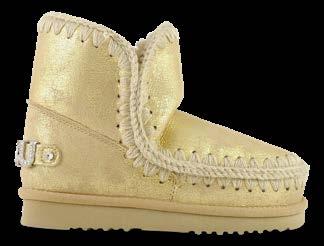





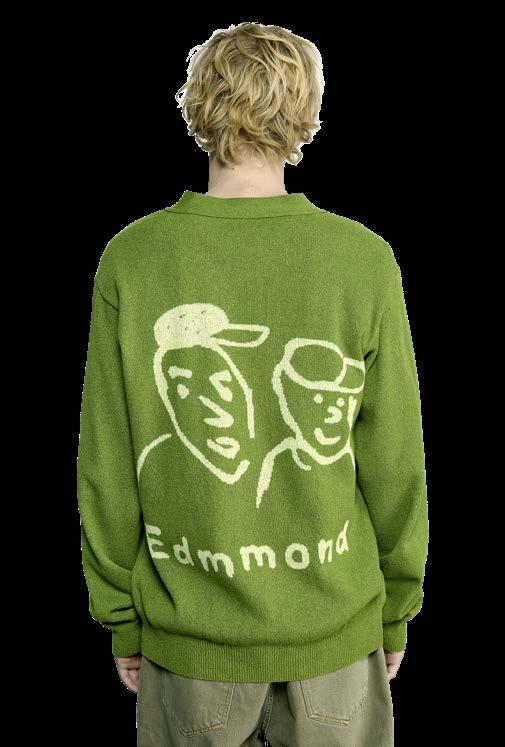








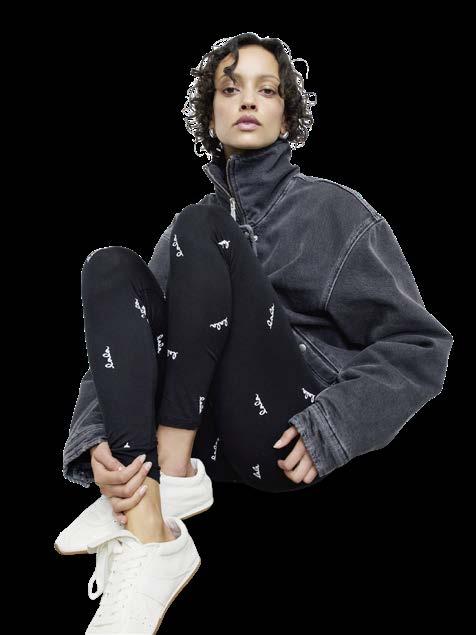




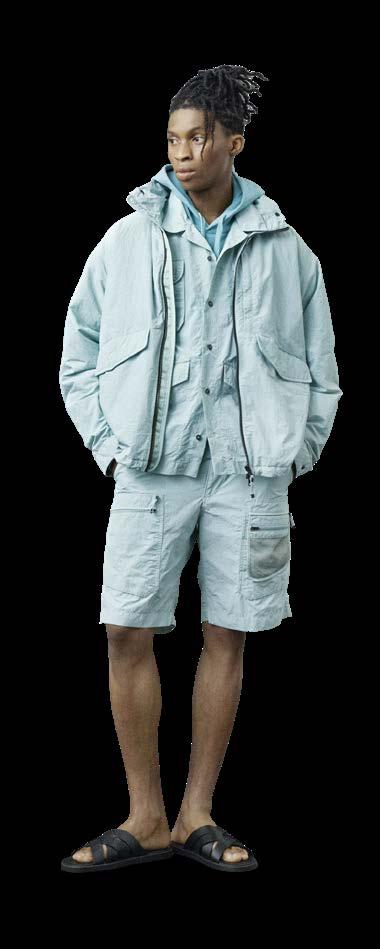
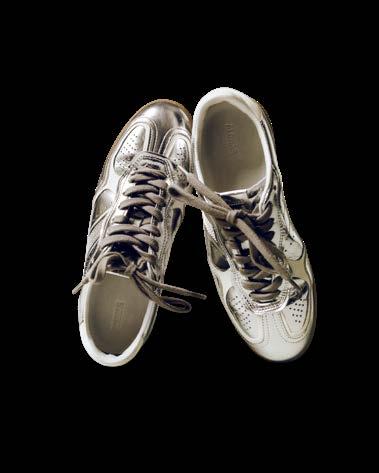

The emphasis lies on cultural diversity and summer festival atmosphere. References to folklore, indigenous artisanship, and traditional dress are intermingled with cultural codes of the current zeitgeist and interpreted in a glamorous light. The spotlight falls on fairly produced clothing, recycled materials, and extraordinary fabrics, combined with shimmering accents and elegant cuts.







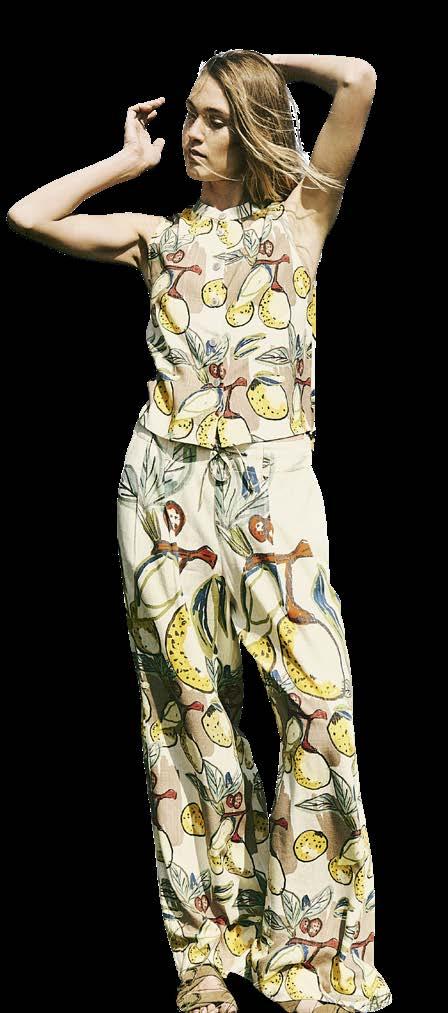













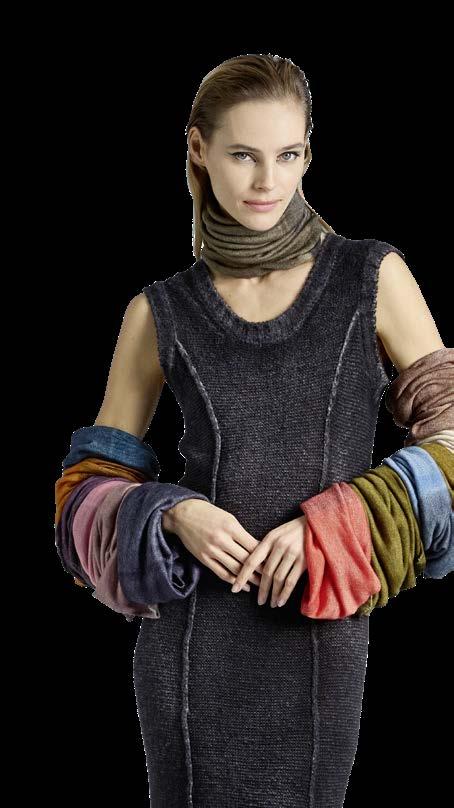
In Japan, Wabi Sabi is a term used to describe the beauty of the ephemeral. “It nurtures all that is authentic by acknowledging three simple truths: nothing lasts, nothing is finished, and nothing is perfect,” describes author Richard Powell. Applied to fashion, this translates into looks that appear to have been created by chance and thrown on casually, lending them a unique charm.

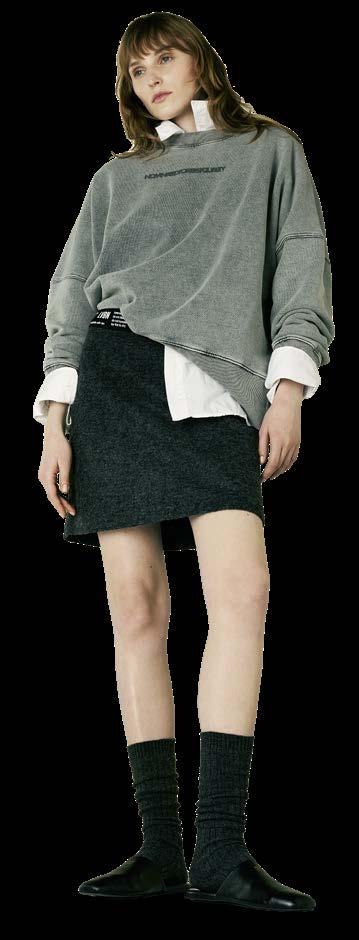


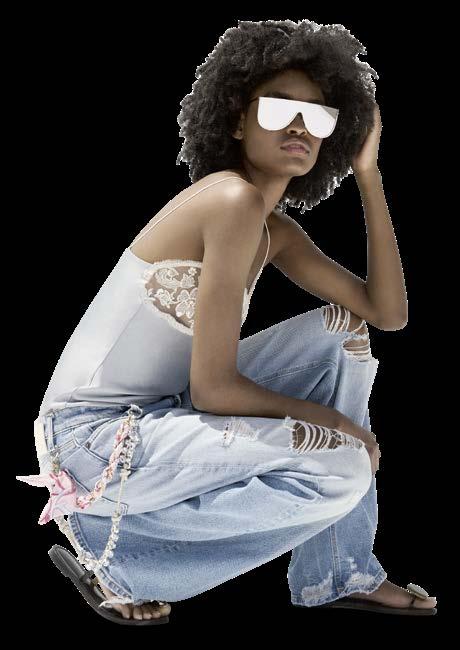














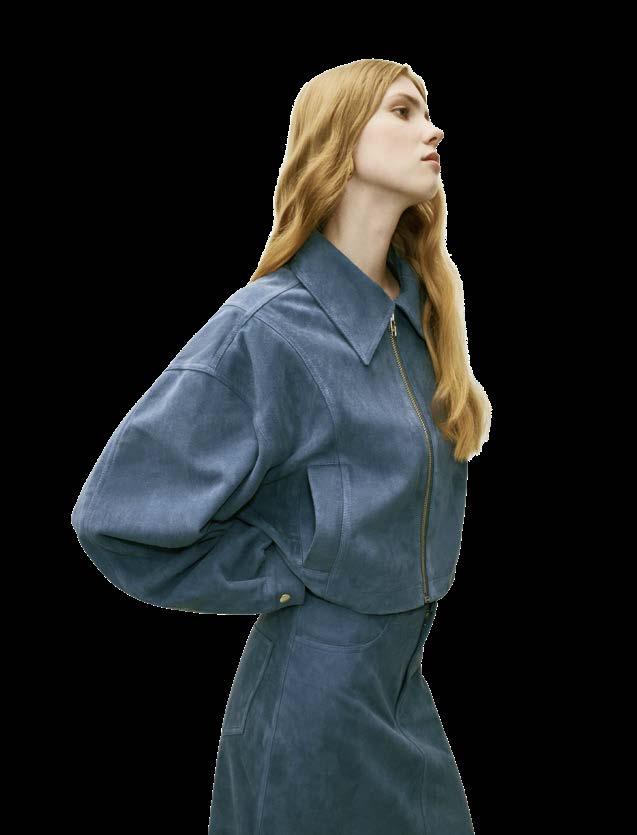
In formalwear, the desire for androgyny – as well as breaking existing boundaries and norms through unconventional fabrics, new cuts, crossovers, and unisex silhouettes – is becoming increasingly evident. At the same time, the disrupted look is gaining in importance, featuring deliberately aged and recycled materials.





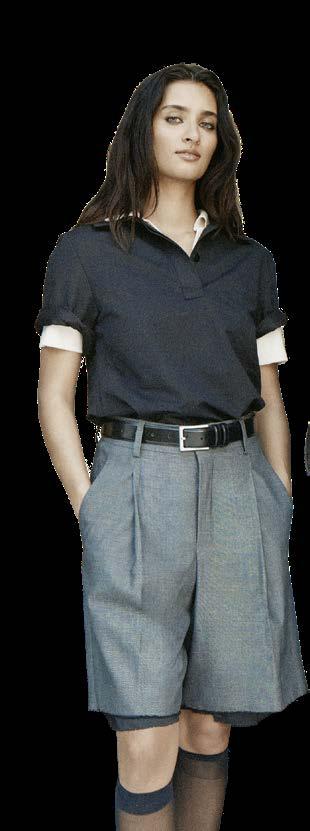



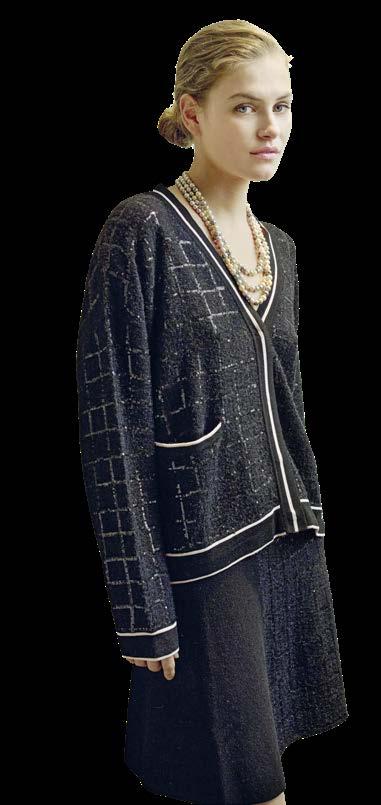

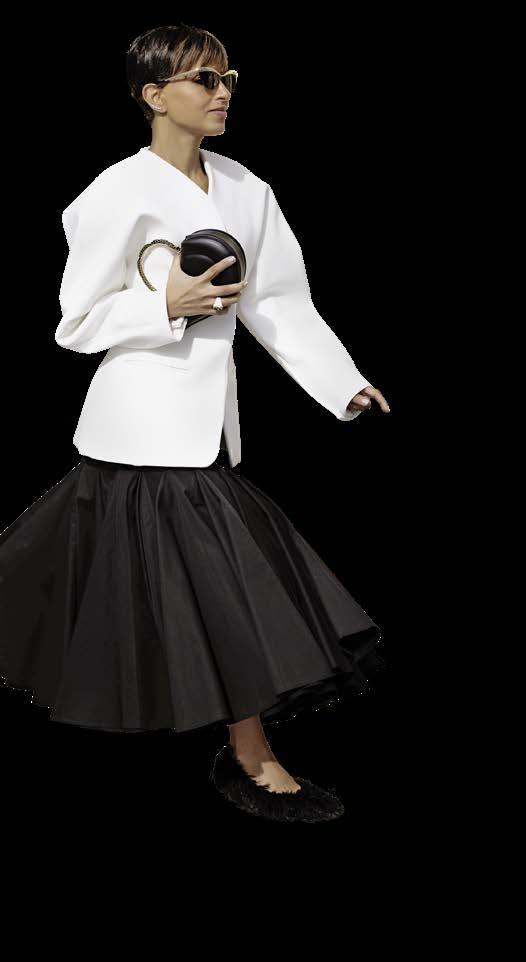










Wide, flowing silhouettes remain predominant, not just in terms of trouser cuts. Wide dresses, super-wide pants, and boxy tops define this look. Volume in all facets, shapes, and colors.





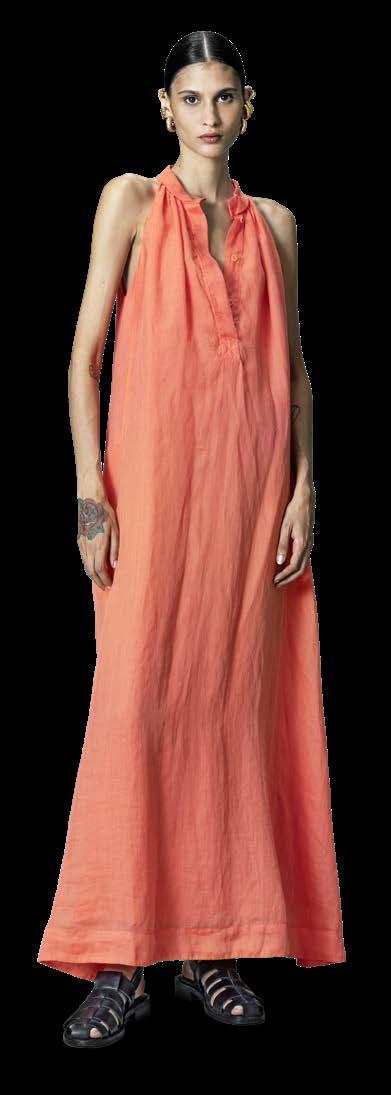
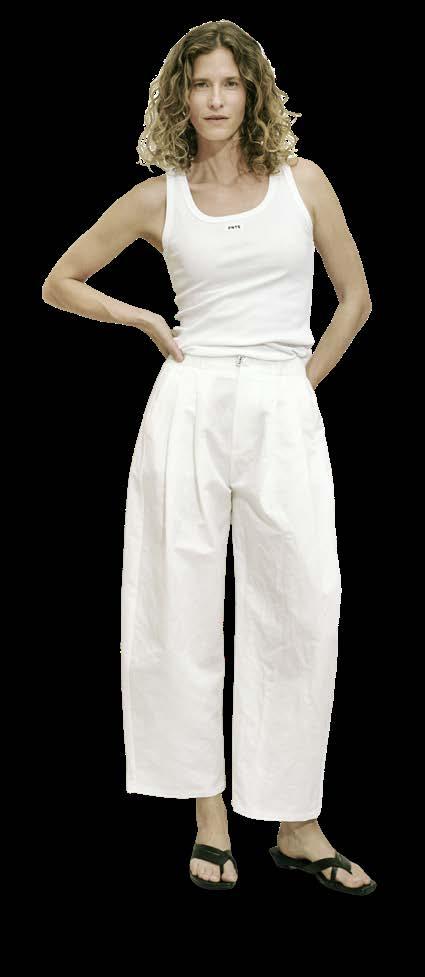








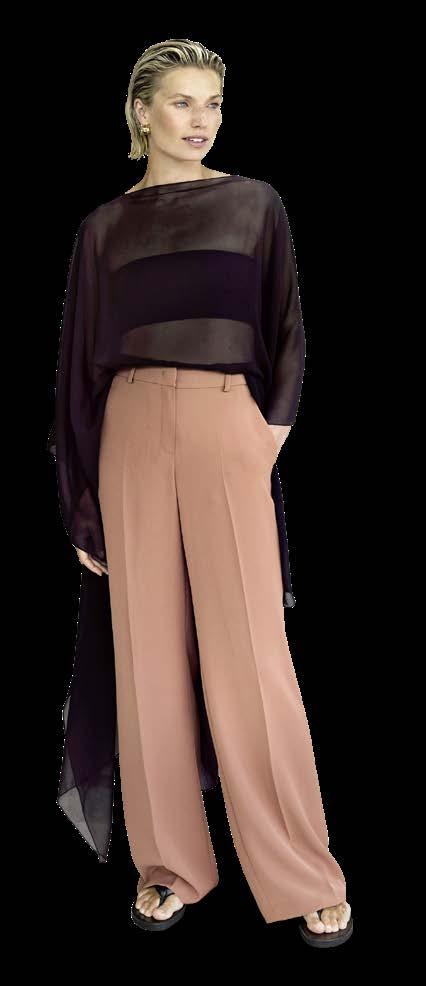
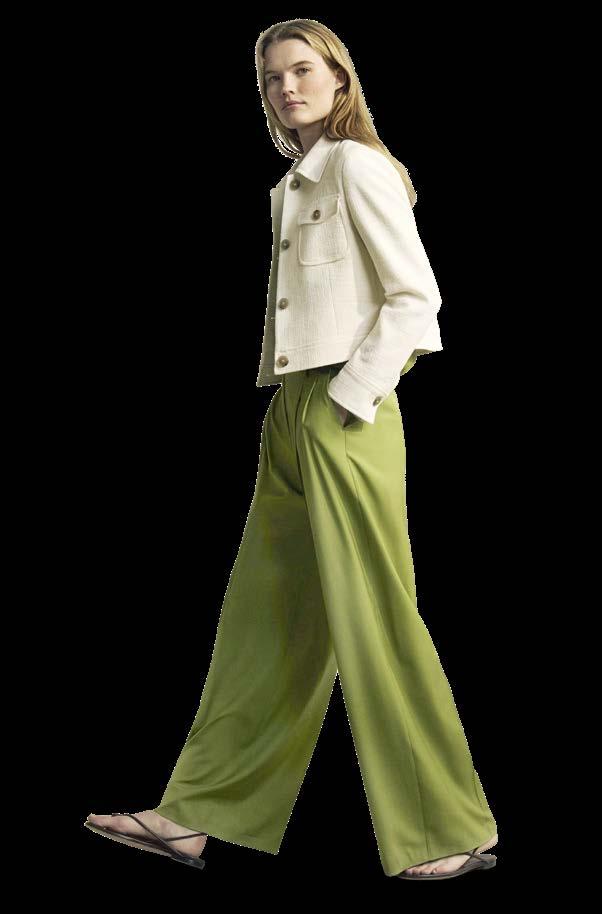


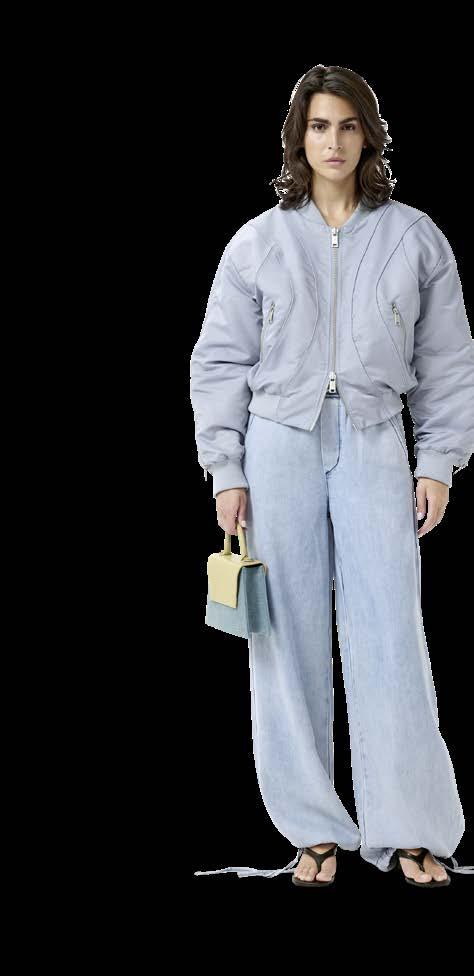



LinkedIn has long been a useful platform –especially for targeted networking. Sure, it’s always been a bit of a buzzword factory. Everyone’s perpetually “excited,” “humbled,” or both. And of course, always “proud.” I can live with that. I’ve probably even participated in the ritual of professional self-referencing now and then.
But lately, my feed has taken a darker turn. Dissatisfaction, self-righteousness, outrage – and, most troubling of all, a bizarre contempt for the very idea of freedom. A contempt so loud and pervasive, it’s impossible to ignore.
“Then just leave LinkedIn!”
“Come on... you know how the algorithm works!”
Maybe. But “closing your eyes” has never been a particularly good plan.
That’s the thing. It’s not really about LinkedIn. And it’s not just about politics either. What we’re witnessing is bigger than that – and stranger. A cultural shift where discontent, entitlement, and hyper-individualism merge into a kind of self-righteous rejection of the very freedoms that enable such expression in the first place.
What we’re dealing with is a mood. A mindset. A movement that defines itself less by what it wants to build, and more by what it wants to dismantle. A refusal to participate in a shared reality, paired with an expectation that one’s personal truth should reign supreme. That’s not resistance. That’s narcissism.
But freedom only lasts if we care enough to uphold it – not through obedience, but through responsibility. Through a shared effort to protect what none of us can secure alone.
Paradoxically, this idea is most fragile where it’s most fulfilled. In open societies, freedom begins to fade into the background. What once felt hard-won starts to feel ordinary. And that’s when the danger sets in. People begin to turn against the very systems that secure their liberty – drawn instead to ideologies that offer clarity, certainty, and control. Even if it means giving up the freedoms they barely even noticed.
Authoritarian ideologies rarely begin with brute force. They begin with comfort. With simplicity. With promises: we’ll protect you. We’ll tell you who you are. We’ll give you the truth – and silence those who question it.
You see it across history. In politics. In culture. Algorithmic platforms promise curated certainty. Movements promise belonging. Complexity is reduced to slogans. Doubt becomes betrayal. And into that vacuum steps a myth.

We’re told freedom means doing whatever we want, whenever we want. Your life, your rules.
But when everyone lives in their own algorithmic bubble – when facts are negotiable and civic duty a punchline –freedom erodes from within.
That isn’t freedom. It’s isolation, disguised as empowerment.
Real freedom is never just about the self. It exists in relationships – to others, to the truth, to the systems we build together. It requires limits, but not as punishment — as structure. A space where rights are balanced with responsibilities. Where disagreement doesn’t destroy dialogue. Where we can coexist without coercion.
Freedom is not chaos. It’s not self-expression without self-restraint. It’s the presence of rules we choose together – to protect dissent, ensure fairness, and hold us all to the same standard.
So where do we go from here?
We reclaim freedom not by shouting about it – but by practicing it. By participating. By thinking critically and acting collectively. By protecting the institutions that protect us, even when they frustrate us. By remembering that democracy isn’t self-sustaining. And that markets –like minds – need guardrails to remain fair and free.
Because freedom isn’t a product. It’s a principle.
And the only way to lose it is to forget what it asks of us.
So let’s not.
Yours, Stephan Huber stephan@style-in-progress.com
